Every Weaving Project is an Experiment
/I always tell students that unless you are using the exact same yarn in the exact same way that you have used it before, then your project is an experiment. Call it a full-size sample if you want to.
I'm OK with that. Who wants to do the same thing over and over?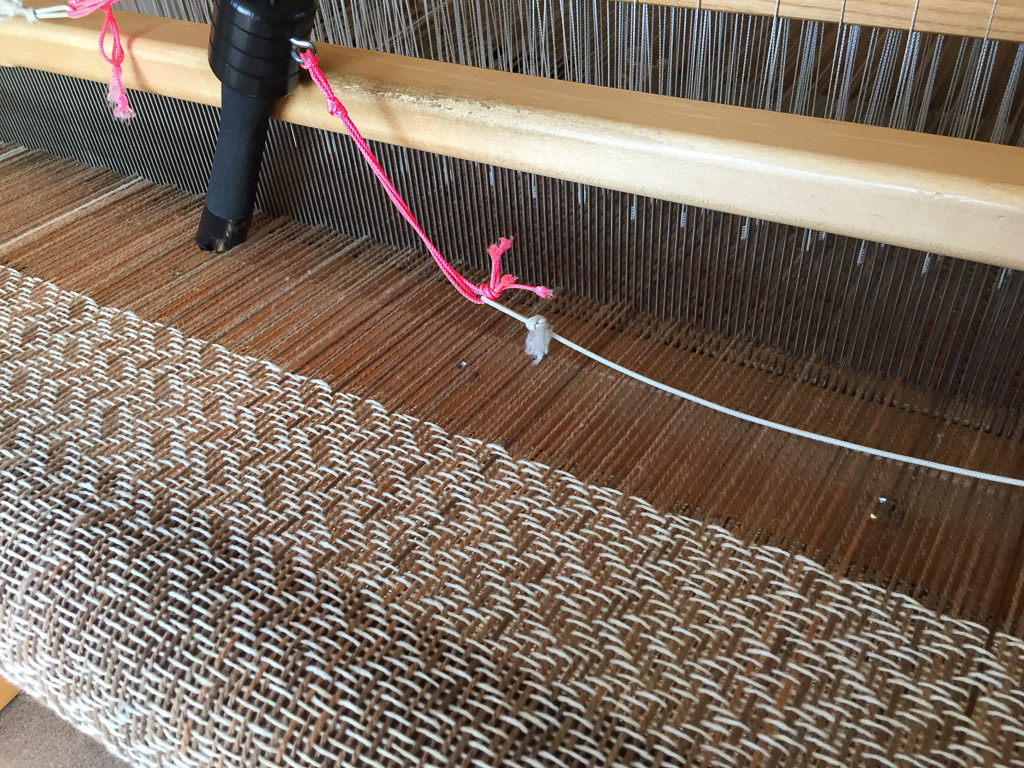 This is my latest warp. I wound 13 yards of mixed Solano County wool yarns. These are yarns that I have had spun in the last few years from the Timm Ranch, Anderson Ranch, and my own flock. Most were dyed with black walnuts--it's amazing the range of colors you can get when you use a black walnut dye pot over and over...and over. It keeps on giving color. Look at the range of browns in the photo below.
This is my latest warp. I wound 13 yards of mixed Solano County wool yarns. These are yarns that I have had spun in the last few years from the Timm Ranch, Anderson Ranch, and my own flock. Most were dyed with black walnuts--it's amazing the range of colors you can get when you use a black walnut dye pot over and over...and over. It keeps on giving color. Look at the range of browns in the photo below.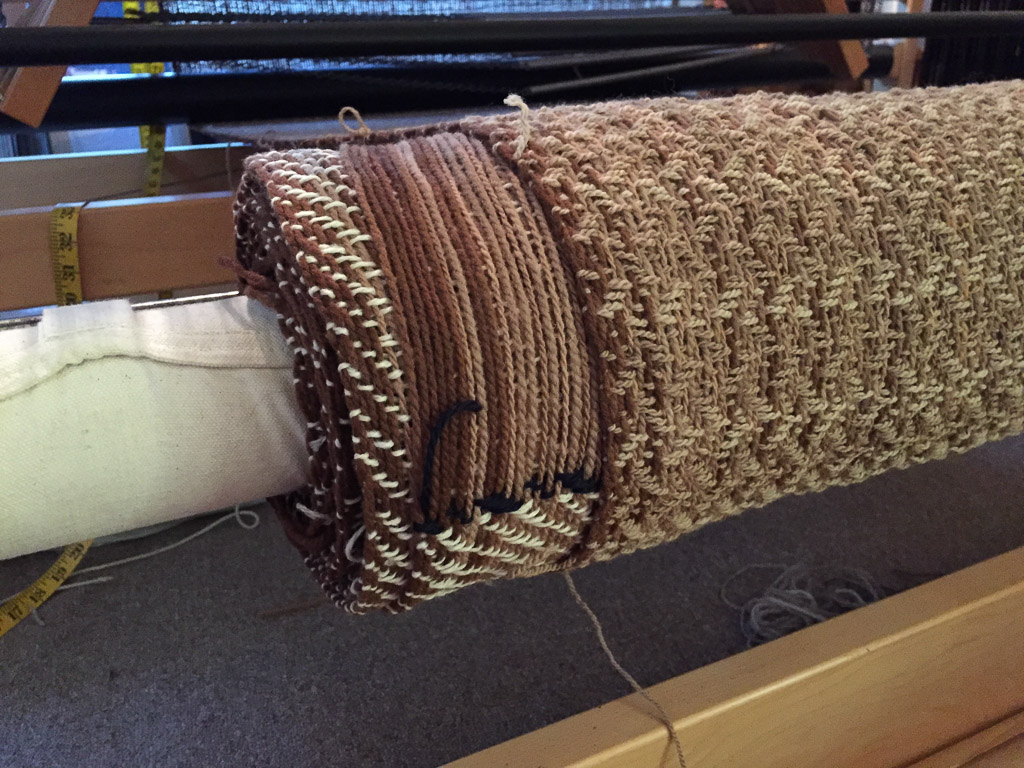 The other thing to notice about this photo is that the last piece woven on it is so much narrower than the others. This was the fourth shawl on the warp. The one before this one is a different weave structure (advancing twill treadling), but the first two are the same structure as the fourth one. The only difference is the weft yarn. The first three shawls were woven with 2015 Timm Ranch yarn on cones. The weft for the fourth shawl is 2016 Timm Ranch yarn that has been dyed. This is a perfect example of the difference that "finishing" yarn can make.
The other thing to notice about this photo is that the last piece woven on it is so much narrower than the others. This was the fourth shawl on the warp. The one before this one is a different weave structure (advancing twill treadling), but the first two are the same structure as the fourth one. The only difference is the weft yarn. The first three shawls were woven with 2015 Timm Ranch yarn on cones. The weft for the fourth shawl is 2016 Timm Ranch yarn that has been dyed. This is a perfect example of the difference that "finishing" yarn can make. 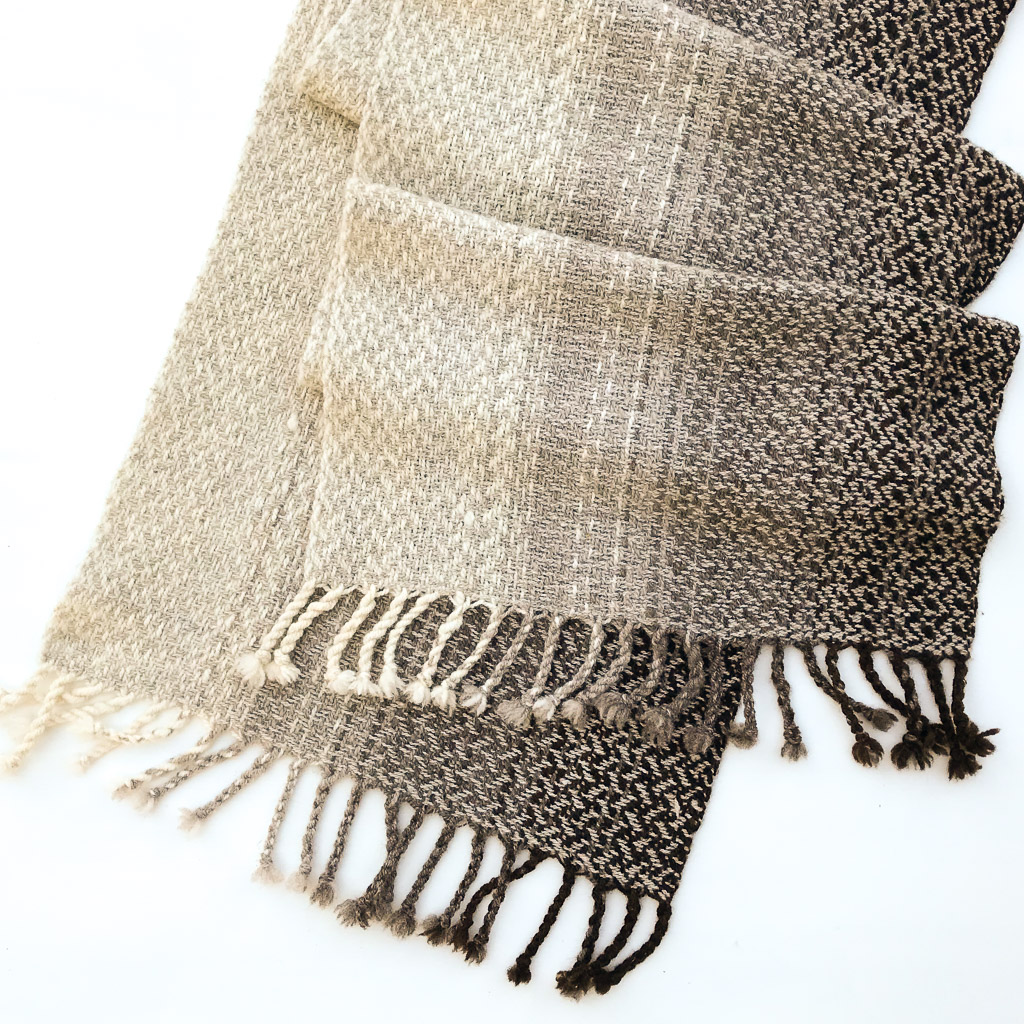 This is one of the previous batch of shawls. It is mostly Jacob yarn but the weft is last year's Timm Ranch/Jacob blend used from a cone without washing. In this case the width of the warp in the reed was 30" with a sett of 6 epi. That is very open but when wet finished the shawl is lightweight and has great drape. However, the finished width is only about 20" (33% draw-in and shrinkage). So I sett the brown warp the same at 6 epi but started with a 39" wide warp.
This is one of the previous batch of shawls. It is mostly Jacob yarn but the weft is last year's Timm Ranch/Jacob blend used from a cone without washing. In this case the width of the warp in the reed was 30" with a sett of 6 epi. That is very open but when wet finished the shawl is lightweight and has great drape. However, the finished width is only about 20" (33% draw-in and shrinkage). So I sett the brown warp the same at 6 epi but started with a 39" wide warp.
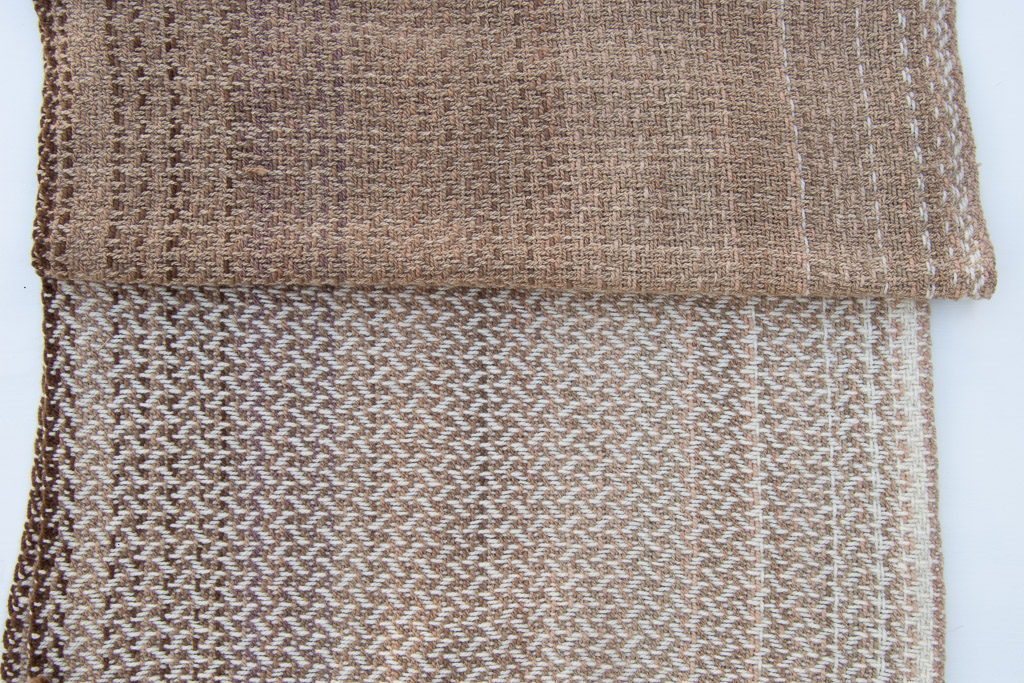 Here are the shawls from the brown warp after wet finishing. That one that was so much narrower on the cloth beam? That is the one that is a little wider here. It is now 27" wide (30% draw-in and shrinkage). The shawl in the same pattern but woven with the white weft is 26" wide (33% draw-in and shrinkage). The difference between width in the reed and the finished piece isn't much, but the photos show the dramatic difference in how the yarn behaves while it is woven.
Here are the shawls from the brown warp after wet finishing. That one that was so much narrower on the cloth beam? That is the one that is a little wider here. It is now 27" wide (30% draw-in and shrinkage). The shawl in the same pattern but woven with the white weft is 26" wide (33% draw-in and shrinkage). The difference between width in the reed and the finished piece isn't much, but the photos show the dramatic difference in how the yarn behaves while it is woven. 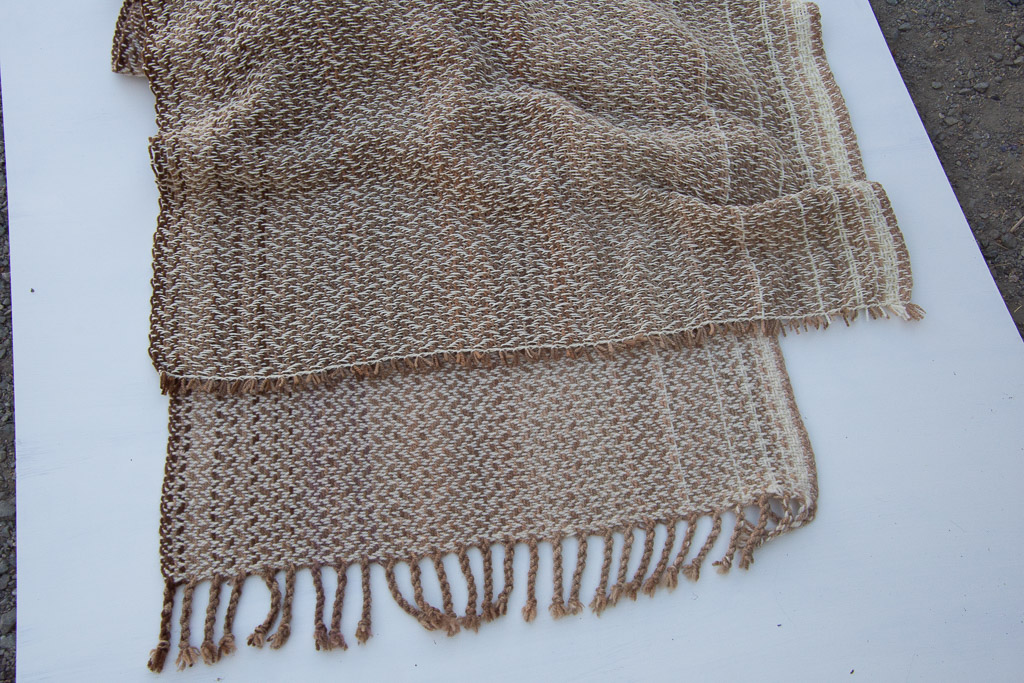 Here is a before and after photo. The bottom shawl has been wet finished. The top one is the same weft yarn and same pattern, but has not been washed. Look at the very first photo in this post. You can see how wide open the yarns are. Off the loom they are a little closer, but that looks nothing like it will when finished.
Here is a before and after photo. The bottom shawl has been wet finished. The top one is the same weft yarn and same pattern, but has not been washed. Look at the very first photo in this post. You can see how wide open the yarns are. Off the loom they are a little closer, but that looks nothing like it will when finished. 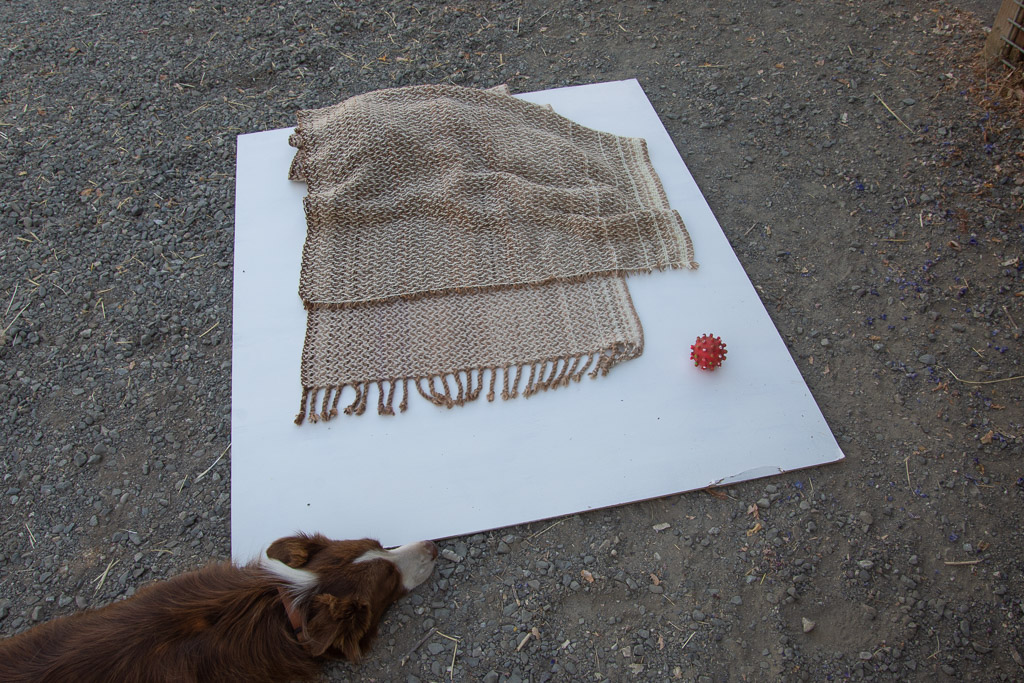 An example of trying to take product photos with the help of a Border Collie.
An example of trying to take product photos with the help of a Border Collie.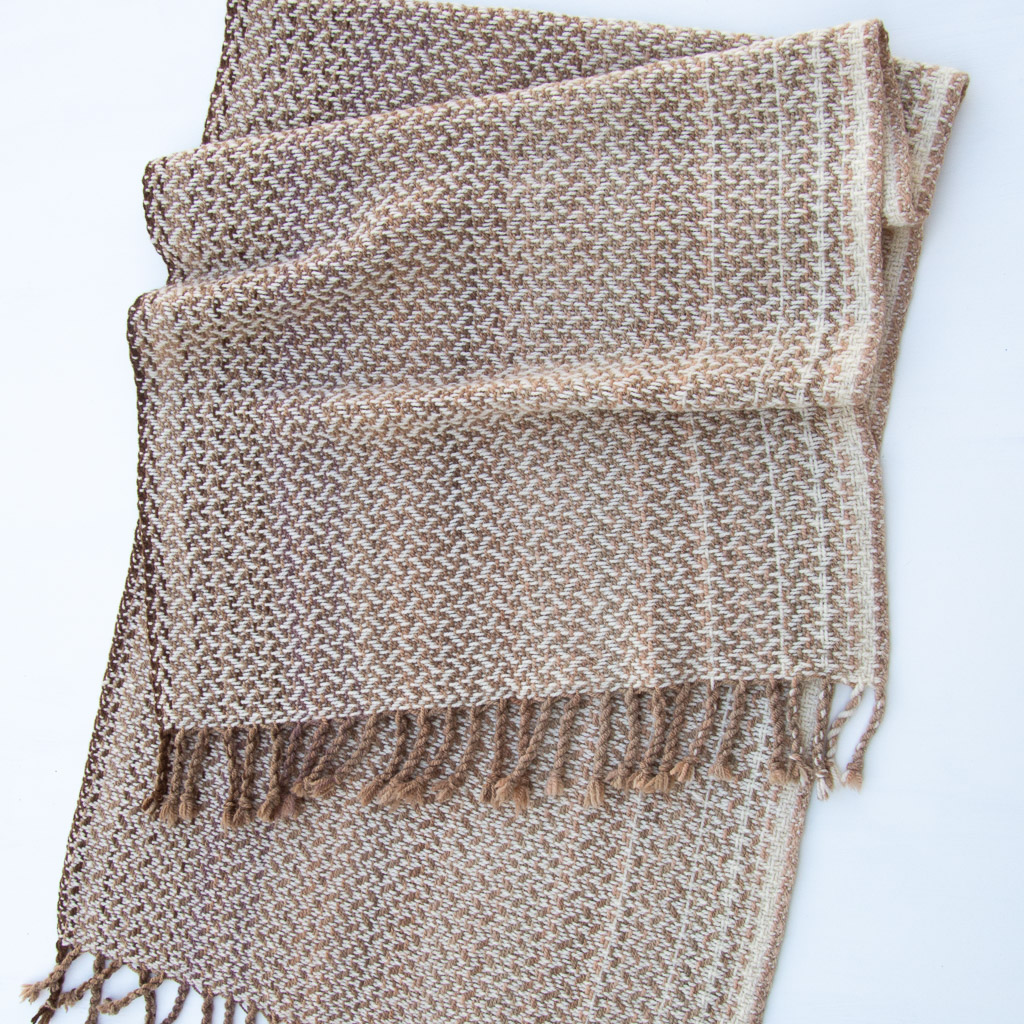 Here is one of the final product photos. I noticed a surprise. I started to see a purple cast to one of the warp yarns. At first I thought that I just hadn't noticed that shade inside while I was weaving. I tried to convince myself that it was still brown.
Here is one of the final product photos. I noticed a surprise. I started to see a purple cast to one of the warp yarns. At first I thought that I just hadn't noticed that shade inside while I was weaving. I tried to convince myself that it was still brown.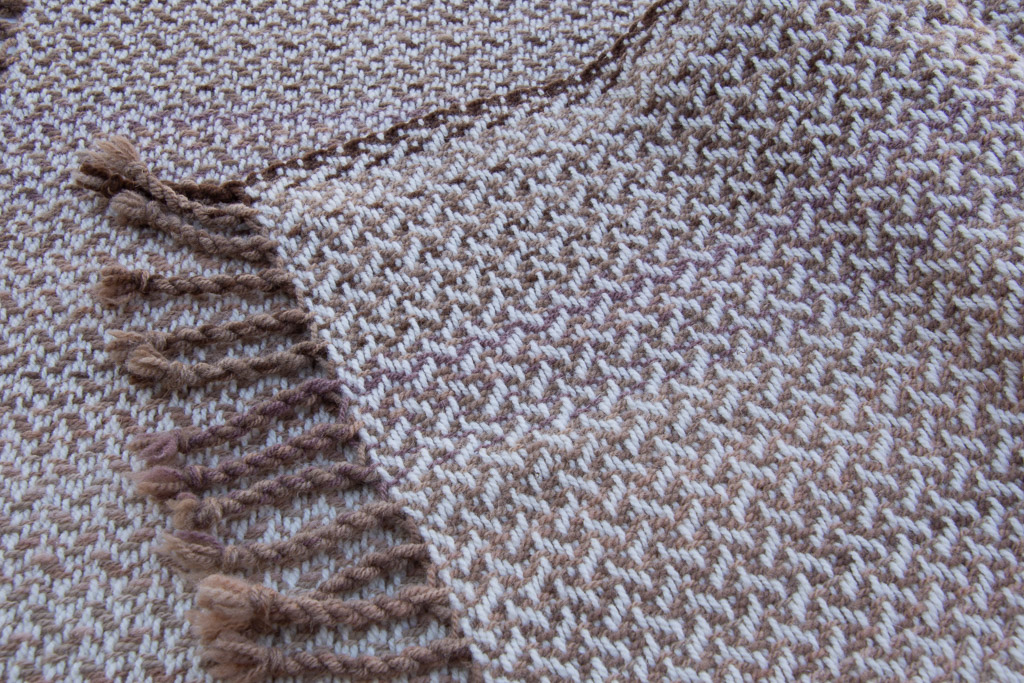 Do you see it here?
Do you see it here? 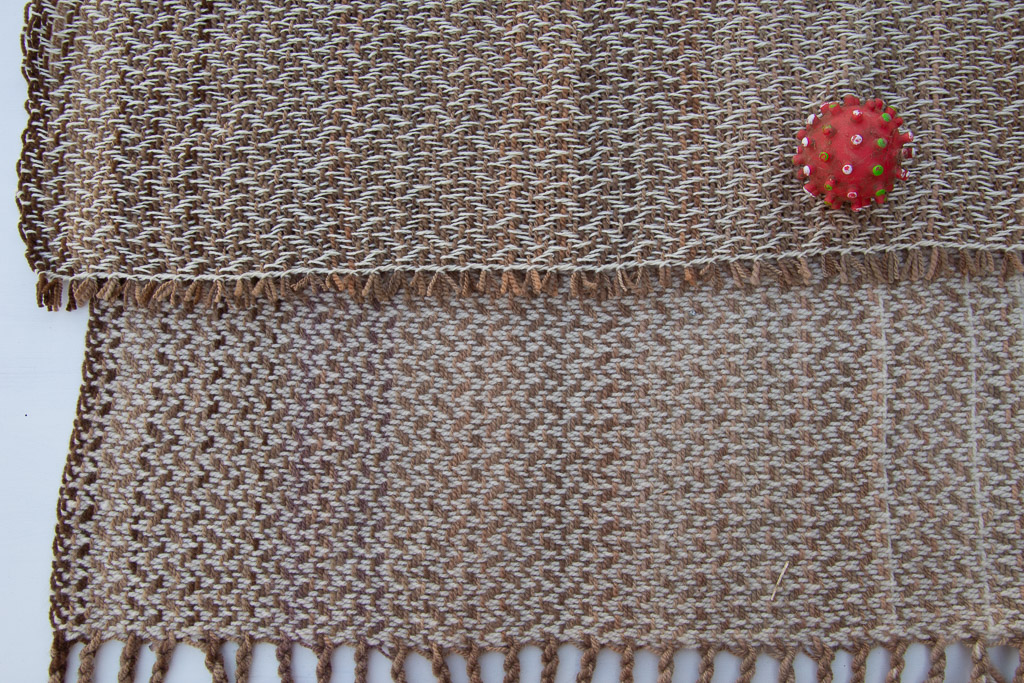 Another photo of one not washed (no purple) and one washed. I lined up the same warp threads in these two pieces.
Another photo of one not washed (no purple) and one washed. I lined up the same warp threads in these two pieces. 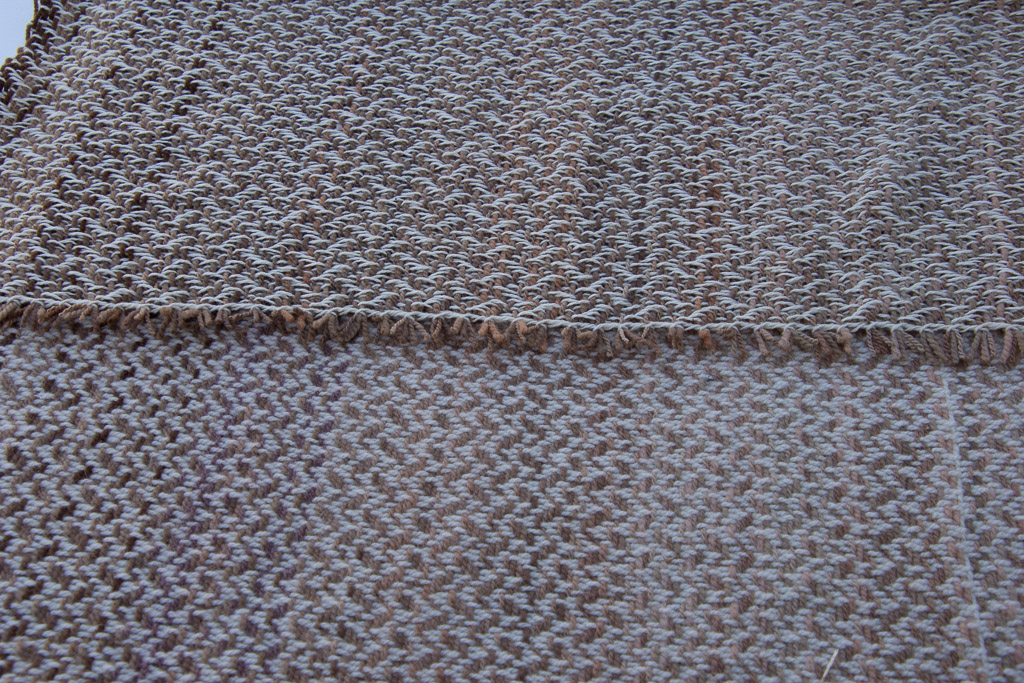 Depending on the light setting in the photo (and maybe your monitor) you may see it more clearly in one of these other photos.
Depending on the light setting in the photo (and maybe your monitor) you may see it more clearly in one of these other photos.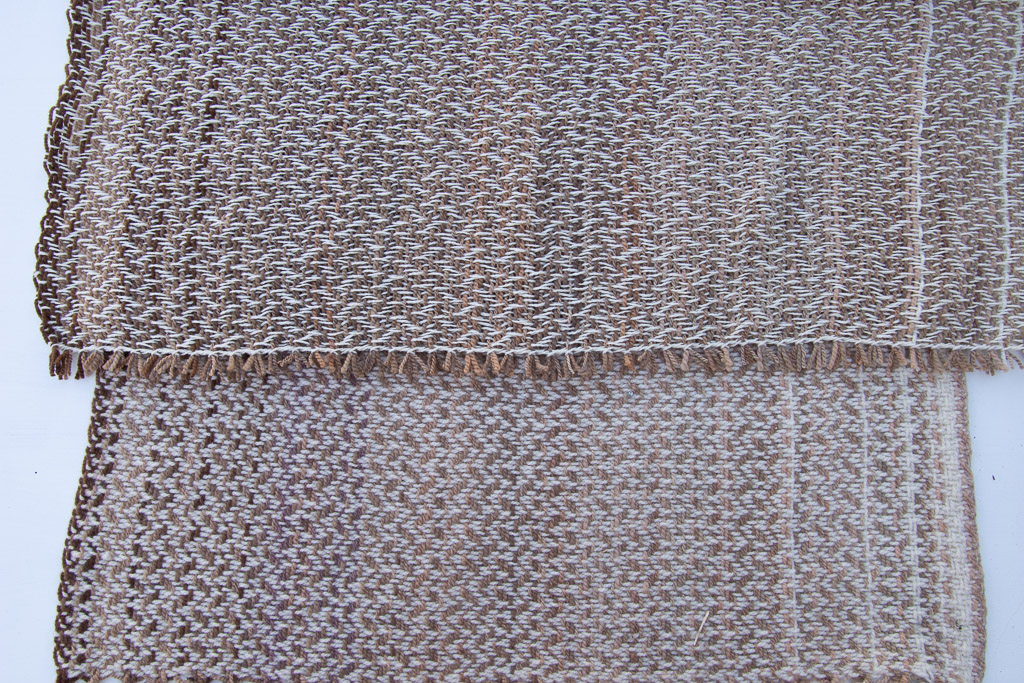 In person it is clearly visible, although it doesn't stand out.
In person it is clearly visible, although it doesn't stand out.
The answer...that was a yarn dyed with mushrooms from a friend. It must have been rhe soap that caused the shift in color. I love it. Lisa, what is the name of that?
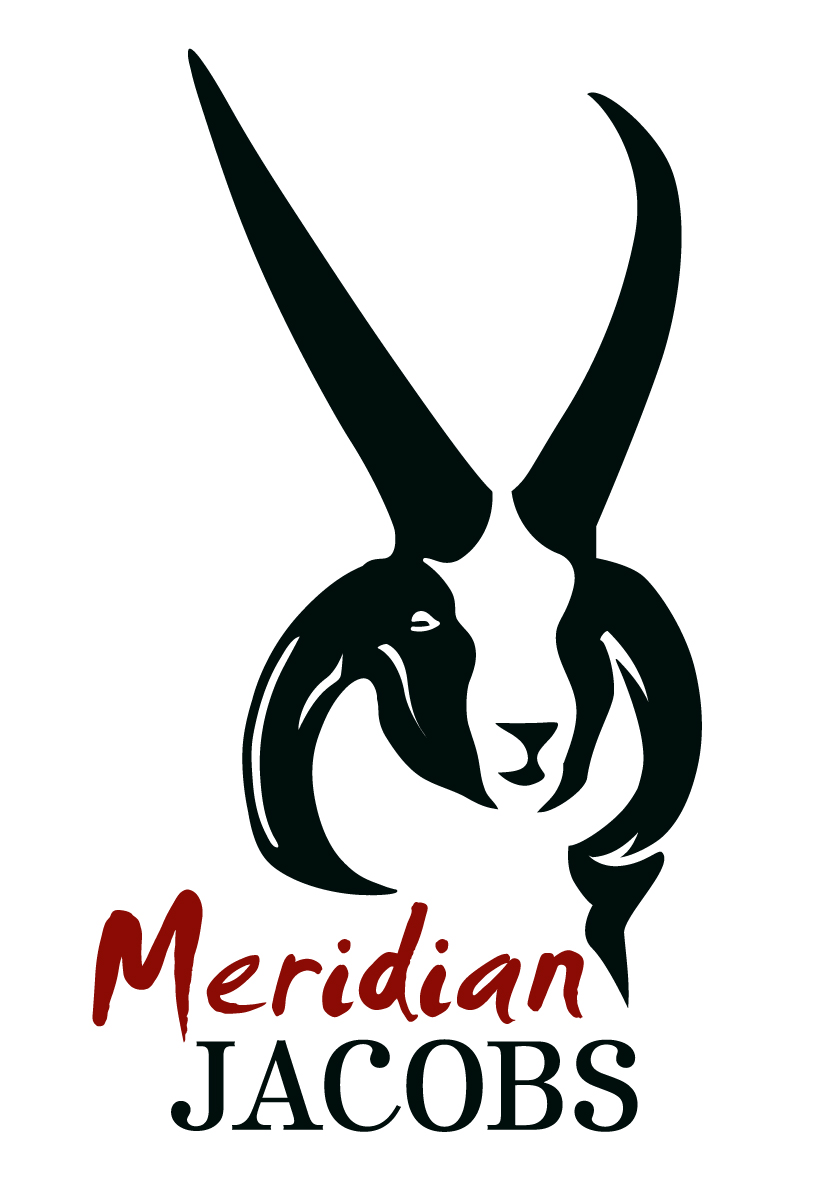
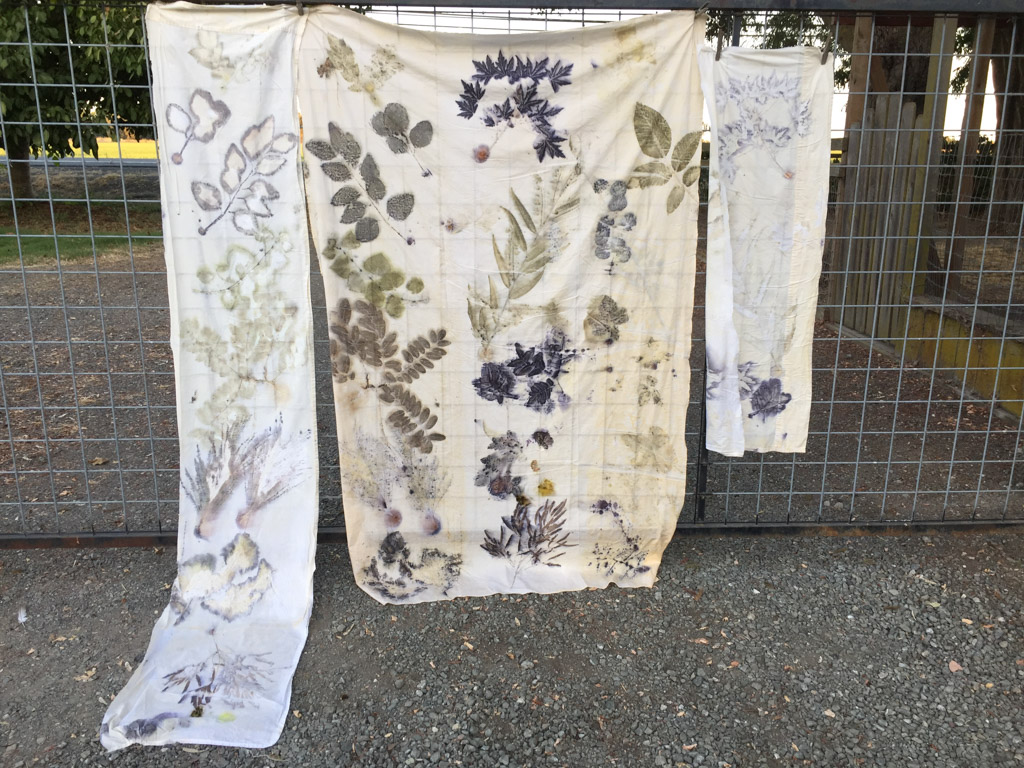 Before you print with plants you soak the mordanted (or not) fabric in iron or tannin (or not). Then you apply the plant material (possibly dipped in iron or not). You cover it with a "blanket" of cotton fabric and then roll the whole thing up with plastic on a dowel or in my case, 2" PVC pipe and tie it tightly. Then you steam for 90 minutes. Why 90 minutes? That's just because that is how long everyone else says to do it.
Before you print with plants you soak the mordanted (or not) fabric in iron or tannin (or not). Then you apply the plant material (possibly dipped in iron or not). You cover it with a "blanket" of cotton fabric and then roll the whole thing up with plastic on a dowel or in my case, 2" PVC pipe and tie it tightly. Then you steam for 90 minutes. Why 90 minutes? That's just because that is how long everyone else says to do it. 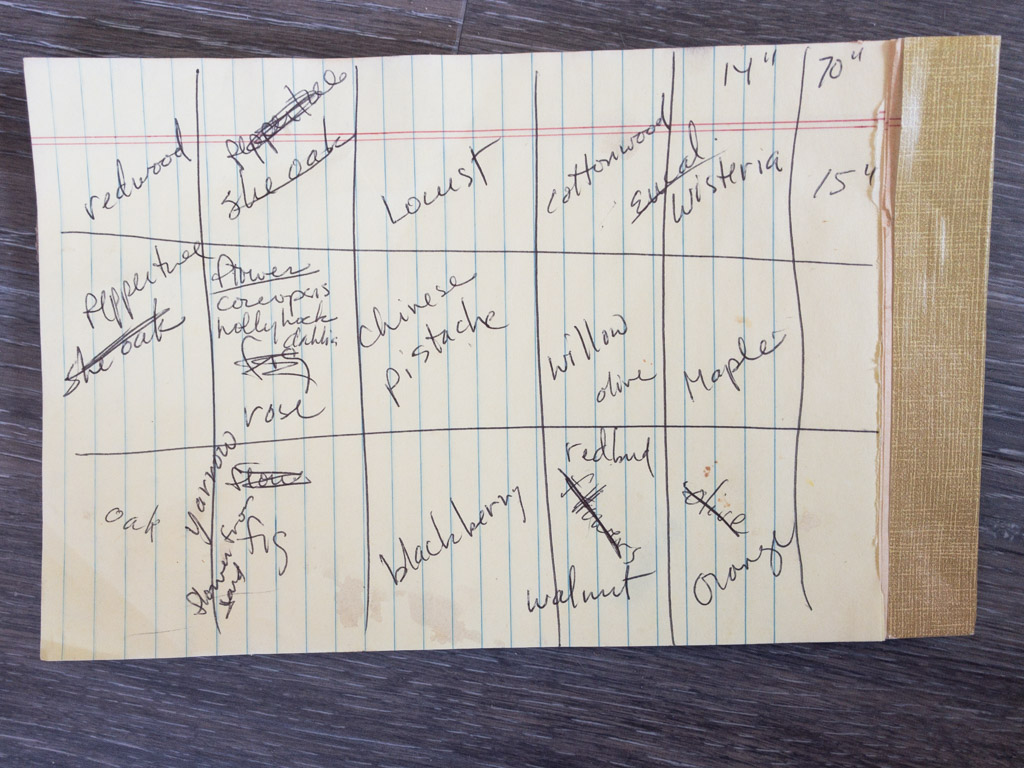 I started with a map because I wanted my two fabrics to have the same plants in the same positions. I started with the top row of this map and covered it with the blanket material and plastic. Then I placed more blanket material (old cotton sheets), placed the plants on that (upside down from how I wanted them to appear) and folded over the middle third of the fabric. I placed more plastic to separate the middle and outer third layers and applied more plants. At this point I started to think of other plants I wanted to add so some of these were thrown on in between the others or tucked into the middle layer. The photo above the map is the second piece of fabric with part of it's blanket fabrics, which by this time were any scraps that I could make work. You can see in the blanket fabric on the left the mirror image that was created.
I started with a map because I wanted my two fabrics to have the same plants in the same positions. I started with the top row of this map and covered it with the blanket material and plastic. Then I placed more blanket material (old cotton sheets), placed the plants on that (upside down from how I wanted them to appear) and folded over the middle third of the fabric. I placed more plastic to separate the middle and outer third layers and applied more plants. At this point I started to think of other plants I wanted to add so some of these were thrown on in between the others or tucked into the middle layer. The photo above the map is the second piece of fabric with part of it's blanket fabrics, which by this time were any scraps that I could make work. You can see in the blanket fabric on the left the mirror image that was created. 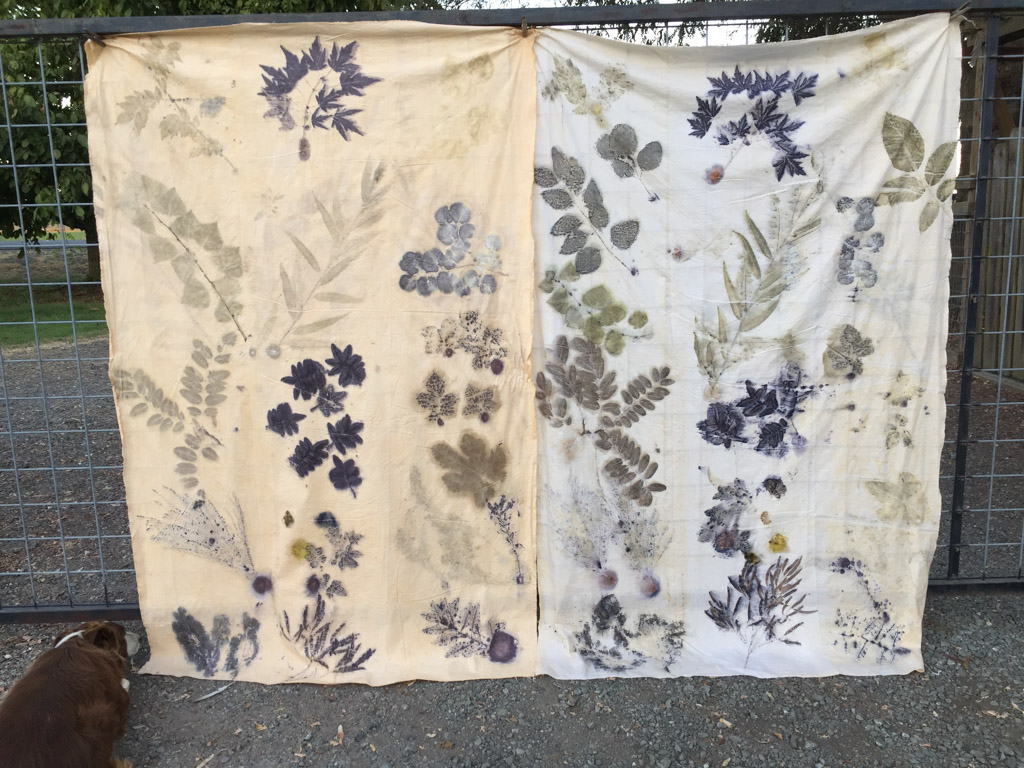 Here are the two fabrics I printed. Both were dipped in the iron solution before using them. The one on the left was the first one that I did. I think it looks a little less messy because I took more time with it. By the time I got to the second one everyone else was taking theirs out of the steamer and I wanted to hurry...and add more plants that I thought of. Differences: The one on the left was not mordanted and the one on the right was. I don't know that it made any difference at all in how the plant material reacted with the fabric. Both were dipped in iron. Reasons for the difference? The first project (on the left) took me a lot longer because I was running around finding things like matches and hot pads, cutting PVC pipe, etc. I could see the fabric darkening as it sat out. By the time I got to the second one the iron bath had been mixed longer and I hear that the effectiveness is quickly reduced after it has been mixed. So was it the time the iron bath had been mixed? The time between dipping and steaming? The alum mordant on the right?
Here are the two fabrics I printed. Both were dipped in the iron solution before using them. The one on the left was the first one that I did. I think it looks a little less messy because I took more time with it. By the time I got to the second one everyone else was taking theirs out of the steamer and I wanted to hurry...and add more plants that I thought of. Differences: The one on the left was not mordanted and the one on the right was. I don't know that it made any difference at all in how the plant material reacted with the fabric. Both were dipped in iron. Reasons for the difference? The first project (on the left) took me a lot longer because I was running around finding things like matches and hot pads, cutting PVC pipe, etc. I could see the fabric darkening as it sat out. By the time I got to the second one the iron bath had been mixed longer and I hear that the effectiveness is quickly reduced after it has been mixed. So was it the time the iron bath had been mixed? The time between dipping and steaming? The alum mordant on the right?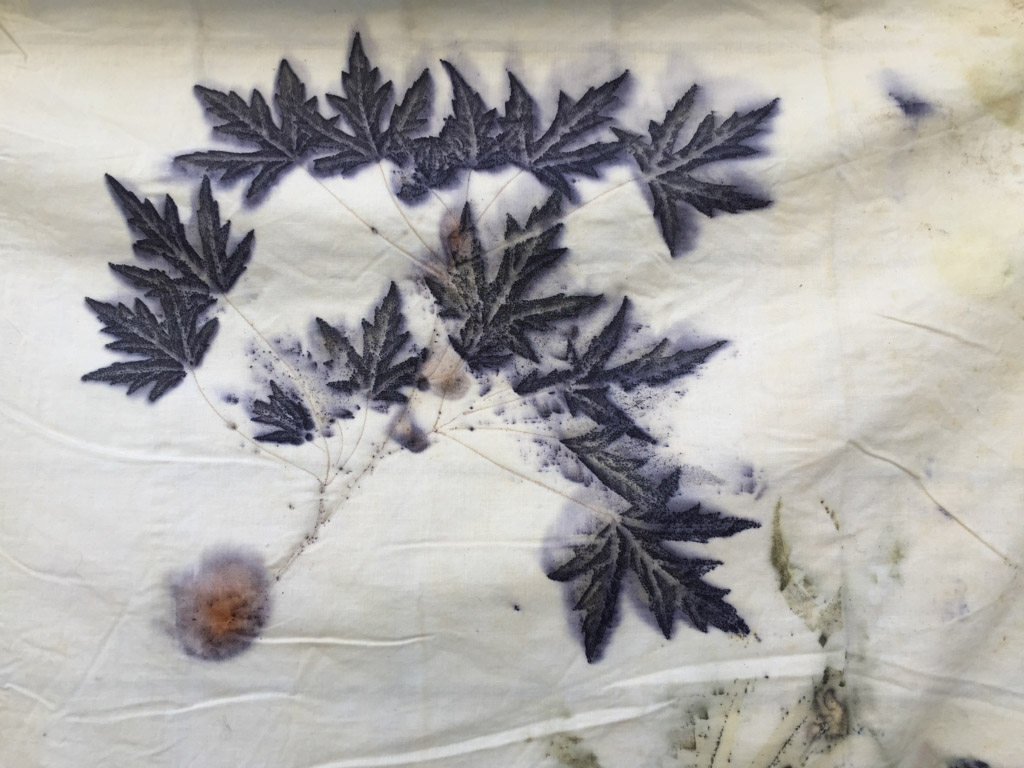 Maple leaves. When you see the spots that look like bulbs--those are the tannins leaking out of the stems in plant material with plenty of tannin. (At least that's he explanation I've heard.)
Maple leaves. When you see the spots that look like bulbs--those are the tannins leaking out of the stems in plant material with plenty of tannin. (At least that's he explanation I've heard.)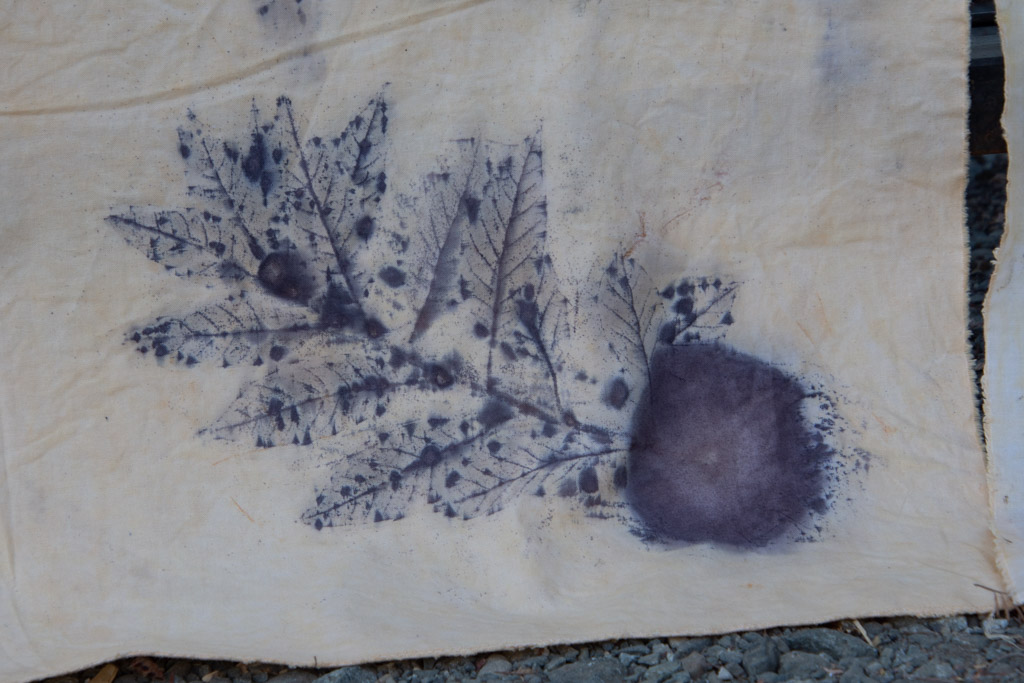 Oak branch.
Oak branch.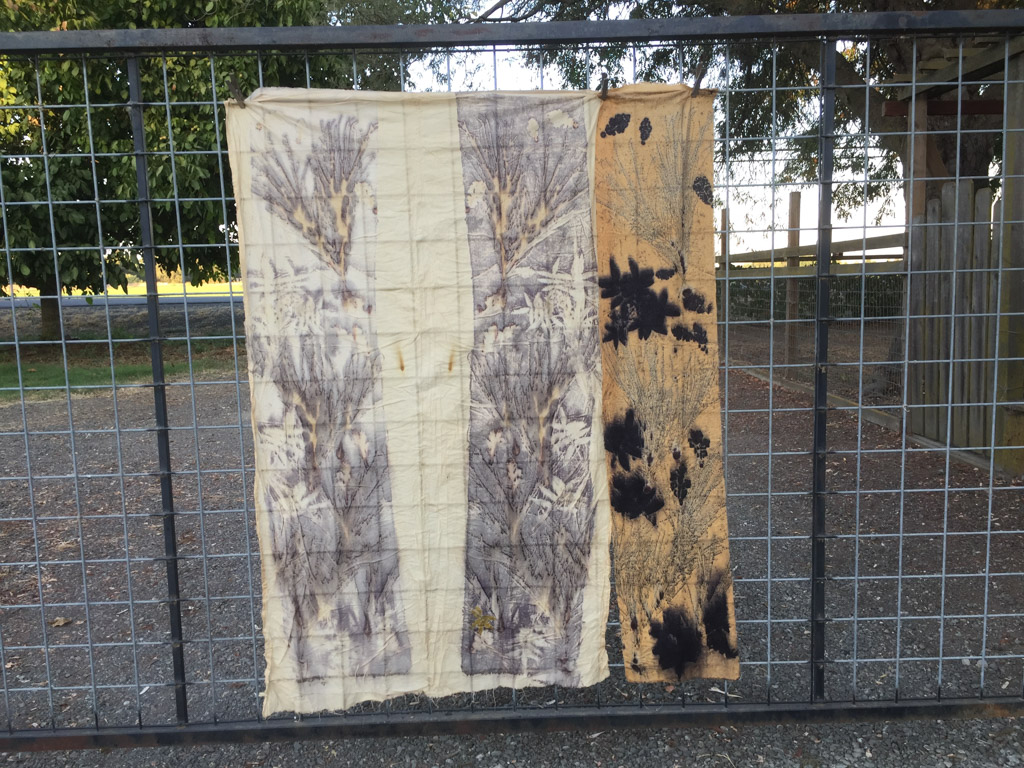 I dipped the silk (right) in tannin and the blanket material (large piece of cotton that I didn't cut and instead just folded over) in iron. I used three plants on the silk.
I dipped the silk (right) in tannin and the blanket material (large piece of cotton that I didn't cut and instead just folded over) in iron. I used three plants on the silk.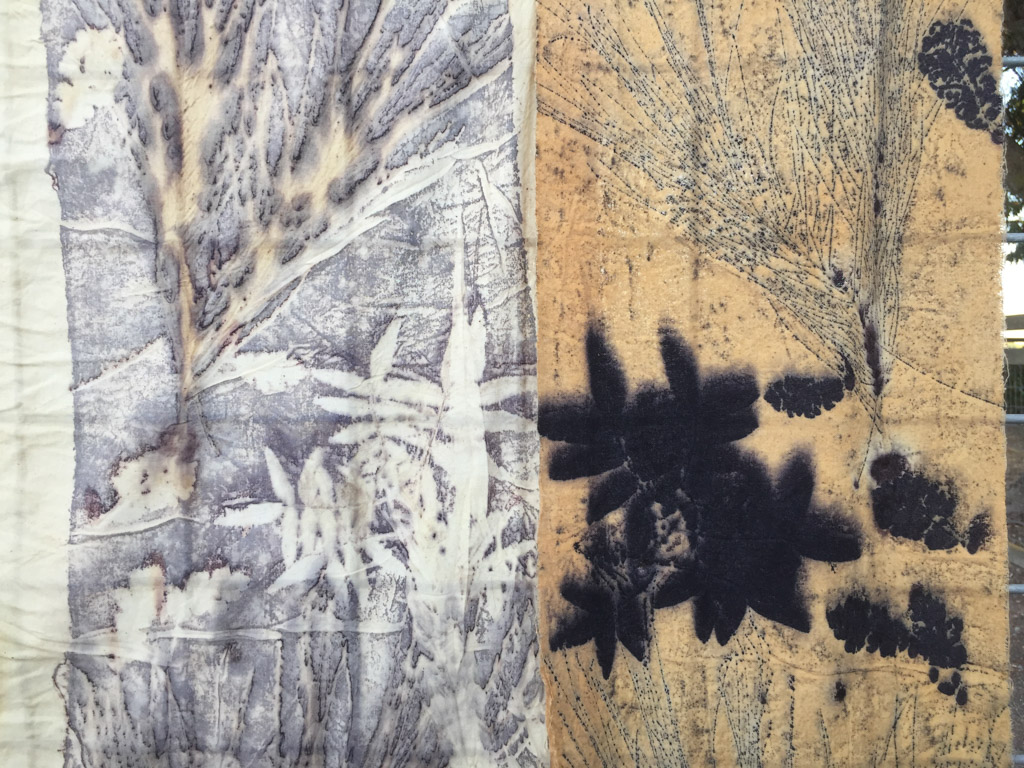 We were loving the effect of the sheoak (Casuarina sp) on some of the other pieces. That's that wispy one that you see better on the silk. I had added Chinese pistache and oak leaves. Wow. Way too much tannin effect. The outline of the pistache on the blanket fabric is pretty but it doesn't look so good on the silk. Note to self--use one leaf, not a branch, and maybe even that would be too much. I lost the definition in the oak leaves as well.
We were loving the effect of the sheoak (Casuarina sp) on some of the other pieces. That's that wispy one that you see better on the silk. I had added Chinese pistache and oak leaves. Wow. Way too much tannin effect. The outline of the pistache on the blanket fabric is pretty but it doesn't look so good on the silk. Note to self--use one leaf, not a branch, and maybe even that would be too much. I lost the definition in the oak leaves as well.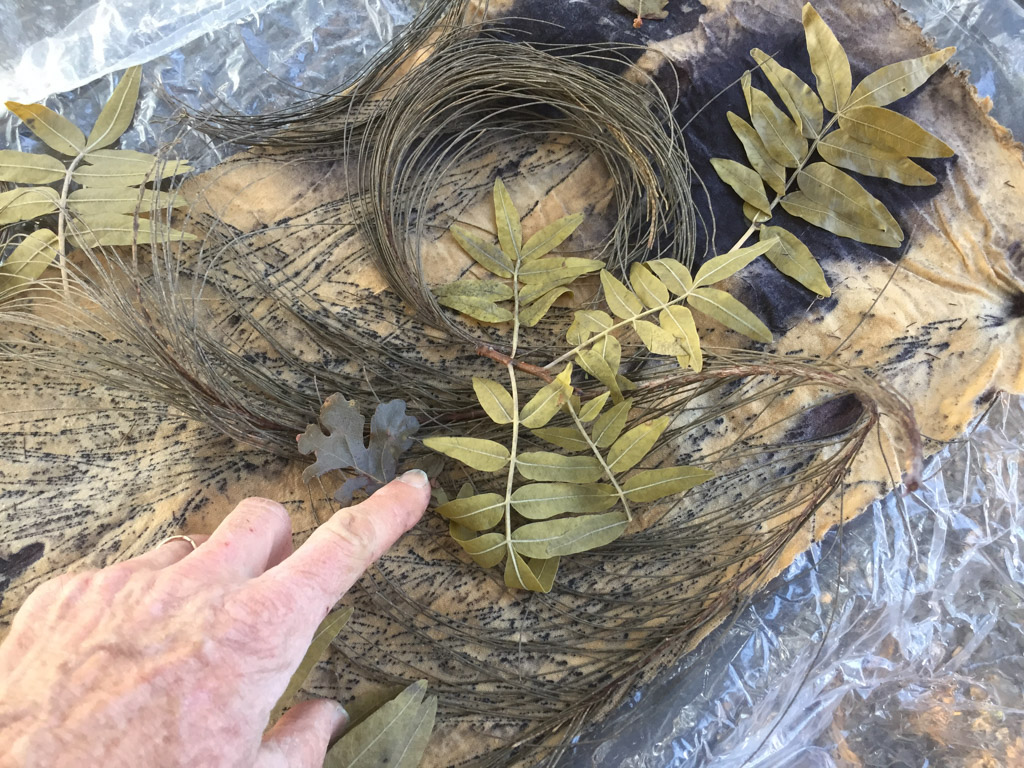 Here are those three plant materials after dyeing.
Here are those three plant materials after dyeing.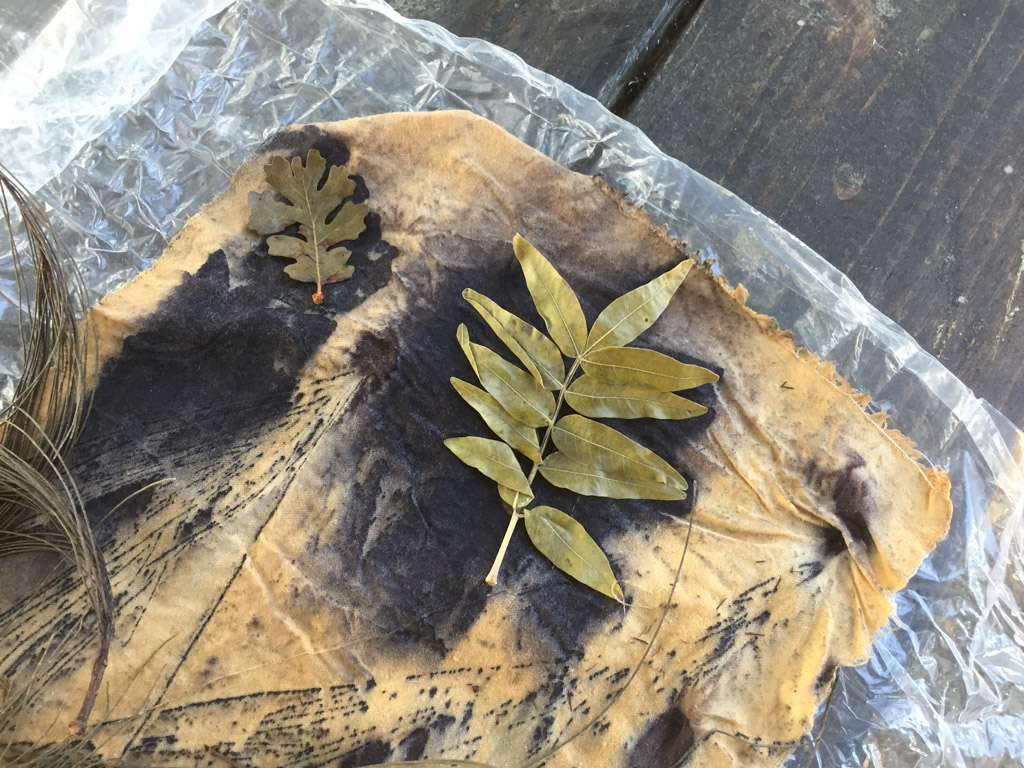 Another view of the oak leaf and the Chinese pistache.
Another view of the oak leaf and the Chinese pistache.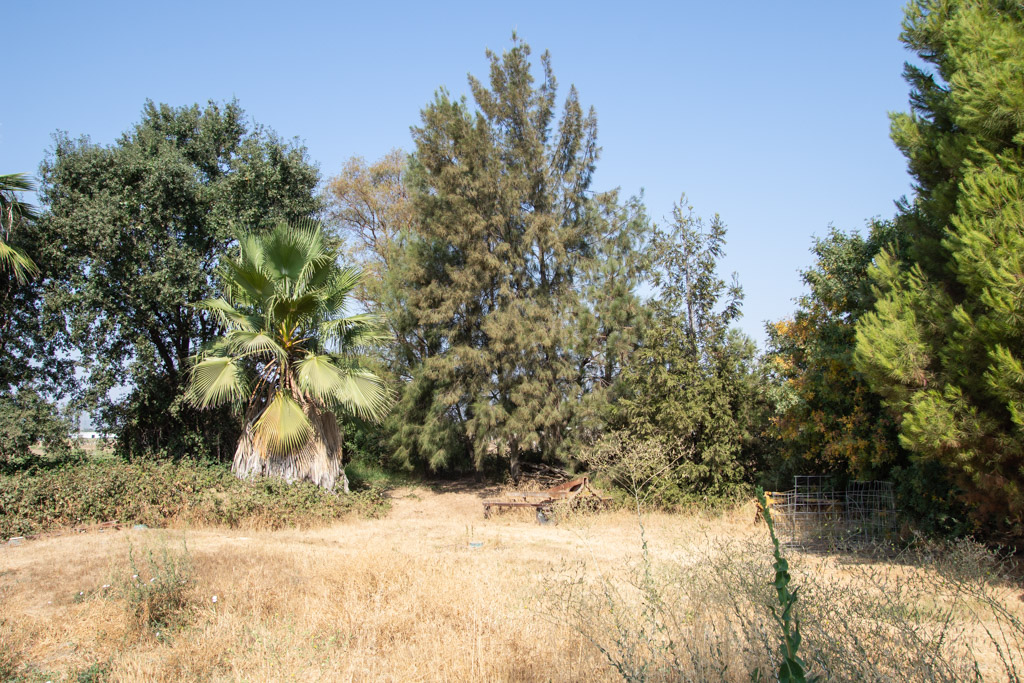 I went out back to photograph the trees. Oak on the left with a palm in front of it. The sheoak is the tall feathery looking one and the smaller tree turning yellow is the pistache.
I went out back to photograph the trees. Oak on the left with a palm in front of it. The sheoak is the tall feathery looking one and the smaller tree turning yellow is the pistache.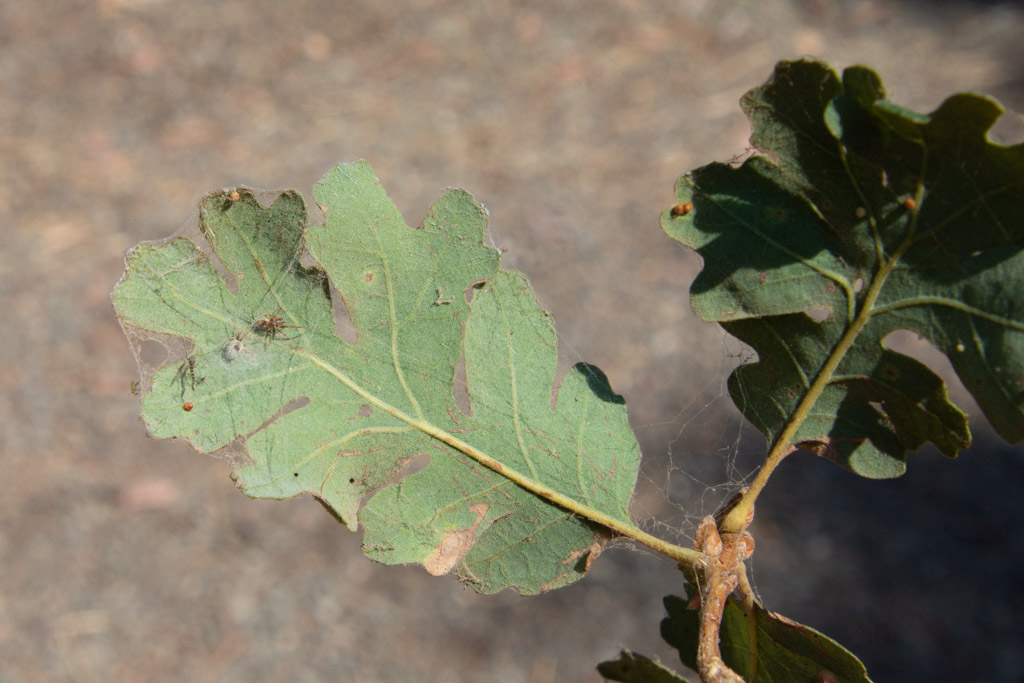 I brought some of the oak leaves in to check ID because I wasn't sure which oak this was (Valley Oak). Look at what a community of other things is on the underside of the leaf. There are two different spiders there as well as...
I brought some of the oak leaves in to check ID because I wasn't sure which oak this was (Valley Oak). Look at what a community of other things is on the underside of the leaf. There are two different spiders there as well as...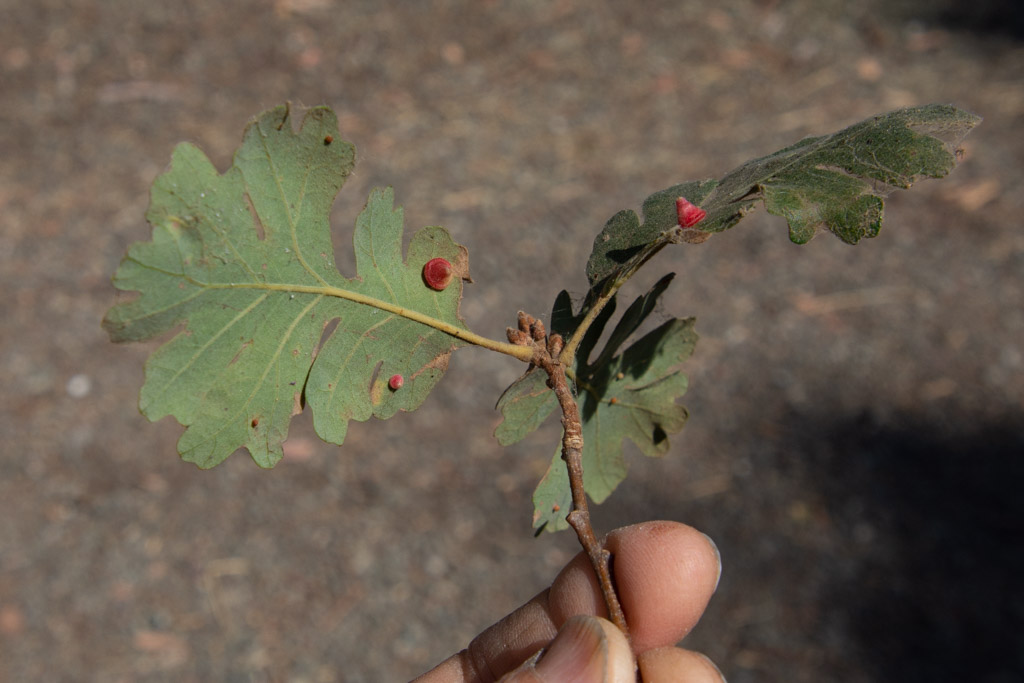 ...these growths that were described appropriately enough on-line as "miniature chocolate kisses covered with red foil". These are the response of the tree to the Red cone gall wasp, a tiny (fruit-fly size) wasp that "lays her eggs inside the leaves of the host tree. They hatch and start eating the leaf, which causes the plant to form a hard structure in order to wall off the irritant. This gall is just what the insect needs, though: more plant tissues to eat. The larva pupates and develops into an adult wasp before it emerges." This oak has plenty of the big round oak galls too. I think that I may have to take some photos and write another post about the dozens of things living in this tree.
...these growths that were described appropriately enough on-line as "miniature chocolate kisses covered with red foil". These are the response of the tree to the Red cone gall wasp, a tiny (fruit-fly size) wasp that "lays her eggs inside the leaves of the host tree. They hatch and start eating the leaf, which causes the plant to form a hard structure in order to wall off the irritant. This gall is just what the insect needs, though: more plant tissues to eat. The larva pupates and develops into an adult wasp before it emerges." This oak has plenty of the big round oak galls too. I think that I may have to take some photos and write another post about the dozens of things living in this tree.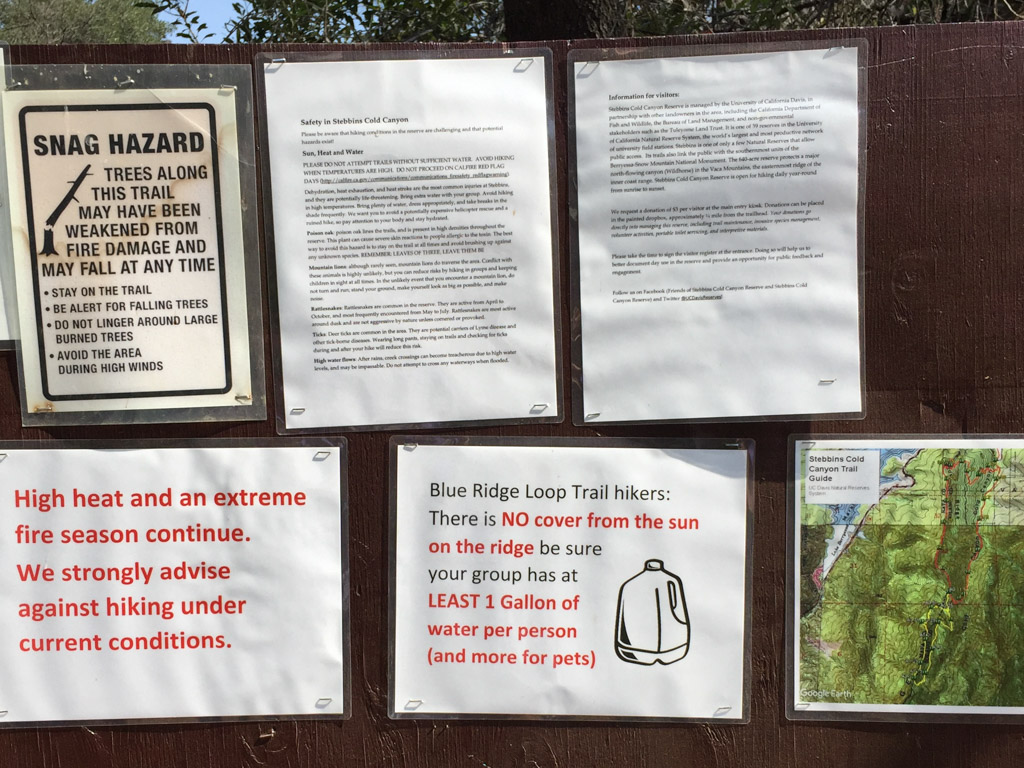 Falling trees, high heat, fires, snakes, poison oak, ticks, mountain lions, high water (that would be a different season). Maybe we should just go back home to the couch.
Falling trees, high heat, fires, snakes, poison oak, ticks, mountain lions, high water (that would be a different season). Maybe we should just go back home to the couch. 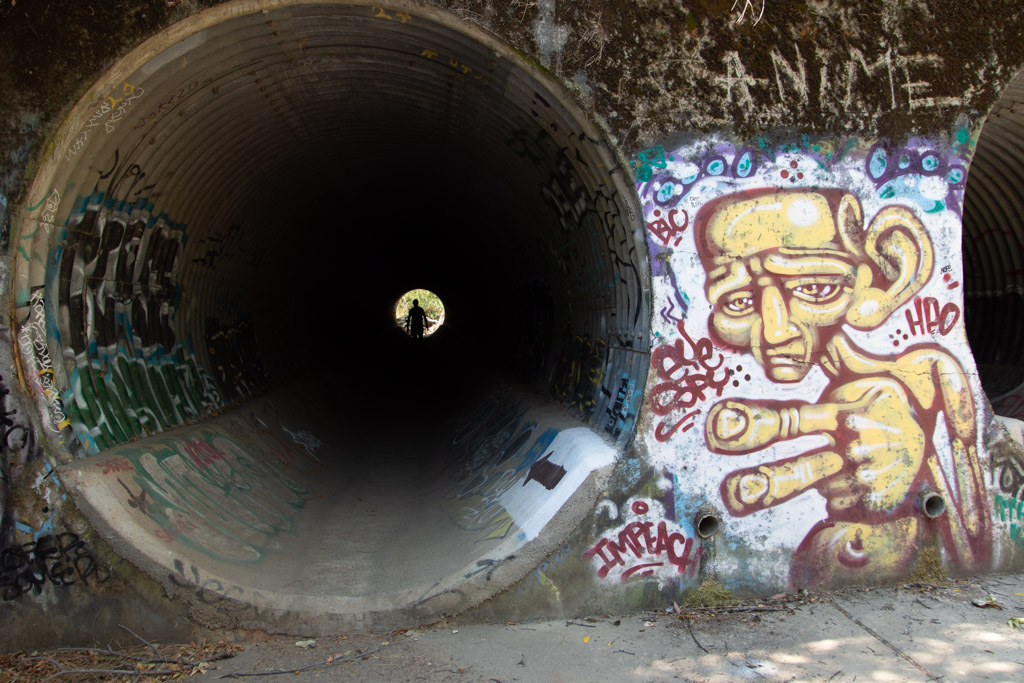 After the 2015 fire the area was rebuilt to accommodate needed parking. Now we park below the Reserve instead of on the side of the road and walk under the road through these huge culverts. This is also where storm water will go in the winter. What's with the graffiti? I am not a fan.
After the 2015 fire the area was rebuilt to accommodate needed parking. Now we park below the Reserve instead of on the side of the road and walk under the road through these huge culverts. This is also where storm water will go in the winter. What's with the graffiti? I am not a fan.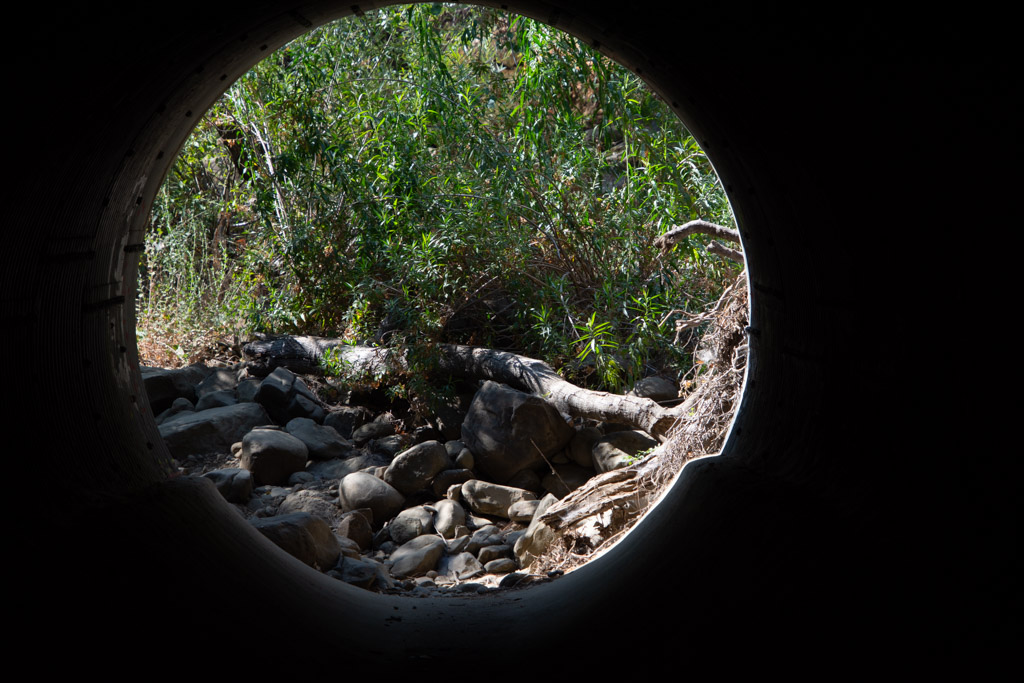 Leaving the culvert.
Leaving the culvert.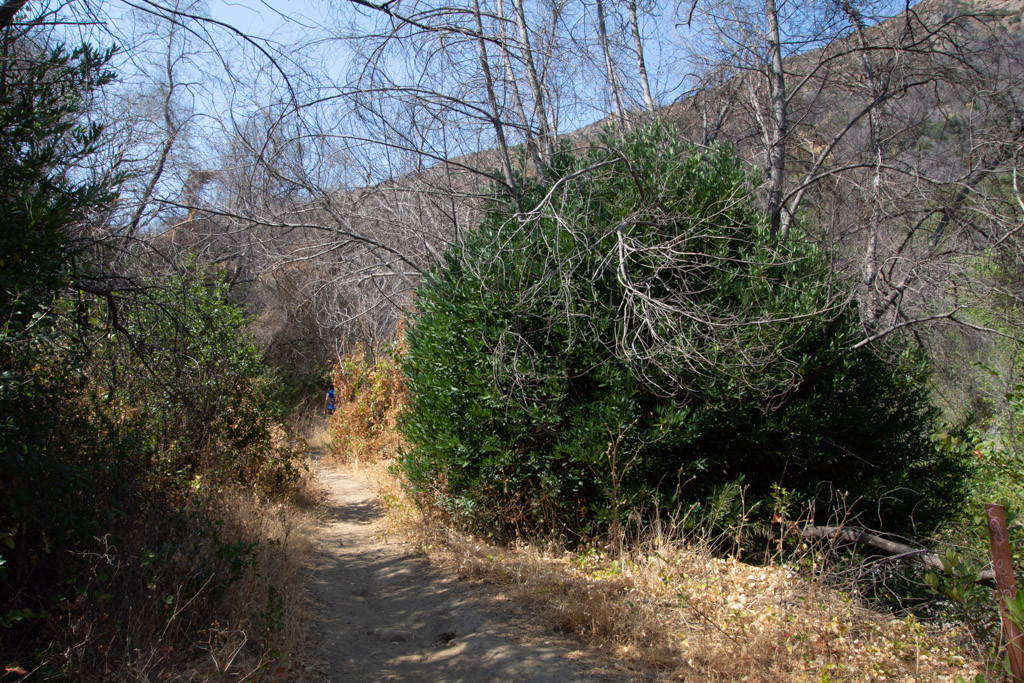 We headed out on the Blue Ridge trail, a five mile round trip. This is three years after the fire. That bush on the right is a CA Bay Laurel growing from the base of the burned tree (it can take on the form of a bush or tree).
We headed out on the Blue Ridge trail, a five mile round trip. This is three years after the fire. That bush on the right is a CA Bay Laurel growing from the base of the burned tree (it can take on the form of a bush or tree).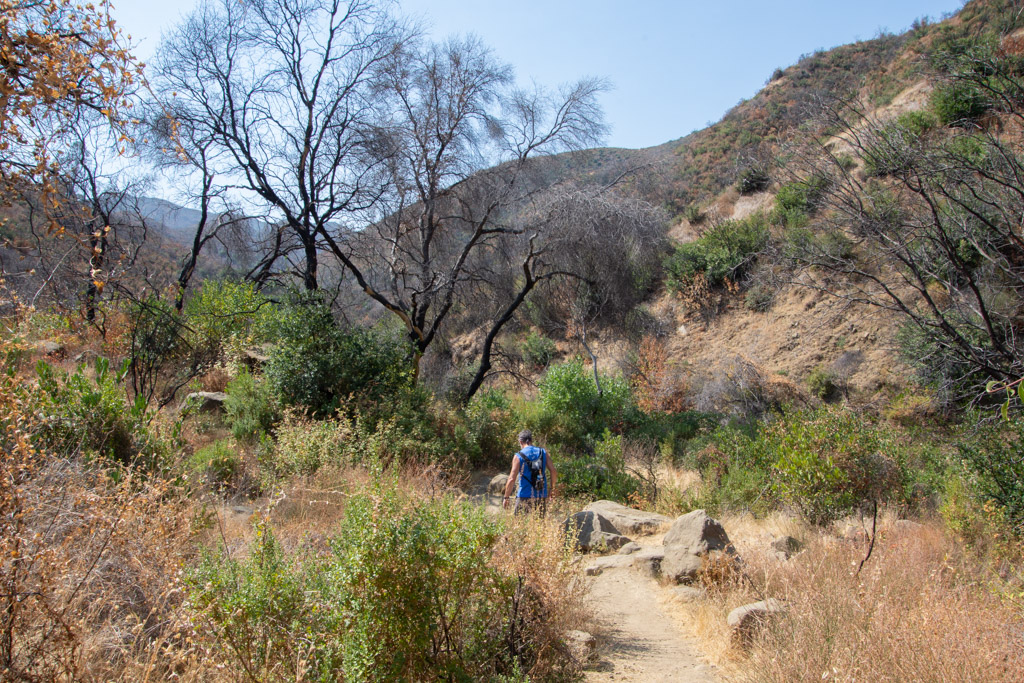
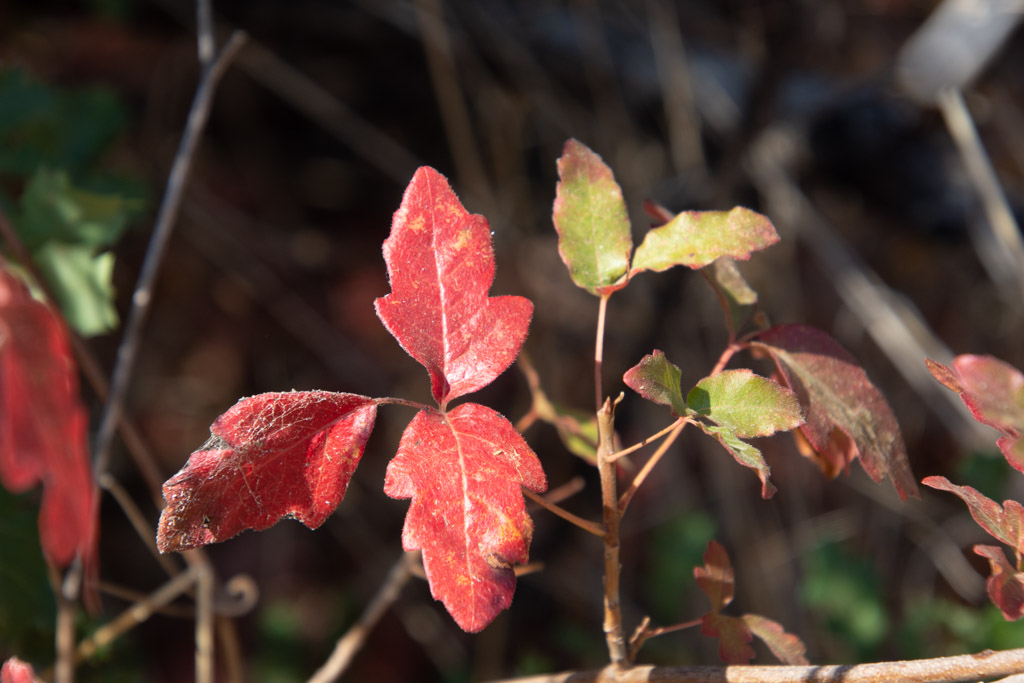 Our first hazard, poison oak.
Our first hazard, poison oak.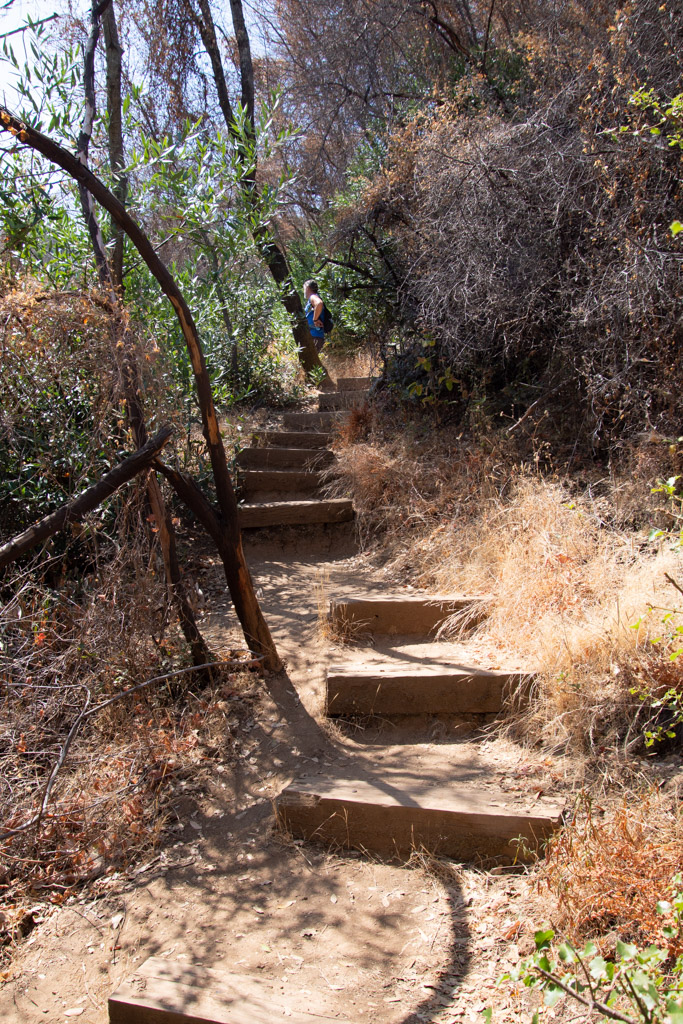 Maybe the next time I go hiking here I'll count the steps. The trail starts in the canyon and eventually you have to get to the top of the ridge. There may be a million stairs--at least it seems that way when you are half way up.
Maybe the next time I go hiking here I'll count the steps. The trail starts in the canyon and eventually you have to get to the top of the ridge. There may be a million stairs--at least it seems that way when you are half way up.  Taking scenic photos is a good excuse to stop. This is a panorama looking southeast.
Taking scenic photos is a good excuse to stop. This is a panorama looking southeast. 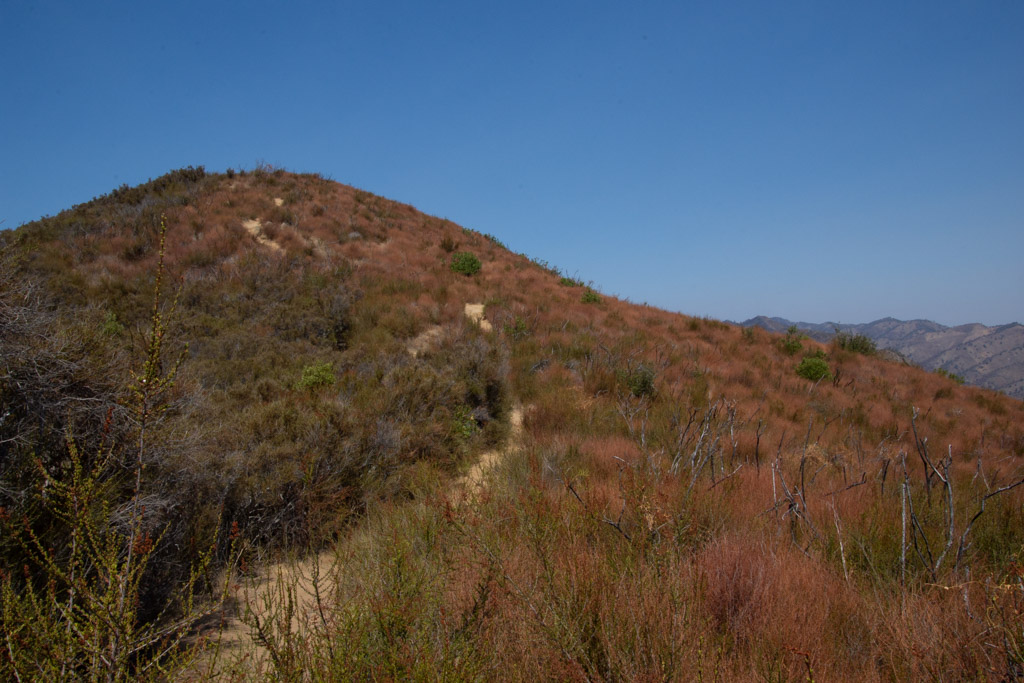 Our trail continued to the ridgeline. This is the bluest sky that I've seen since the fires started in June. We're up above the smoke and haze here.
Our trail continued to the ridgeline. This is the bluest sky that I've seen since the fires started in June. We're up above the smoke and haze here. 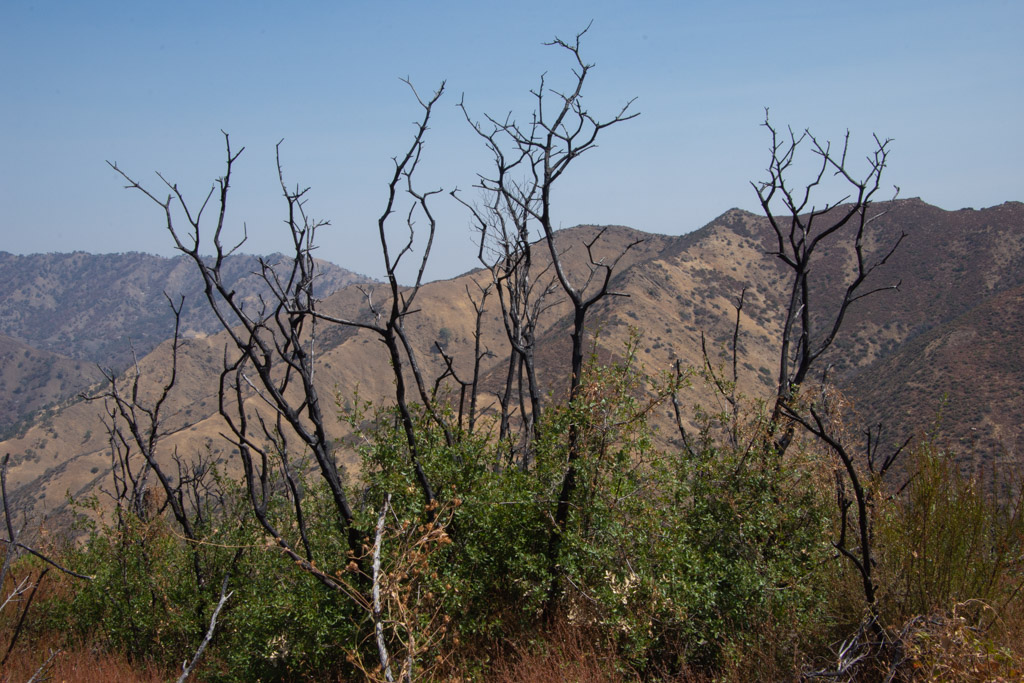
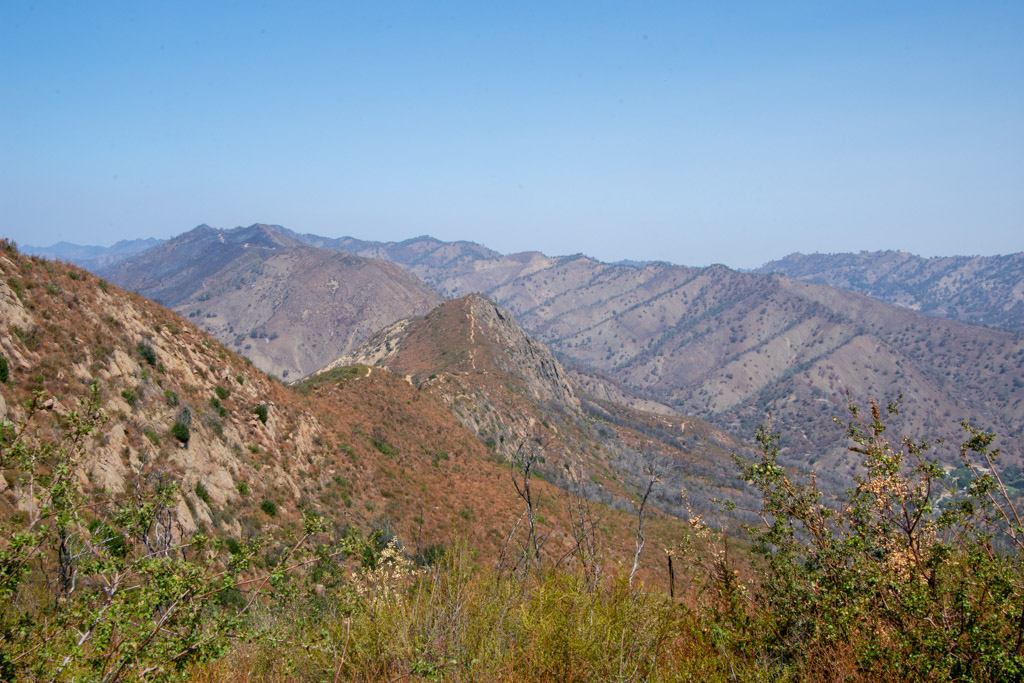 View to the east. That little line on the ridge is our trail.
View to the east. That little line on the ridge is our trail.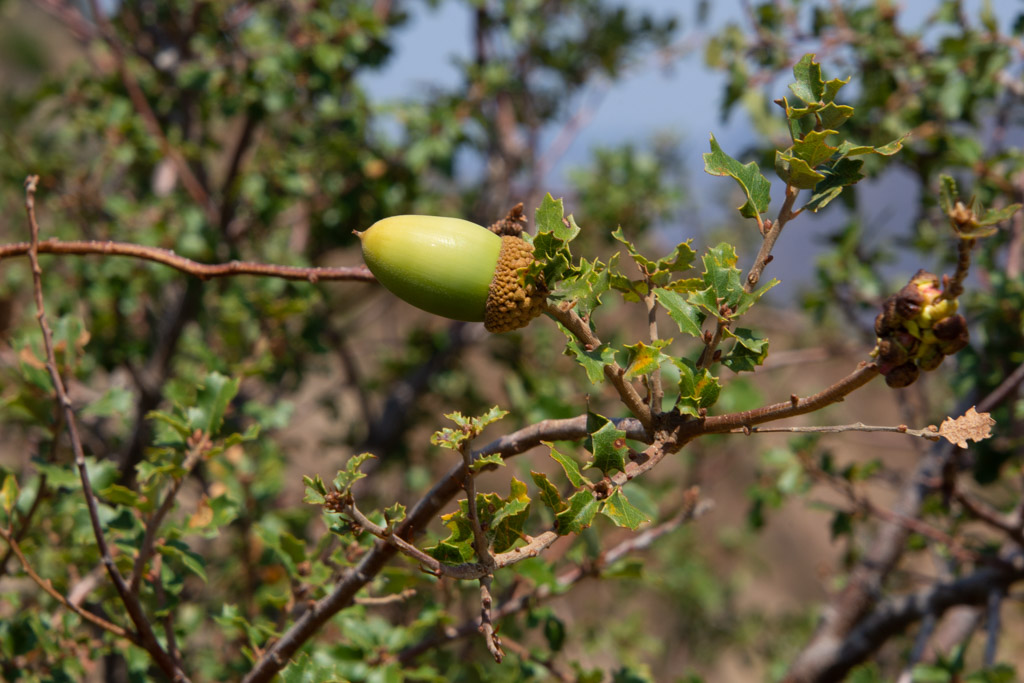
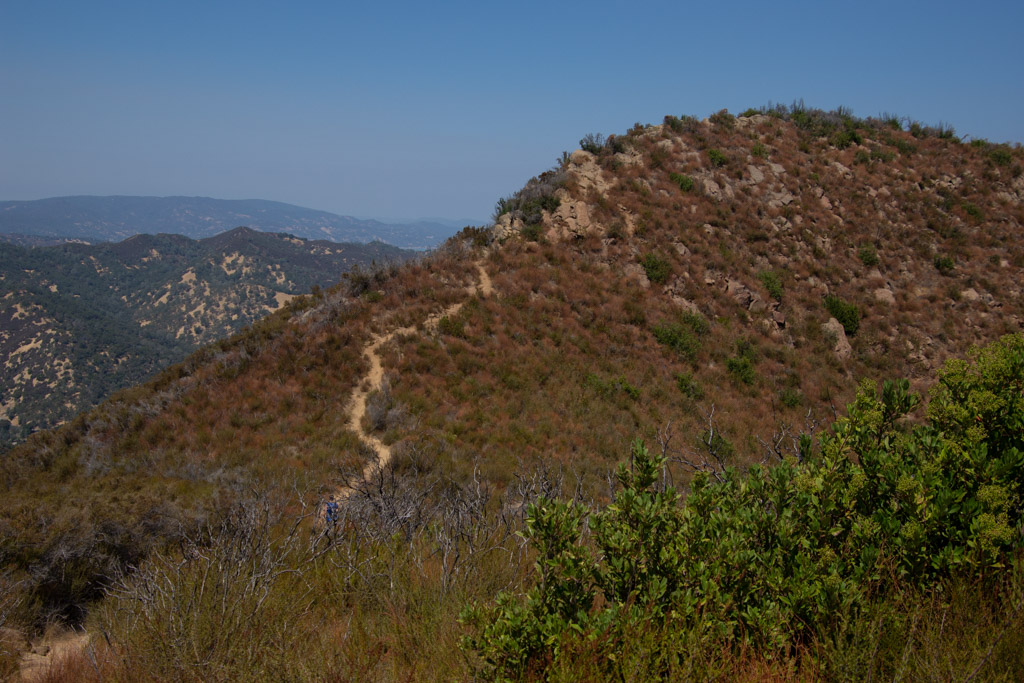
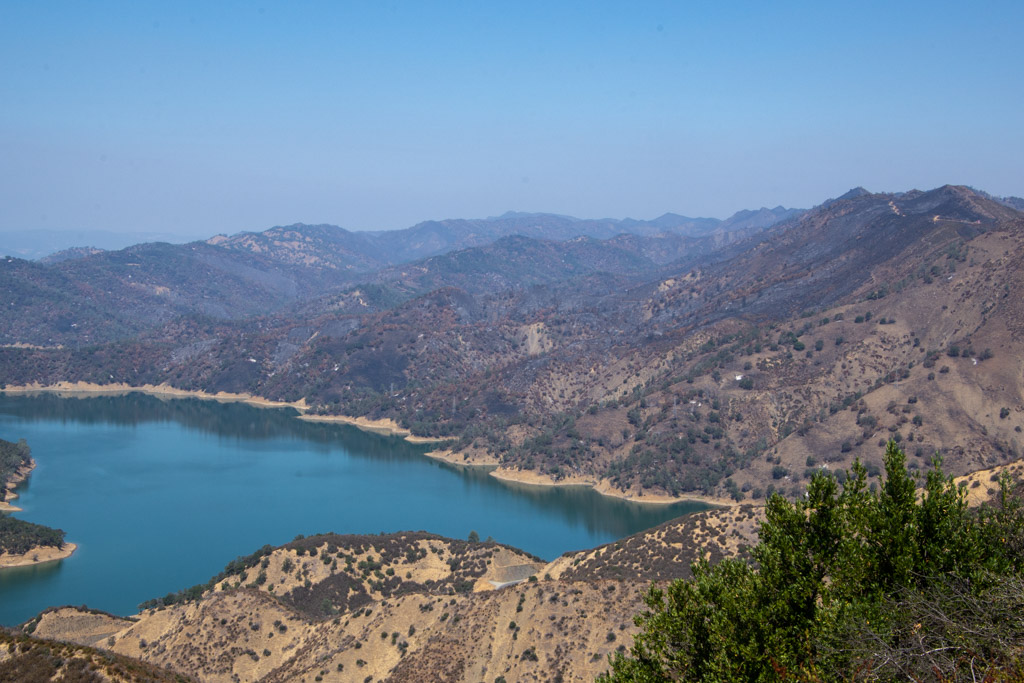 From the top you can look down to Lake Berryessa. Except for the foreground most of the land was burned this summer.
From the top you can look down to Lake Berryessa. Except for the foreground most of the land was burned this summer.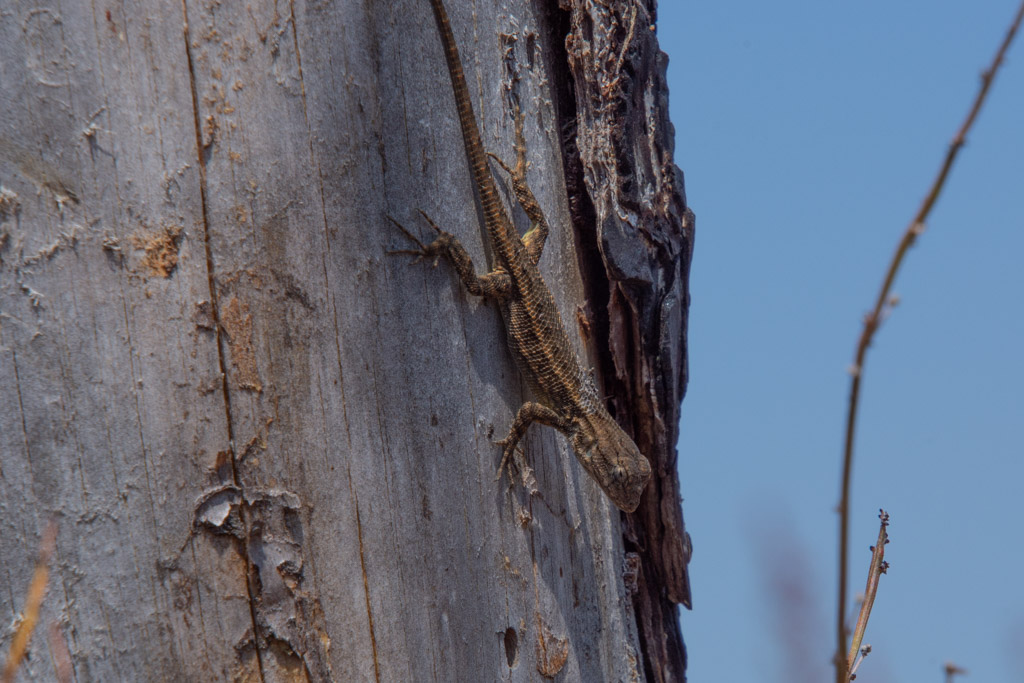
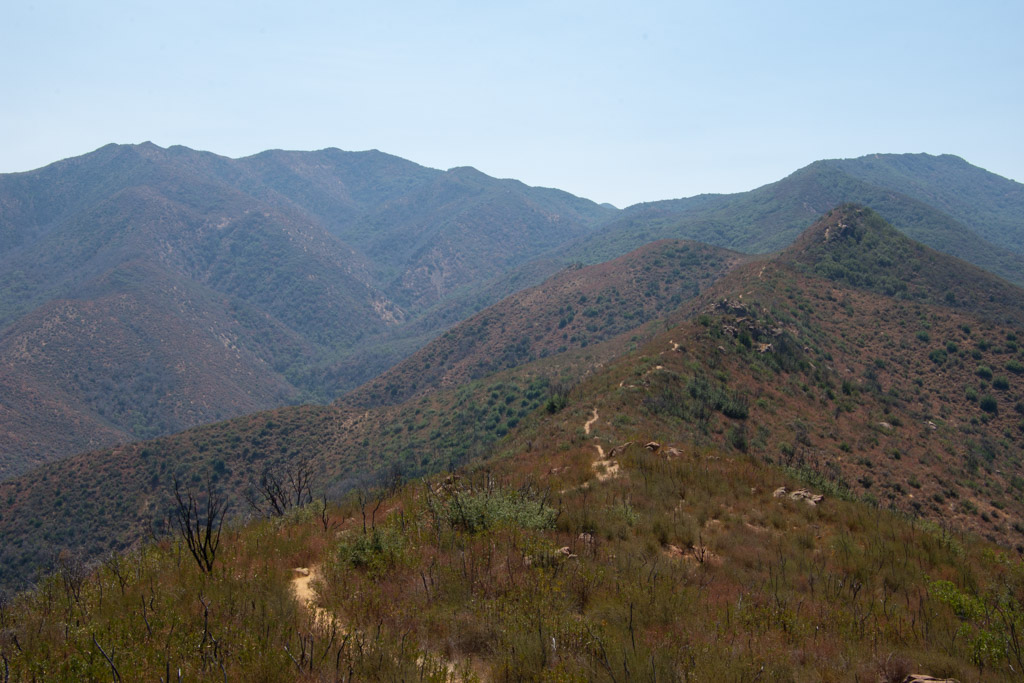 More of the trail. Keep walking.
More of the trail. Keep walking.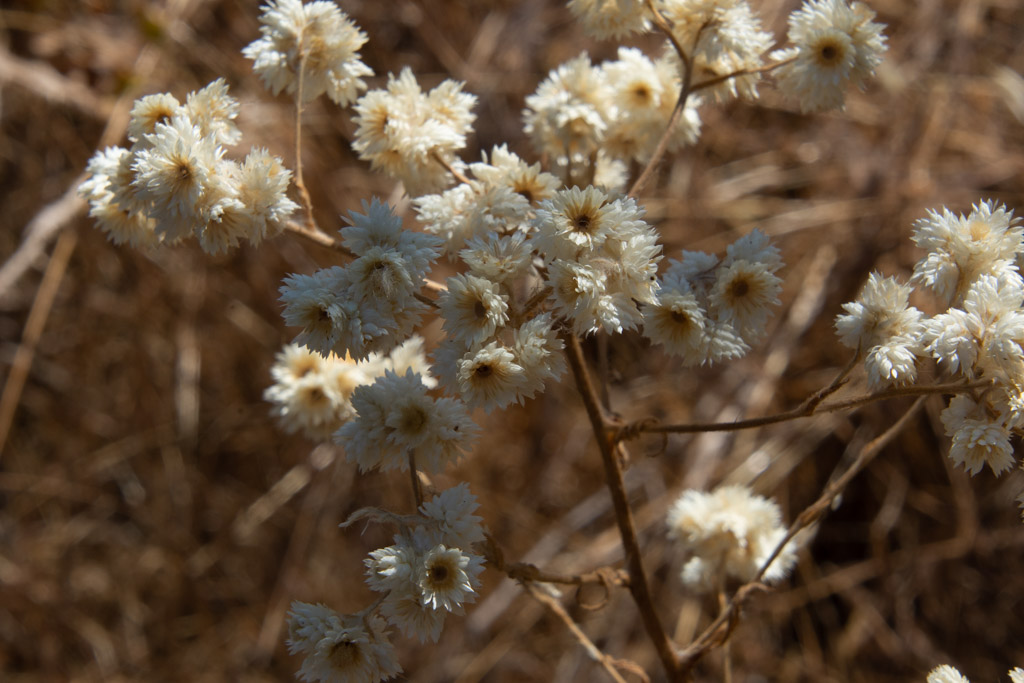 California Cudweed.
California Cudweed.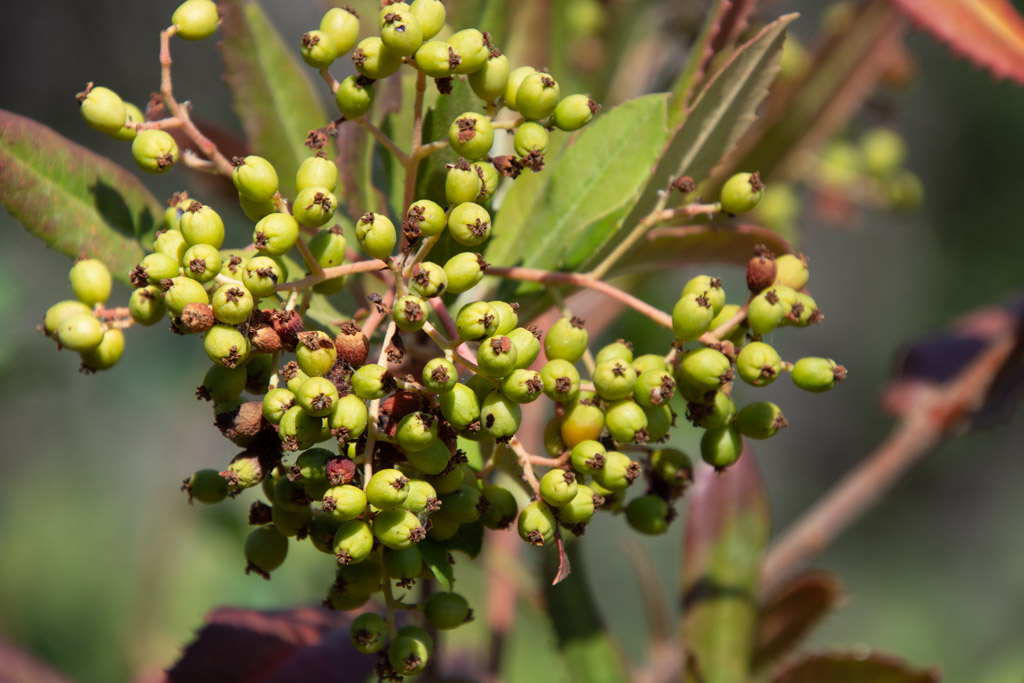 Toyon berries.
Toyon berries.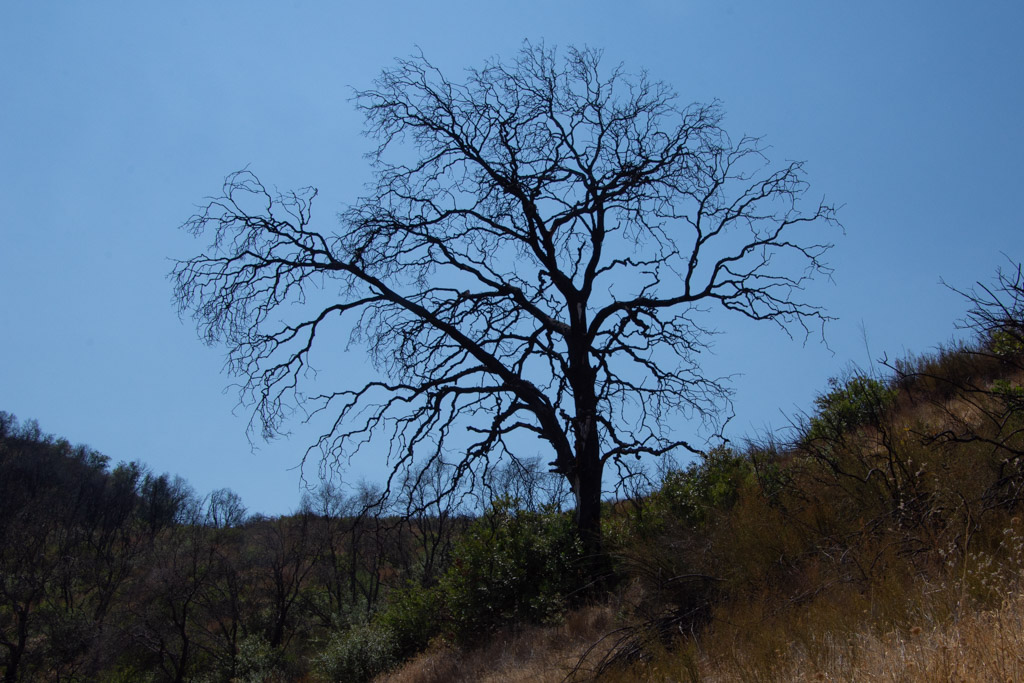 Burned oak.
Burned oak.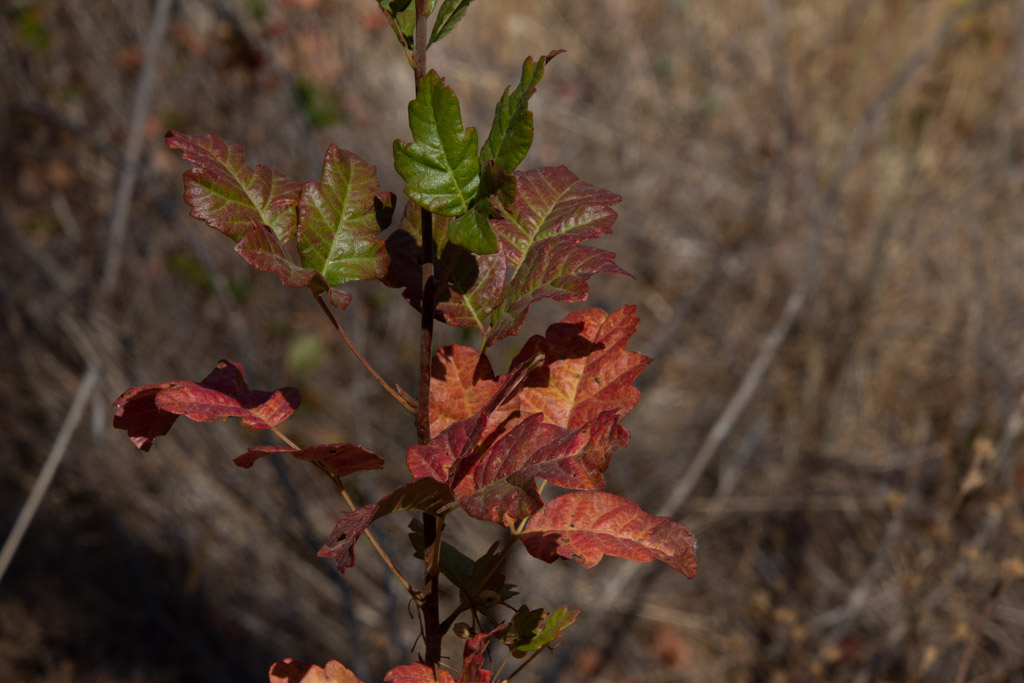 Fall colors (more poison oak).
Fall colors (more poison oak). Here are some examples from the friend who showed us how to do this.
Here are some examples from the friend who showed us how to do this. We went out to the backyard to get started. There was a supervisor already on duty to make sure that we didn't mix up the buckets. One says Iron Sulphate and the other says Tannin.
We went out to the backyard to get started. There was a supervisor already on duty to make sure that we didn't mix up the buckets. One says Iron Sulphate and the other says Tannin. We dipped our fabric in one or the other depending on if it was silk or cotton and then laid it out on the table.
We dipped our fabric in one or the other depending on if it was silk or cotton and then laid it out on the table. I brought weeping willow fronds, oak and eucalyptus leaves, and zinnia and dahlia flowers. I started with silk dipped in tannin solution and then covered this with cotton soaked in the iron solution
I brought weeping willow fronds, oak and eucalyptus leaves, and zinnia and dahlia flowers. I started with silk dipped in tannin solution and then covered this with cotton soaked in the iron solution After rolling everything up and tying it snugly the fabric rolls were steamed for an hour and a half.
After rolling everything up and tying it snugly the fabric rolls were steamed for an hour and a half. While the first batch was steaming we all worked on another project. We were limited by the pot size to a 12" roll. To print a wider fabric it needed to be folded. So that's what I did with this one. This piece is 36" wide. I laid leaves on the center strip and folded one side over. The design would be symmetrical on those two panels. Then I spread plastic on that fabric and placed leaves on the plastic to be printed on the third layer to be folded over.
While the first batch was steaming we all worked on another project. We were limited by the pot size to a 12" roll. To print a wider fabric it needed to be folded. So that's what I did with this one. This piece is 36" wide. I laid leaves on the center strip and folded one side over. The design would be symmetrical on those two panels. Then I spread plastic on that fabric and placed leaves on the plastic to be printed on the third layer to be folded over.  Here are the first ones being unveiled.
Here are the first ones being unveiled. The plant material leaves an outline as it resists the iron on the cotton layer that was applied to it. The iron turns the silk varying shades depending on the strength and freshness of the iron solution.
The plant material leaves an outline as it resists the iron on the cotton layer that was applied to it. The iron turns the silk varying shades depending on the strength and freshness of the iron solution. Interestingly the cotton "blanket" that was rolled up with the silk is sometimes just as appealing as the silk piece.
Interestingly the cotton "blanket" that was rolled up with the silk is sometimes just as appealing as the silk piece. This is a cotton pillowcase in which the design is not from a resist but from the plant material itself.
This is a cotton pillowcase in which the design is not from a resist but from the plant material itself. Here is the project that I did first. I like the printed cotton as much as I do the silk. The willow is the most striking feature. The color spots at the bottom and top are from the flower heads.
Here is the project that I did first. I like the printed cotton as much as I do the silk. The willow is the most striking feature. The color spots at the bottom and top are from the flower heads.
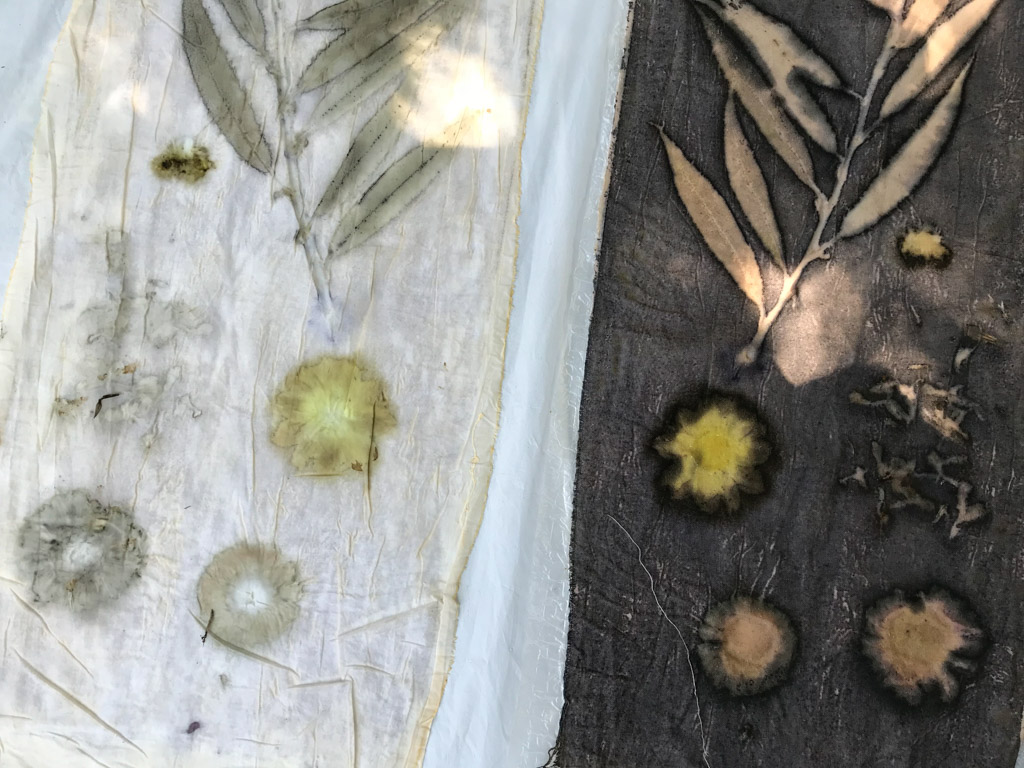
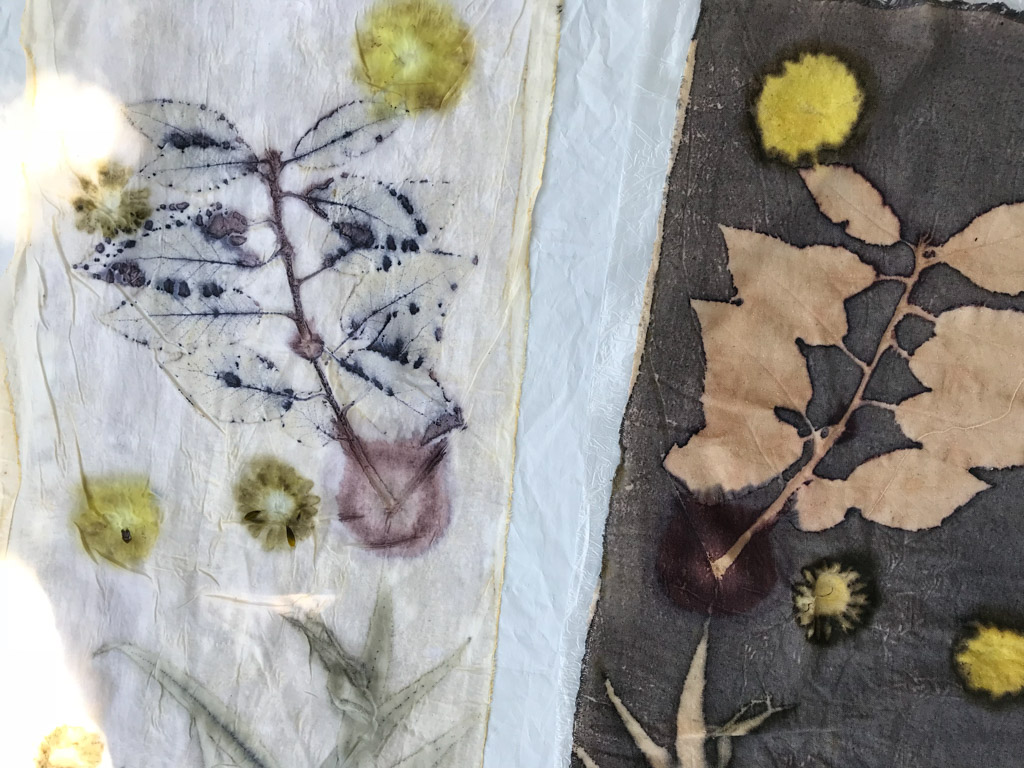
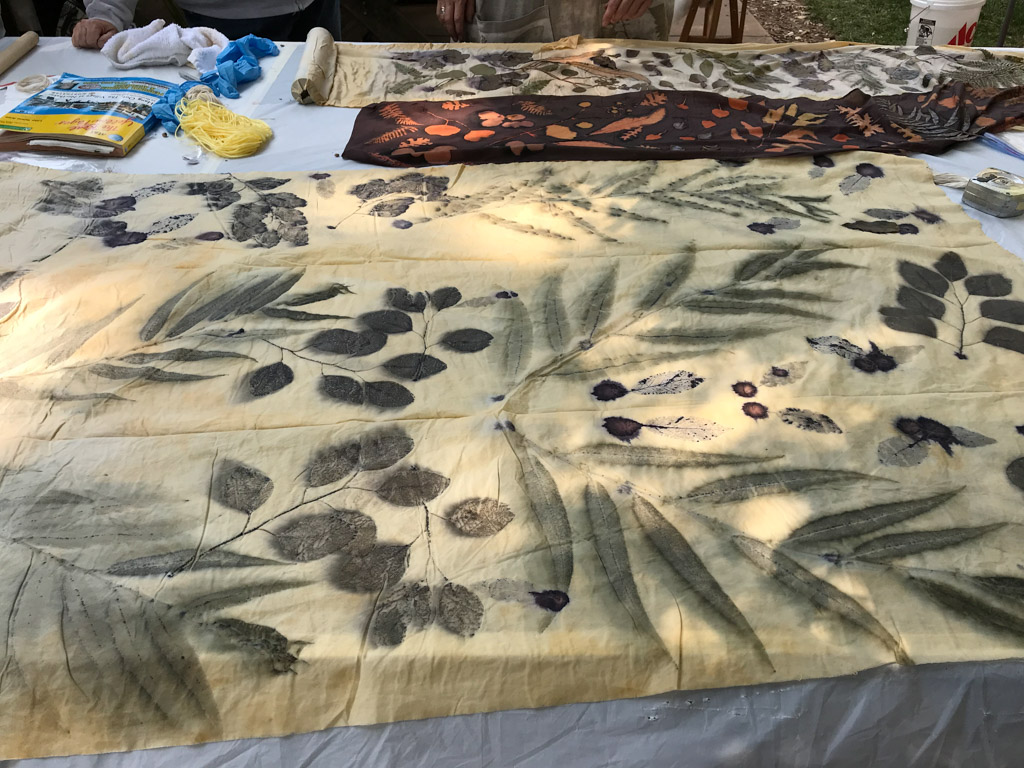 Here is the larger piece that I did.
Here is the larger piece that I did. 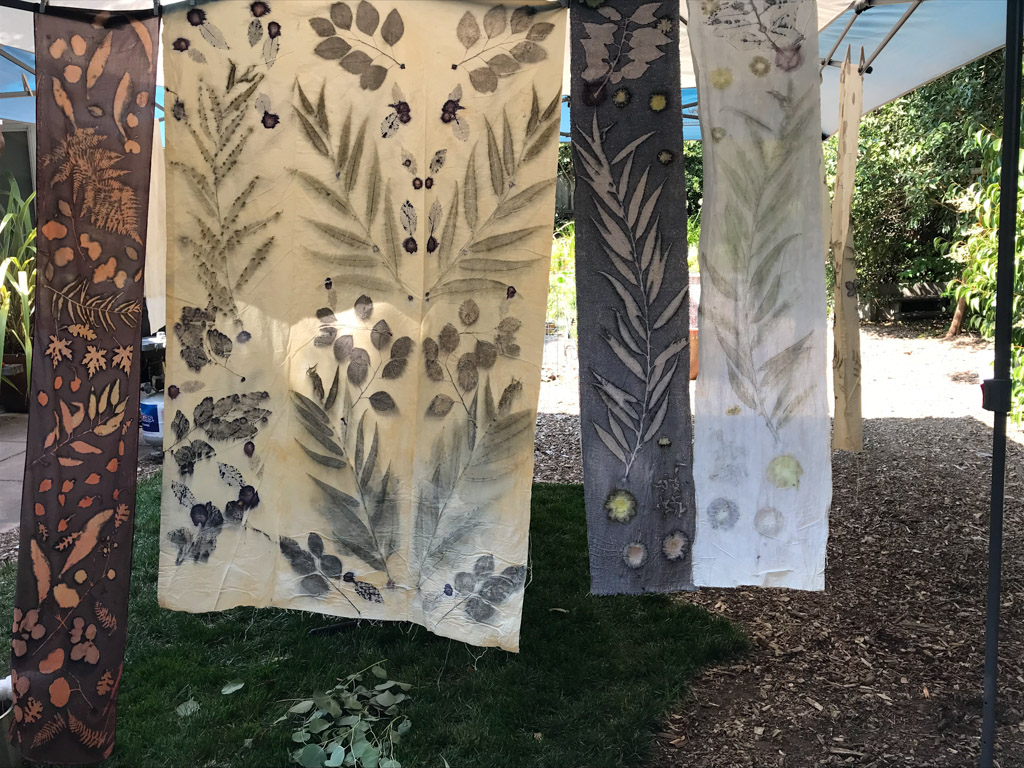 You can see the symmetry of the folded cloth on the right. The third layer has a different look. I think those splotchy parts has something to do with the plant material being rolled right onto the plastic. The tannin "leakage" from the oak leaves is also apparent on this piece.
You can see the symmetry of the folded cloth on the right. The third layer has a different look. I think those splotchy parts has something to do with the plant material being rolled right onto the plastic. The tannin "leakage" from the oak leaves is also apparent on this piece.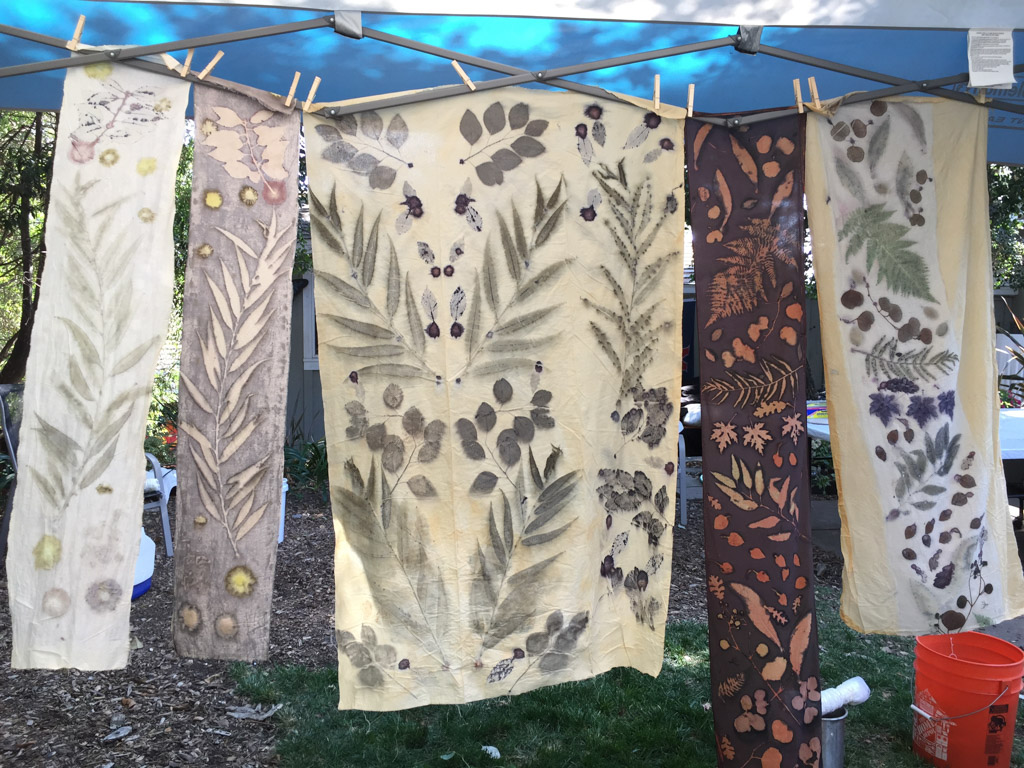 The pieces on the right were a silk scarf that started out a rusty red and the mirror image is the blanket cloth for that scarf. Both are beautiful.
The pieces on the right were a silk scarf that started out a rusty red and the mirror image is the blanket cloth for that scarf. Both are beautiful.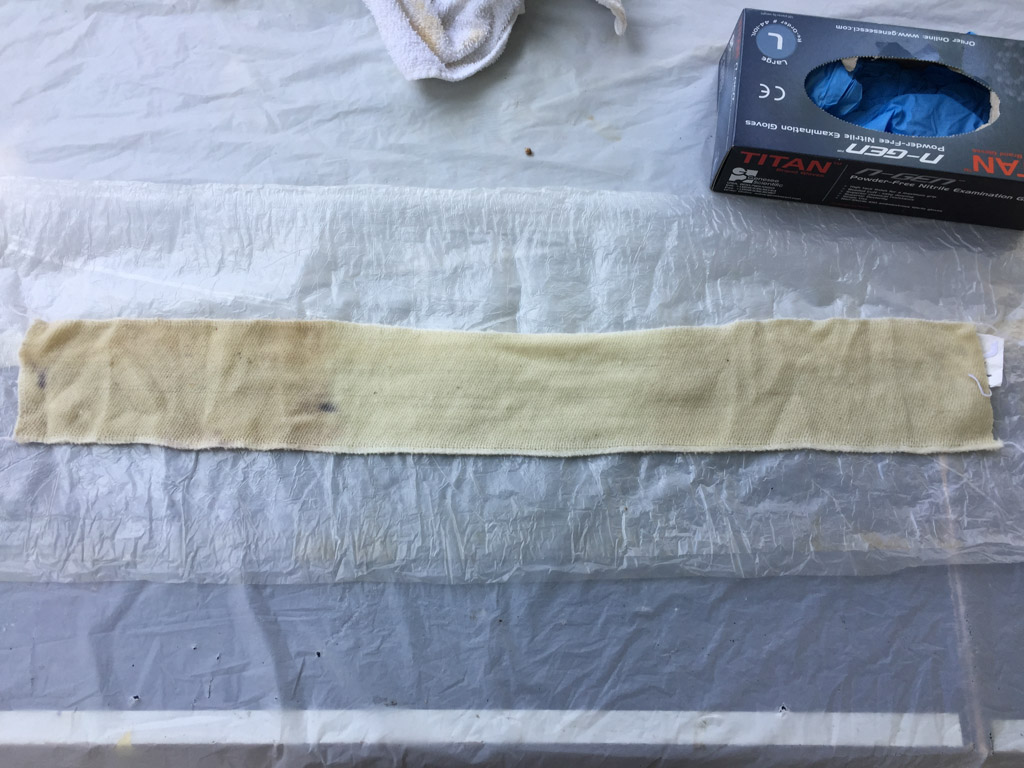 I went there planning to make some wool samples. However I had not mordanted my wool so I decided to save most of it. This piece was dipped in iron (left side) and tannin (right side) and the middle was not treated. I laid out black walnut leaves and did the steaming later at home.
I went there planning to make some wool samples. However I had not mordanted my wool so I decided to save most of it. This piece was dipped in iron (left side) and tannin (right side) and the middle was not treated. I laid out black walnut leaves and did the steaming later at home.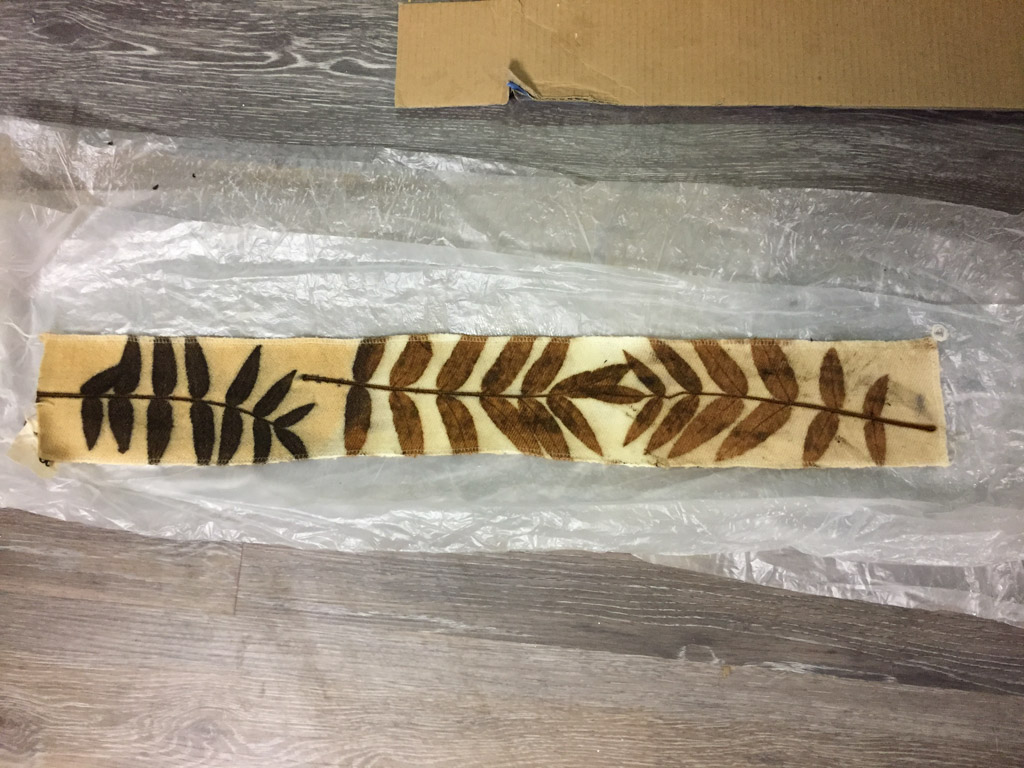 This is the finished sample. Next step will be to wash all of these and see how they hold up. I'm excited to do more of this for sure. ... Like I need another thing to distract me right now.
This is the finished sample. Next step will be to wash all of these and see how they hold up. I'm excited to do more of this for sure. ... Like I need another thing to distract me right now.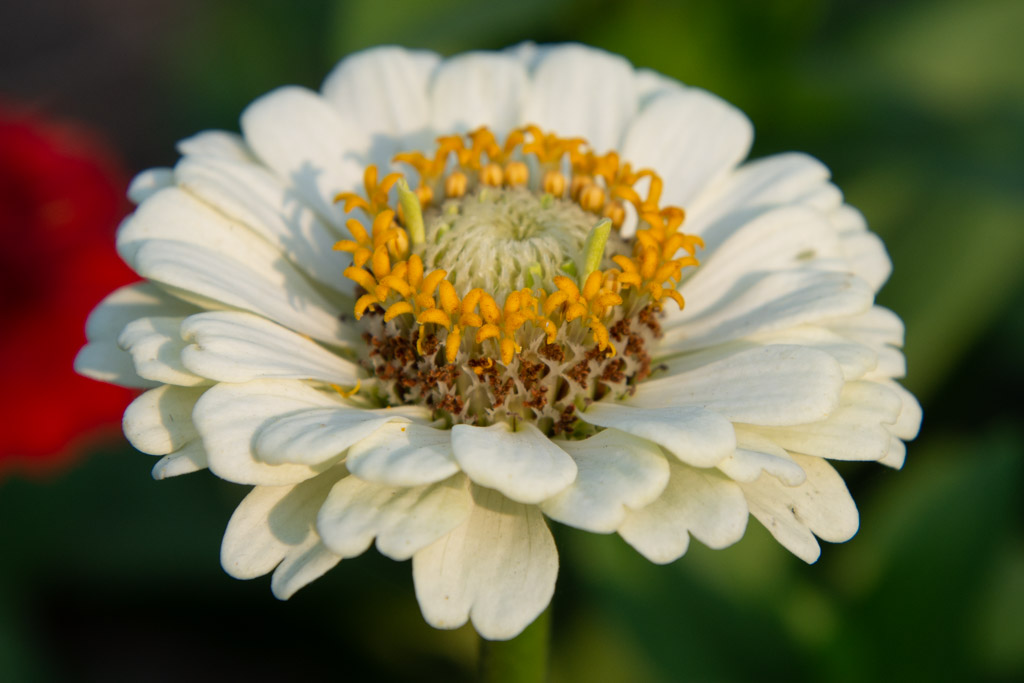
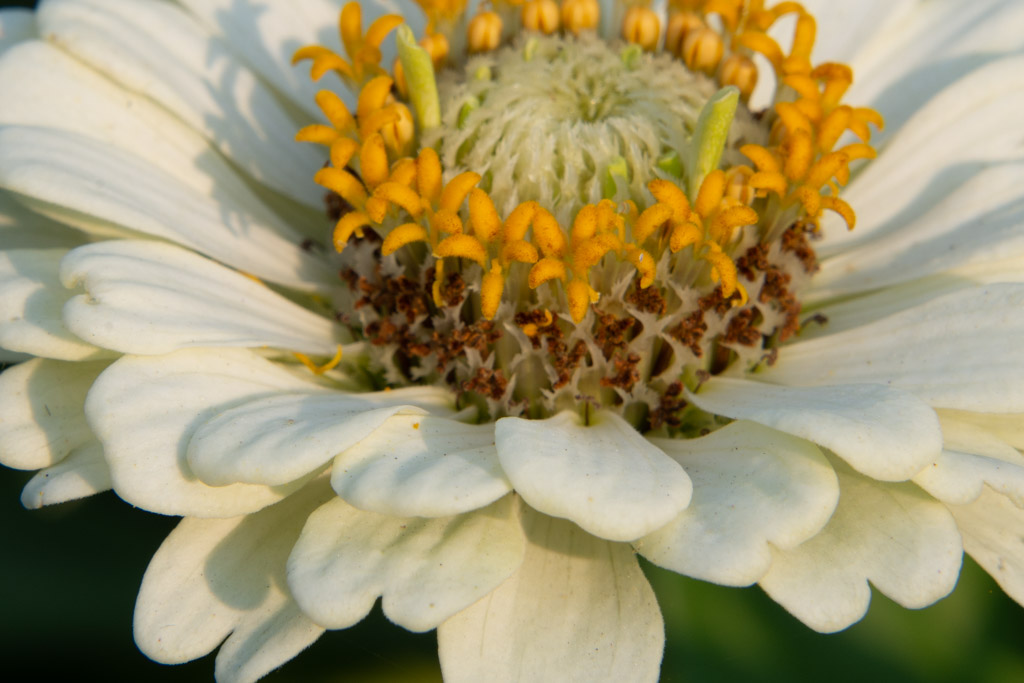
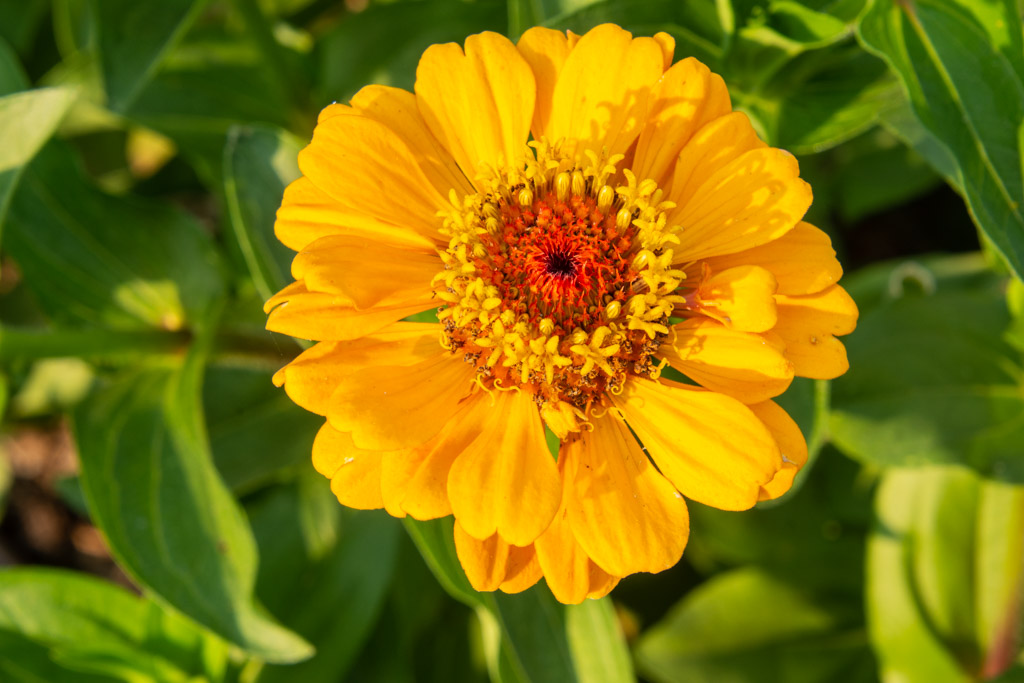
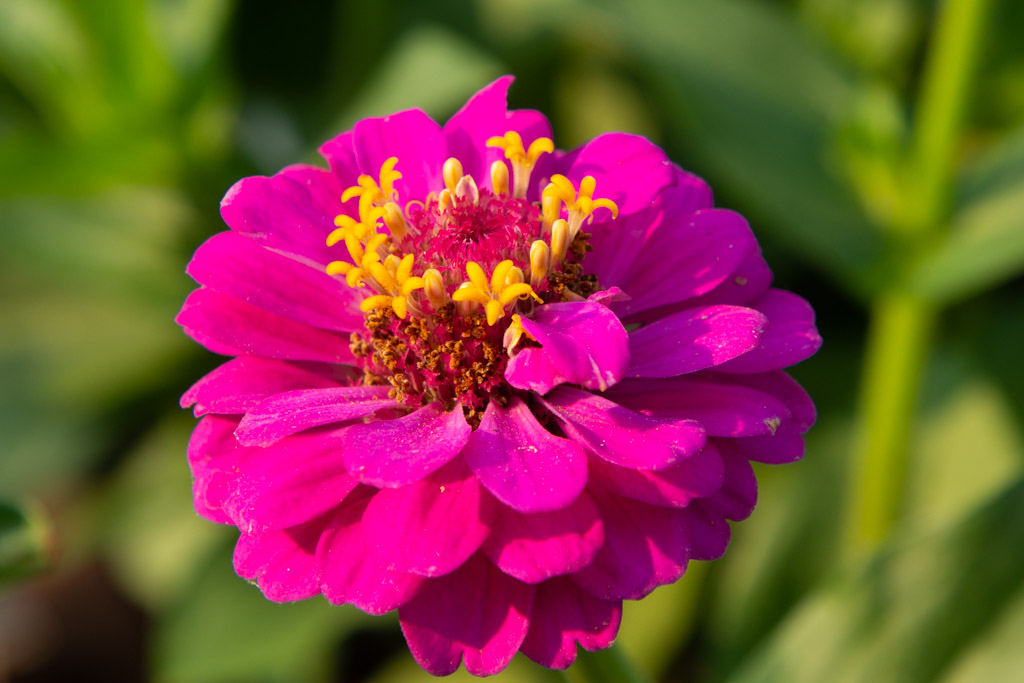
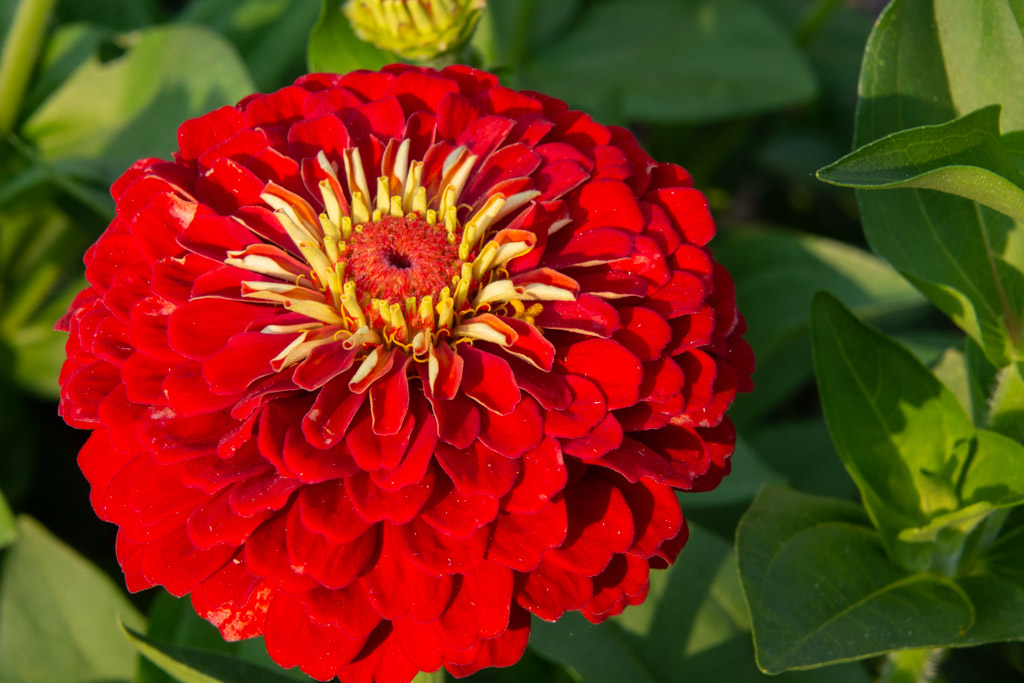
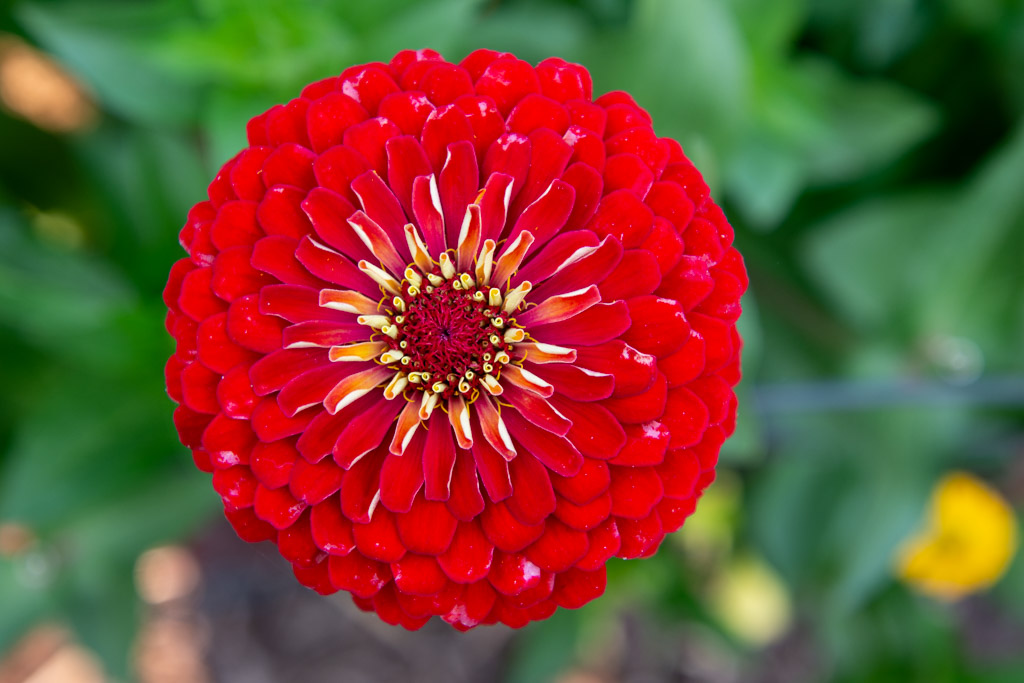 Look at all that detail. Aren't they amazing?
Look at all that detail. Aren't they amazing?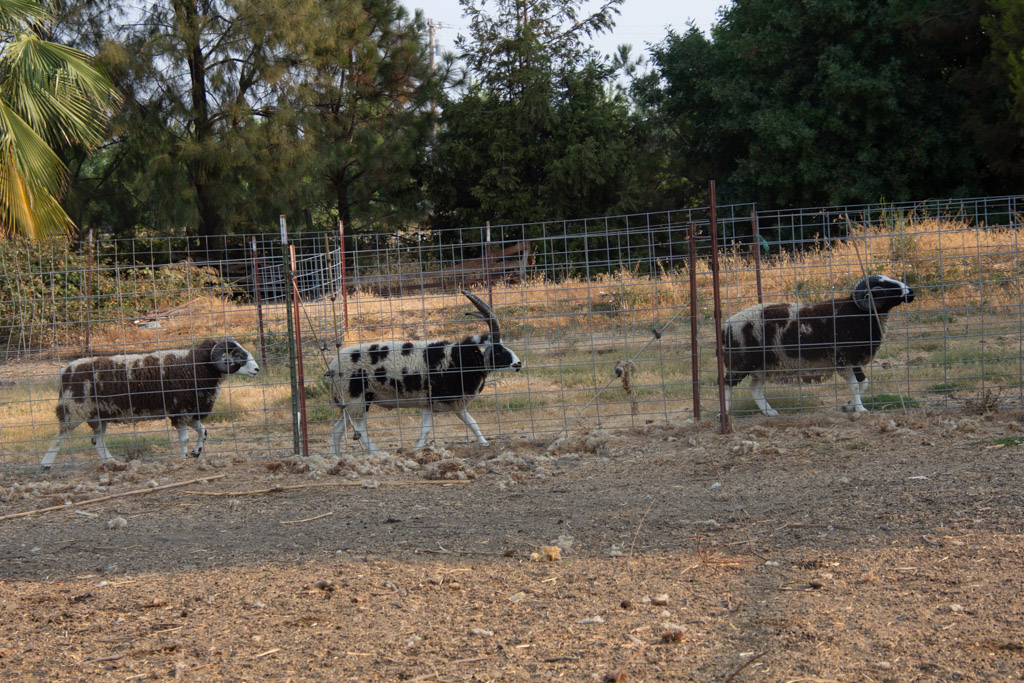 The three big rams come to see what's going on.
The three big rams come to see what's going on.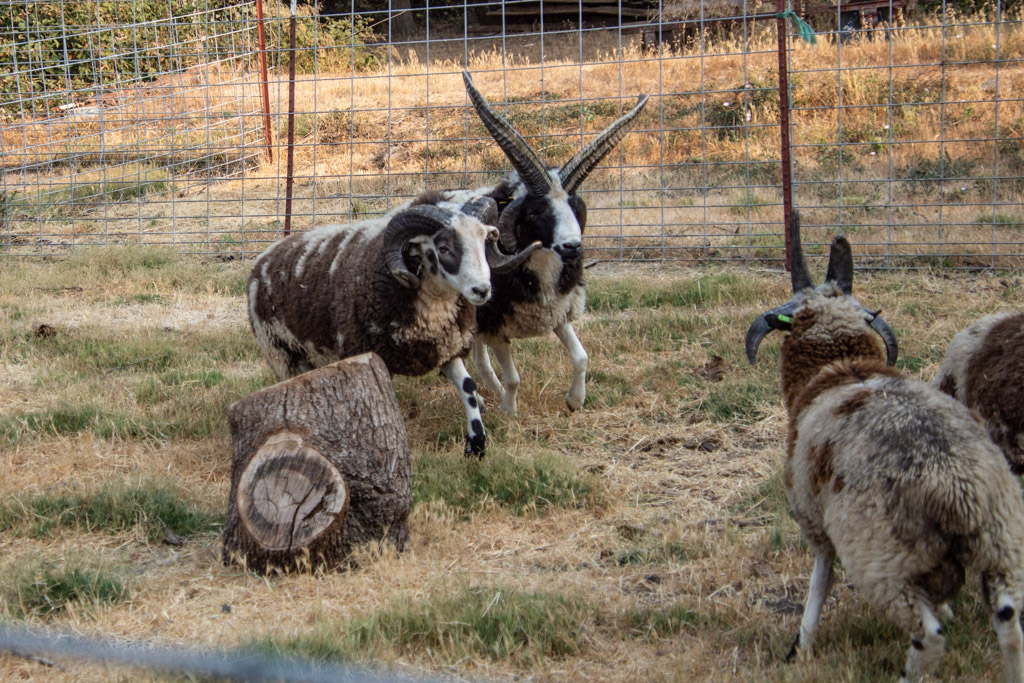 The 2-year old 4-horn is Buster and the yearling 2-horn next to him is Cayenne.
The 2-year old 4-horn is Buster and the yearling 2-horn next to him is Cayenne. 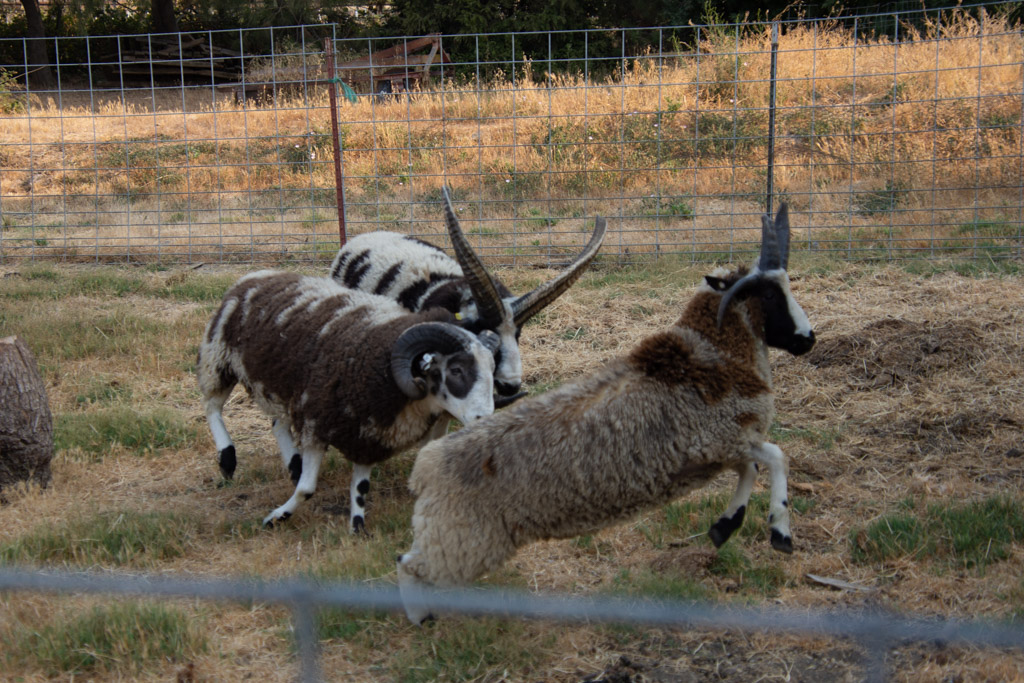 The lambs aren't named yet but this one is a full brother to the yearling ram that I took to Maryland this spring and who now lives in Pennsylvania.
The lambs aren't named yet but this one is a full brother to the yearling ram that I took to Maryland this spring and who now lives in Pennsylvania.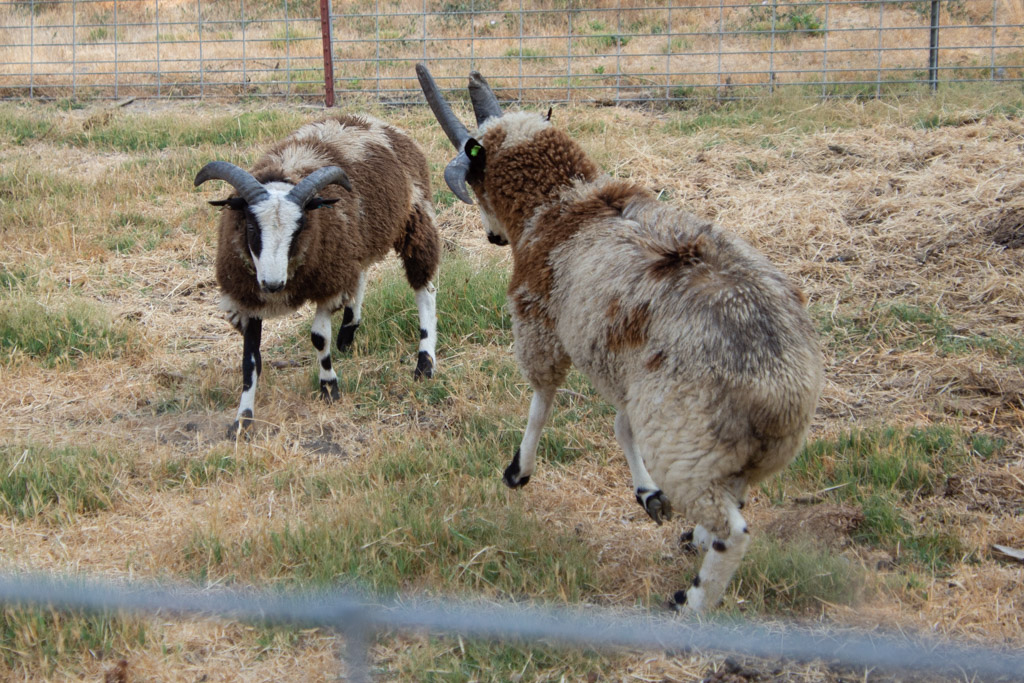 Since the young rams can't find the older rams they will fight among themselves. That two horn lamb is a full brother to Cayenne in the photos above.
Since the young rams can't find the older rams they will fight among themselves. That two horn lamb is a full brother to Cayenne in the photos above.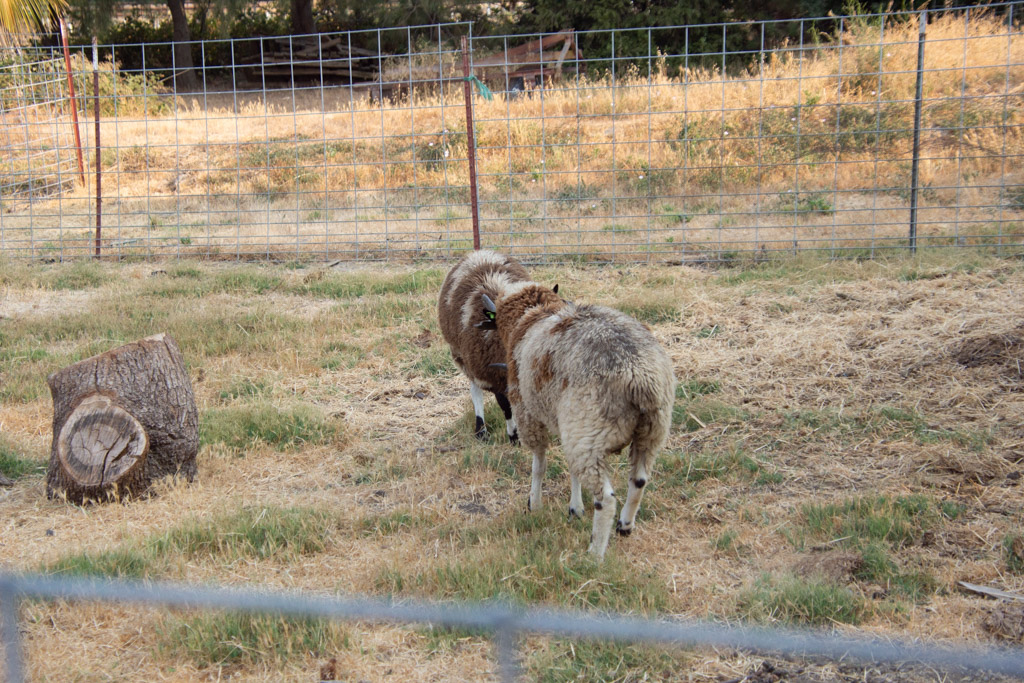
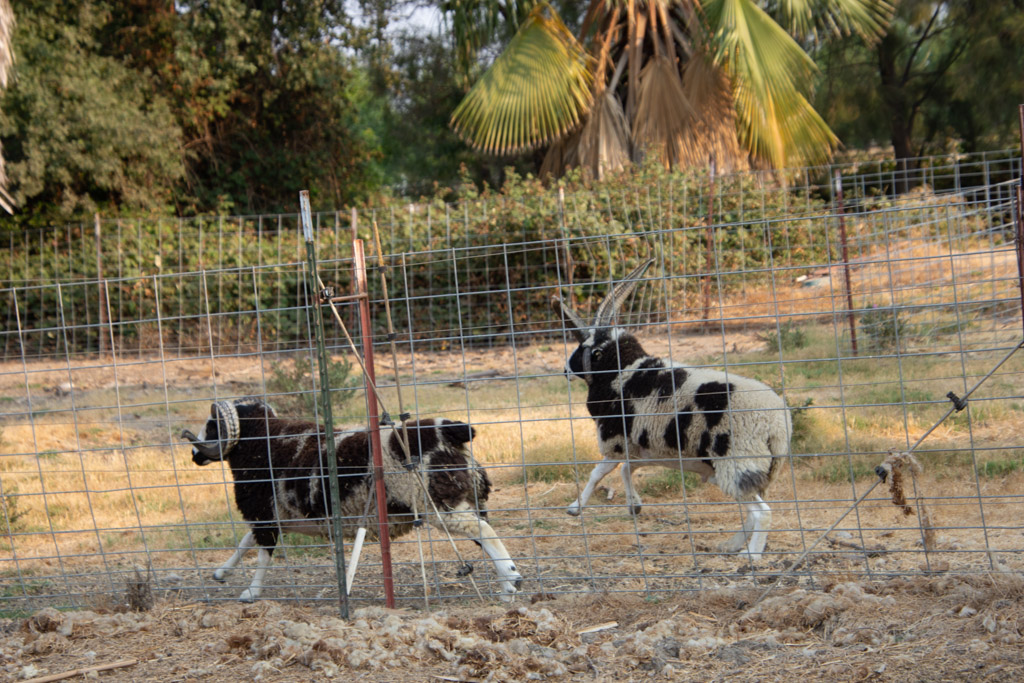 Buster again and that two horn yearling is Gotham (
Buster again and that two horn yearling is Gotham (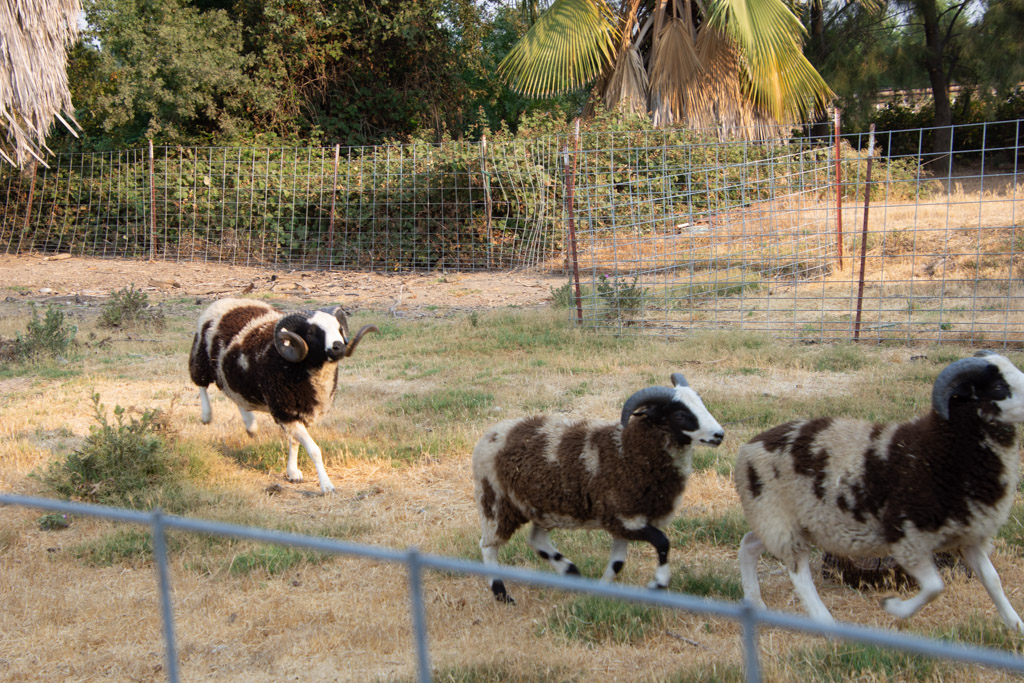 Gotham chasing the lambs.
Gotham chasing the lambs.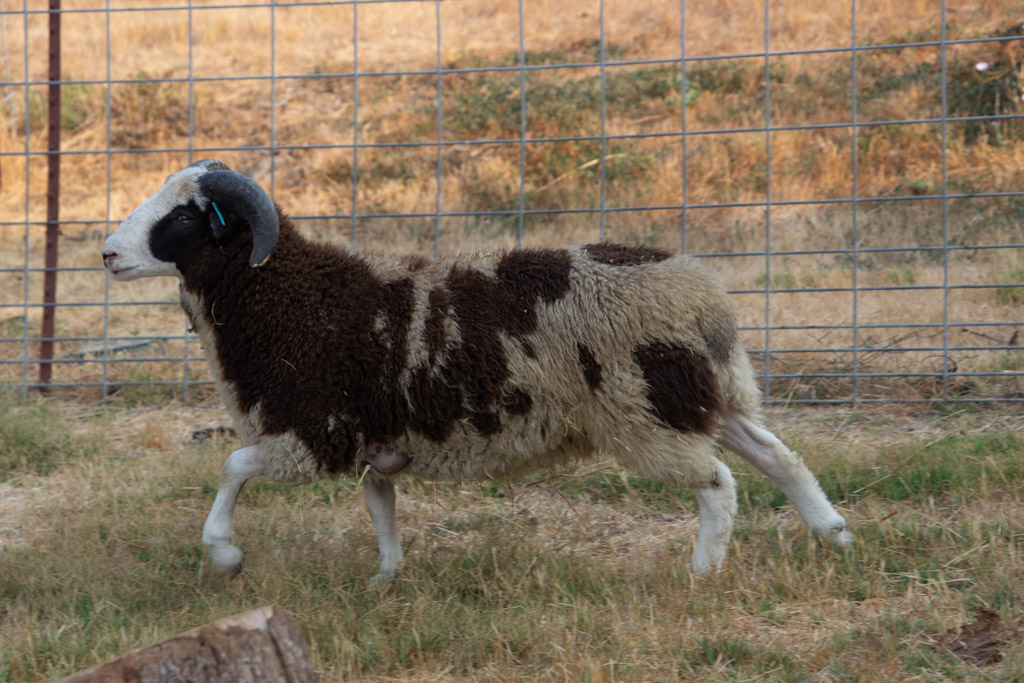 This is the other two-horn lamb that I'm keeping for now.
This is the other two-horn lamb that I'm keeping for now.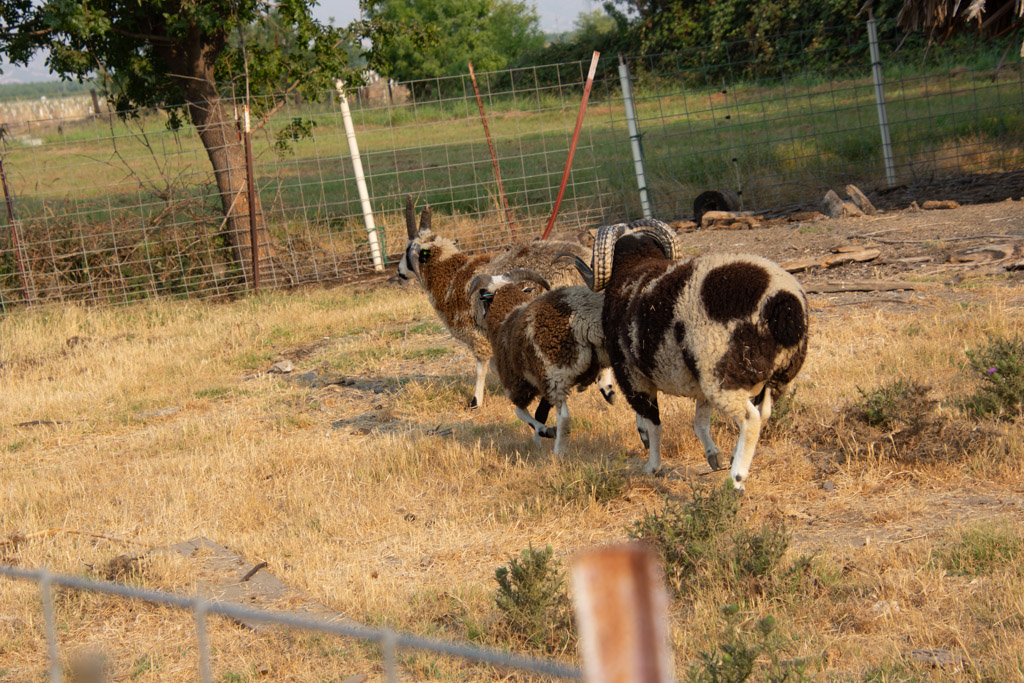 Gotham in pursuit.
Gotham in pursuit.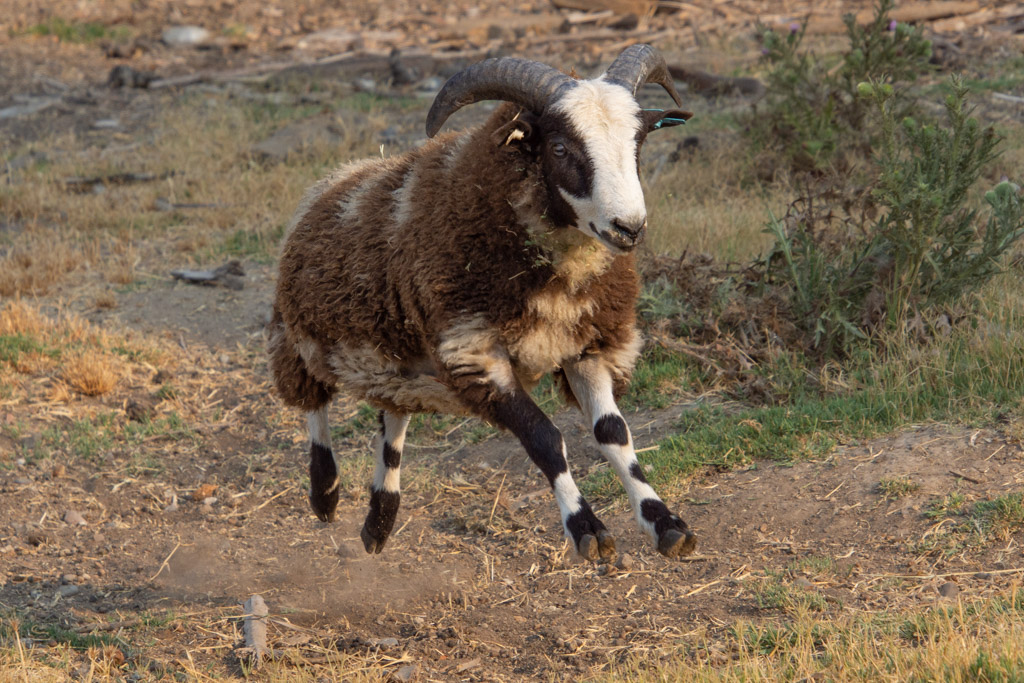 This young guy has got moves!
This young guy has got moves! We've been using the old tin backdrop for a long time and I still really like the look. It worked especially well with the natural dye display we made this year. There are also signs about Farm Club, examples of yarn and wool on the table, and a continuous loop of about 45 minutes of my farm videos. The Touching Table is popular with fair-goers.
We've been using the old tin backdrop for a long time and I still really like the look. It worked especially well with the natural dye display we made this year. There are also signs about Farm Club, examples of yarn and wool on the table, and a continuous loop of about 45 minutes of my farm videos. The Touching Table is popular with fair-goers. There are more signs over the sheep pens. My potted plants were dug out of the pasture and include a sign about what is in the bucket.
There are more signs over the sheep pens. My potted plants were dug out of the pasture and include a sign about what is in the bucket.

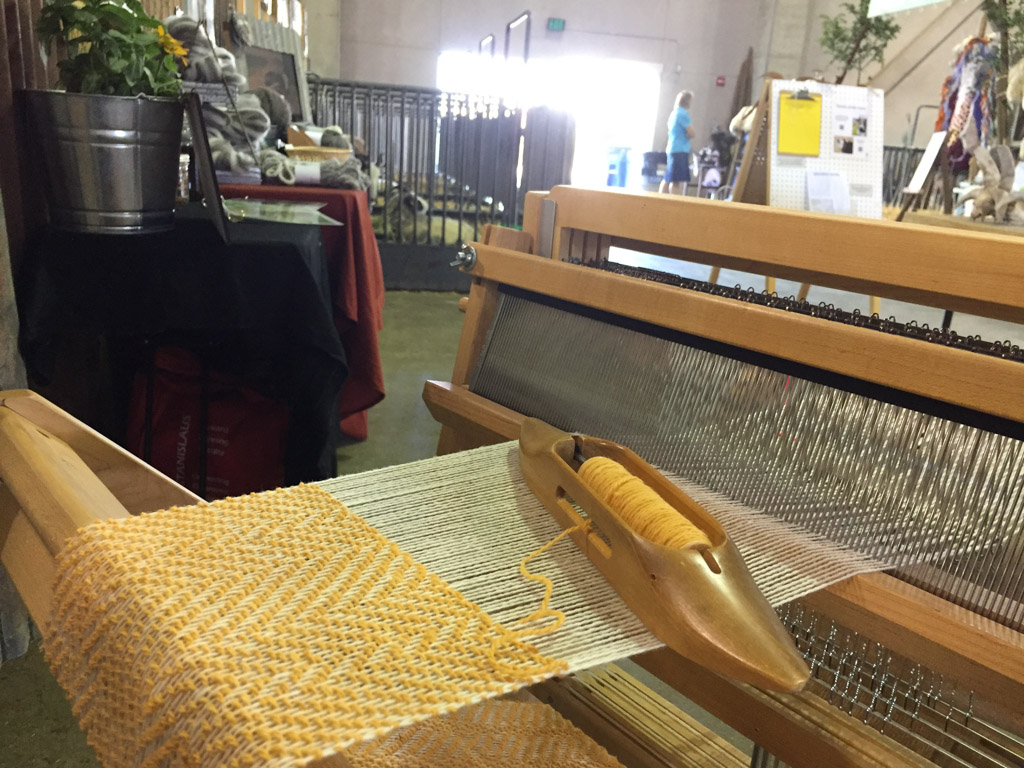
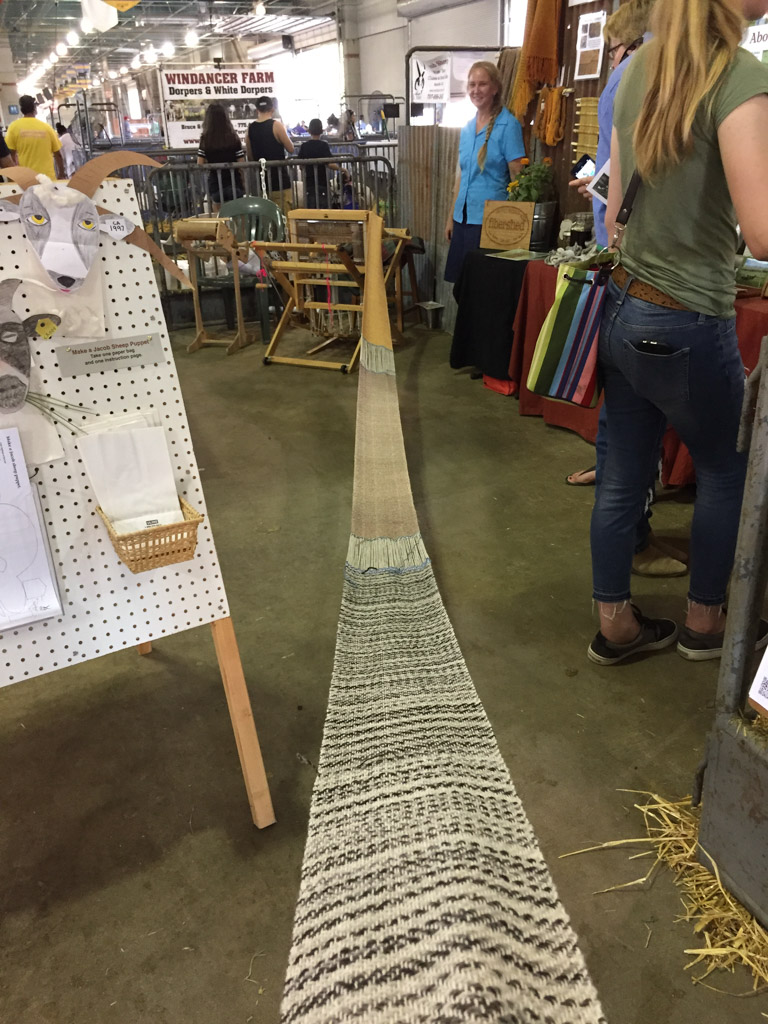
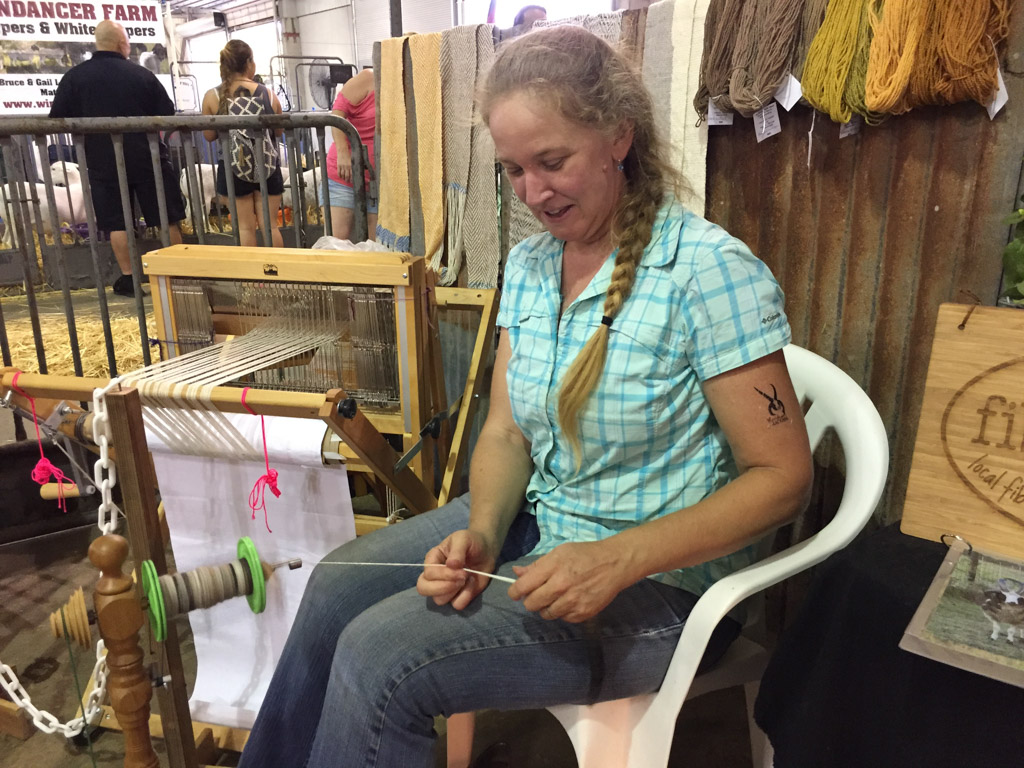
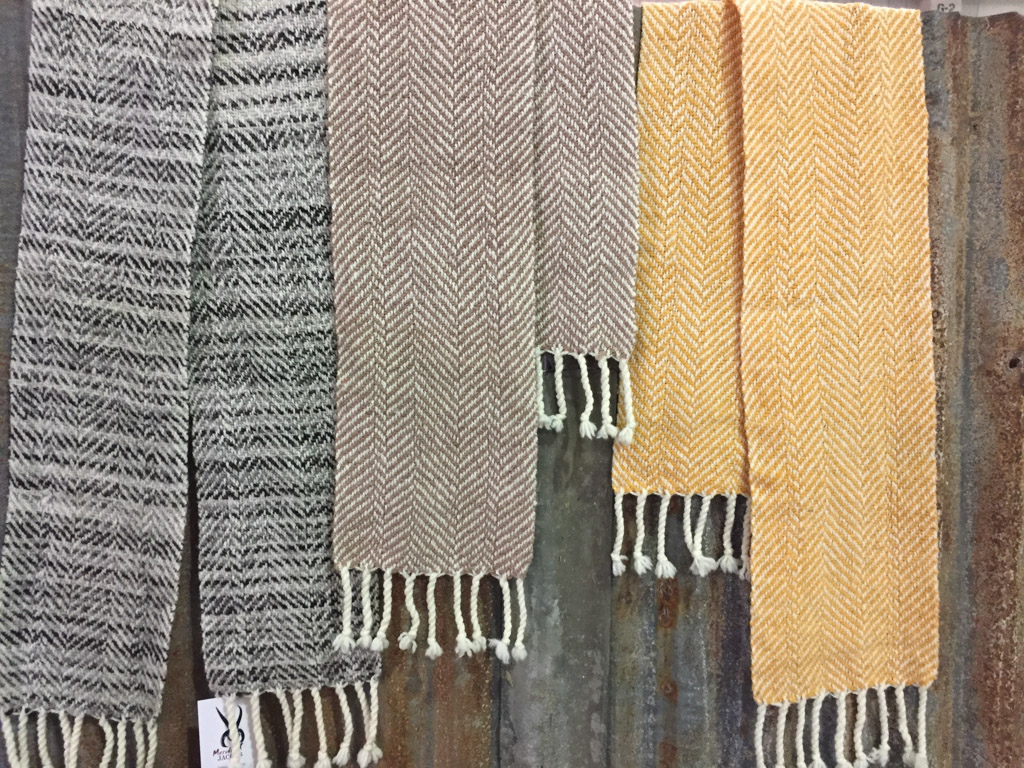
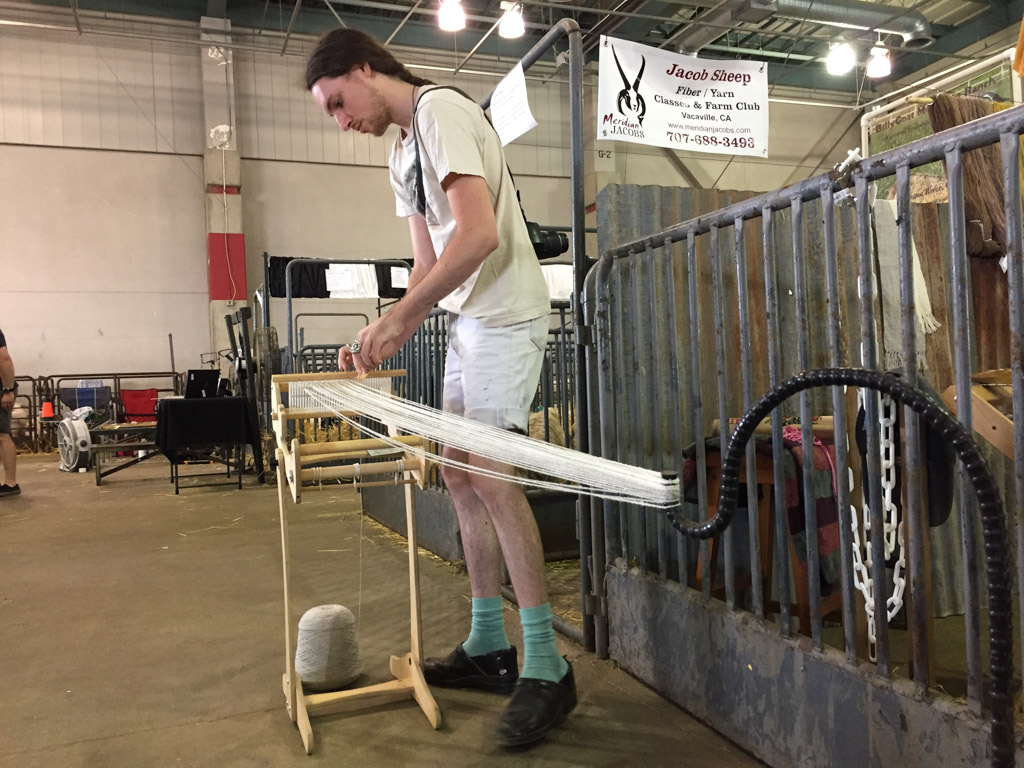
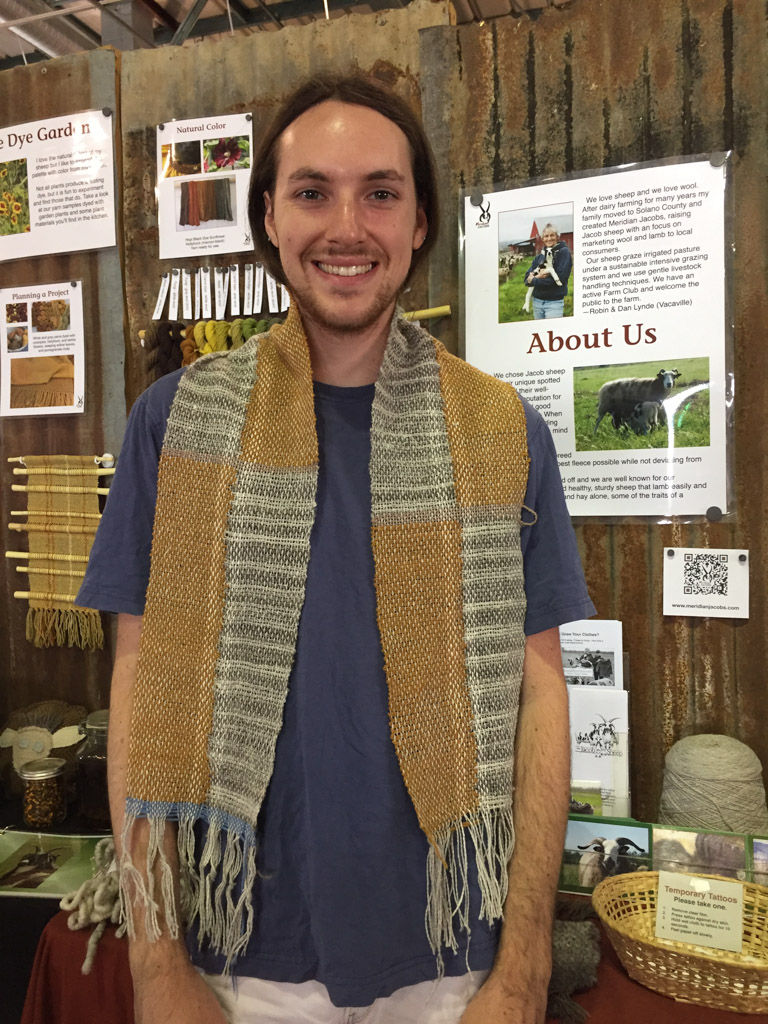
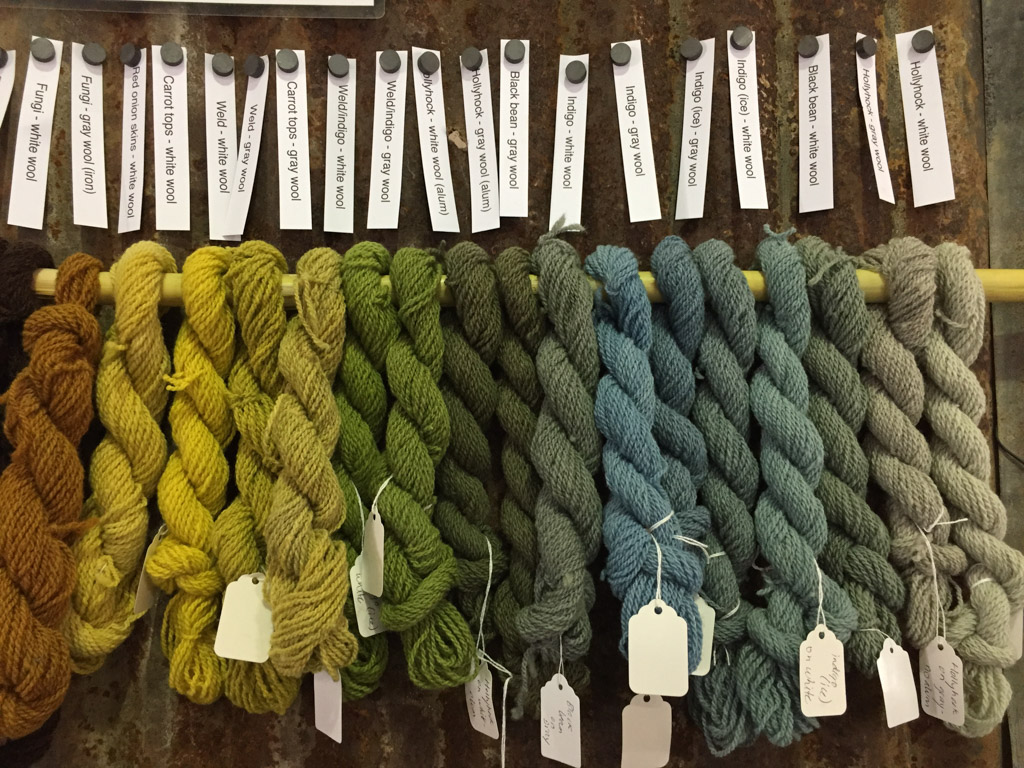 Here is closeup of some of the yarns on display. Farm Club member, Lisa, dyed most of these.
Here is closeup of some of the yarns on display. Farm Club member, Lisa, dyed most of these.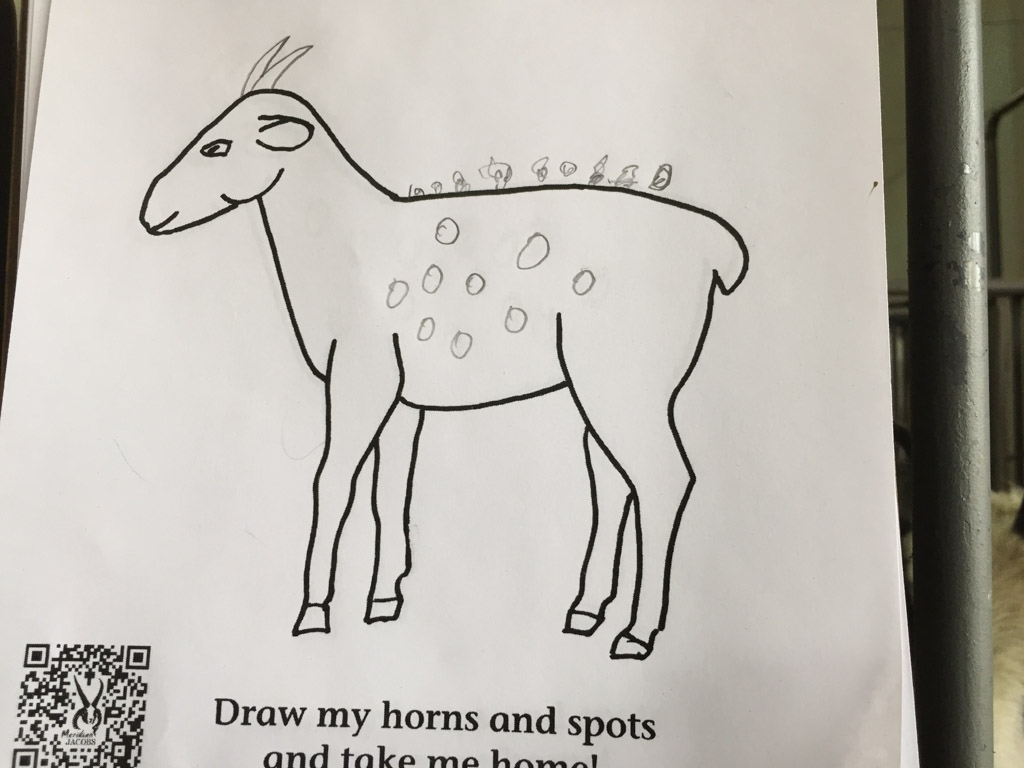 One of the kids' activities we provide is this sheet for drawing in details on the sheep. Not everyone takes them home.
One of the kids' activities we provide is this sheet for drawing in details on the sheep. Not everyone takes them home.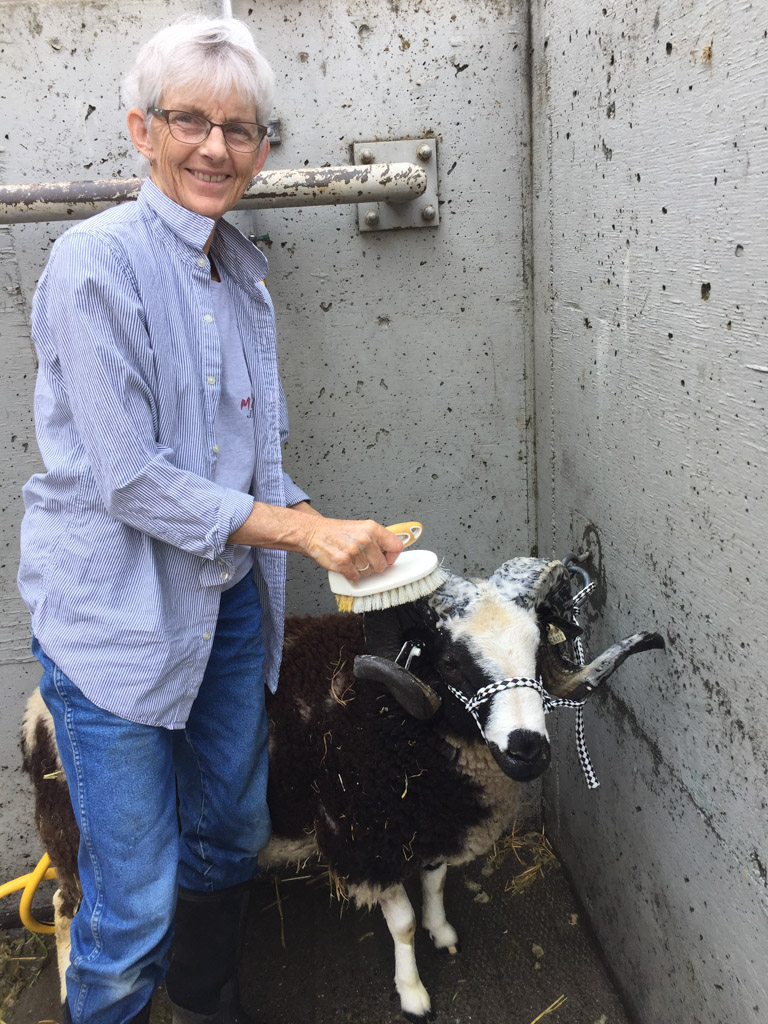 We are also here for the sheep show. Fortunately Jacob sheep don't require a lot of fitting, but it is nice to get them cleaned up a bit.
We are also here for the sheep show. Fortunately Jacob sheep don't require a lot of fitting, but it is nice to get them cleaned up a bit.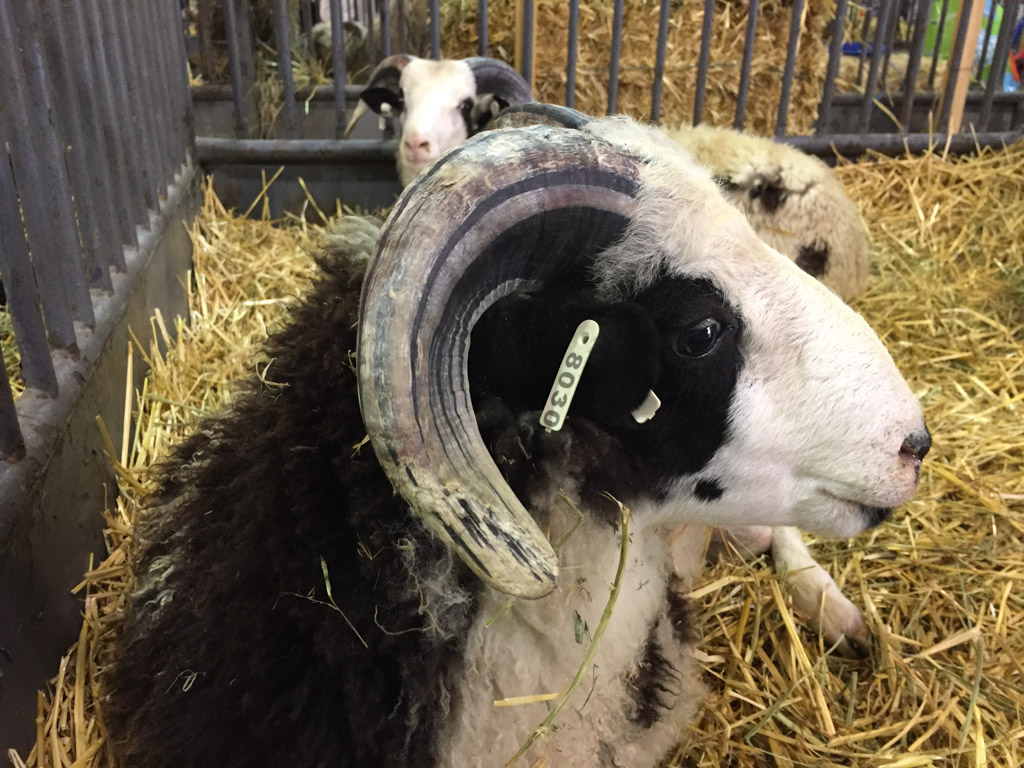 The horns looked pretty good after a scrubbing. This is a ram lamb named Axle.
The horns looked pretty good after a scrubbing. This is a ram lamb named Axle.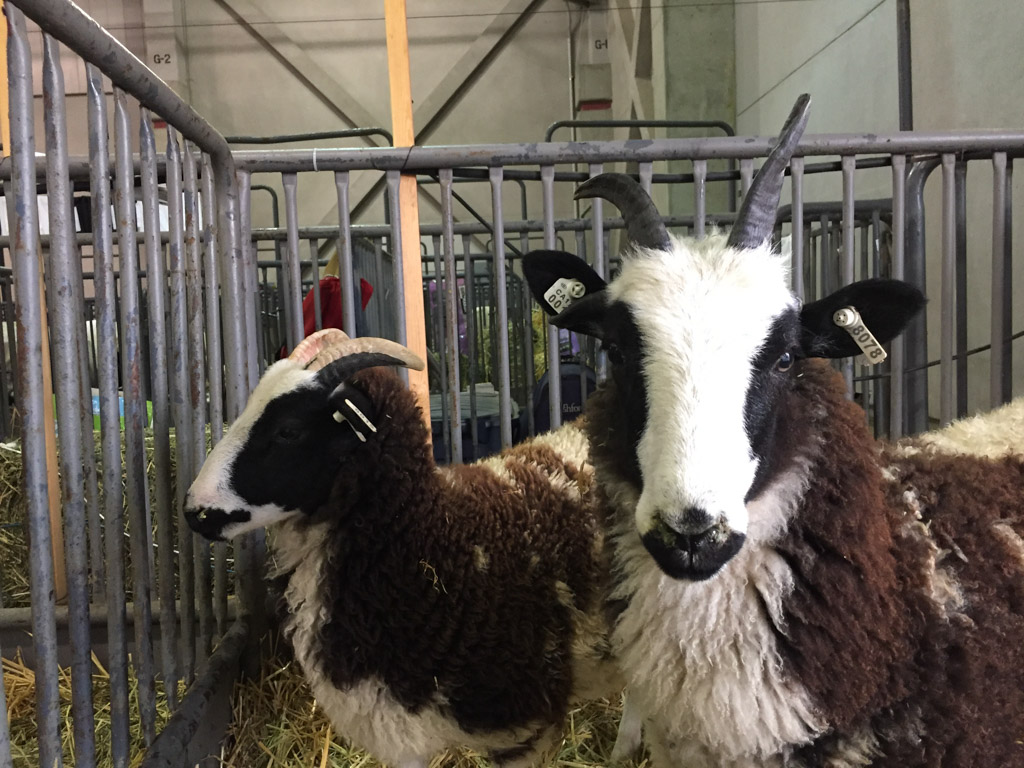 This is Jana on the right and a less-glad-to-be-there Halcyon.
This is Jana on the right and a less-glad-to-be-there Halcyon. 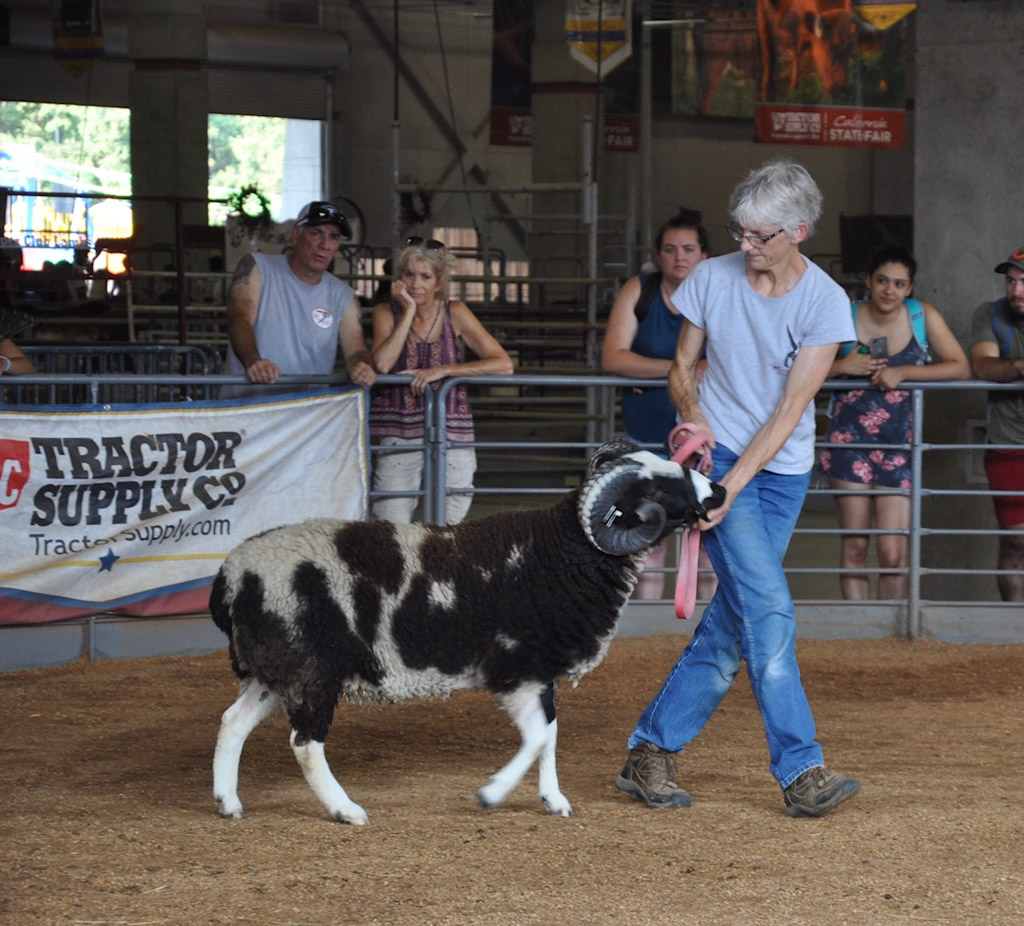 The Primitive Breeds show was Saturday afternoon. This is a yearling ram, Meridian Gotham. (Look at those shiny horns.)
The Primitive Breeds show was Saturday afternoon. This is a yearling ram, Meridian Gotham. (Look at those shiny horns.)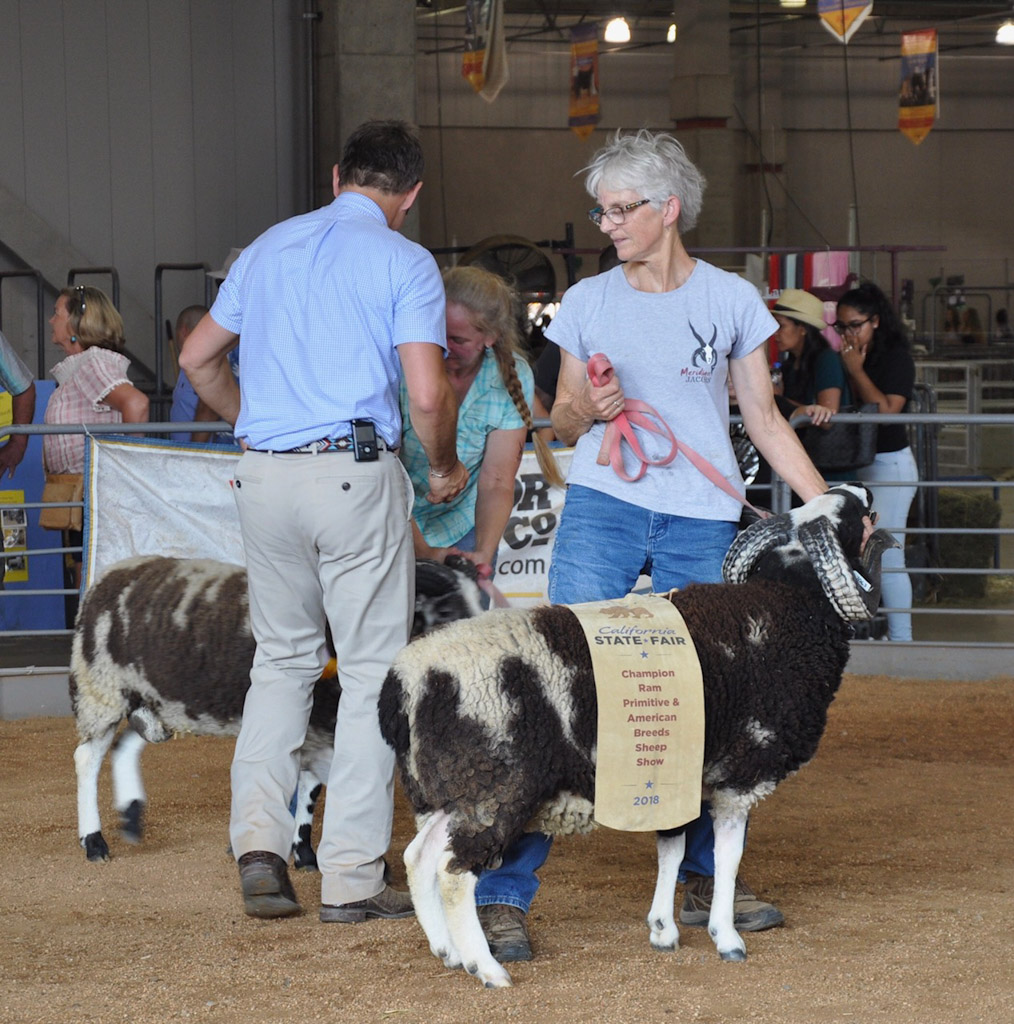 Unfortunately there was very little competition this year and I had the only rams. So it's nice to get a Champion award, but it would have been nice to have other breeders' sheep there.
Unfortunately there was very little competition this year and I had the only rams. So it's nice to get a Champion award, but it would have been nice to have other breeders' sheep there. 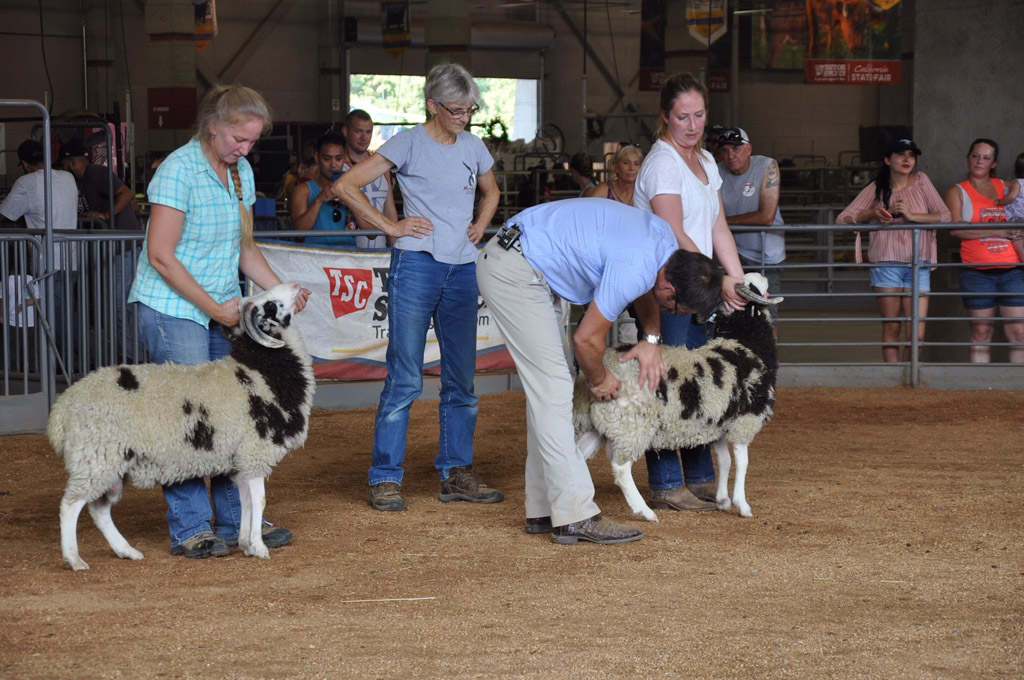 Marina and Betsy helped show. This is the ram lamb class.
Marina and Betsy helped show. This is the ram lamb class.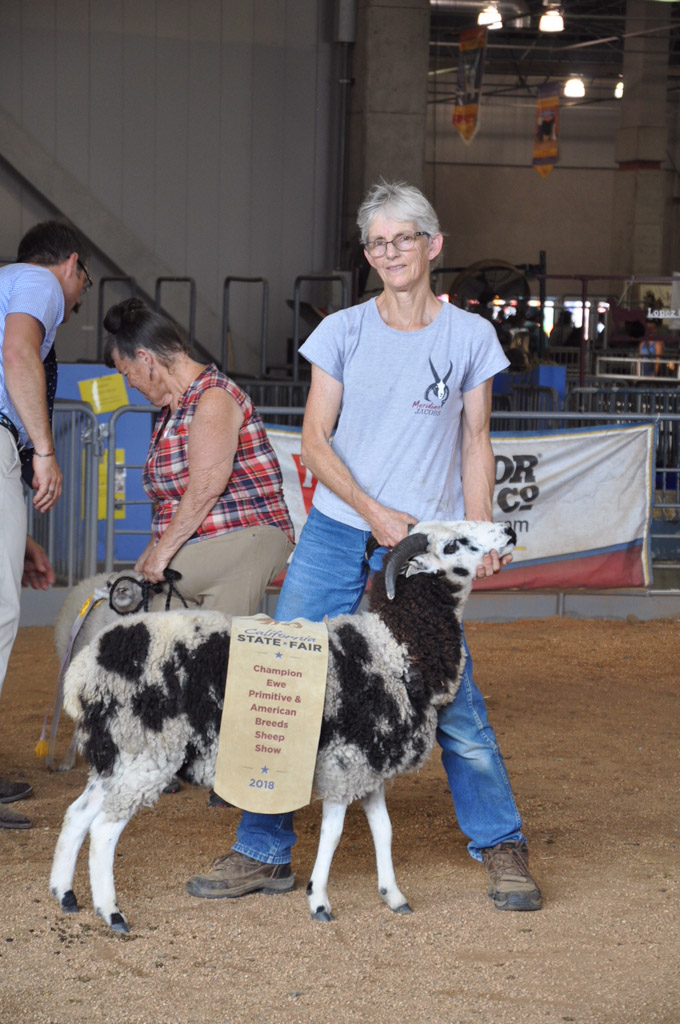 Meridian Maybelline was awarded Champion Ewe.
Meridian Maybelline was awarded Champion Ewe.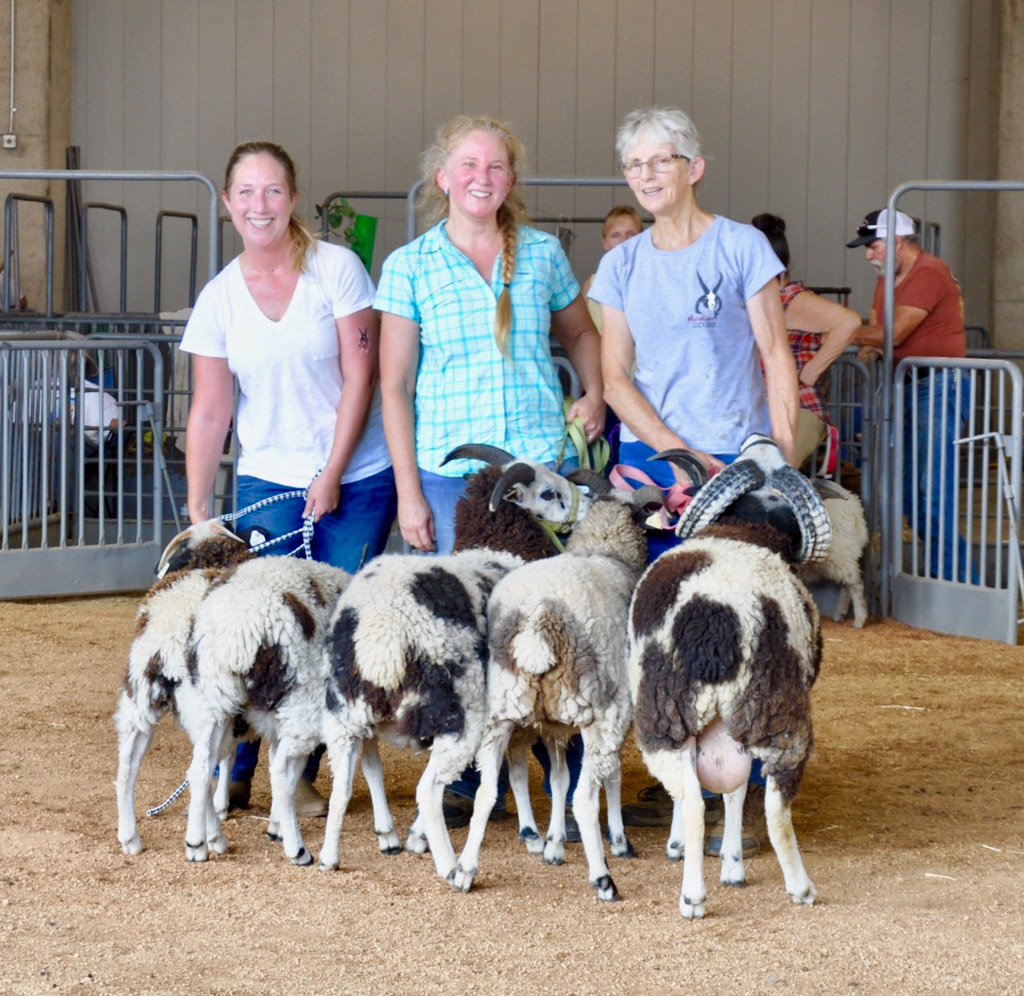 Thanks so much to Betsy and Marina for pitching in and showing sheep. And thanks to Dona for the photos.
Thanks so much to Betsy and Marina for pitching in and showing sheep. And thanks to Dona for the photos.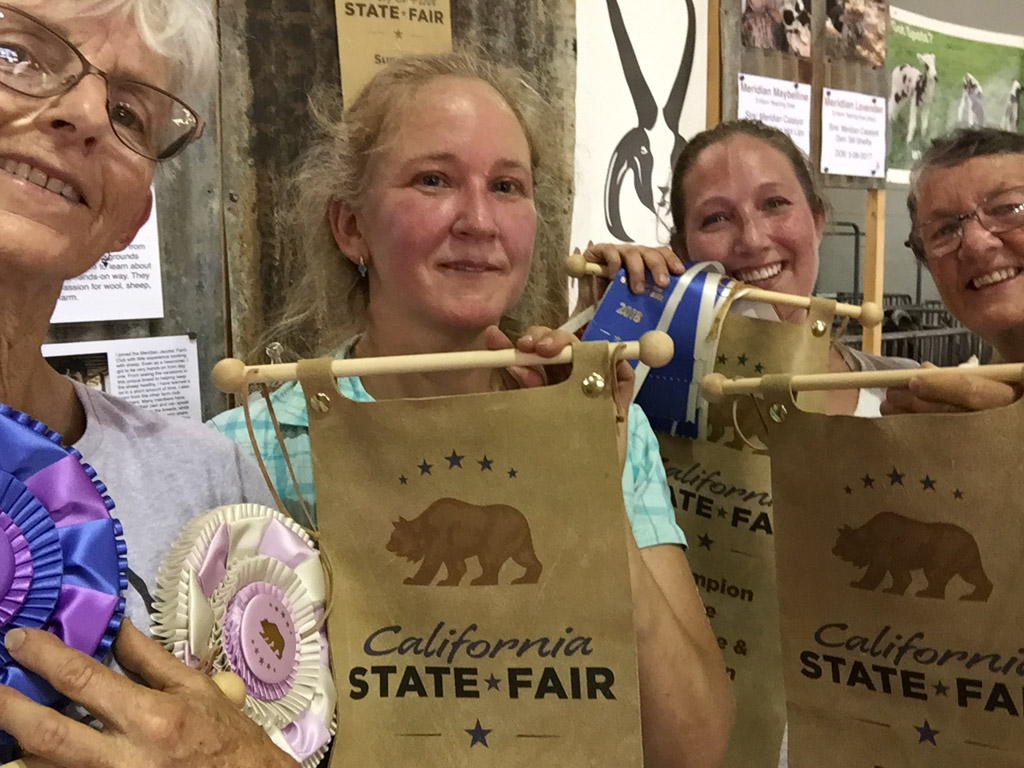 Here we are with a pile of awards, including Premier Breeder and Premier Sire.
Here we are with a pile of awards, including Premier Breeder and Premier Sire.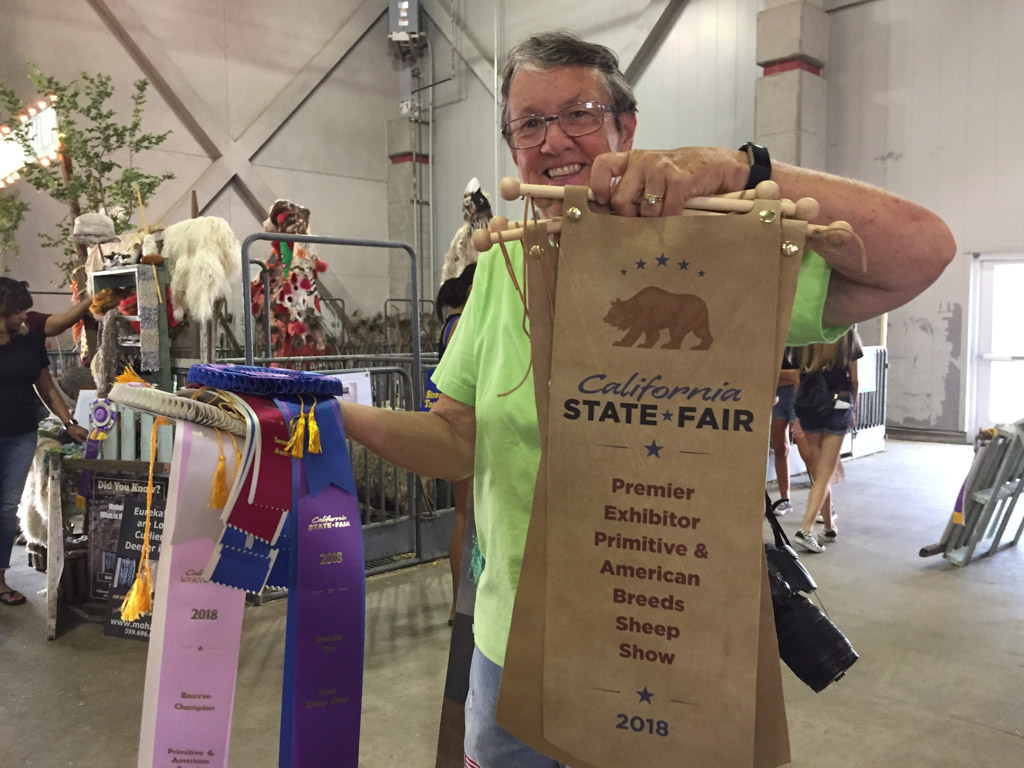
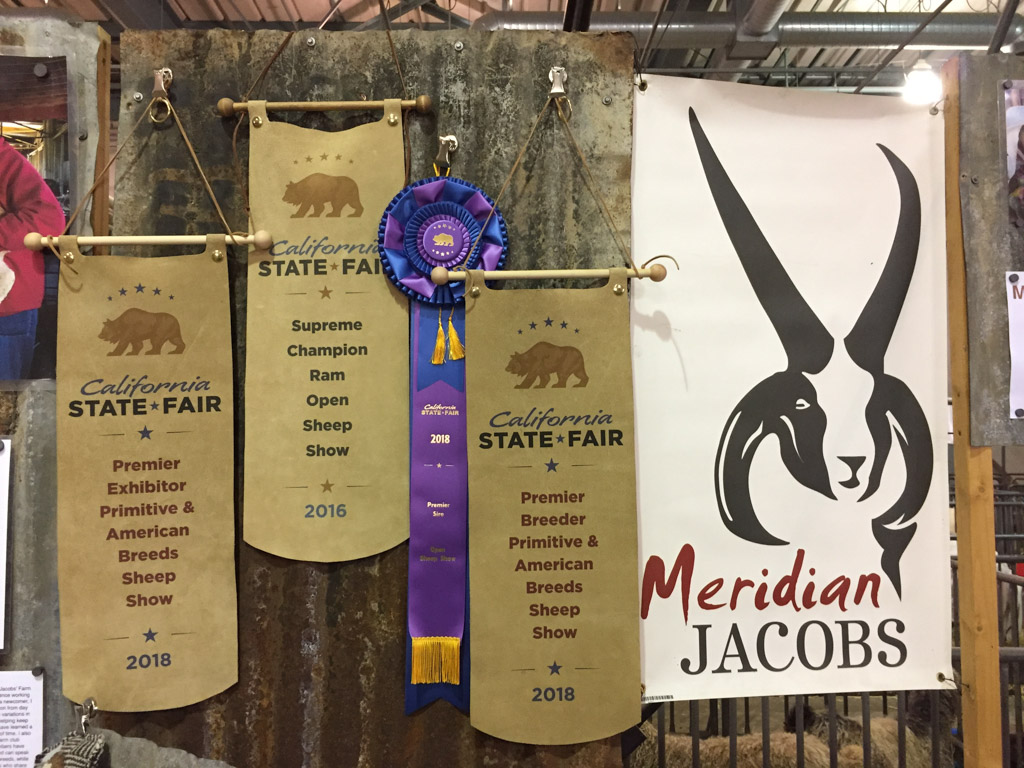
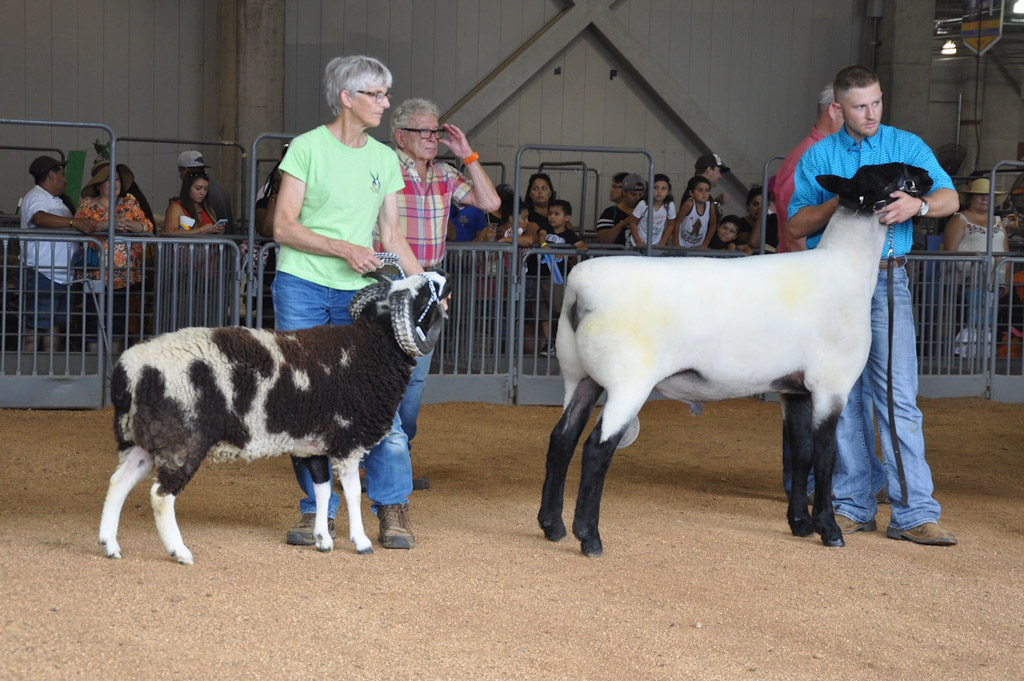 Winning Champion, even with little competition, means that you take your sheep into the ring on Sunday for the Supreme Champion competition. No, Gotham didn't shrunk overnight. He was the same size as always. It's just that those Suffolks are like ponies.
Winning Champion, even with little competition, means that you take your sheep into the ring on Sunday for the Supreme Champion competition. No, Gotham didn't shrunk overnight. He was the same size as always. It's just that those Suffolks are like ponies.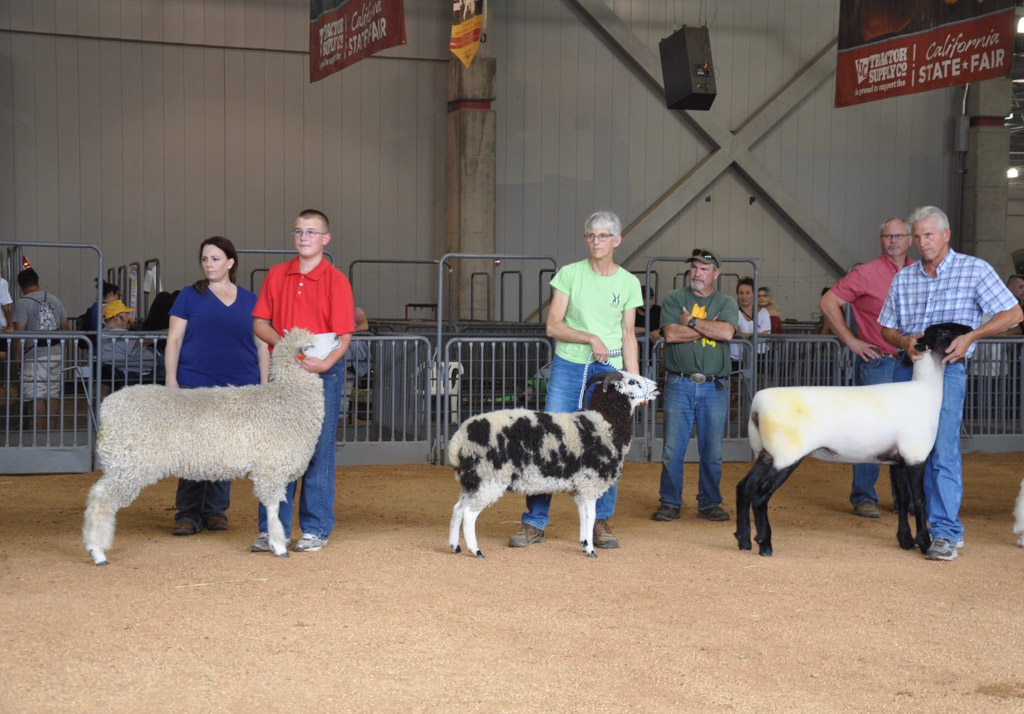 This is the Supreme Champion Ewe competition.
This is the Supreme Champion Ewe competition. 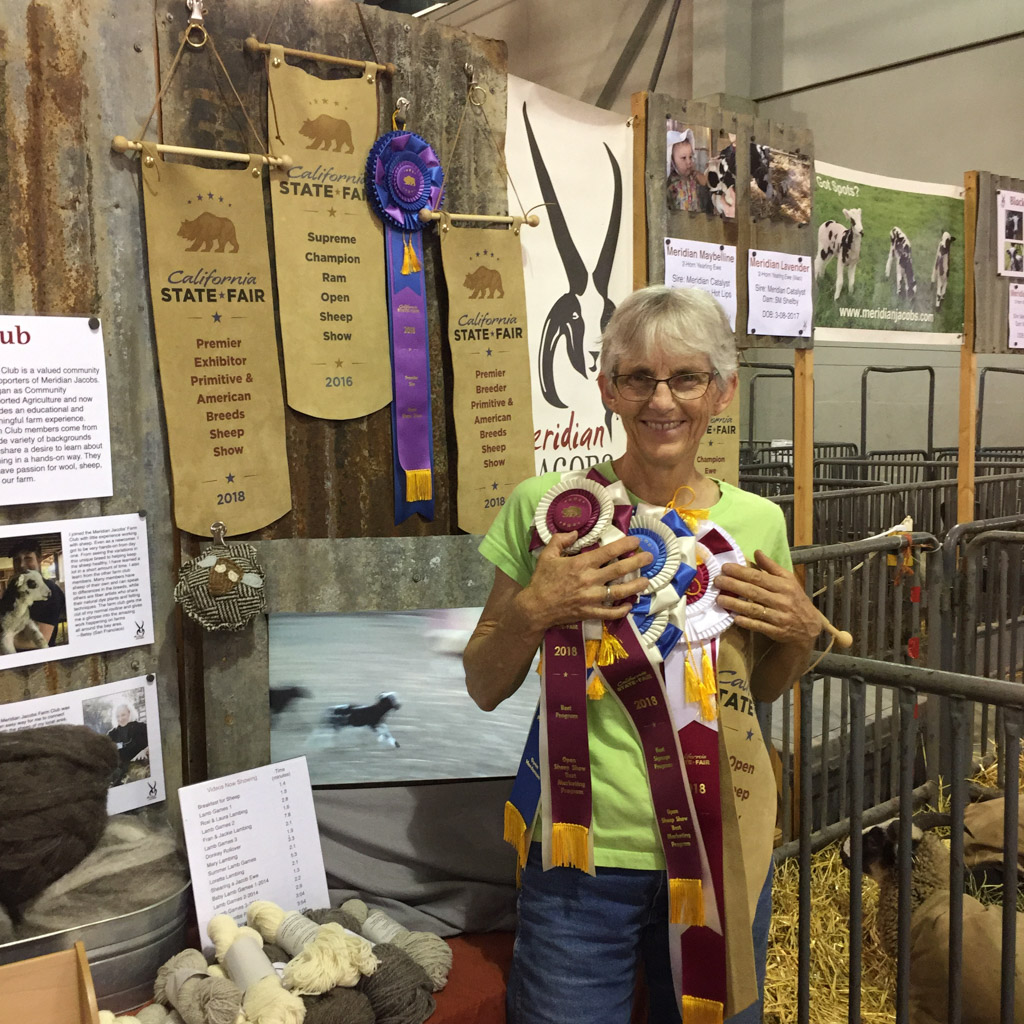 In between the Supreme Champion Ram and Supreme Champion Ewe competitions they announce the Marketing Award winners. We did pretty well!
In between the Supreme Champion Ram and Supreme Champion Ewe competitions they announce the Marketing Award winners. We did pretty well!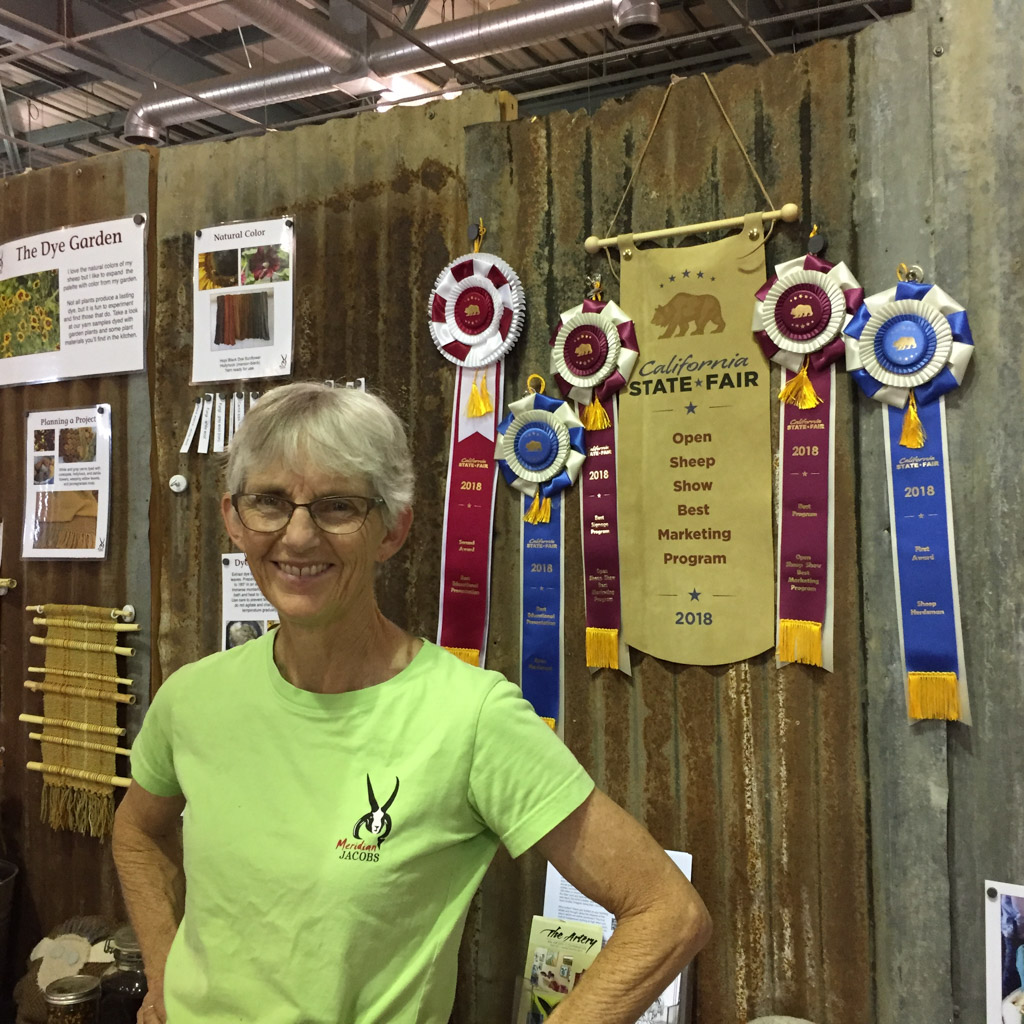 Best Marketing Program. Best Program Directed at the Public. Best Signage. 1st place Herdsman. 1st Place Educational Program. 2nd Place Educational Program over all the livestock species during the three weeks of the fair. Can't ask for more than that!
Best Marketing Program. Best Program Directed at the Public. Best Signage. 1st place Herdsman. 1st Place Educational Program. 2nd Place Educational Program over all the livestock species during the three weeks of the fair. Can't ask for more than that!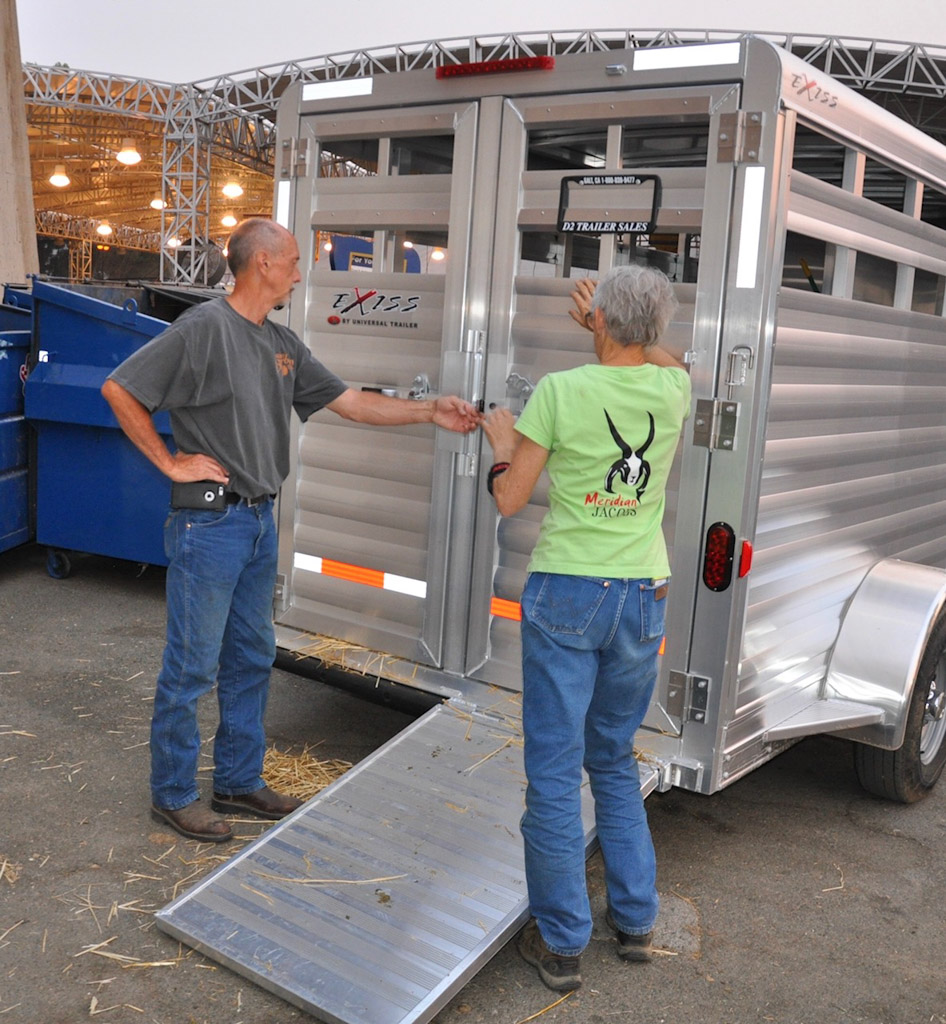 Loading up in my new trailer! Oregon here we come in 2019!
Loading up in my new trailer! Oregon here we come in 2019! People arrived for breakfast before the day's program started.
People arrived for breakfast before the day's program started. First up was "Pass or Fail" a talk presented by Royal and me, the two JSBA inspectors who were present. We started by looking at slides...
First up was "Pass or Fail" a talk presented by Royal and me, the two JSBA inspectors who were present. We started by looking at slides... ...and then went outside to look at sheep. I hadn't sold any of my cull rams yet so that we'd have plenty of examples of potential horn problems.
...and then went outside to look at sheep. I hadn't sold any of my cull rams yet so that we'd have plenty of examples of potential horn problems.  We also looked at some of the other sheep present.
We also looked at some of the other sheep present.
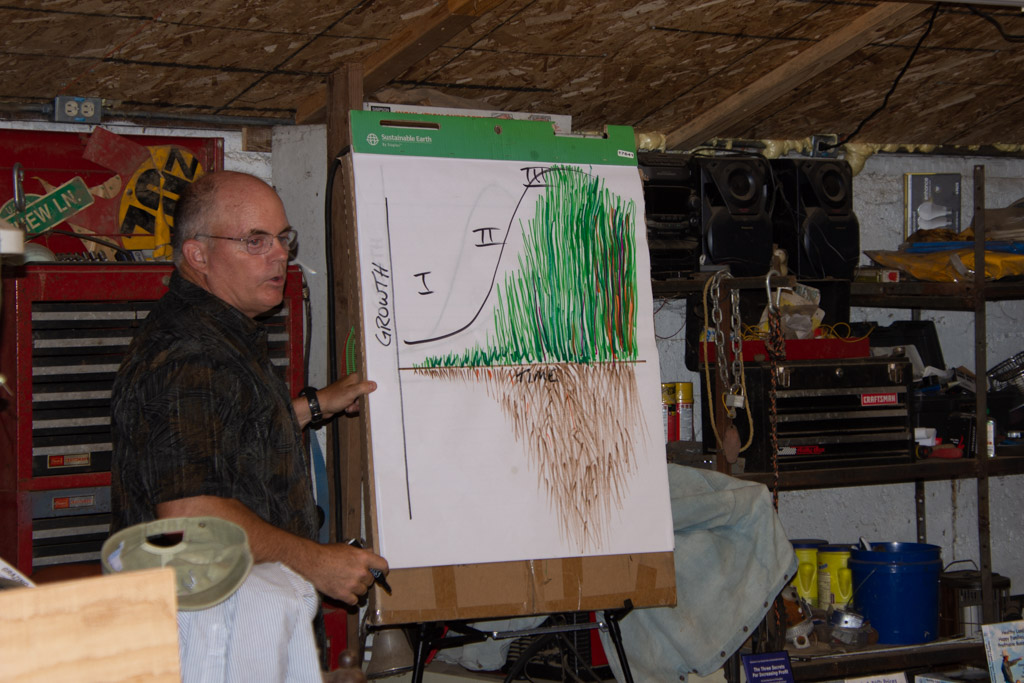
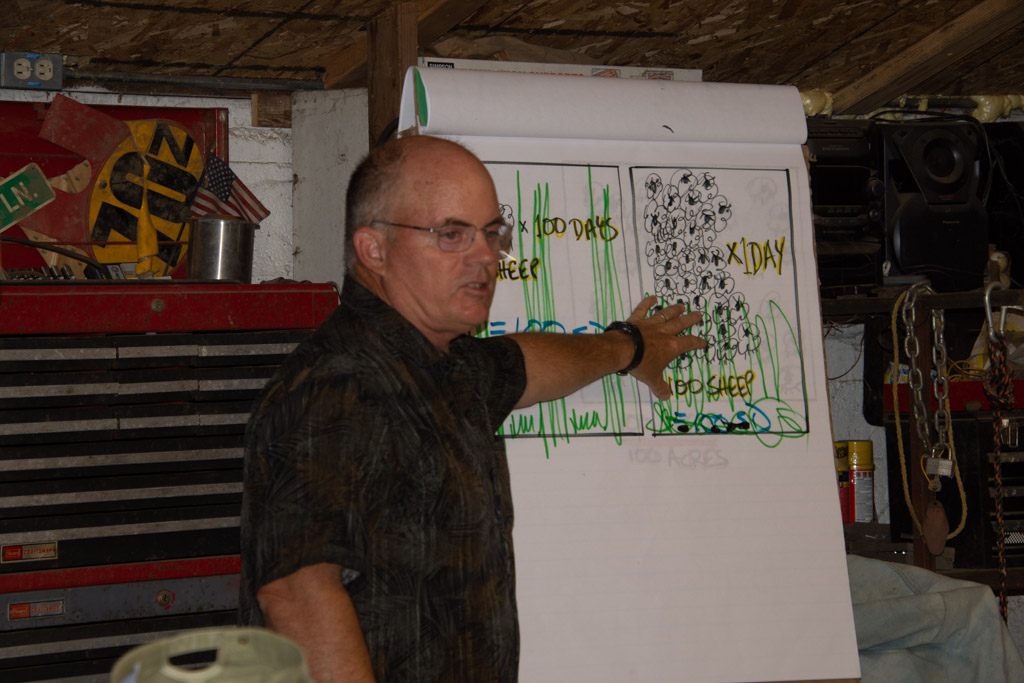
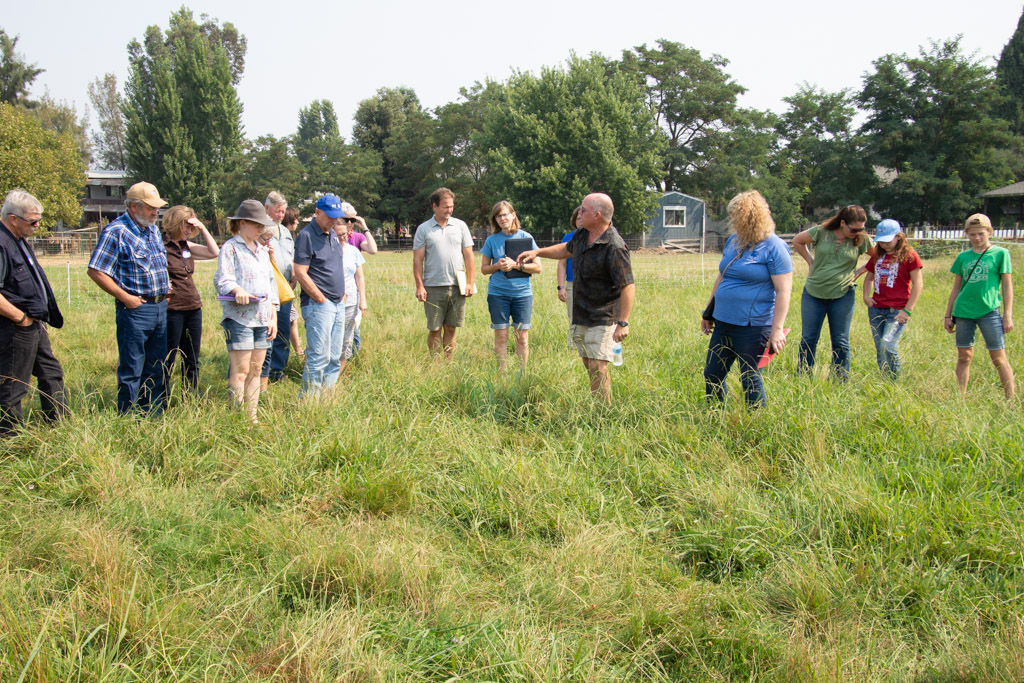
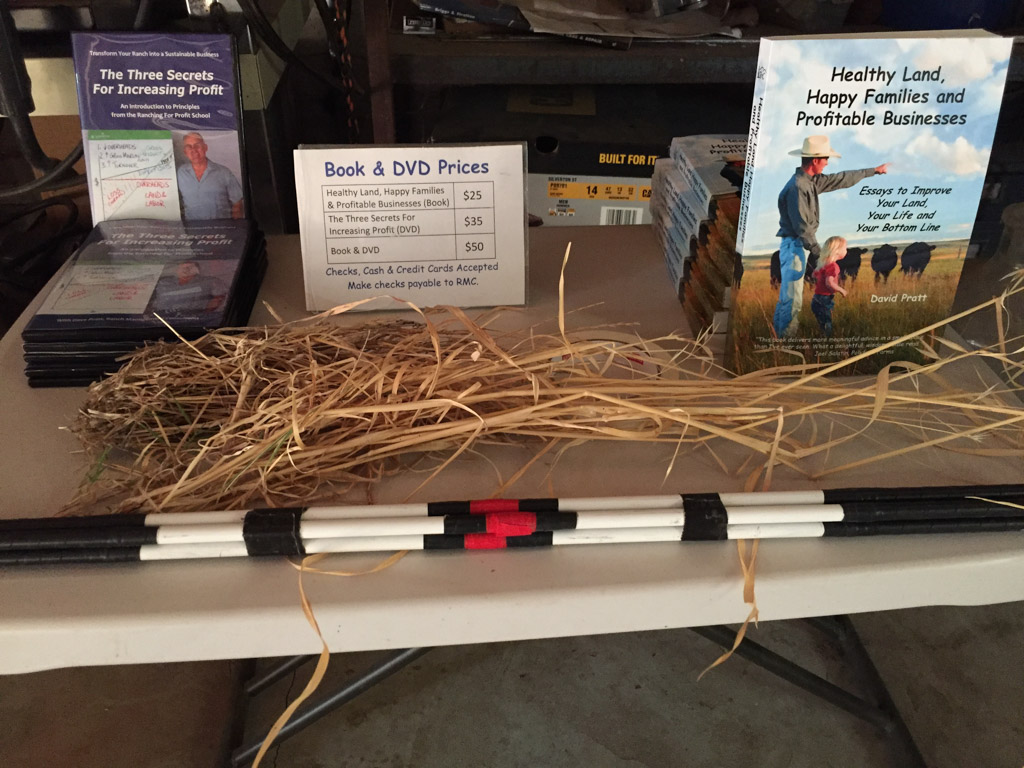
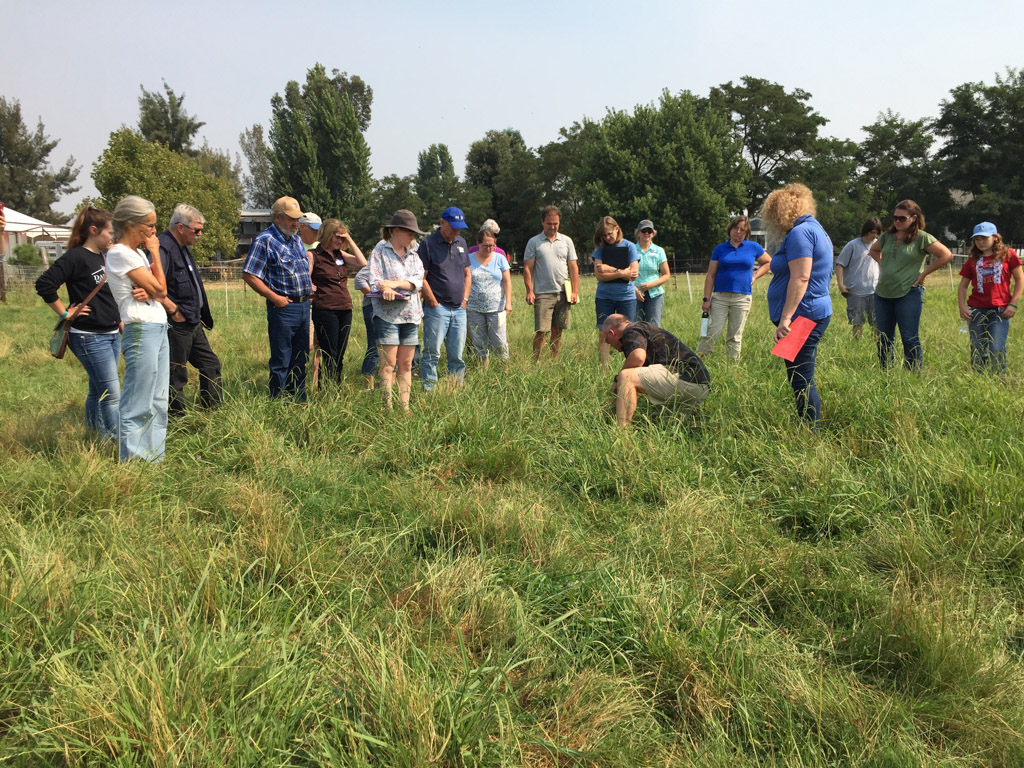
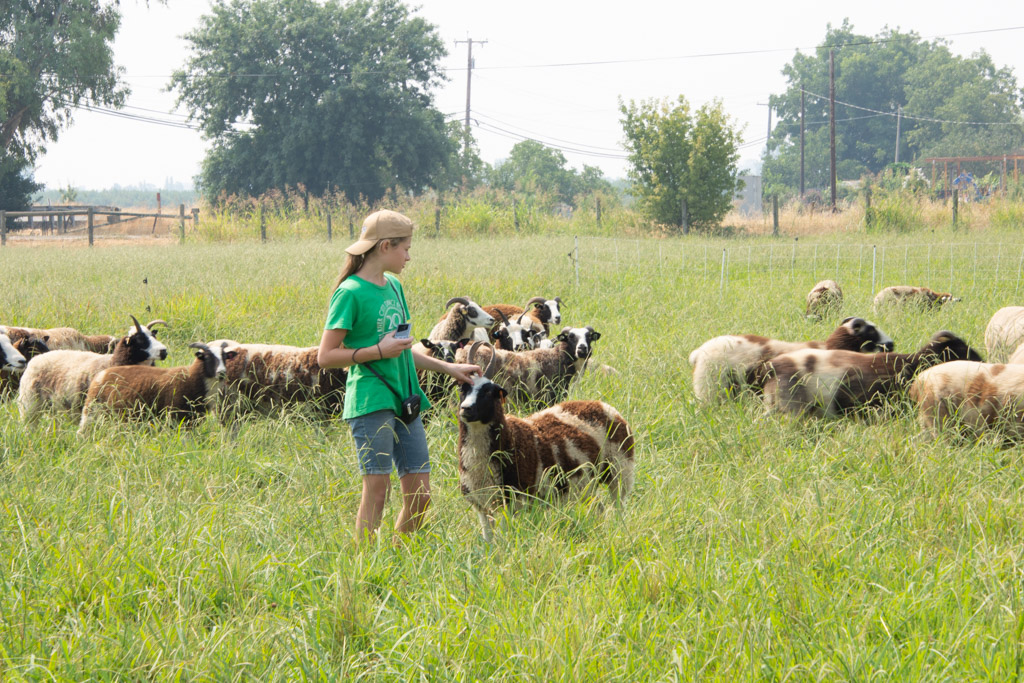 Jade is always willing to greet a visitor to the farm.
Jade is always willing to greet a visitor to the farm.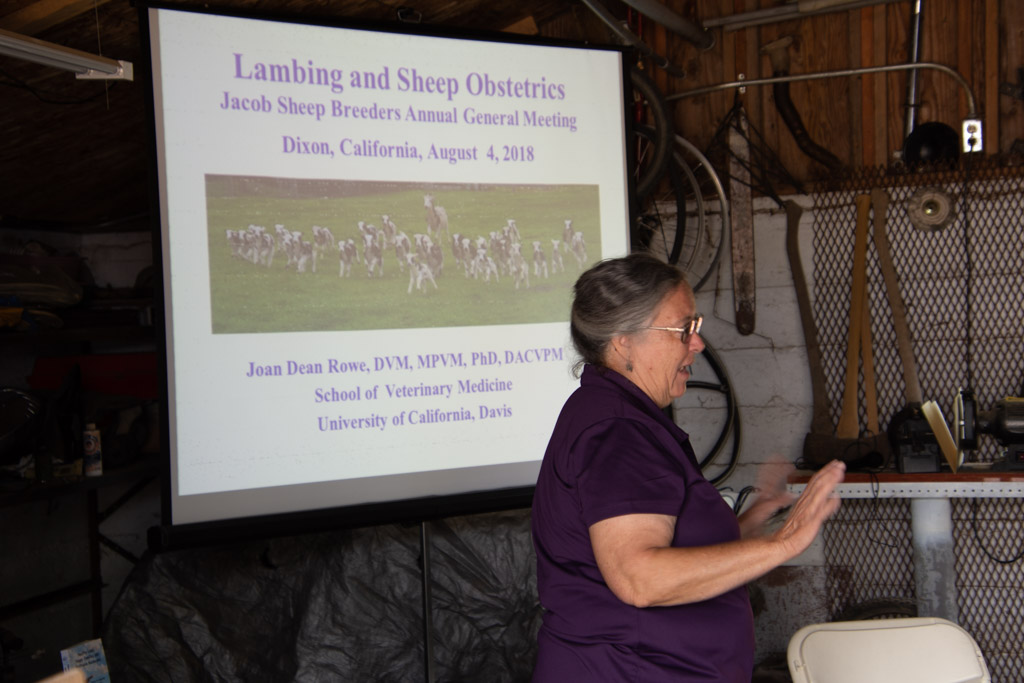 Dr. Joan Rowe from UC Davis talked about Lambing and Sheep Obstetrics. Helpful hint: Another use for a feeding tube and syringe is to get lube around a lamb when you need to reach in to rearrange or pull it.
Dr. Joan Rowe from UC Davis talked about Lambing and Sheep Obstetrics. Helpful hint: Another use for a feeding tube and syringe is to get lube around a lamb when you need to reach in to rearrange or pull it.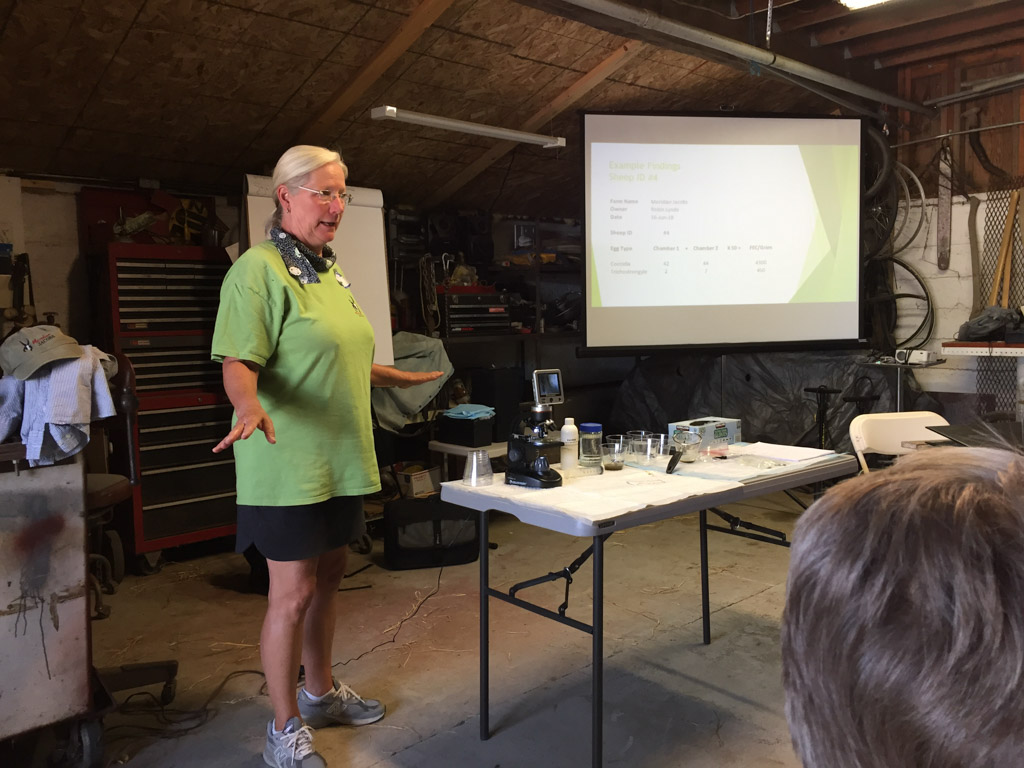 Afterwards Susan Gandy, one of the Farm Club members, demonstrated preparation and analysis of fecal samples using a method that can be used on the farm to stay on top of parasite levels in our sheep.
Afterwards Susan Gandy, one of the Farm Club members, demonstrated preparation and analysis of fecal samples using a method that can be used on the farm to stay on top of parasite levels in our sheep.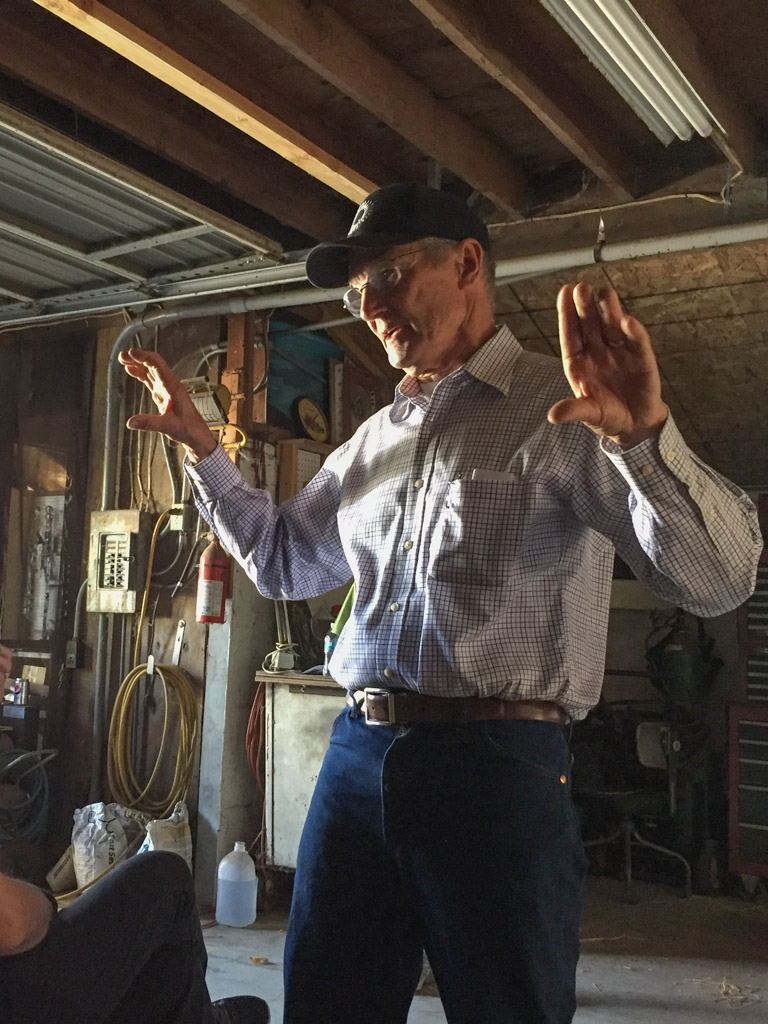
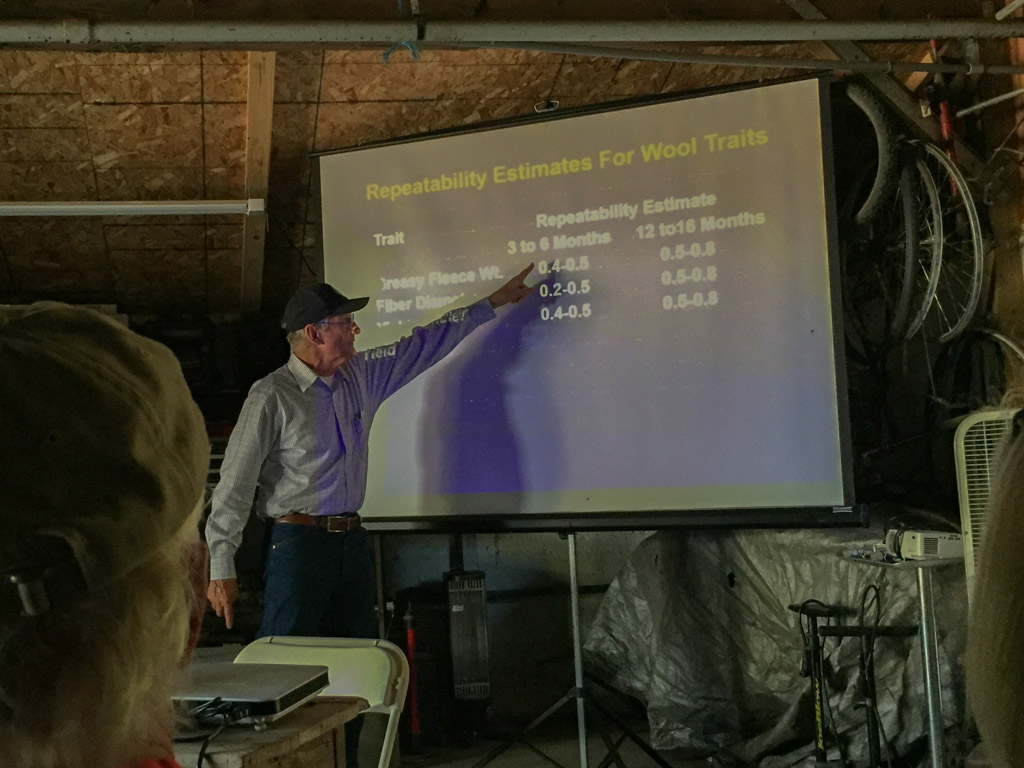
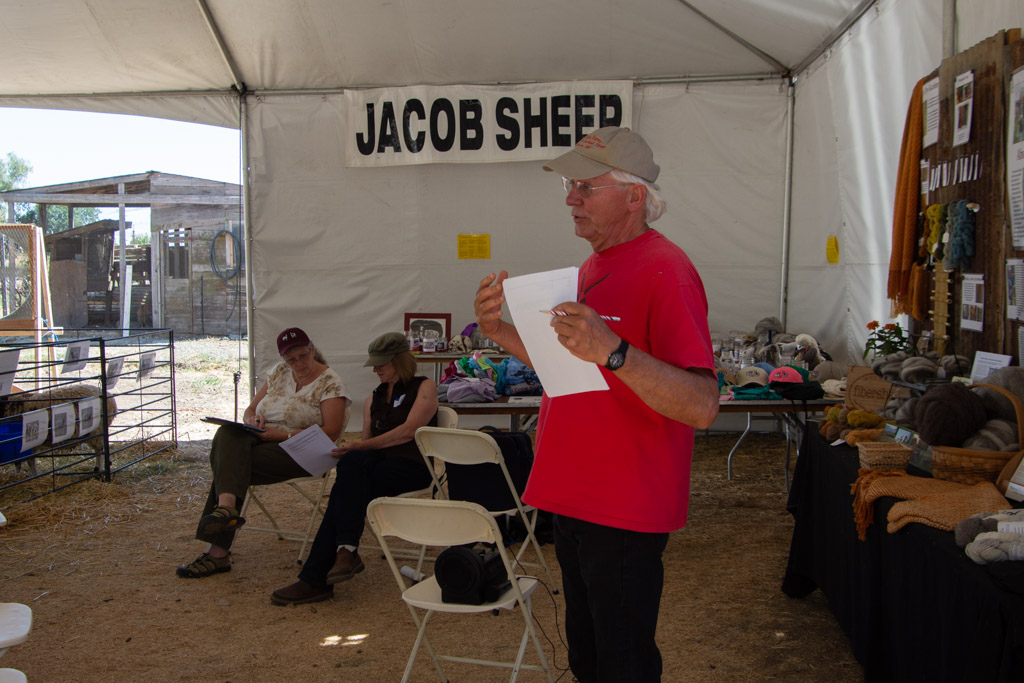 AGM stands for Annual General Meeting and that is a required element of our gathering. So it was meeting time. Gary Anderson from Michigan led the meeting and brought people up to date on JSBA goings-on, recognition of individuals, and announcements. I was given a much appreciated gift card to my favorite local store, Higby's Country Feed!
AGM stands for Annual General Meeting and that is a required element of our gathering. So it was meeting time. Gary Anderson from Michigan led the meeting and brought people up to date on JSBA goings-on, recognition of individuals, and announcements. I was given a much appreciated gift card to my favorite local store, Higby's Country Feed!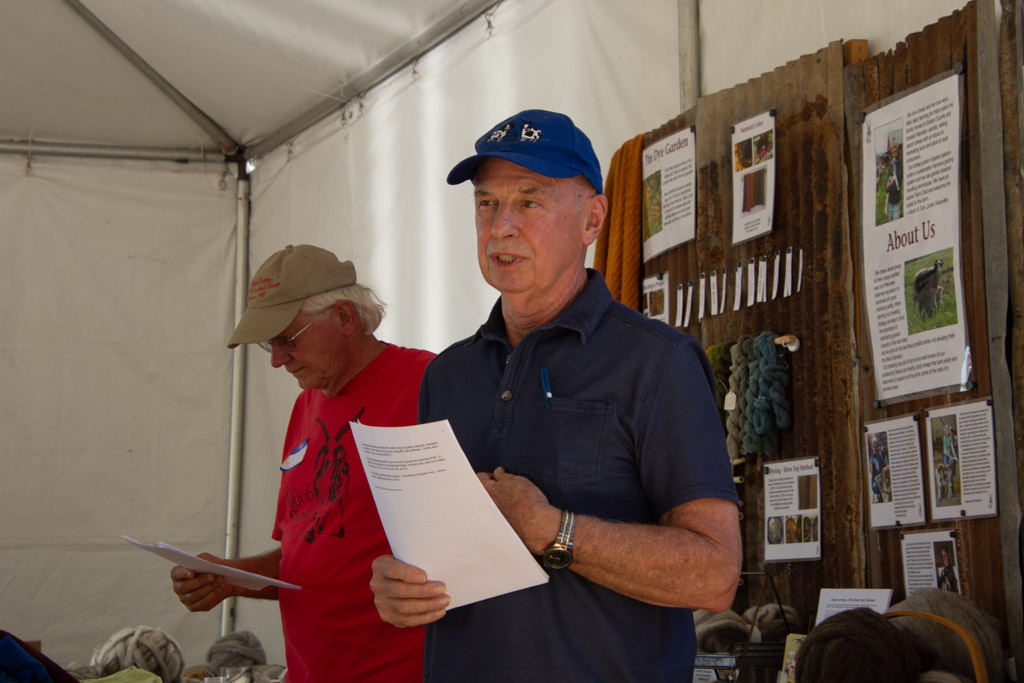 Royal and others presented reports...
Royal and others presented reports...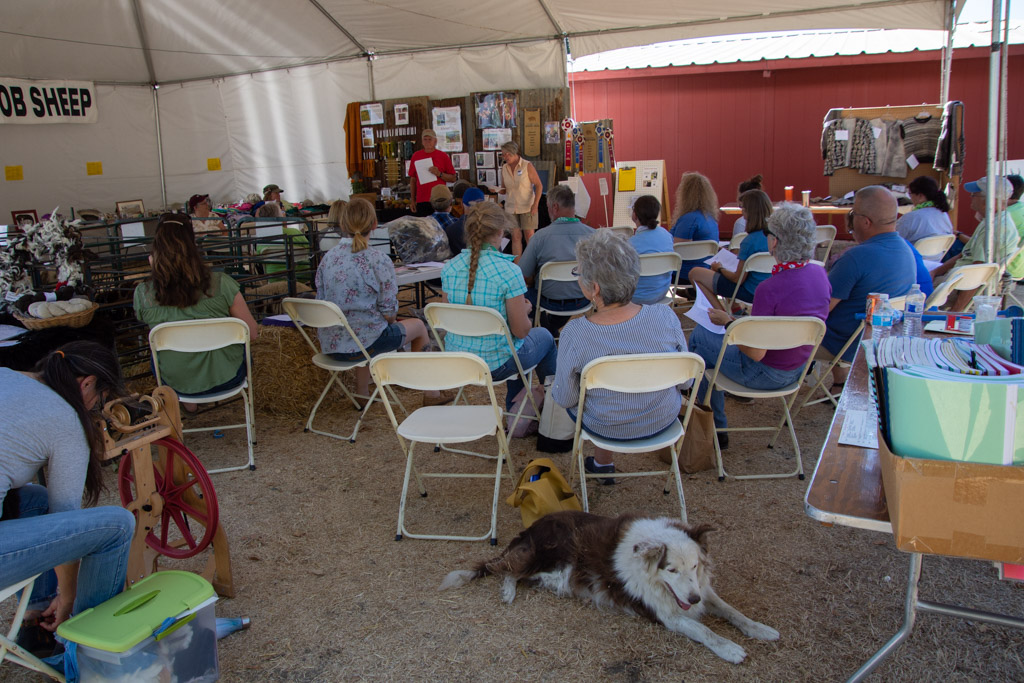
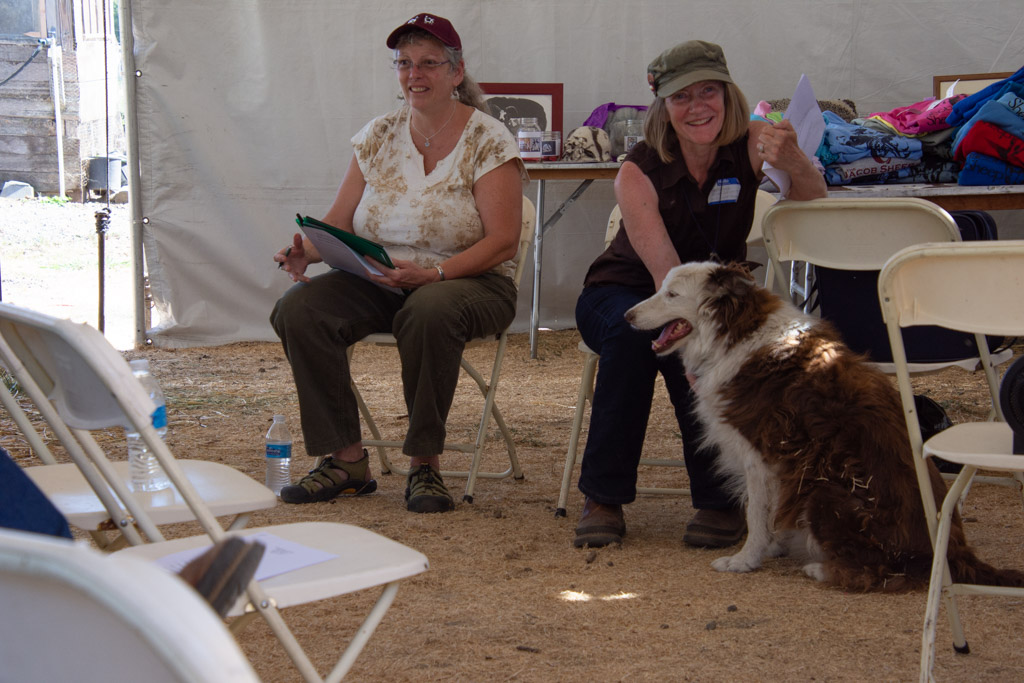
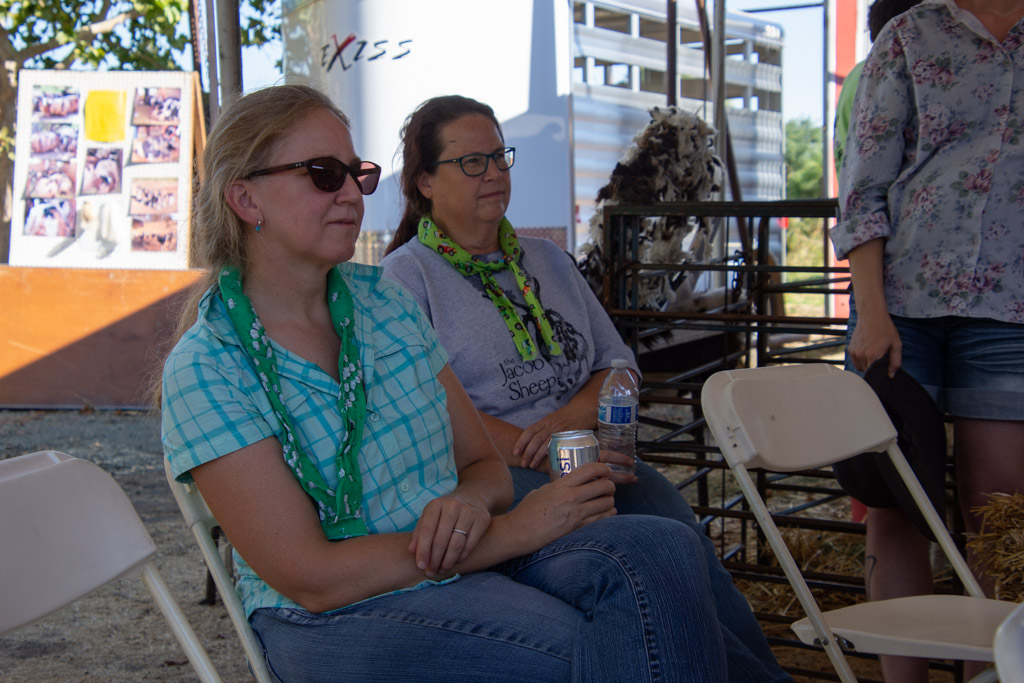
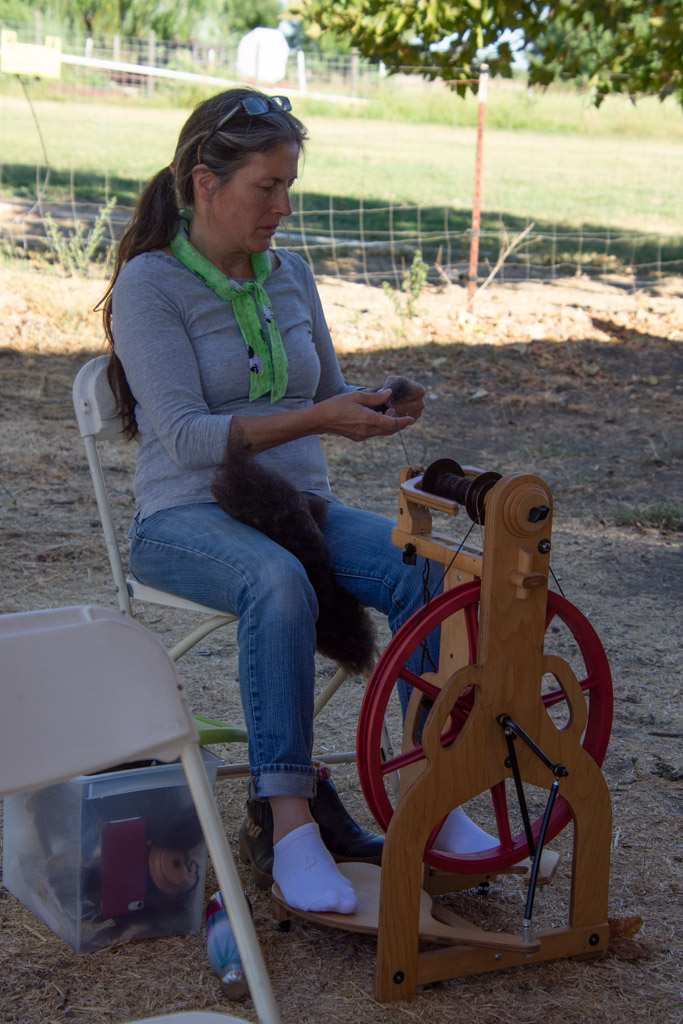
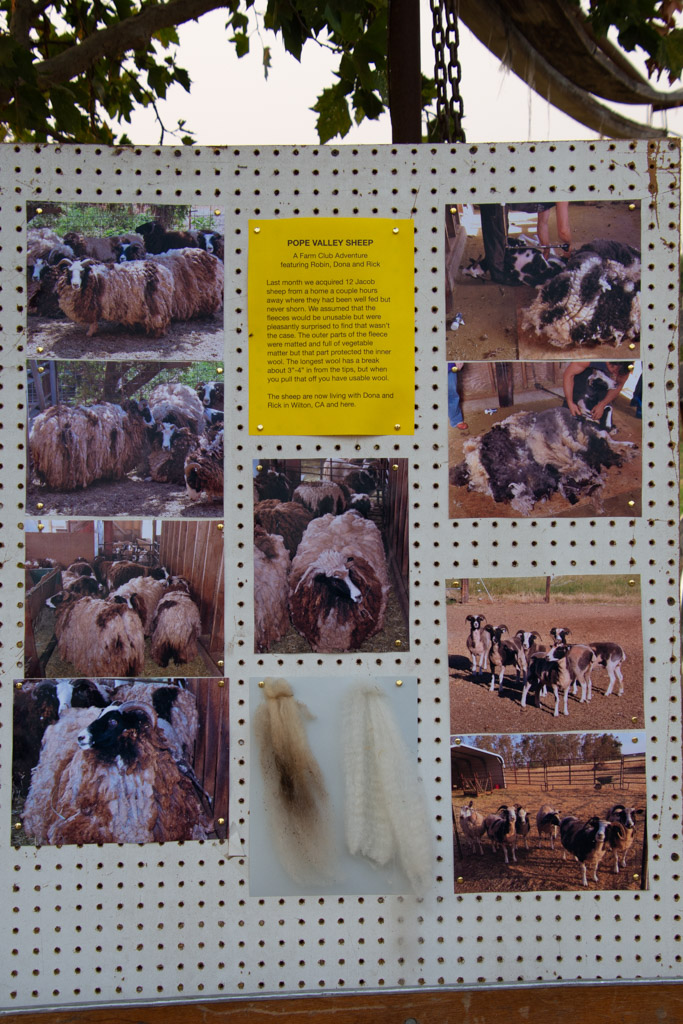 Did I share the things to look at in the tent? Dona put together a display of the unshorn Pope Valley sheep that we recently acquired.
Did I share the things to look at in the tent? Dona put together a display of the unshorn Pope Valley sheep that we recently acquired.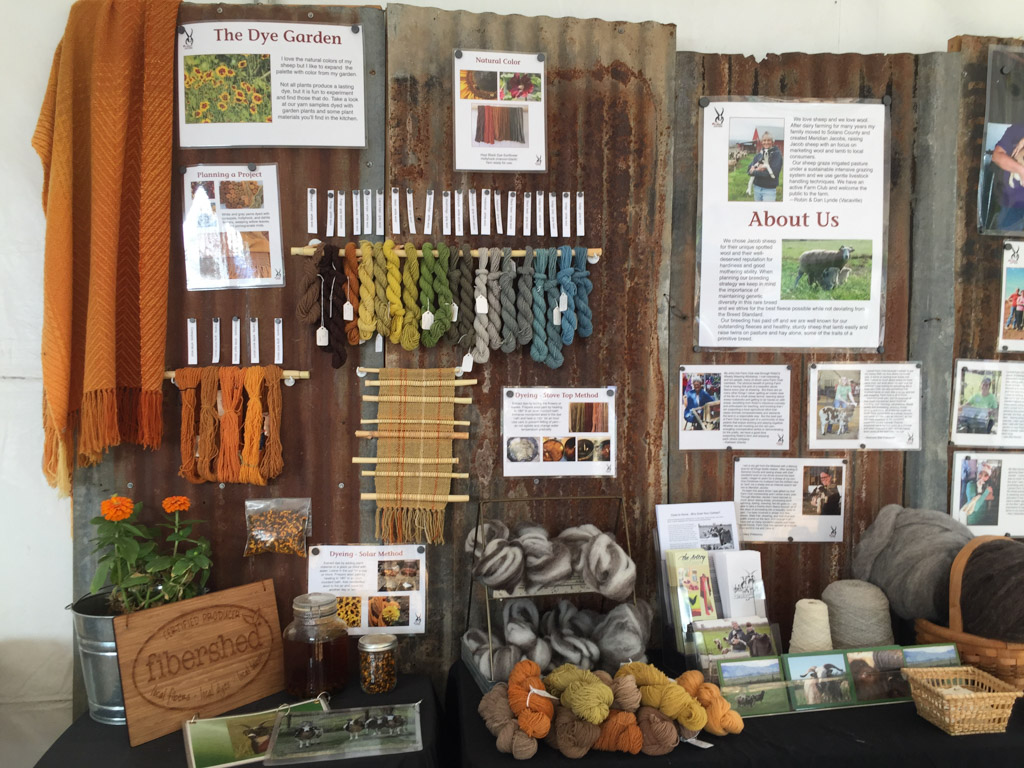 Having just finished the State Fair the week before we put up part of our Marketing (award winning by the way) display.
Having just finished the State Fair the week before we put up part of our Marketing (award winning by the way) display.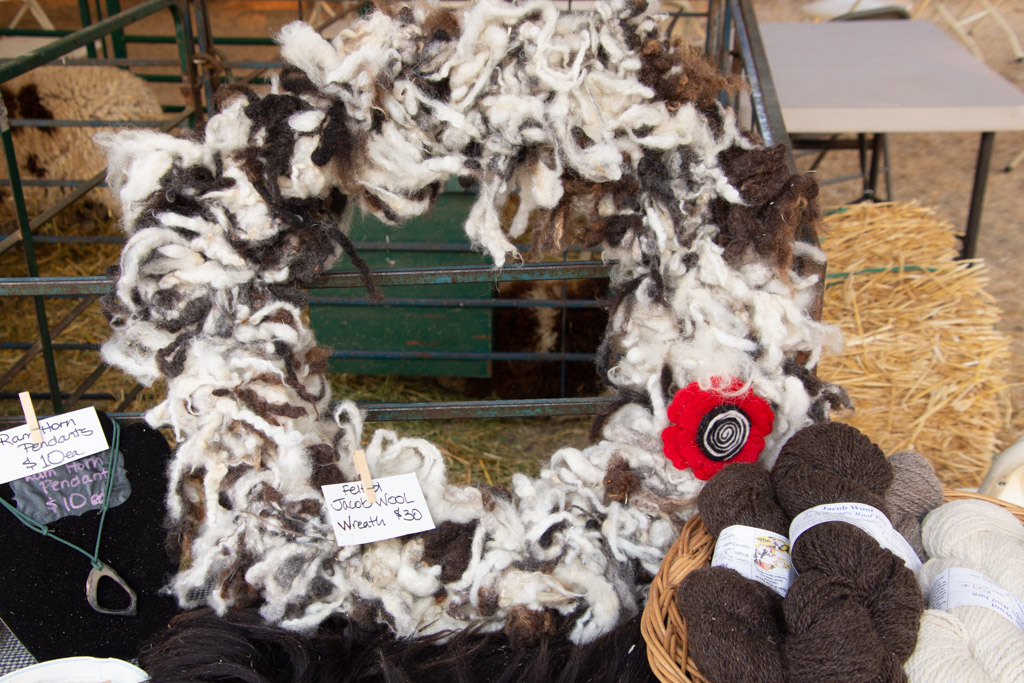 A couple of people had farm displays and sales.
A couple of people had farm displays and sales.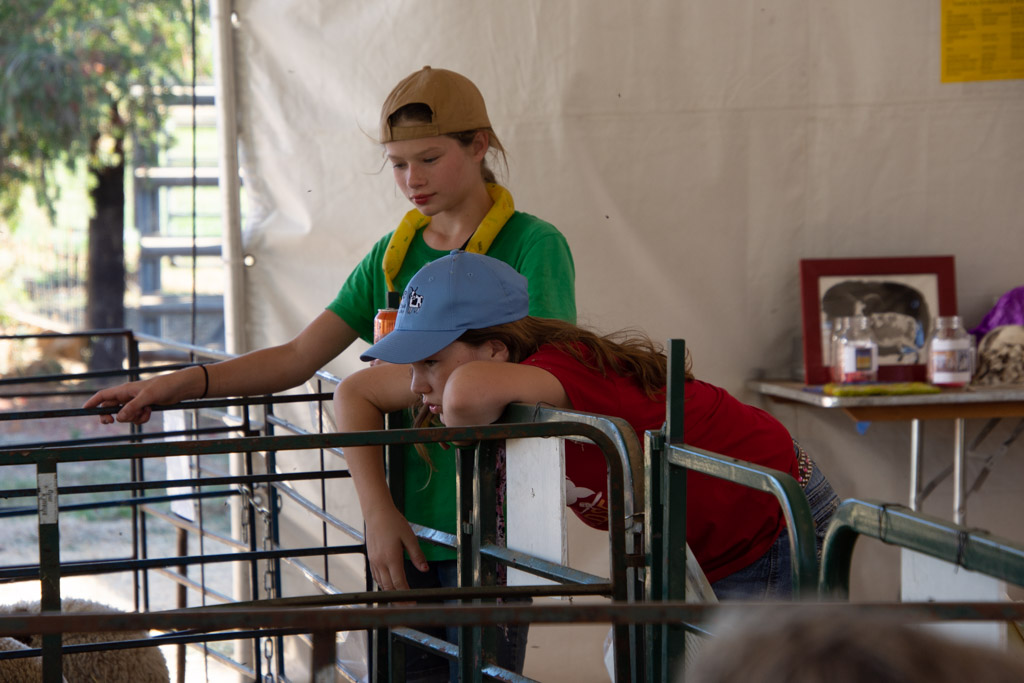 And there were sheep to buy.
And there were sheep to buy.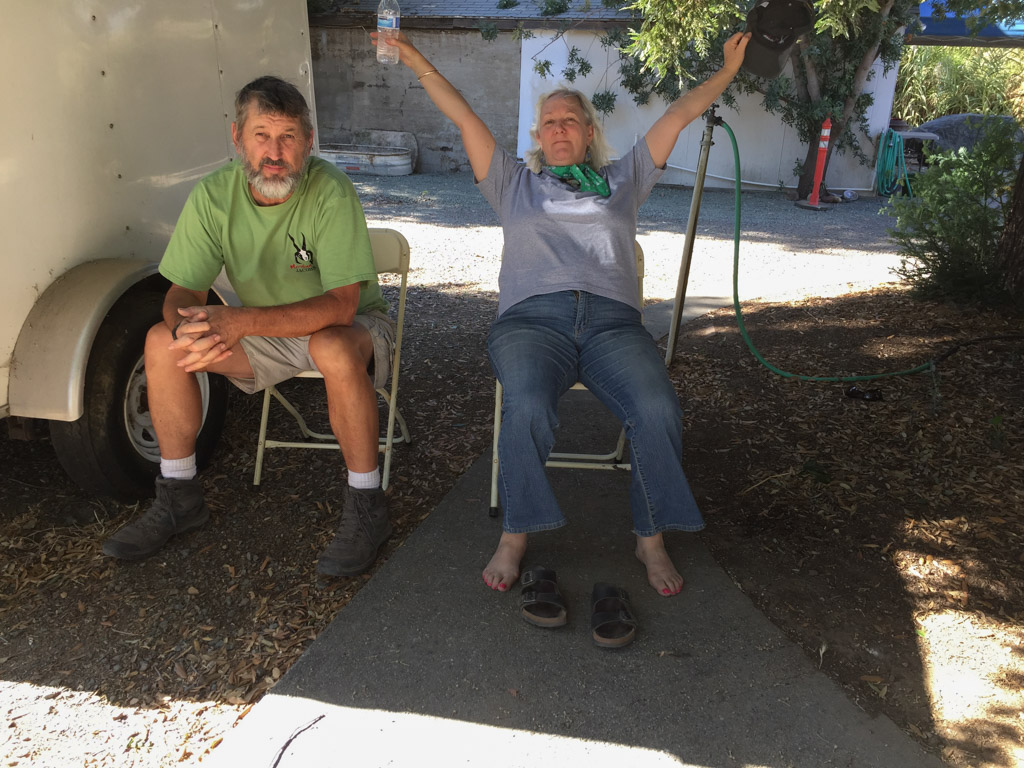 I find that my photos kind of stopped here at dinner. (But I will still find Dona's eventually.) After dinner we held the annual raffle and I don't have photos of that. There were fantastic prizes and we are grateful to everyone who provided them (you can see them
I find that my photos kind of stopped here at dinner. (But I will still find Dona's eventually.) After dinner we held the annual raffle and I don't have photos of that. There were fantastic prizes and we are grateful to everyone who provided them (you can see them 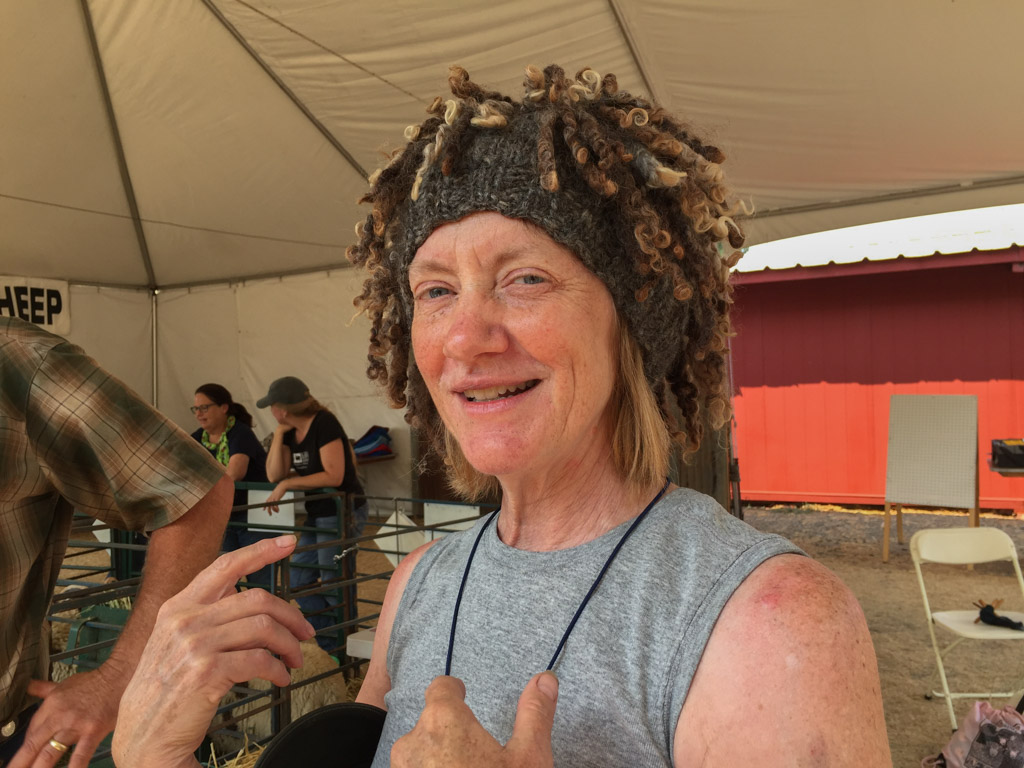 I enjoyed have Karen and Doug from Oregon here all weekend as Dan got a chance to meet them and spend some evening hours together. This is Karen's new look!
I enjoyed have Karen and Doug from Oregon here all weekend as Dan got a chance to meet them and spend some evening hours together. This is Karen's new look!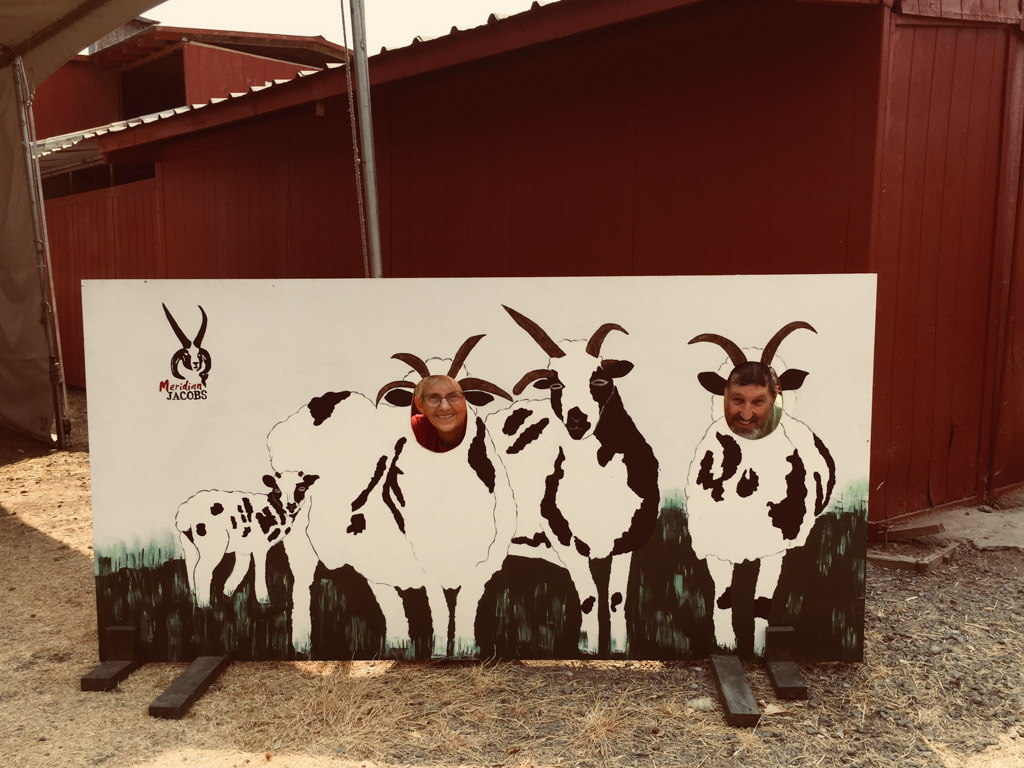 It was over all too soon. The tent was taken down, everything put away and we're back to normal. Or is it ever normal? Two days after this event and the months of getting the place fixed up Dan said something like "maybe we should work on the house now." That will be another story.
It was over all too soon. The tent was taken down, everything put away and we're back to normal. Or is it ever normal? Two days after this event and the months of getting the place fixed up Dan said something like "maybe we should work on the house now." That will be another story.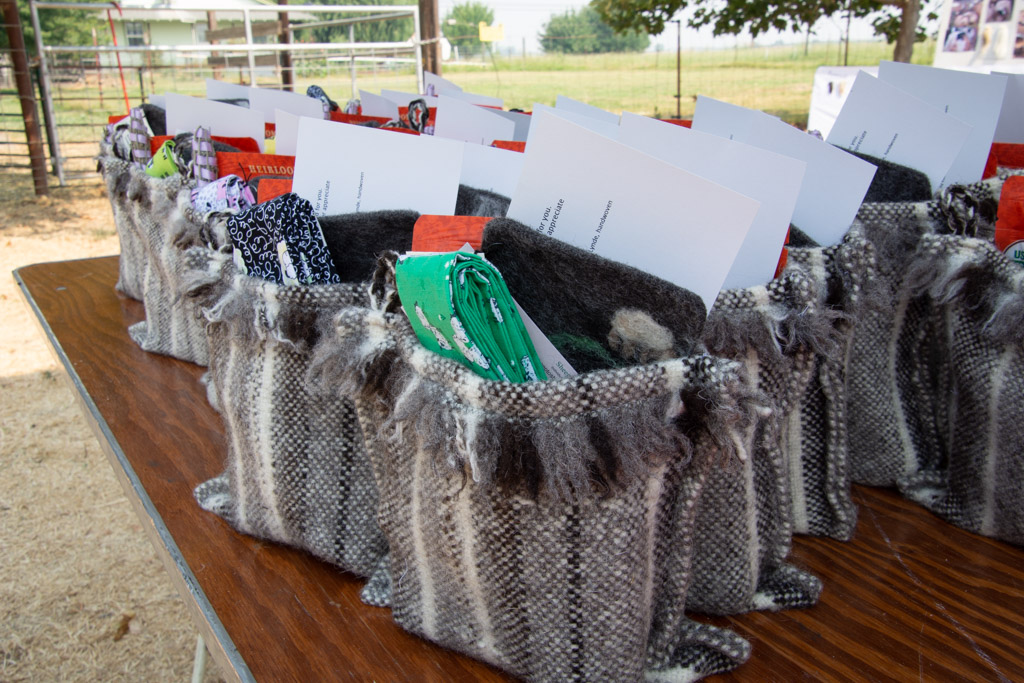 The handwoven Jacob wool goodie bags were ready, filled with locally made or grown products.
The handwoven Jacob wool goodie bags were ready, filled with locally made or grown products.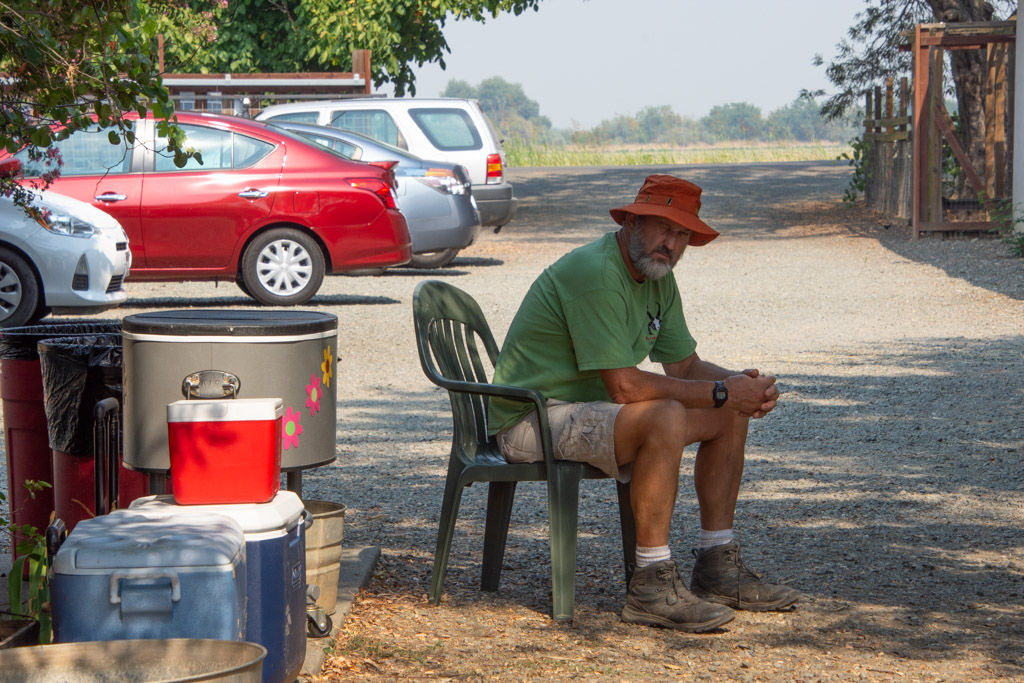 The friendly parking attendant was ready.
The friendly parking attendant was ready.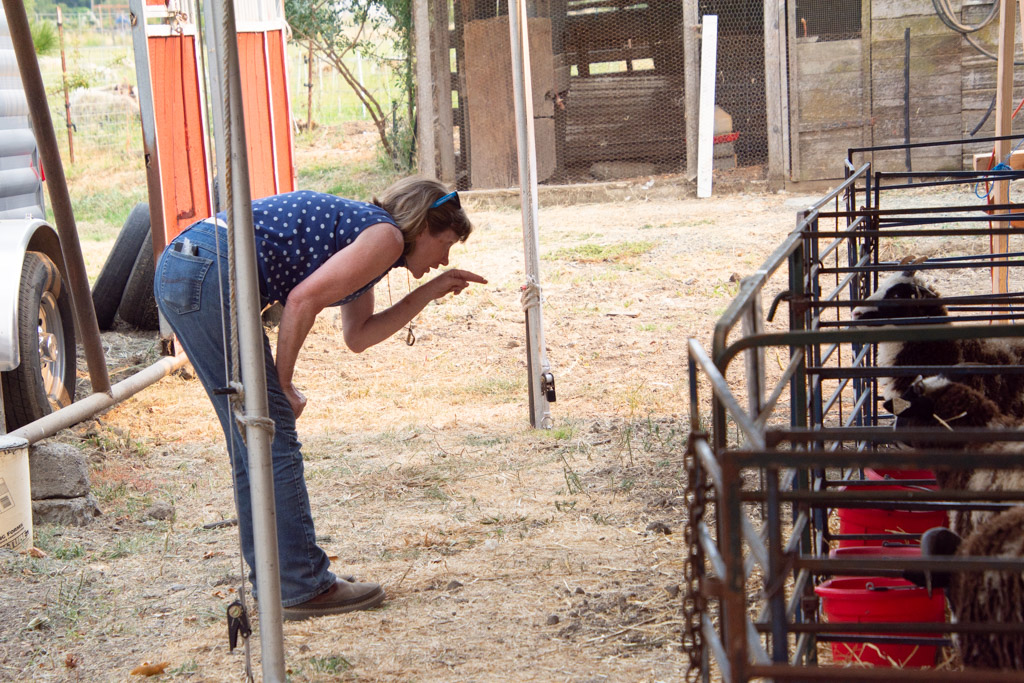 Sheep were given last minute instructions about behavior. (Karen Lobb from bide a wee Farm in Oregon)
Sheep were given last minute instructions about behavior. (Karen Lobb from bide a wee Farm in Oregon)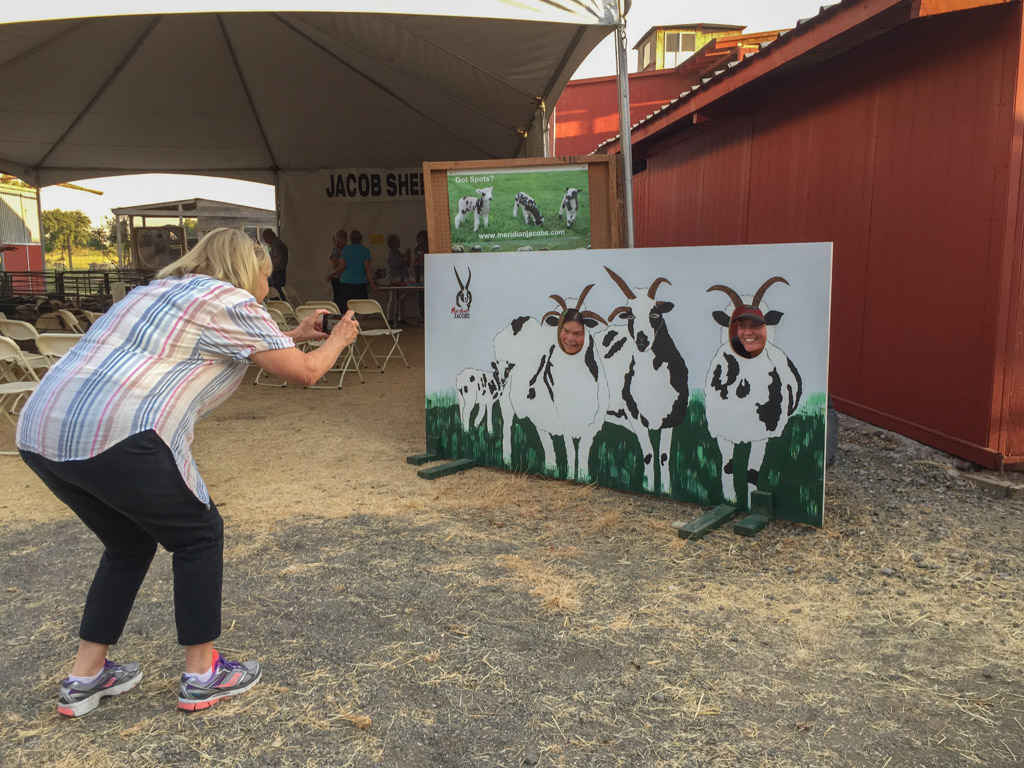 Guest were arriving.
Guest were arriving.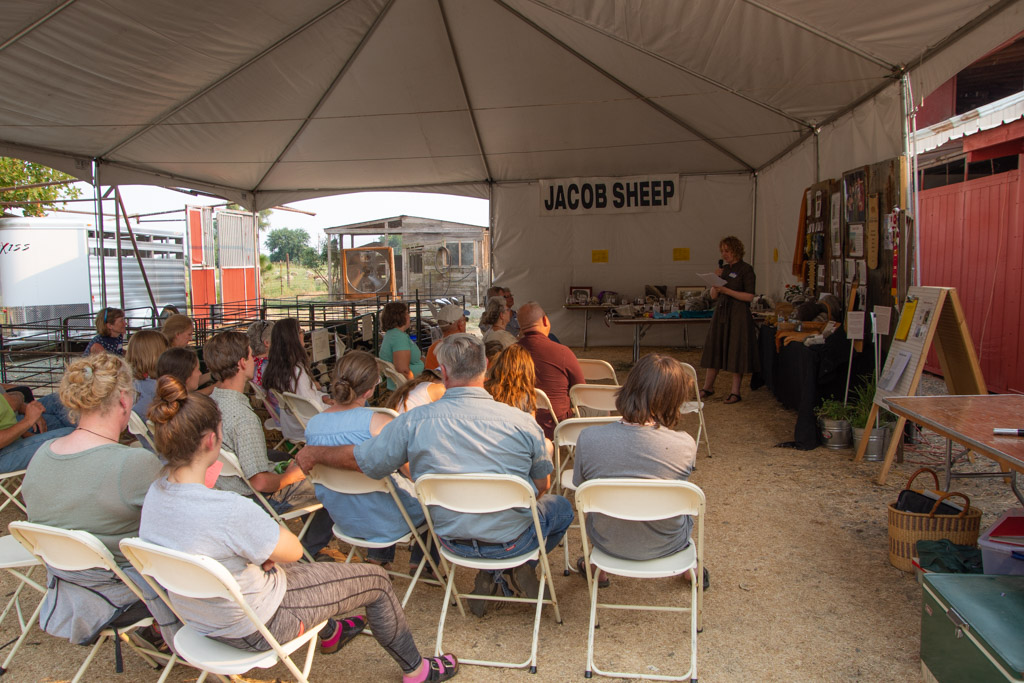 Our first gathering was a welcome by me and then a talk/book reading by
Our first gathering was a welcome by me and then a talk/book reading by 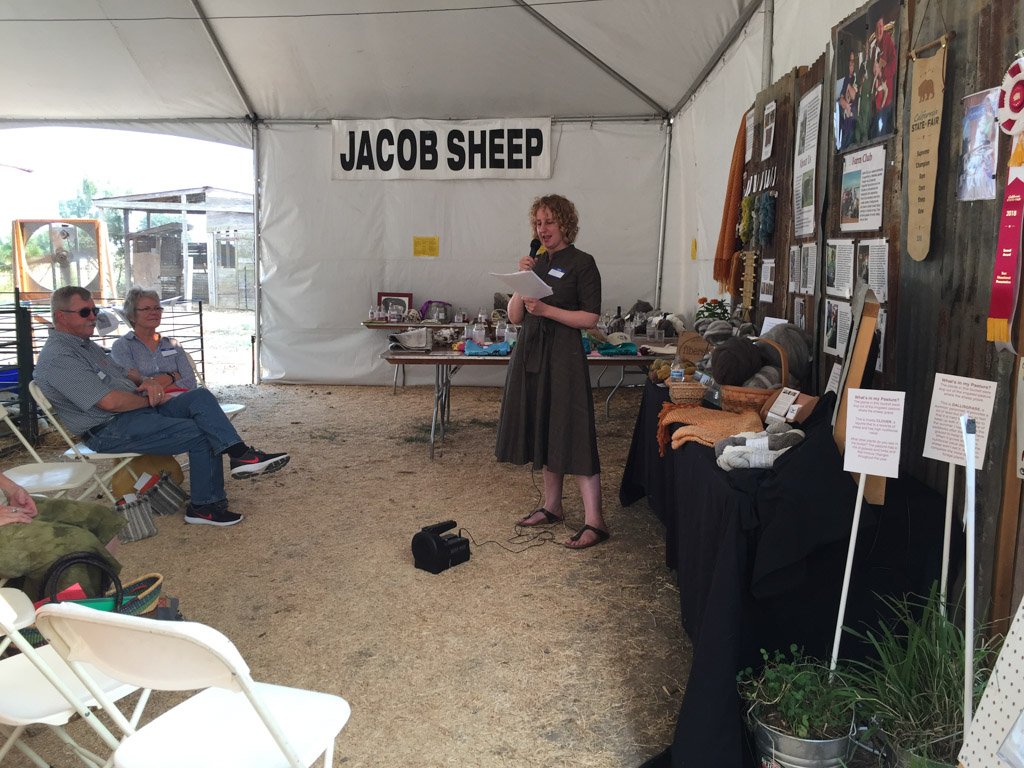 She read passages from her book, Raw Material, Working Wool in the West, to be published in October. This introduced the attendees to the concept of Fibershed and to Farm Club all at once.
She read passages from her book, Raw Material, Working Wool in the West, to be published in October. This introduced the attendees to the concept of Fibershed and to Farm Club all at once.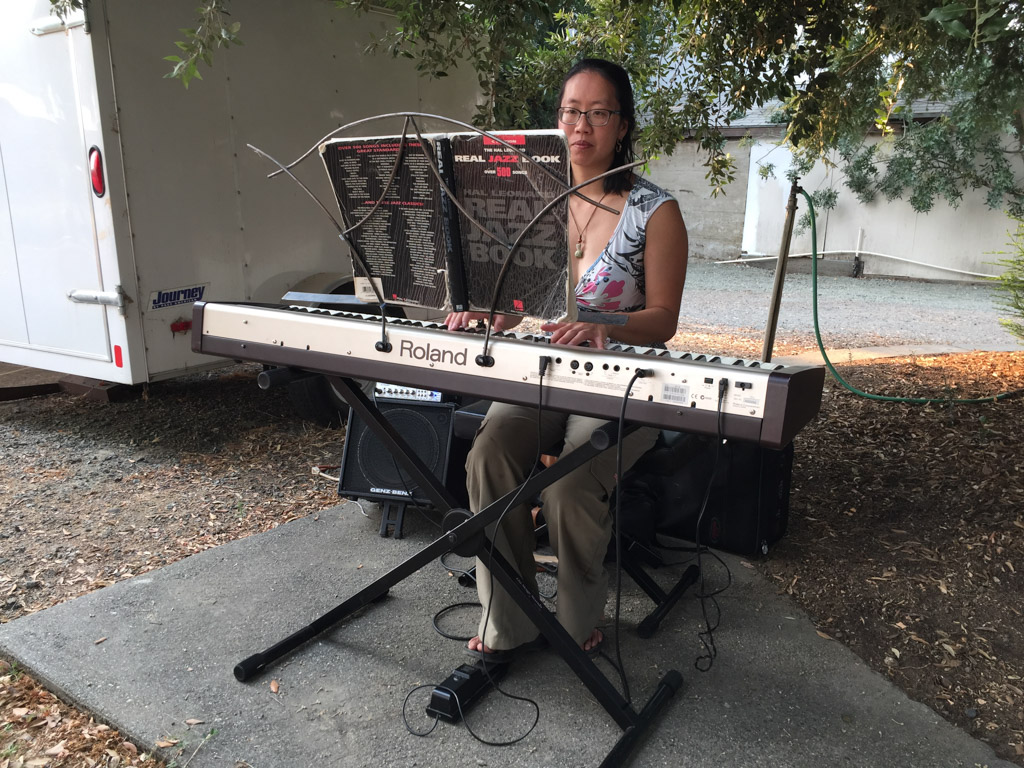 Next it was time for dinner. Farm Club member, Kim, provided background music throughout dinner and we were told how much people enjoyed listening to her.
Next it was time for dinner. Farm Club member, Kim, provided background music throughout dinner and we were told how much people enjoyed listening to her.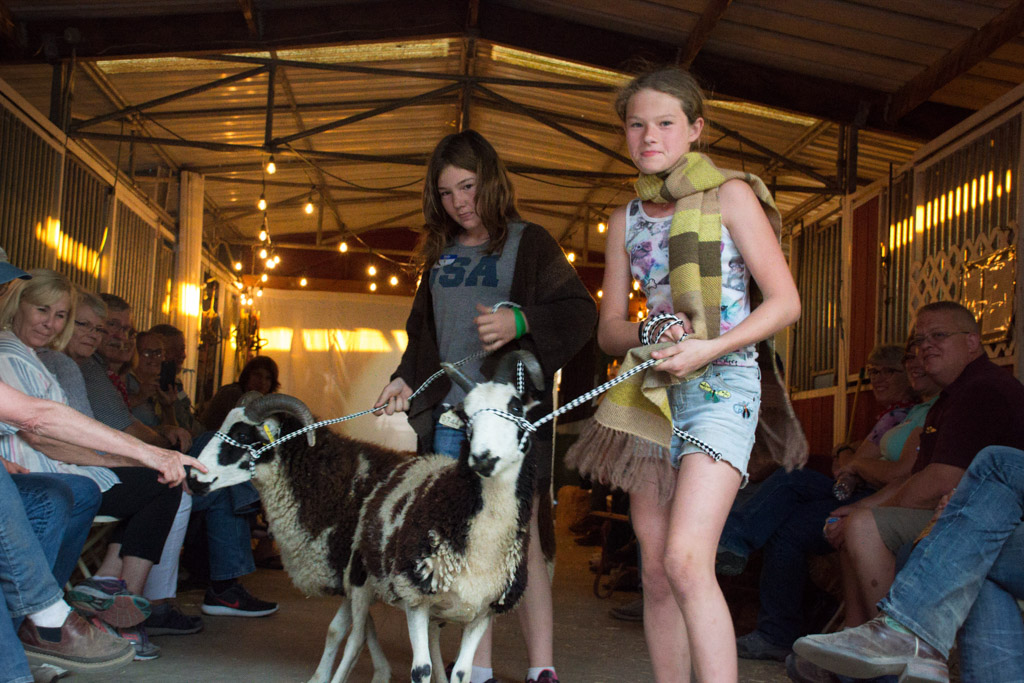 Most participants led sheep (some willing and some not so much) down the barn aisle...
Most participants led sheep (some willing and some not so much) down the barn aisle...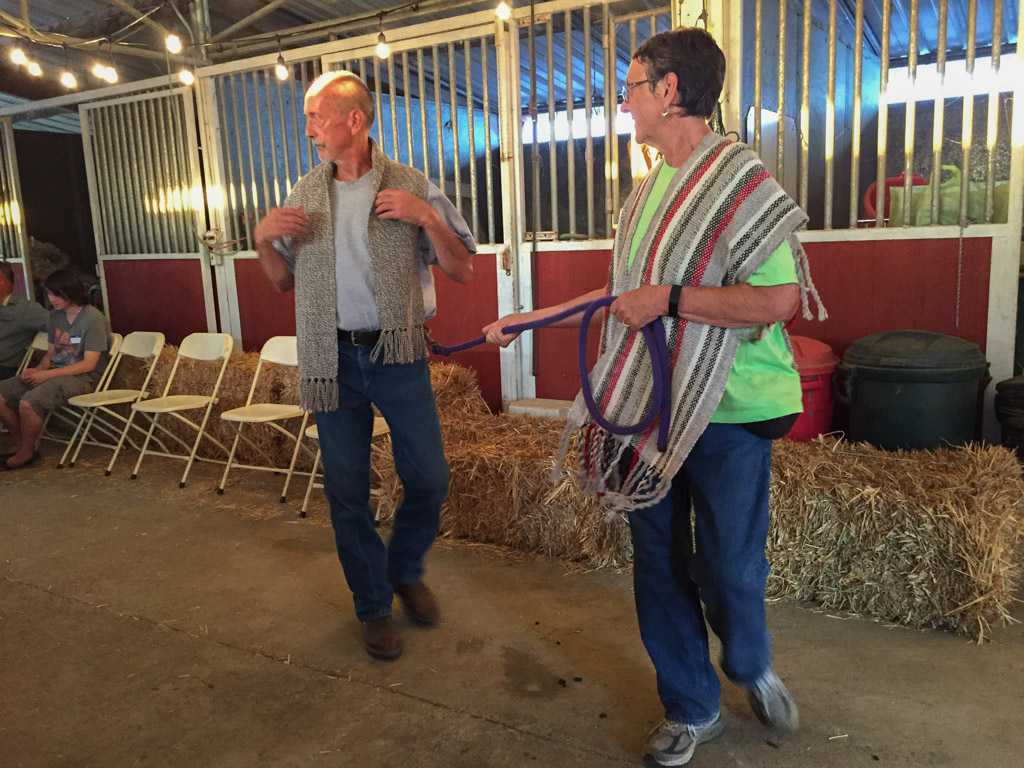 ...but Dona led Rick...
...but Dona led Rick...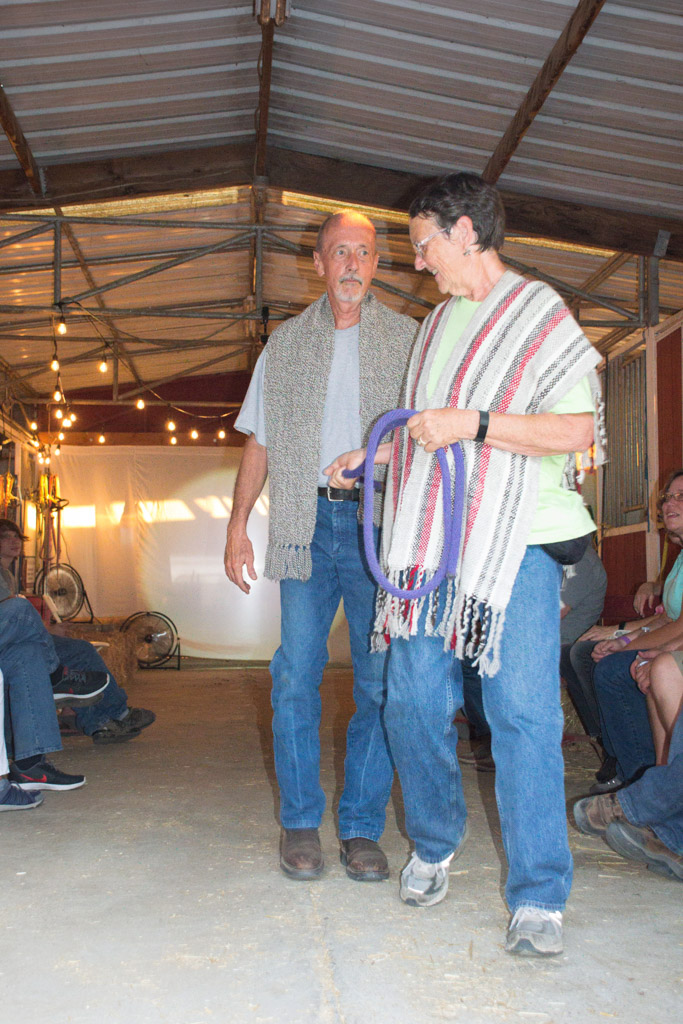 ...willingly?
...willingly?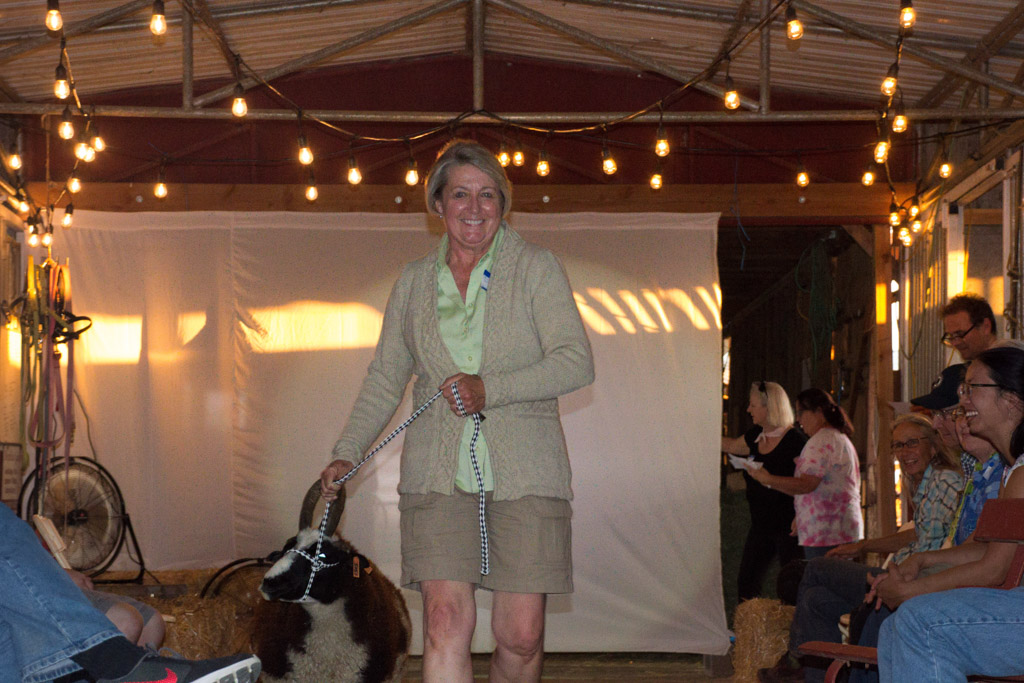
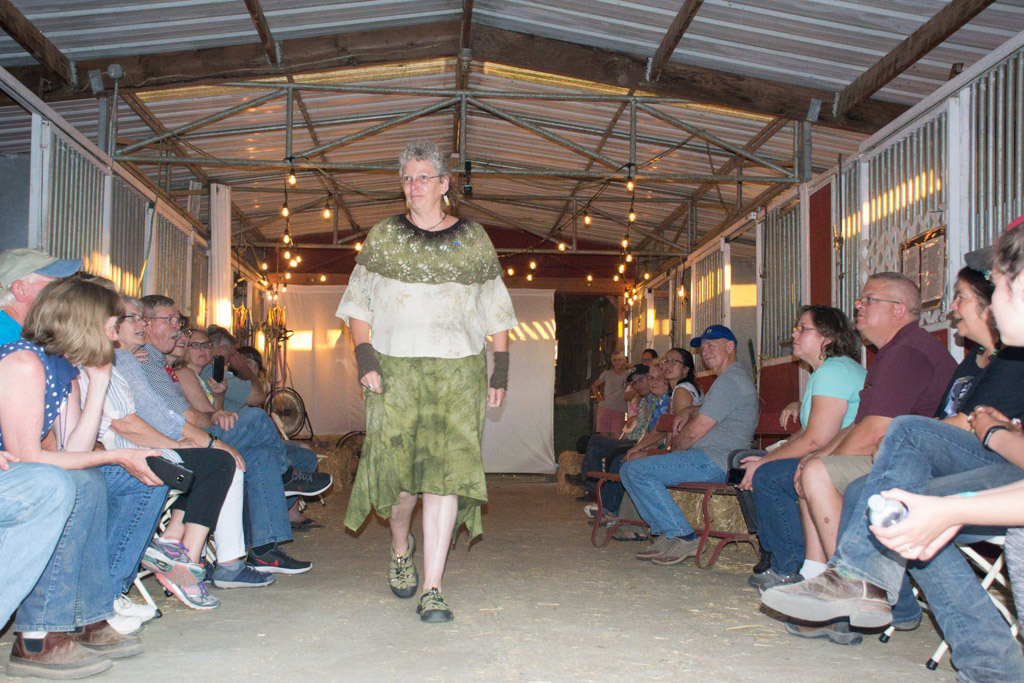
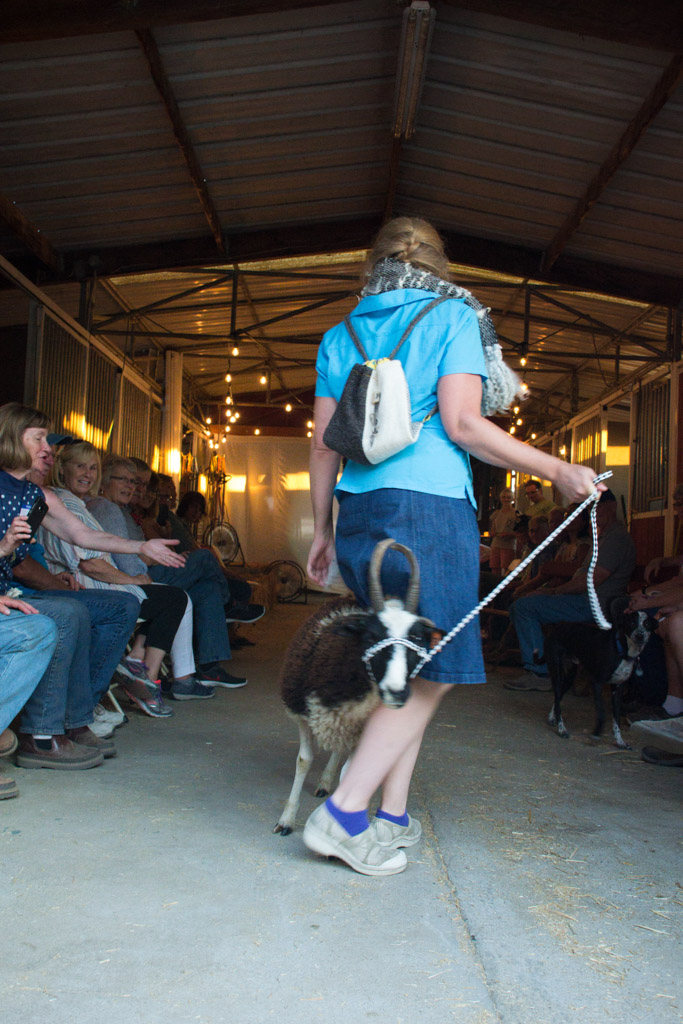
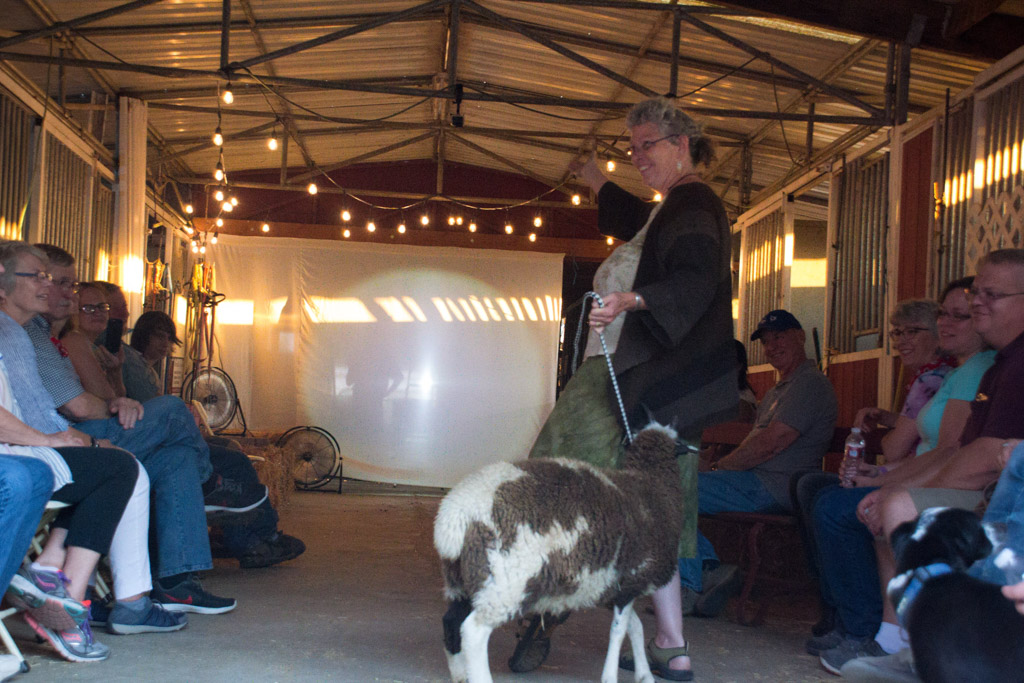
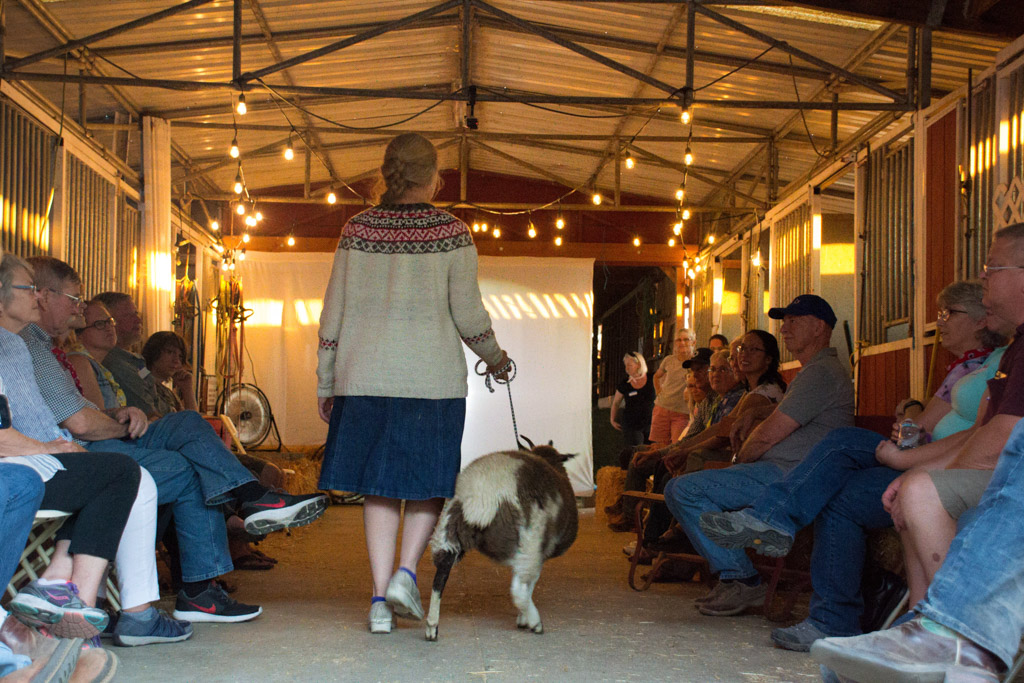
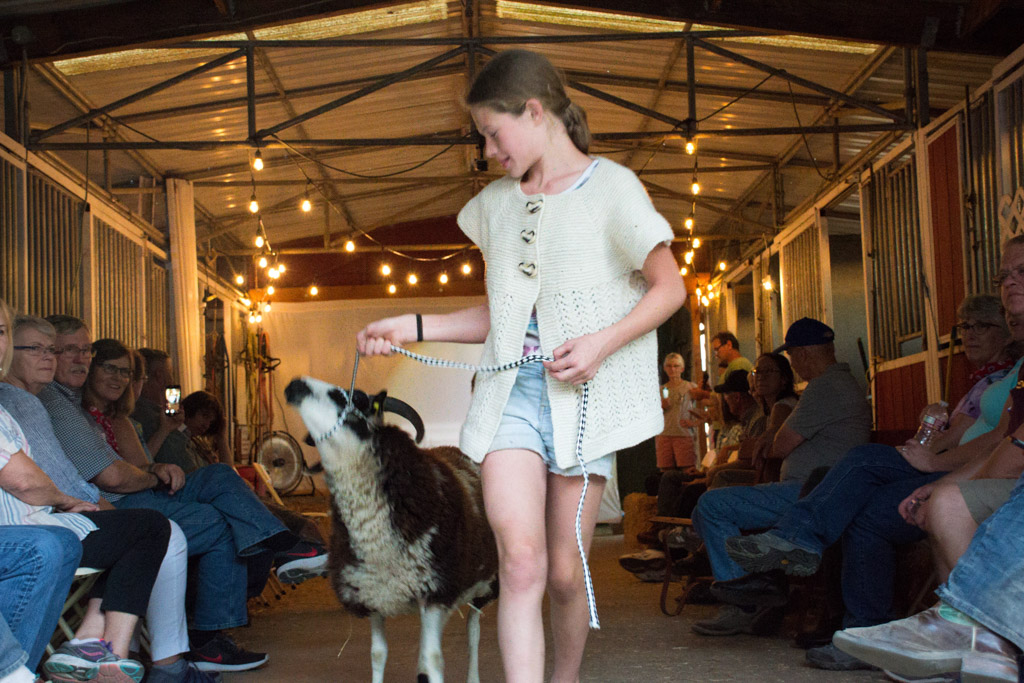
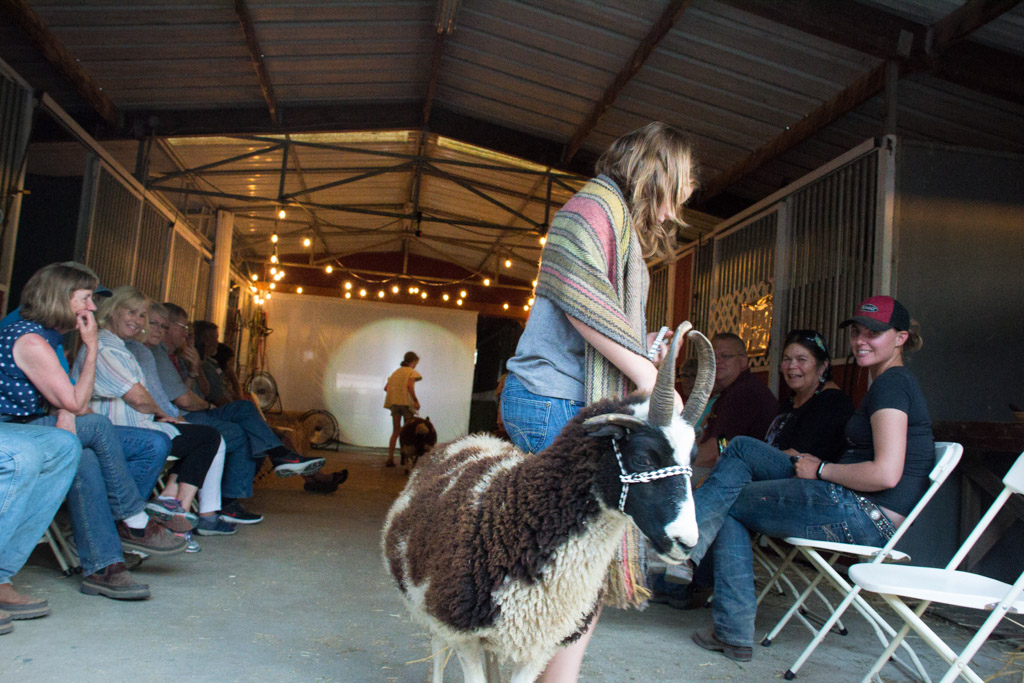
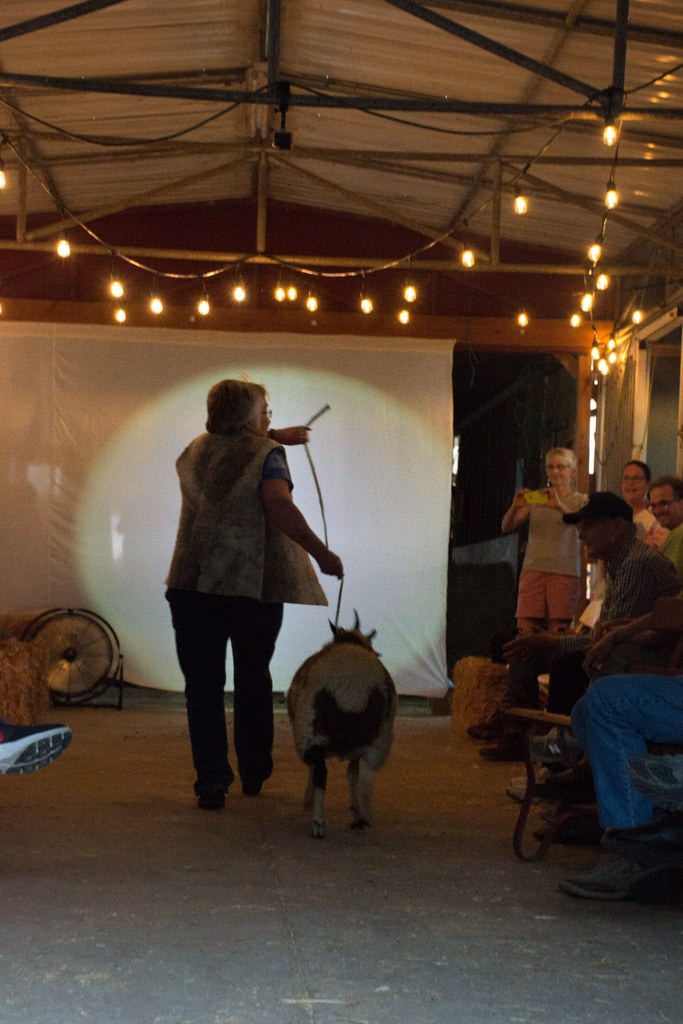
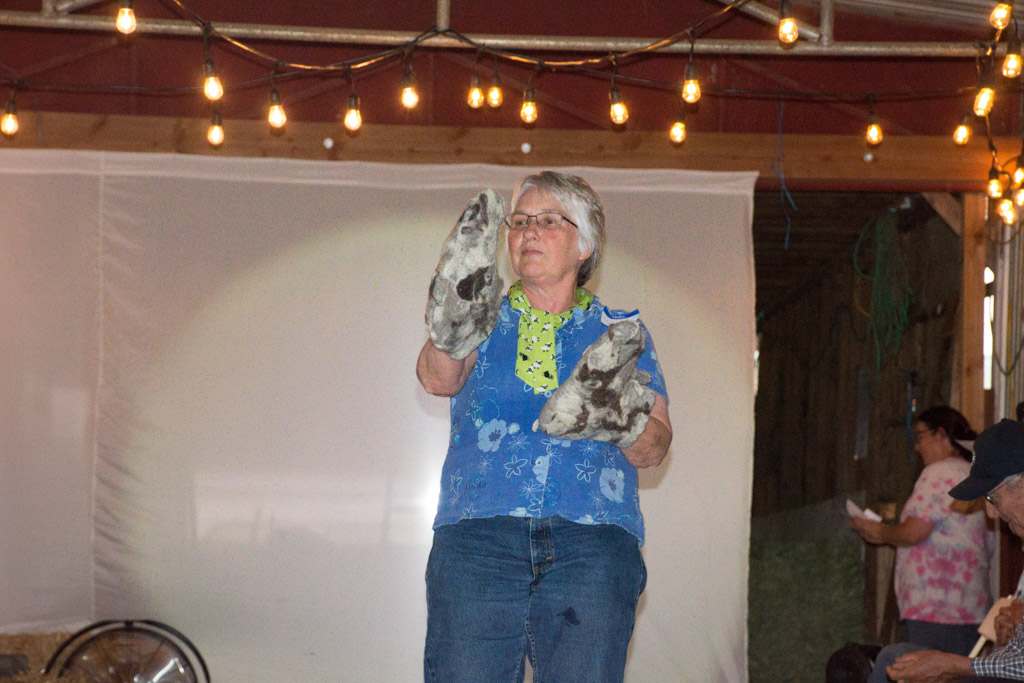
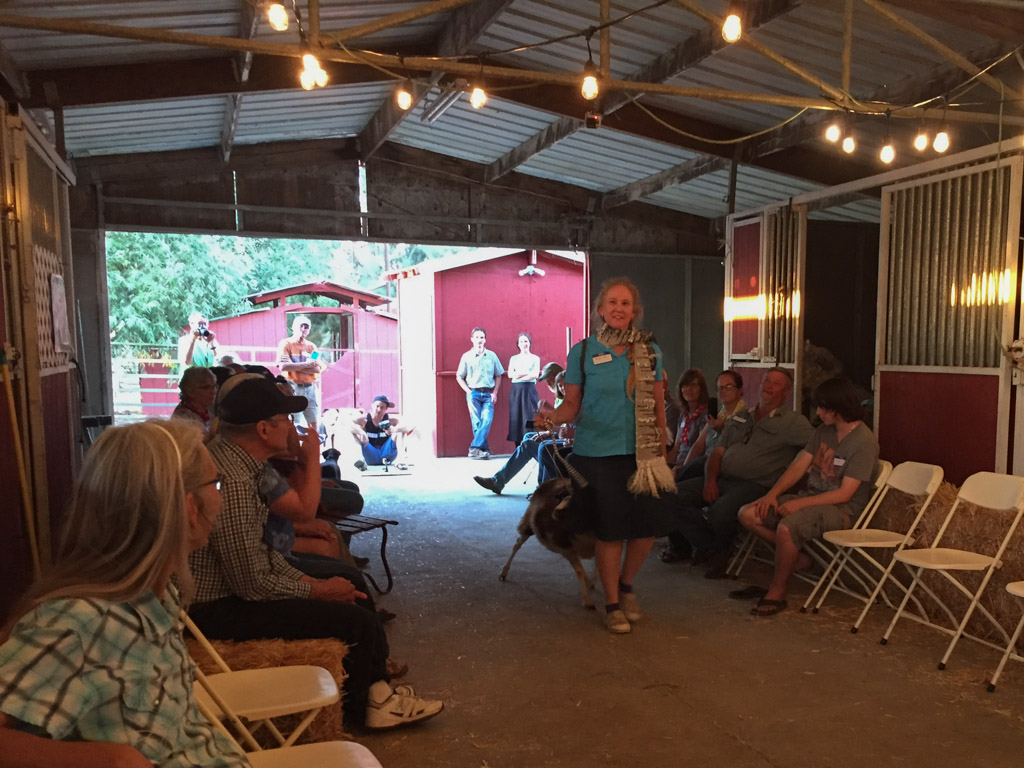
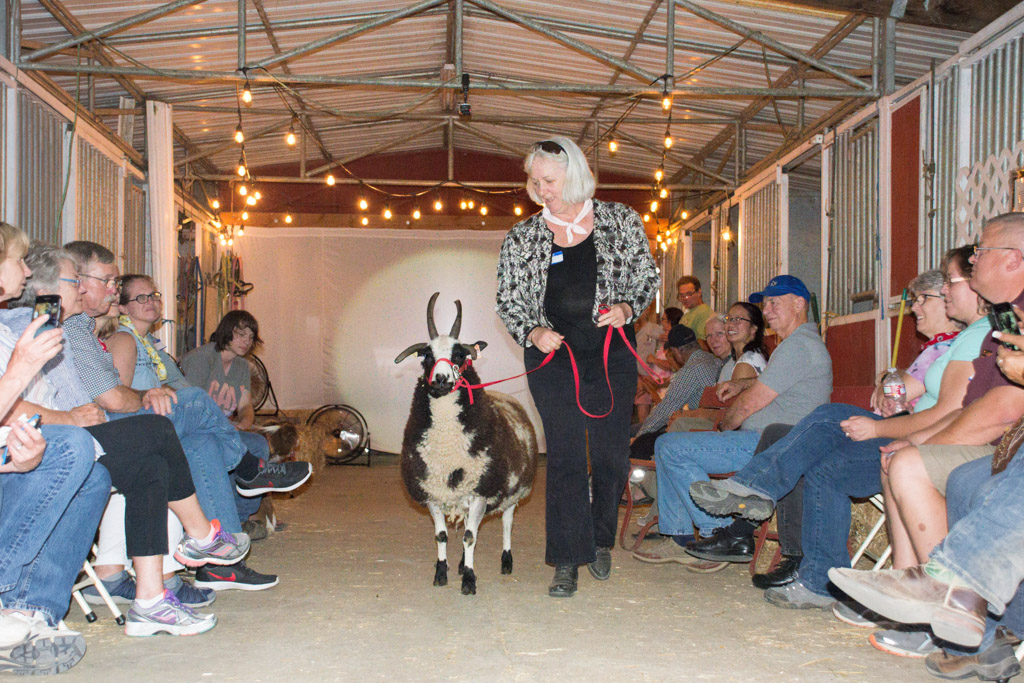
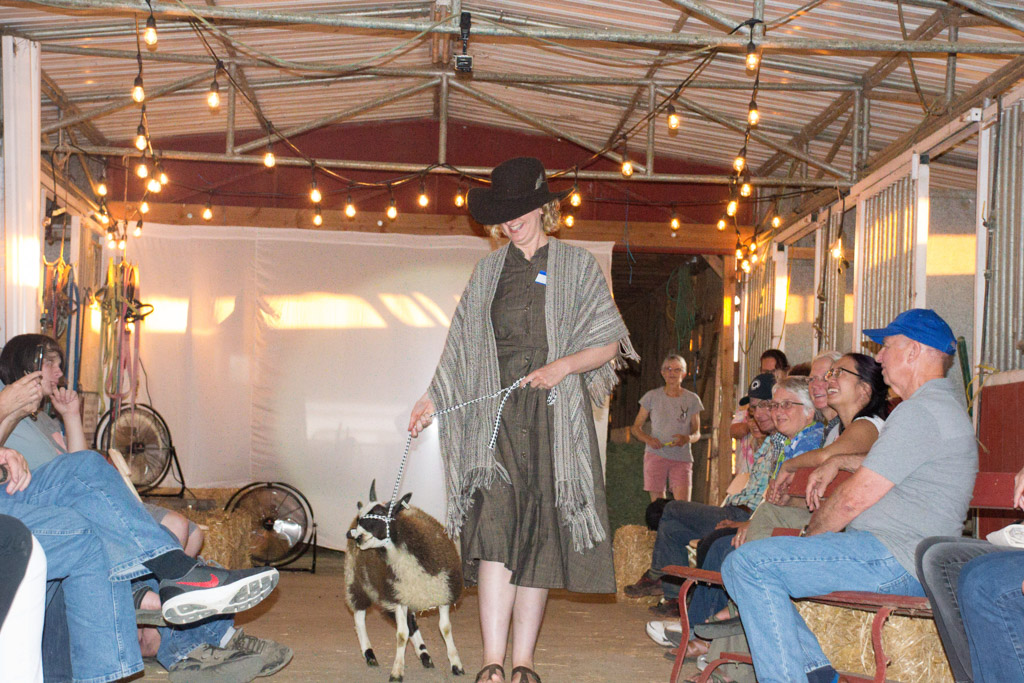
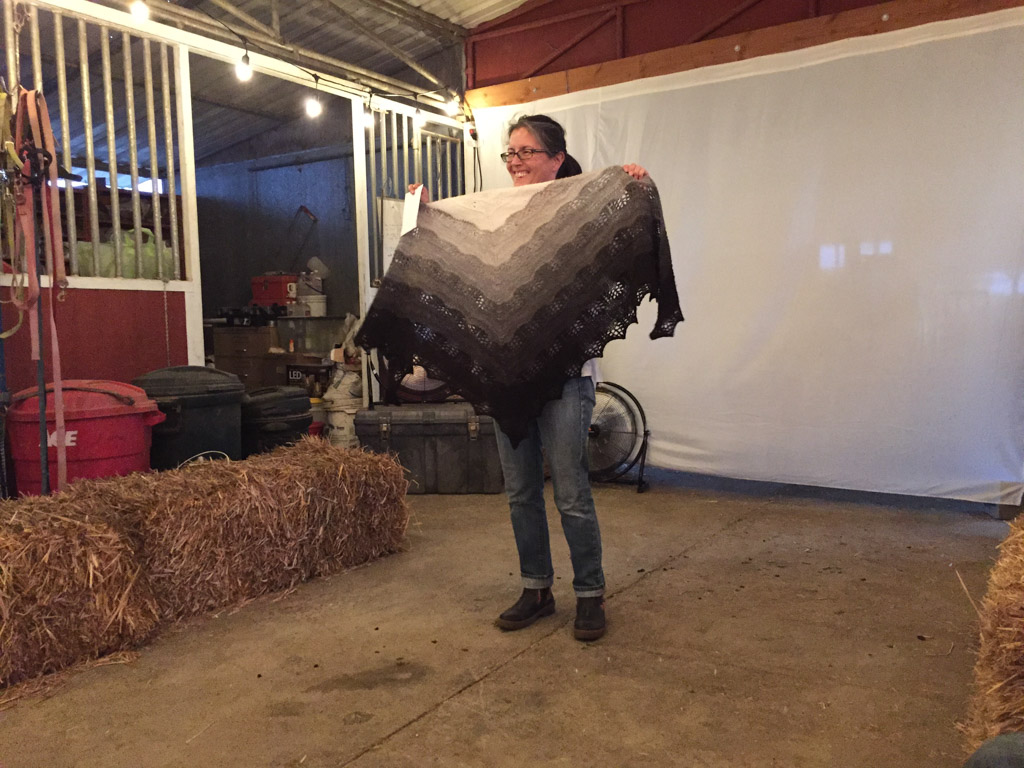 Doris was the recipient of the People's Choice award.
Doris was the recipient of the People's Choice award.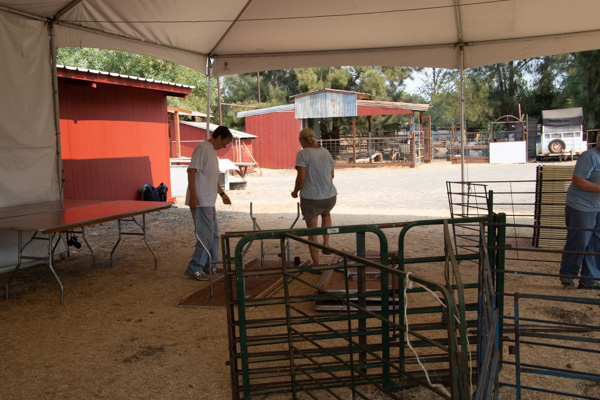 Tables were set up and arranged.
Tables were set up and arranged.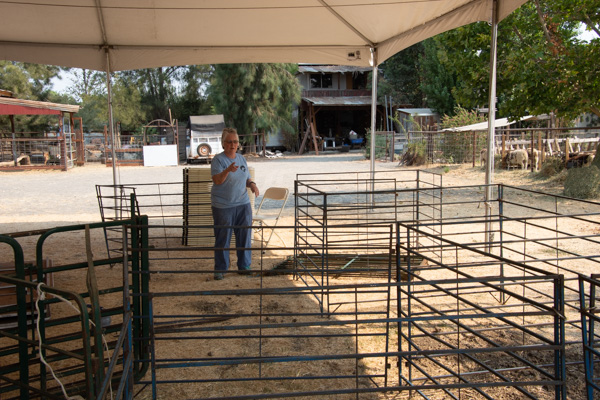 Trish borrowed sheep panels and we combined those with some I had to make pens.
Trish borrowed sheep panels and we combined those with some I had to make pens.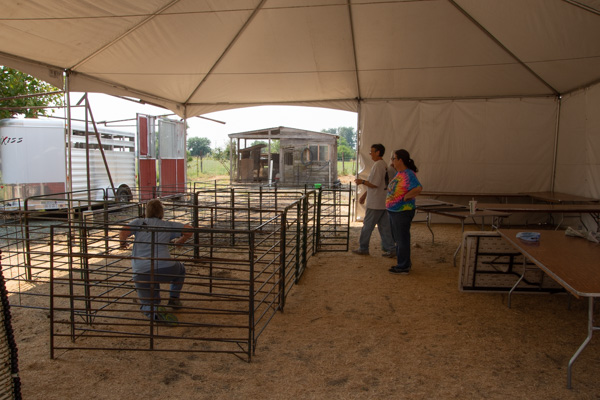
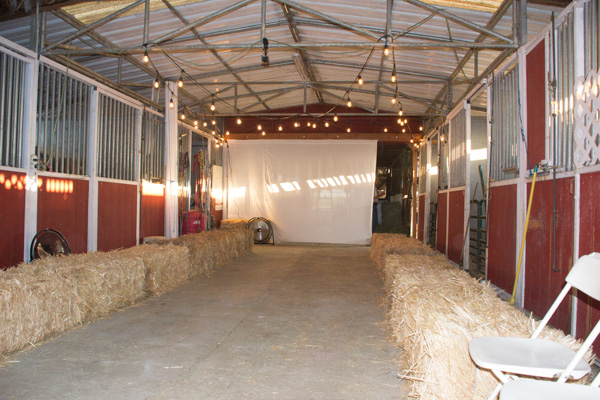 The barn was ready for Project Runway.
The barn was ready for Project Runway.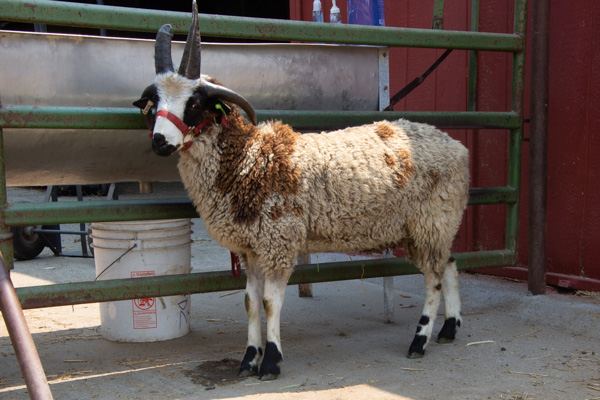
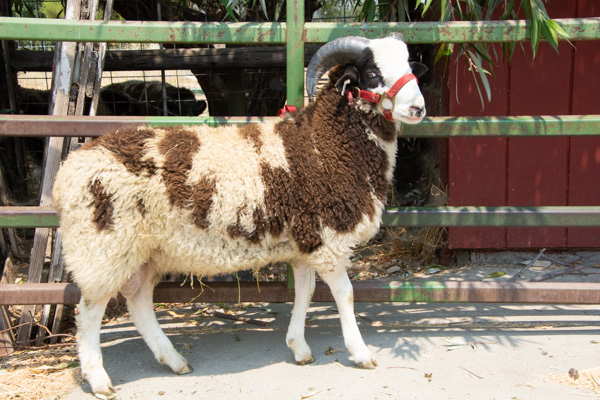
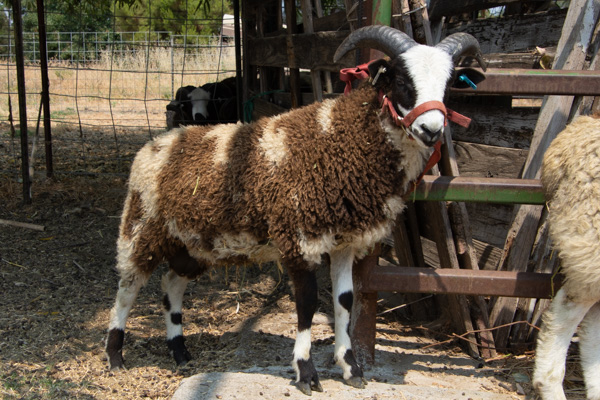
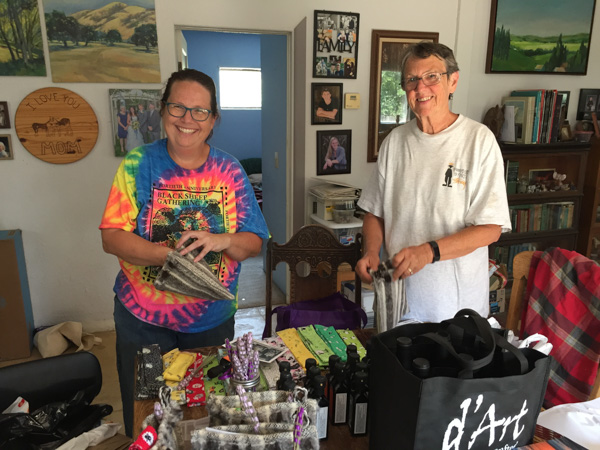 Mary and Dona stuffed the goodie bags that were to be given to the registrants. FC member, Kathleen wove 30 bags using Jacob wool and we had gathered locally produced items to put in them.
Mary and Dona stuffed the goodie bags that were to be given to the registrants. FC member, Kathleen wove 30 bags using Jacob wool and we had gathered locally produced items to put in them.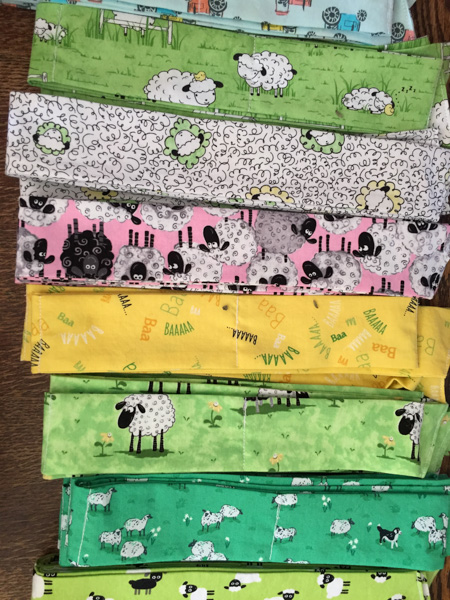 The special items included cooling neckties made by Mary using sheep-themed fabric. I can attest to how good these feel when it's 100 degrees out.
The special items included cooling neckties made by Mary using sheep-themed fabric. I can attest to how good these feel when it's 100 degrees out. 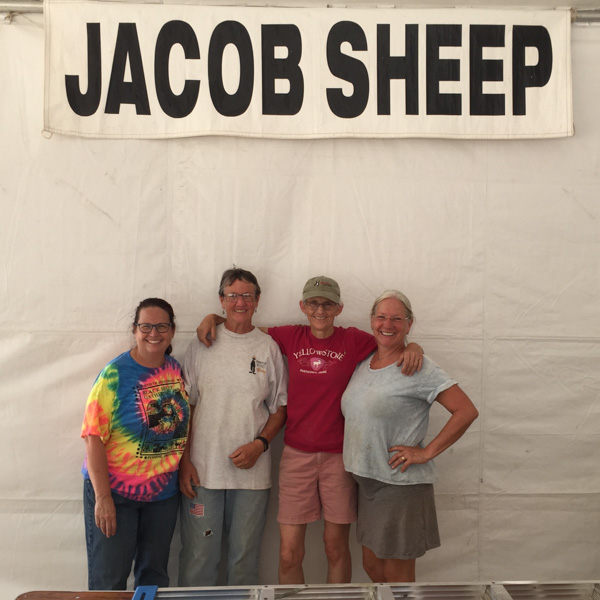 After another day of work we were ready for Friday when we'd be putting up displays and raffle items and greeting the registrants.
After another day of work we were ready for Friday when we'd be putting up displays and raffle items and greeting the registrants.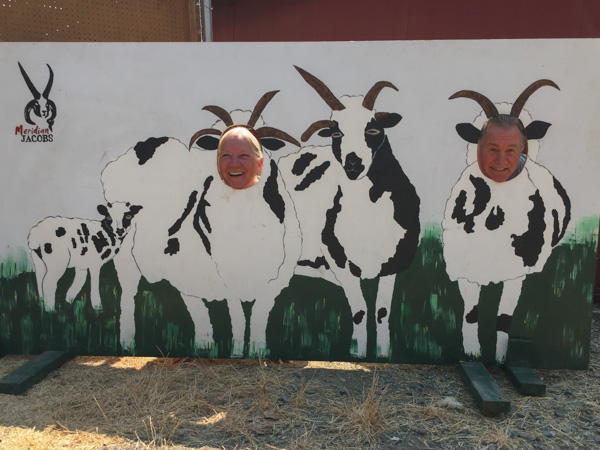
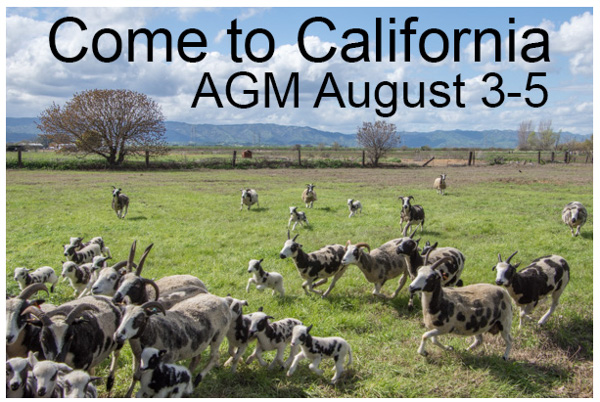
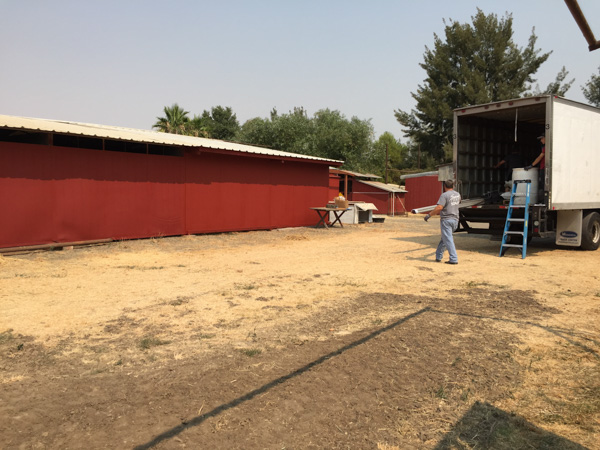
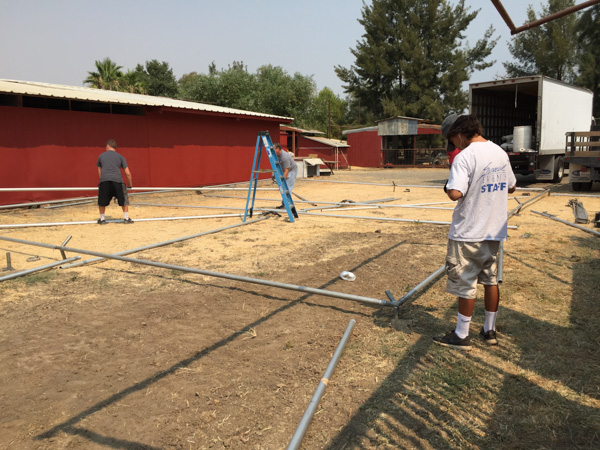
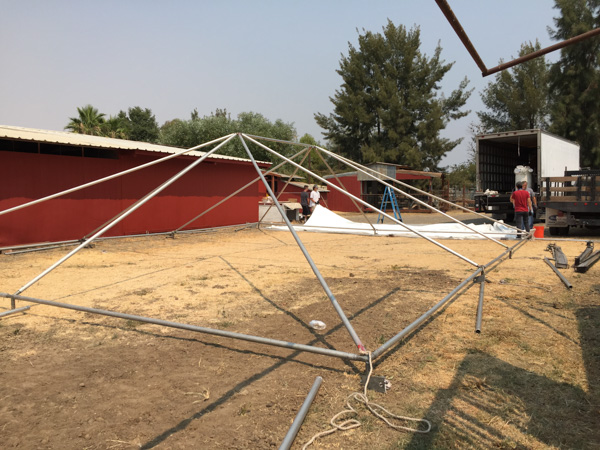
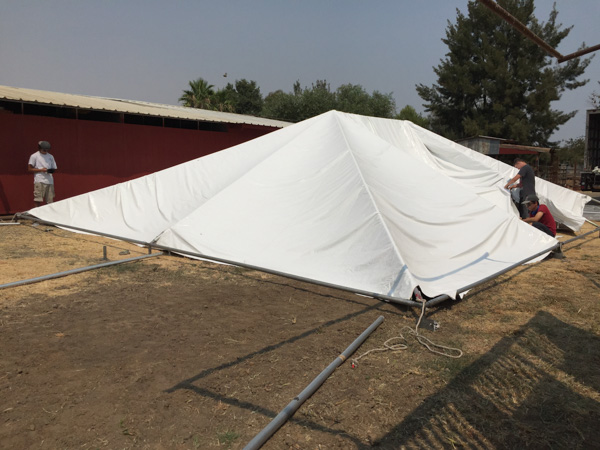
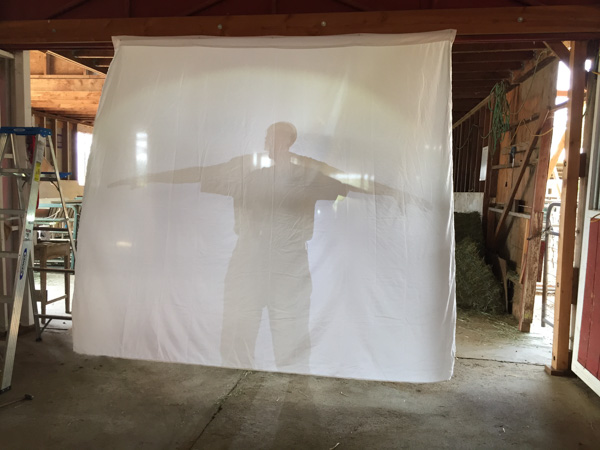 Mary and Russ organized Project Runway, Jacob Style, our Friday evening entertainment, to be held in the barn.
Mary and Russ organized Project Runway, Jacob Style, our Friday evening entertainment, to be held in the barn.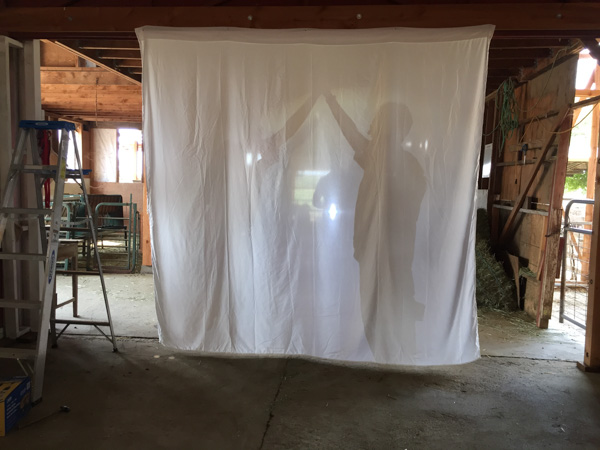 There was strategy involved in figuring out how to arrange lighting behind the drape for the desired effect.
There was strategy involved in figuring out how to arrange lighting behind the drape for the desired effect.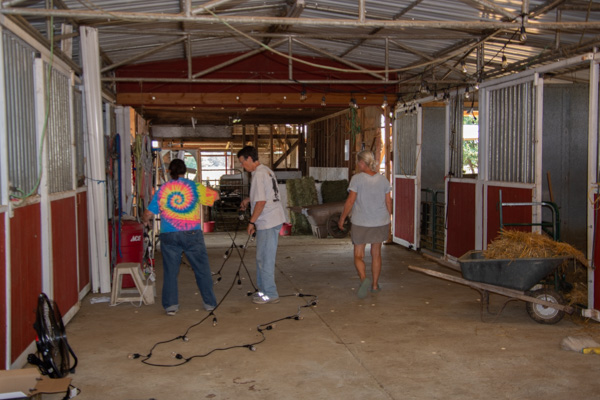
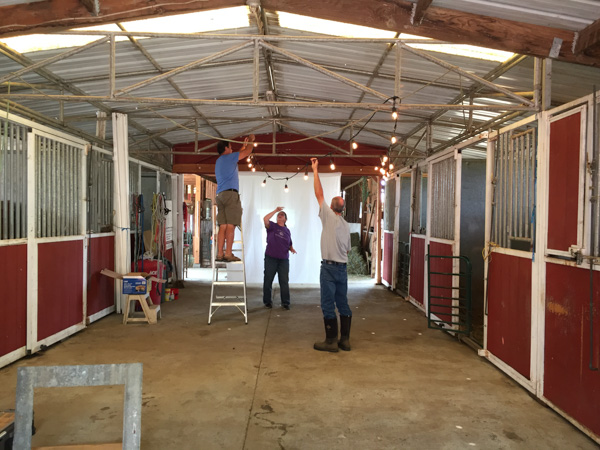
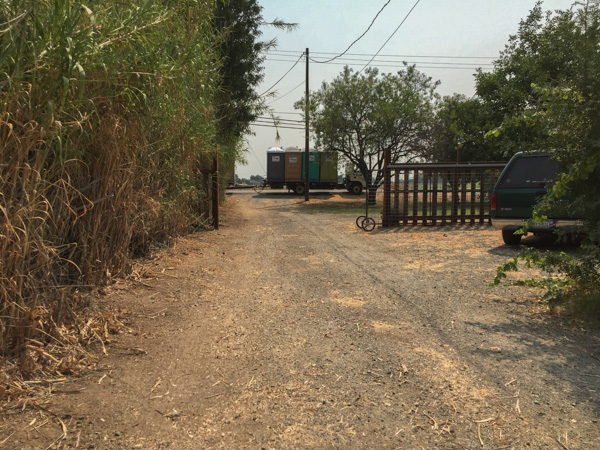 The extra porta-potty arrived.
The extra porta-potty arrived.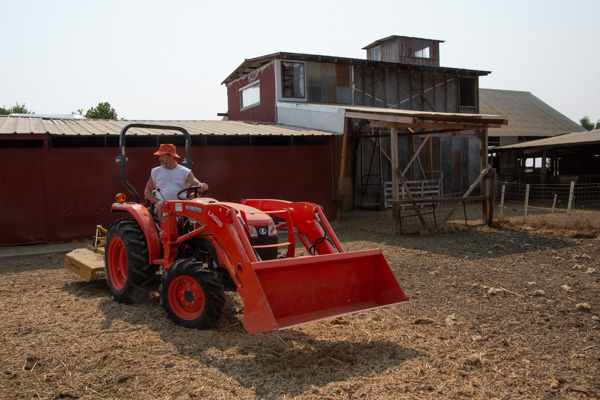 Dan scraped behind the barn to create more space for parking.
Dan scraped behind the barn to create more space for parking.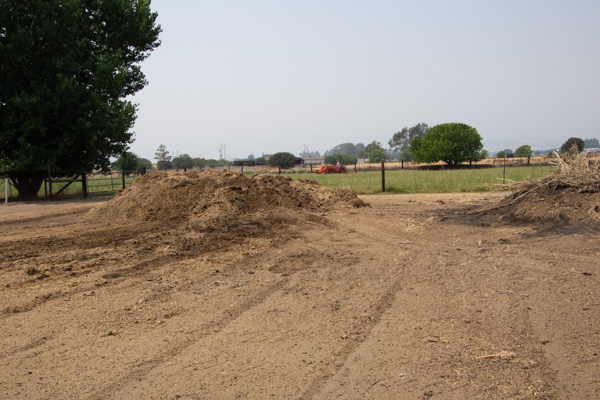
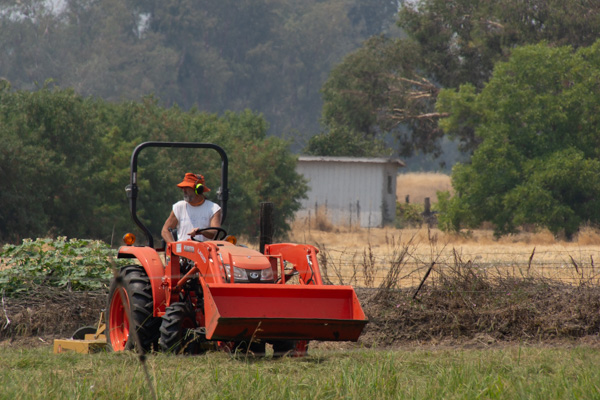 Then he mowed the most recently grazed pasture. Note hat that matches tractor. That was a belated Father's Day gift from Chris. It includes the MJ logo on top.
Then he mowed the most recently grazed pasture. Note hat that matches tractor. That was a belated Father's Day gift from Chris. It includes the MJ logo on top.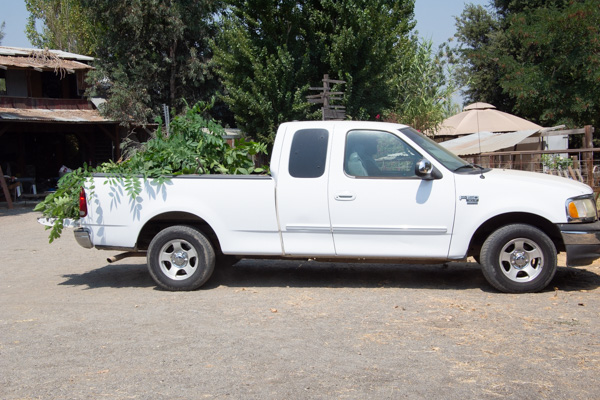 He also trimmed branches in the front so people could see our sign.
He also trimmed branches in the front so people could see our sign.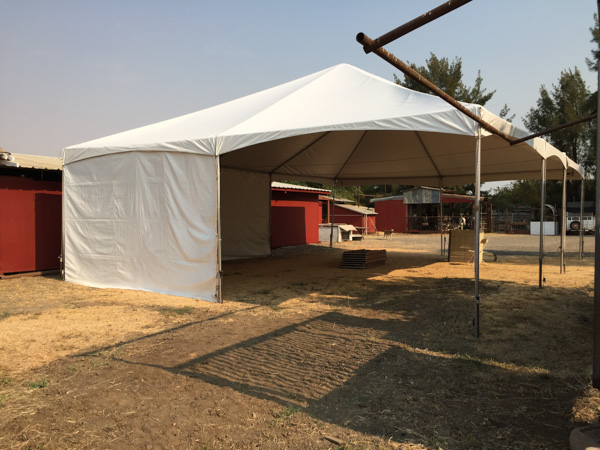 Here is the tent all set up. Note to self--when measuring for a tent remember to look up and not just measure the ground.
Here is the tent all set up. Note to self--when measuring for a tent remember to look up and not just measure the ground.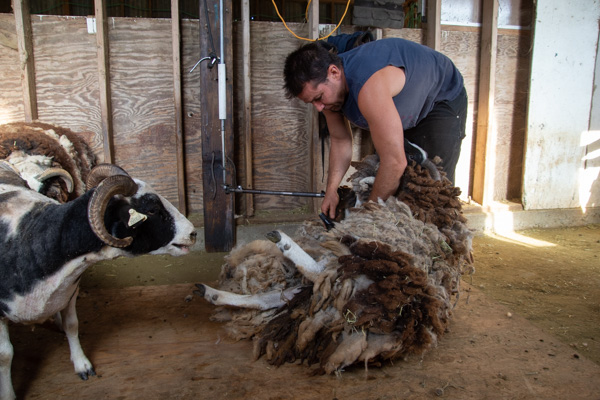
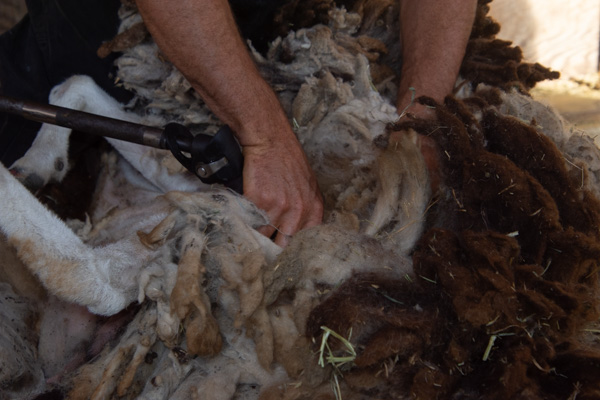
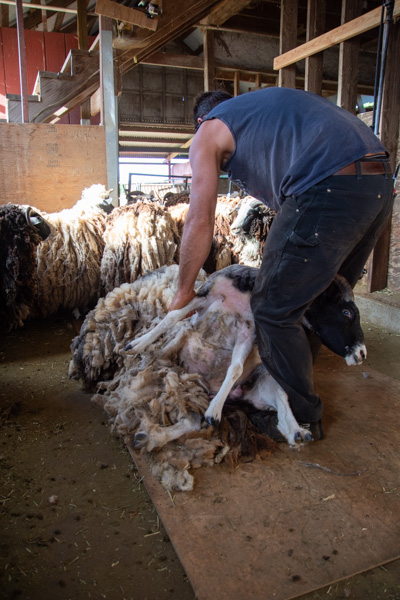
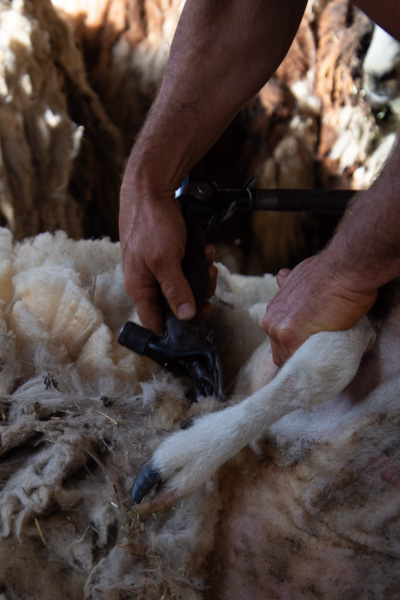
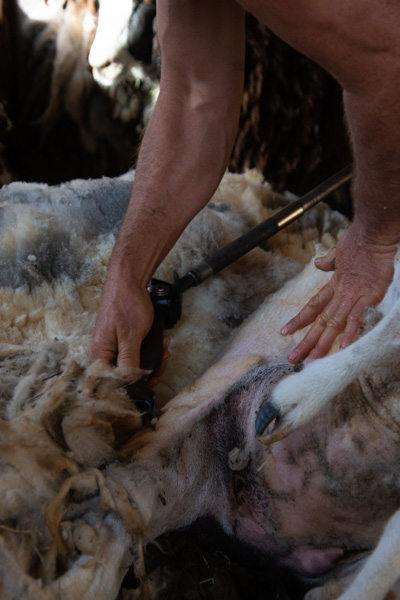
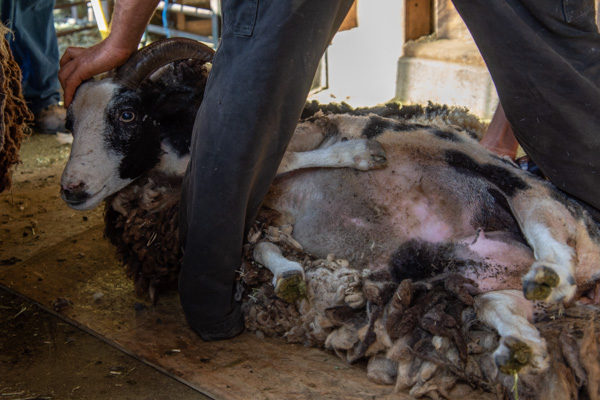
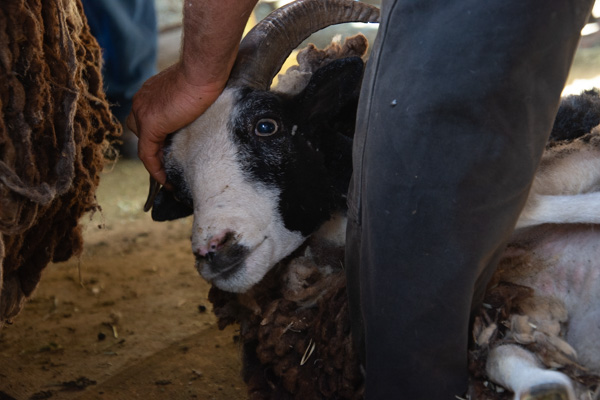
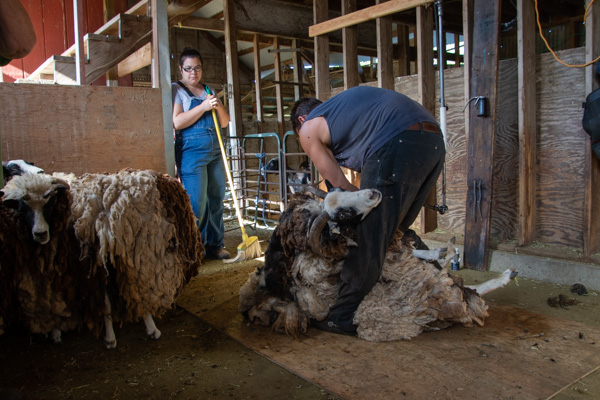
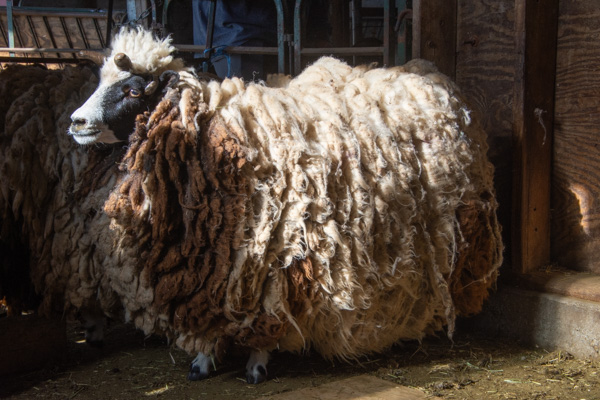
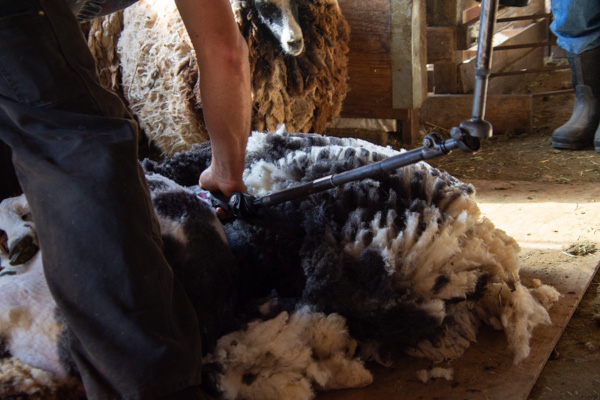
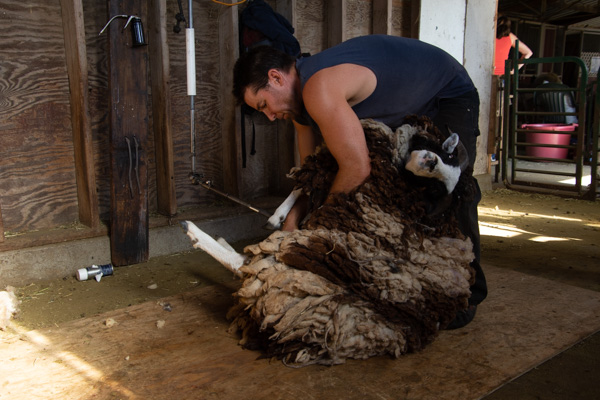
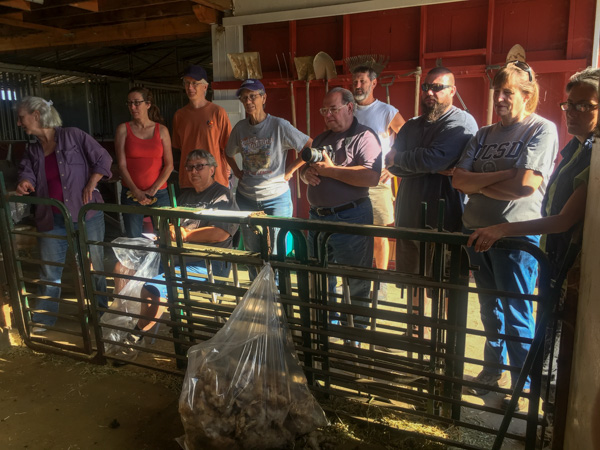
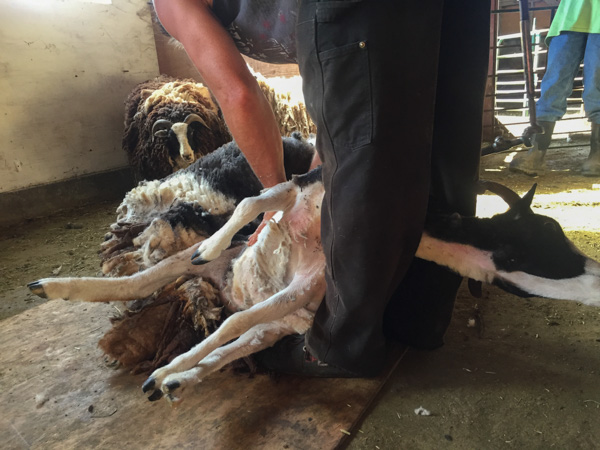
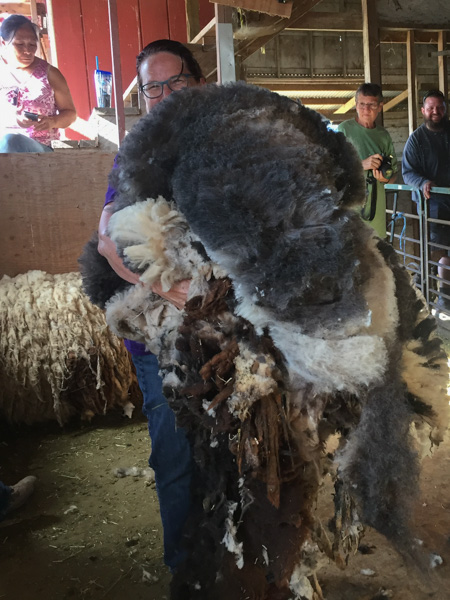
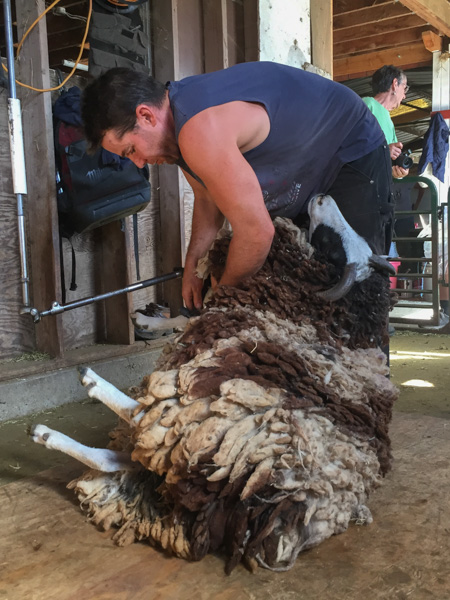
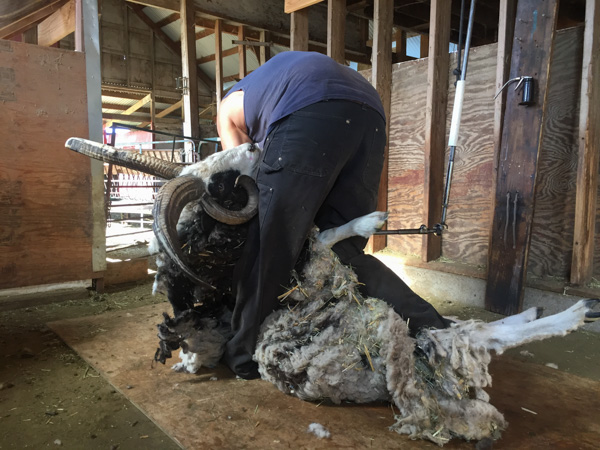
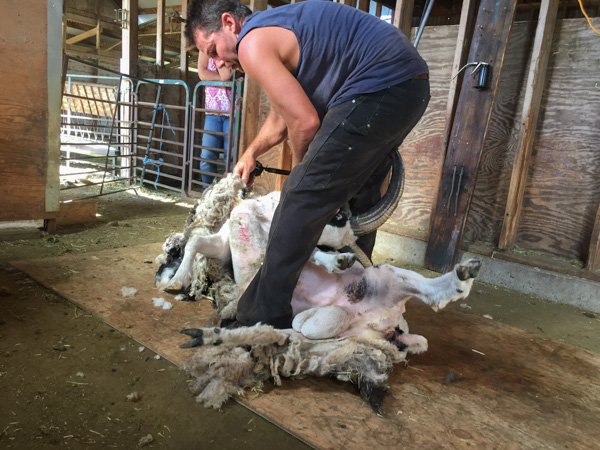
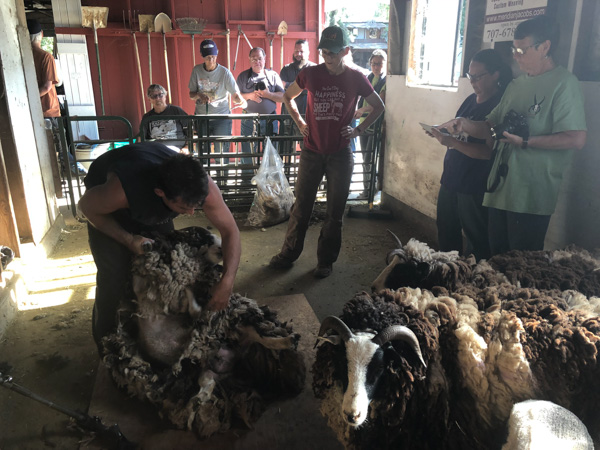 John is the Rock Star.
John is the Rock Star.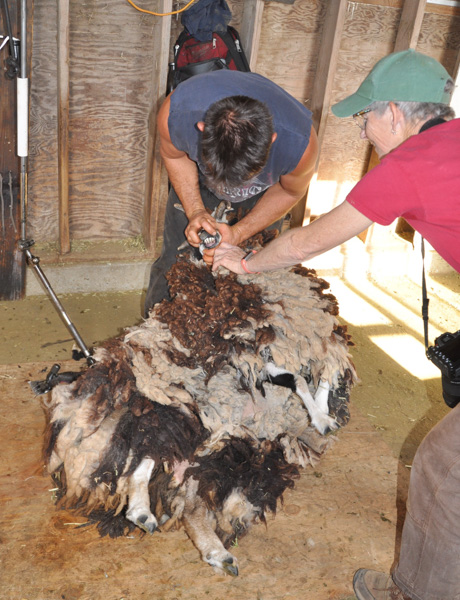 We checked teeth to try and figure out the ages of the sheep.
We checked teeth to try and figure out the ages of the sheep.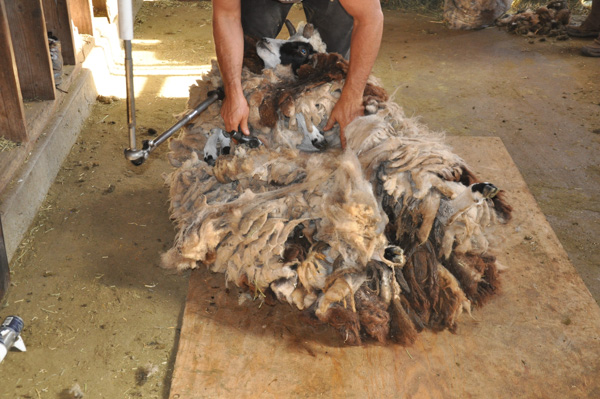 This sheep had a 13 pound fleece. The average for Jacob sheep is 3-6 pounds.
This sheep had a 13 pound fleece. The average for Jacob sheep is 3-6 pounds.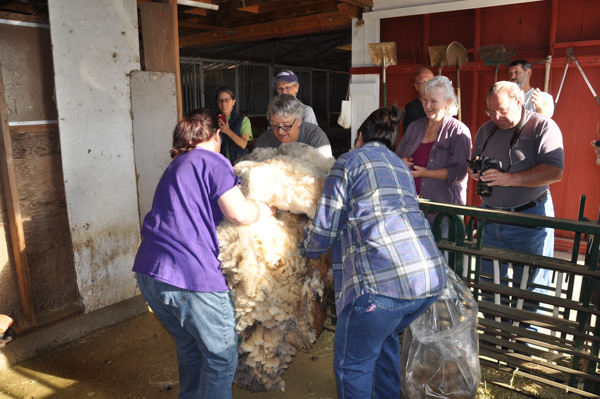 It was a multi-person operation to stuff some of these fleeces into plastic bags.
It was a multi-person operation to stuff some of these fleeces into plastic bags.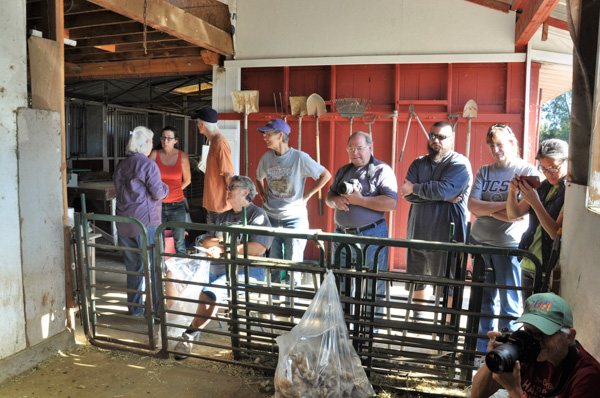 The usual suspects were there to watch and cheer John on.
The usual suspects were there to watch and cheer John on.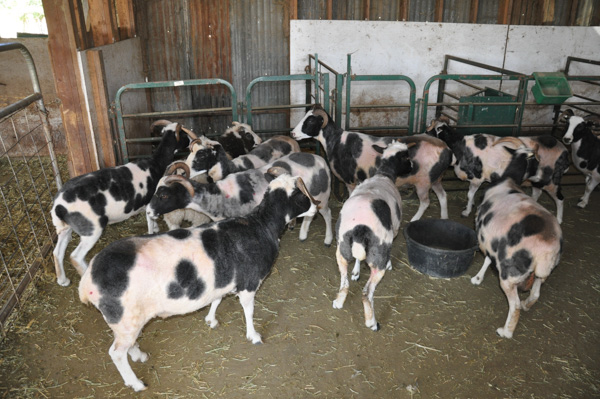 Not a bad looking group of ewes after shearing.
Not a bad looking group of ewes after shearing.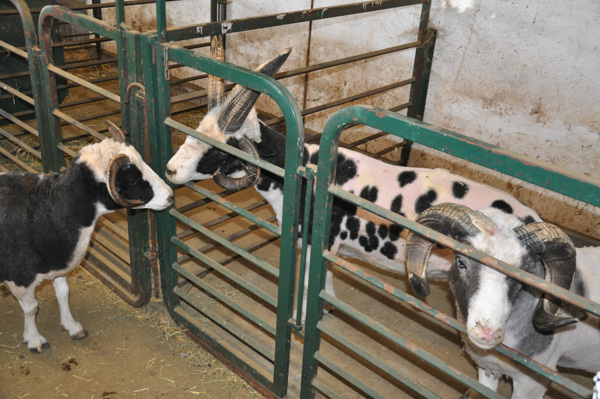 The two rams.
The two rams.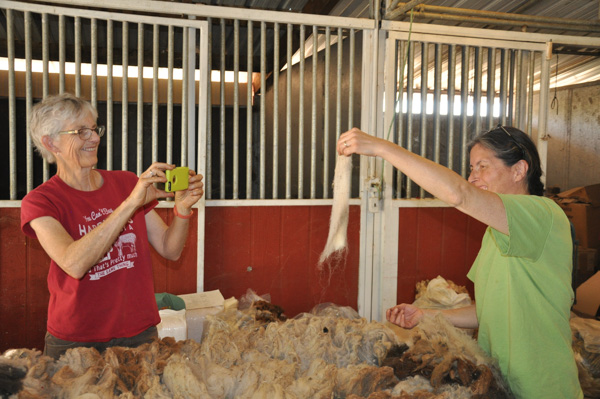 After shearing we looked at all the fleeces. The longer fleeces have a break about 4" in from the outside, but the rest of the fleece seems sound.
After shearing we looked at all the fleeces. The longer fleeces have a break about 4" in from the outside, but the rest of the fleece seems sound.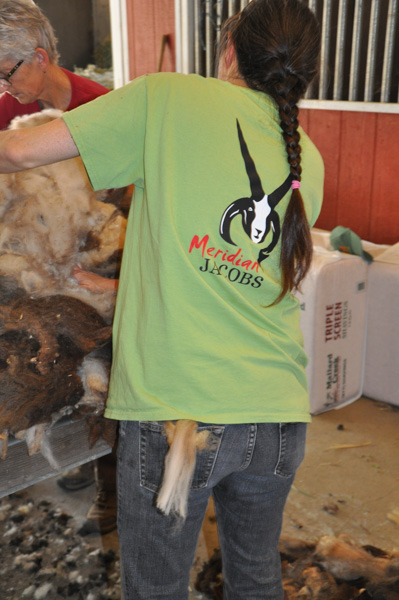 It will take some time to work through it all.
It will take some time to work through it all.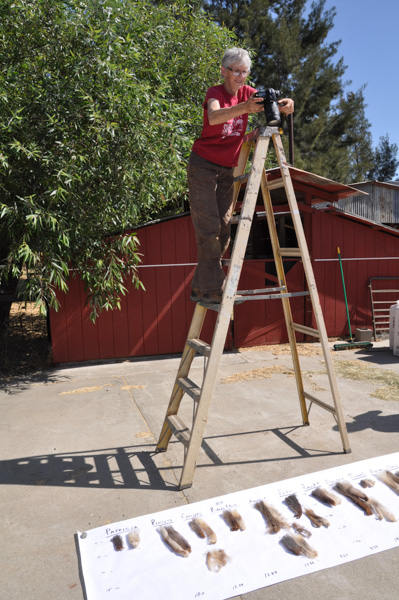 As we pulled out staples from some of the fleeces I thought it would be a good idea to get a photo. Susan and Gynna worked on this while we opened up and re-rolled the fleeces.
As we pulled out staples from some of the fleeces I thought it would be a good idea to get a photo. Susan and Gynna worked on this while we opened up and re-rolled the fleeces. Note the measurements marked on the sides and down the middles. Weights are below.
Note the measurements marked on the sides and down the middles. Weights are below. 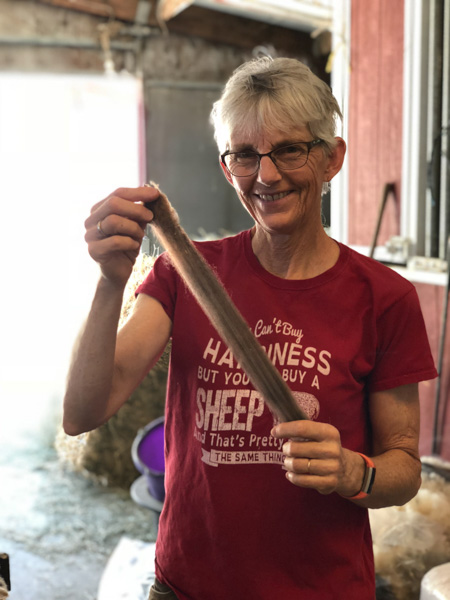 This was a fun day for all of us and a good day for these sheep.
This was a fun day for all of us and a good day for these sheep.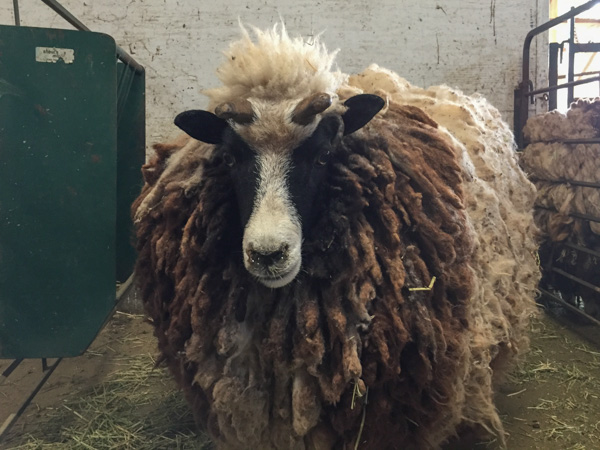 This is a ewe they called Athena.
This is a ewe they called Athena.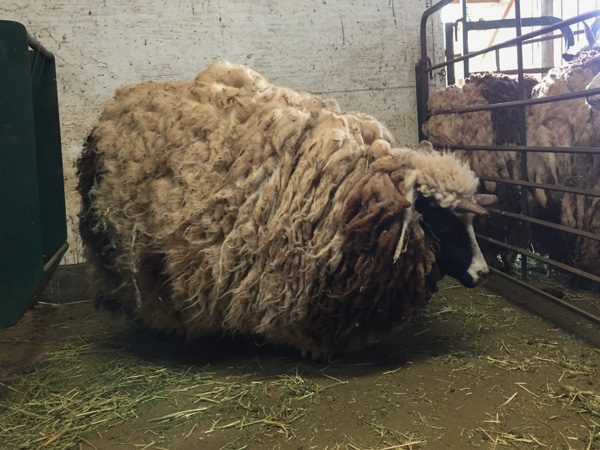
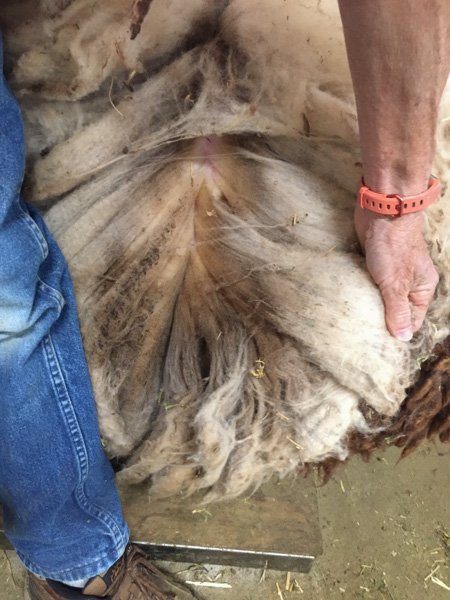 I think that this is at least a 3-year fleece.
I think that this is at least a 3-year fleece.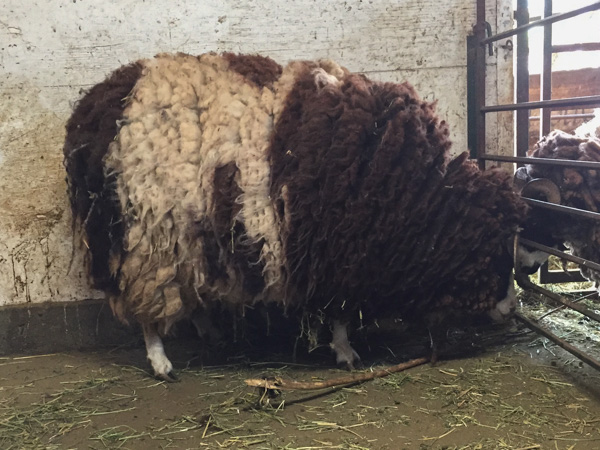 I love the markings on this ewe's body. I don't have any information about her.
I love the markings on this ewe's body. I don't have any information about her.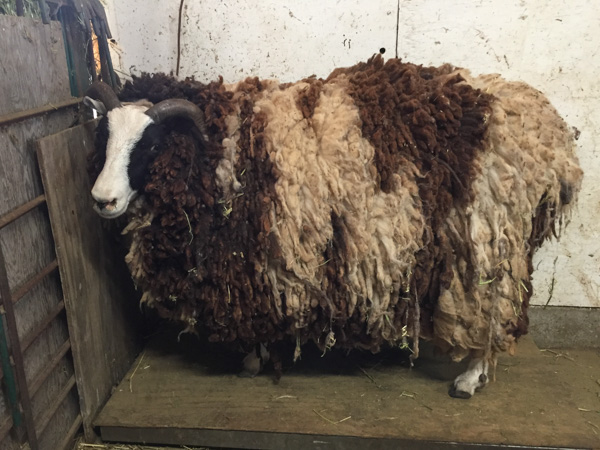 This is a ewe they called Caliope. She is pretty wild.
This is a ewe they called Caliope. She is pretty wild.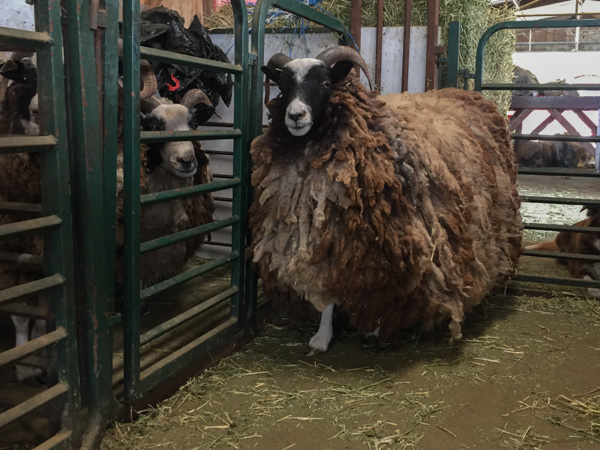
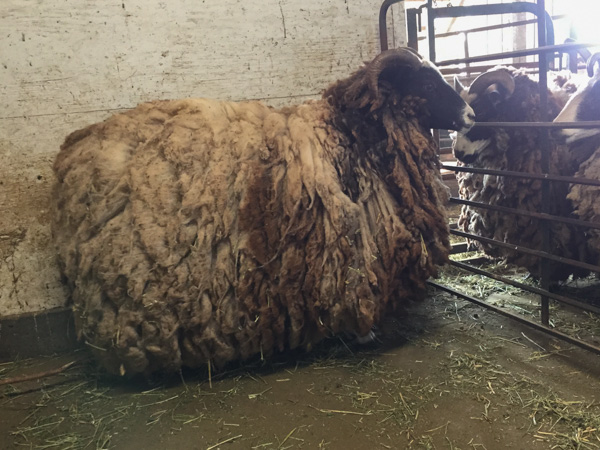
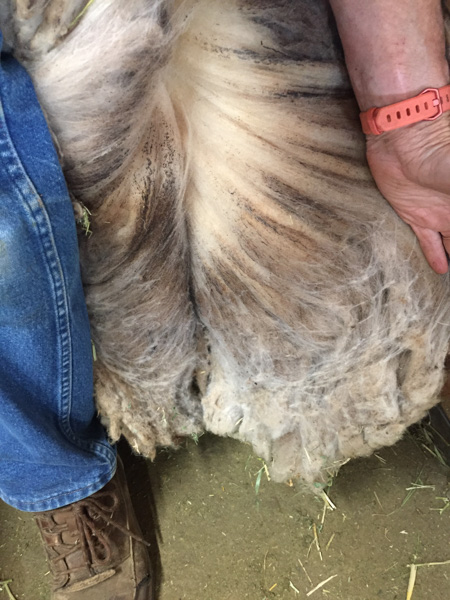
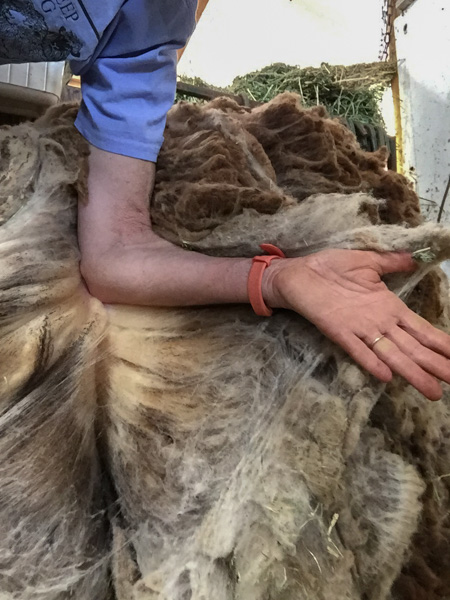
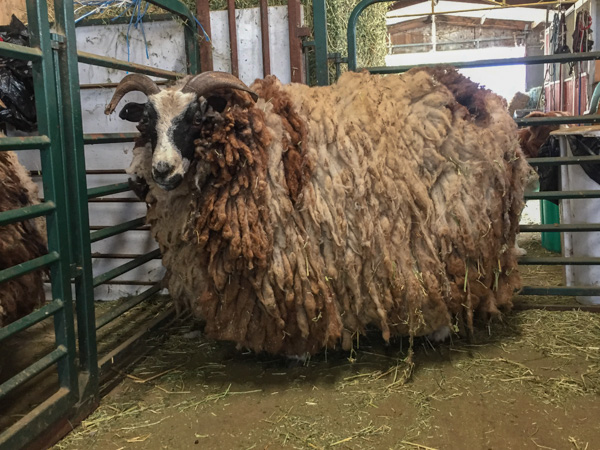 Markela, one of the original ewes purchased by this family.
Markela, one of the original ewes purchased by this family.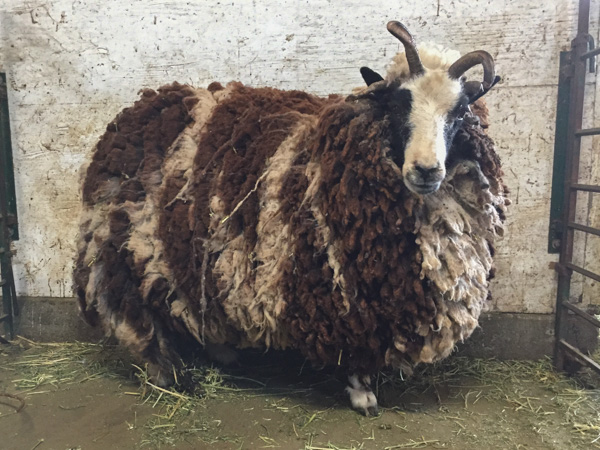 No idea about this ewe...
No idea about this ewe...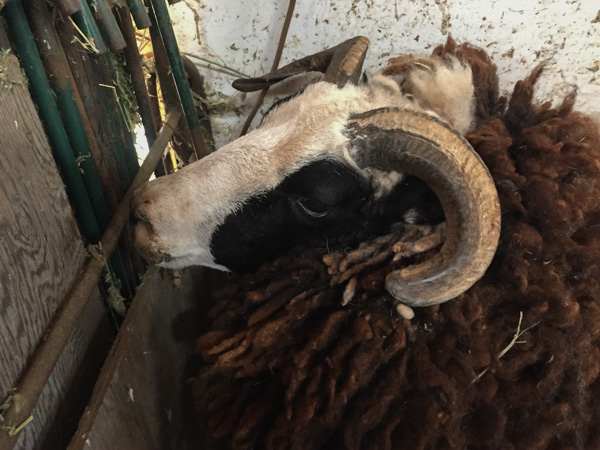 ...or this one. Don't you love her horns?
...or this one. Don't you love her horns?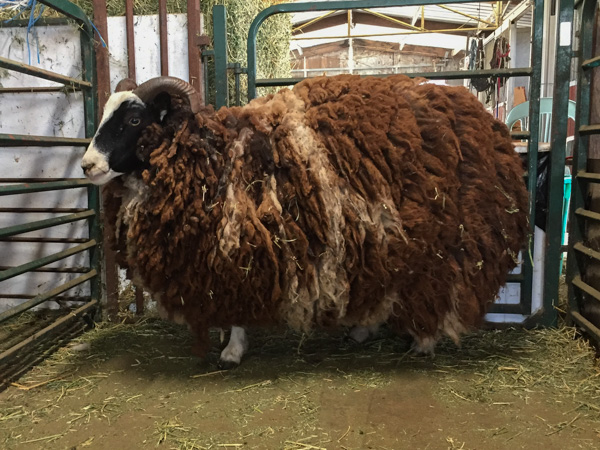 Paniota...
Paniota...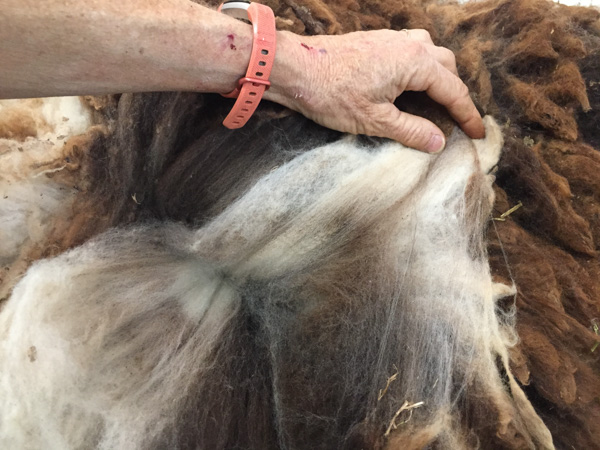 ...and her fleece.
...and her fleece.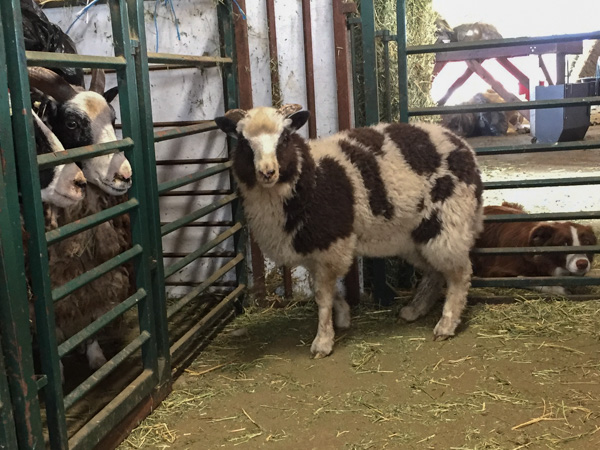 The lamb named Easter because that is when she was born.
The lamb named Easter because that is when she was born.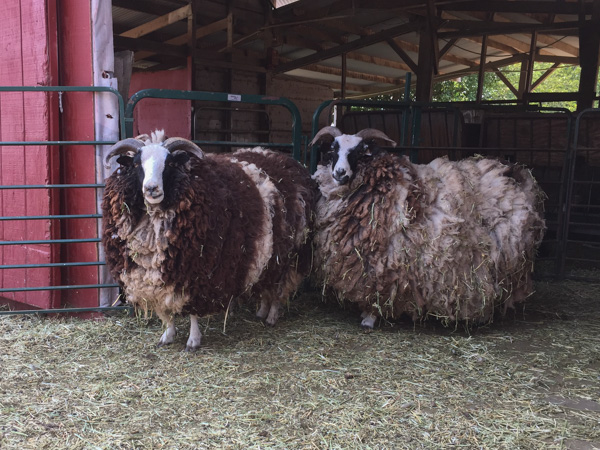 New temporary quarters.
New temporary quarters.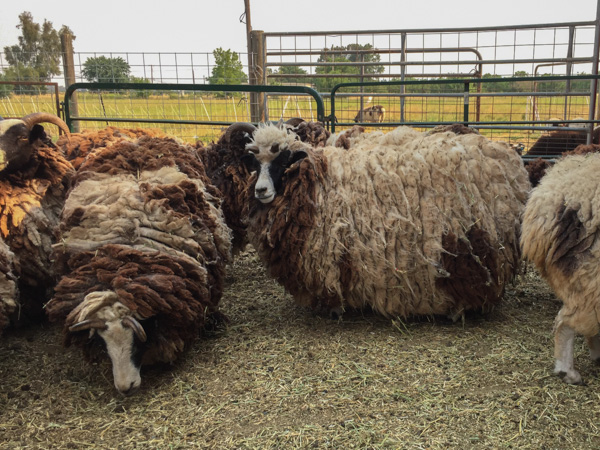 Stay tuned for a Shearing Day post.
Stay tuned for a Shearing Day post.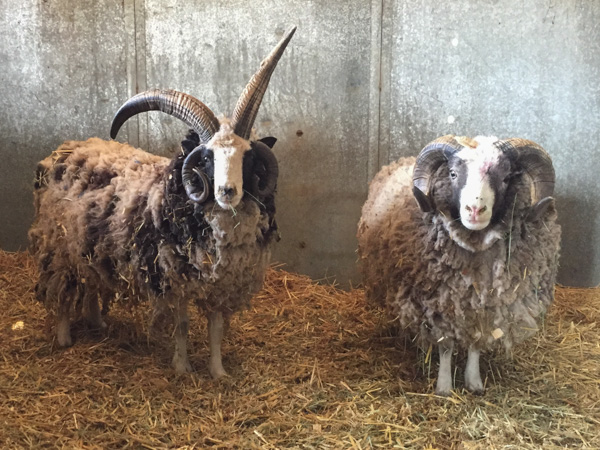 Let's not forget the rams. Tikes on the left and Costa on the right. I think they are yearlings.
Let's not forget the rams. Tikes on the left and Costa on the right. I think they are yearlings.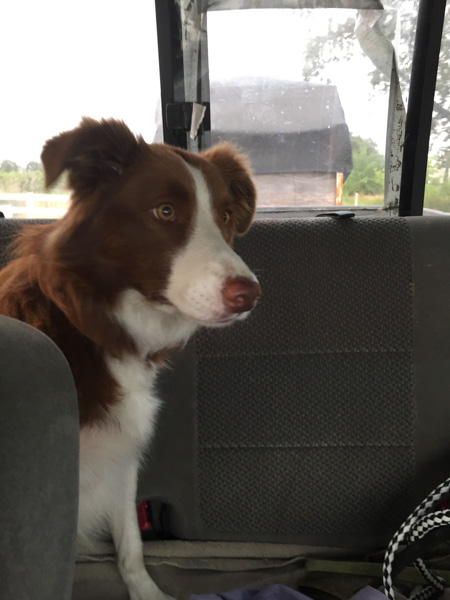 I brought Ginny because Michael had thought that we might need a dog to catch the sheep. I had my doubts that we could do much with sheep that had never been worked by a dog and were possibly wild but it was a good excuse to bring Ginny along. She is not a big fan of car rides.
I brought Ginny because Michael had thought that we might need a dog to catch the sheep. I had my doubts that we could do much with sheep that had never been worked by a dog and were possibly wild but it was a good excuse to bring Ginny along. She is not a big fan of car rides.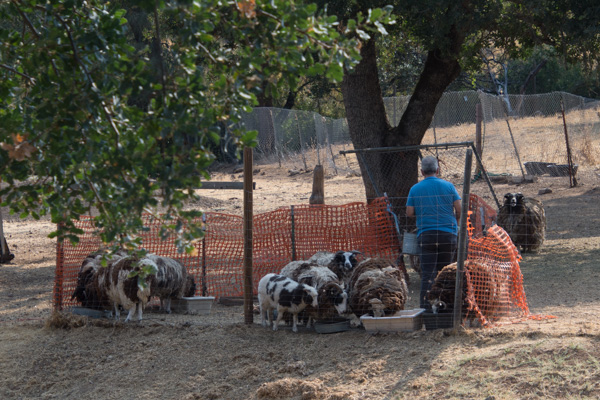 He said that he would be able to get them in the fenced in area with some grain, so we stayed out of sight while he enticed the sheep into the pen.
He said that he would be able to get them in the fenced in area with some grain, so we stayed out of sight while he enticed the sheep into the pen.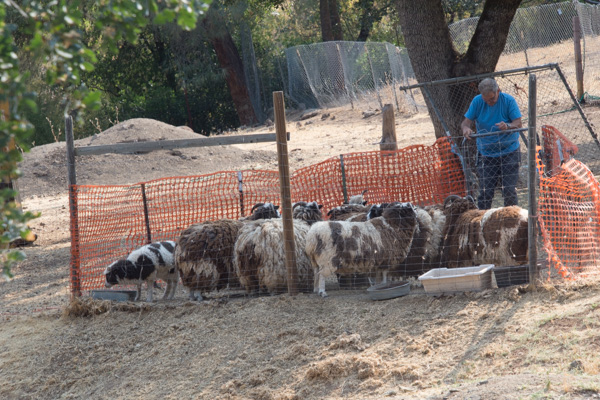 This is nine ewes and one ewe lamb. Two rams were up the hill in another area.
This is nine ewes and one ewe lamb. Two rams were up the hill in another area.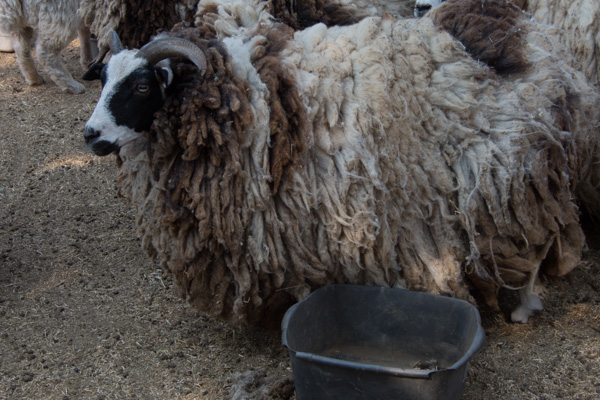 If you know anything about sheep you'll see that this ewe is way overdue for shearing.
If you know anything about sheep you'll see that this ewe is way overdue for shearing.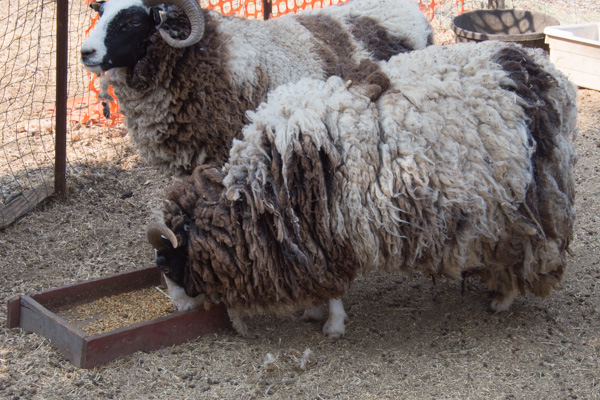 All but one were in this condition. I wonder if the ewe in full, but not horribly excessive fleece (in the back in this photo) might have had a fleece break a year or more ago, lost that fleece and now has only a year's growth.
All but one were in this condition. I wonder if the ewe in full, but not horribly excessive fleece (in the back in this photo) might have had a fleece break a year or more ago, lost that fleece and now has only a year's growth.
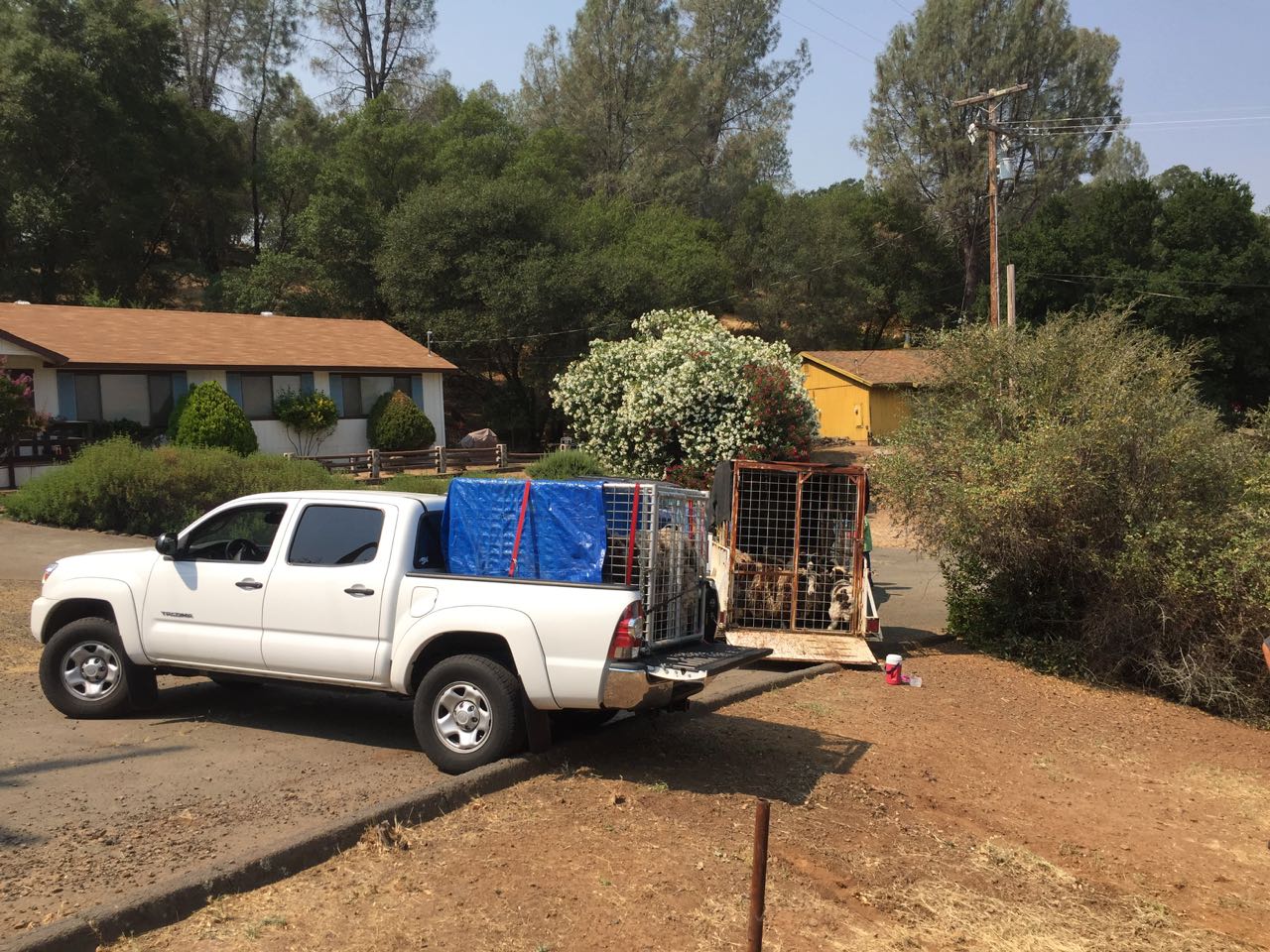 We didn't get photos of the process but we set up our panels to help catch the sheep. We put halters on the ewes two at a time and brought them to the trailer. Next we got the rams.
We didn't get photos of the process but we set up our panels to help catch the sheep. We put halters on the ewes two at a time and brought them to the trailer. Next we got the rams. 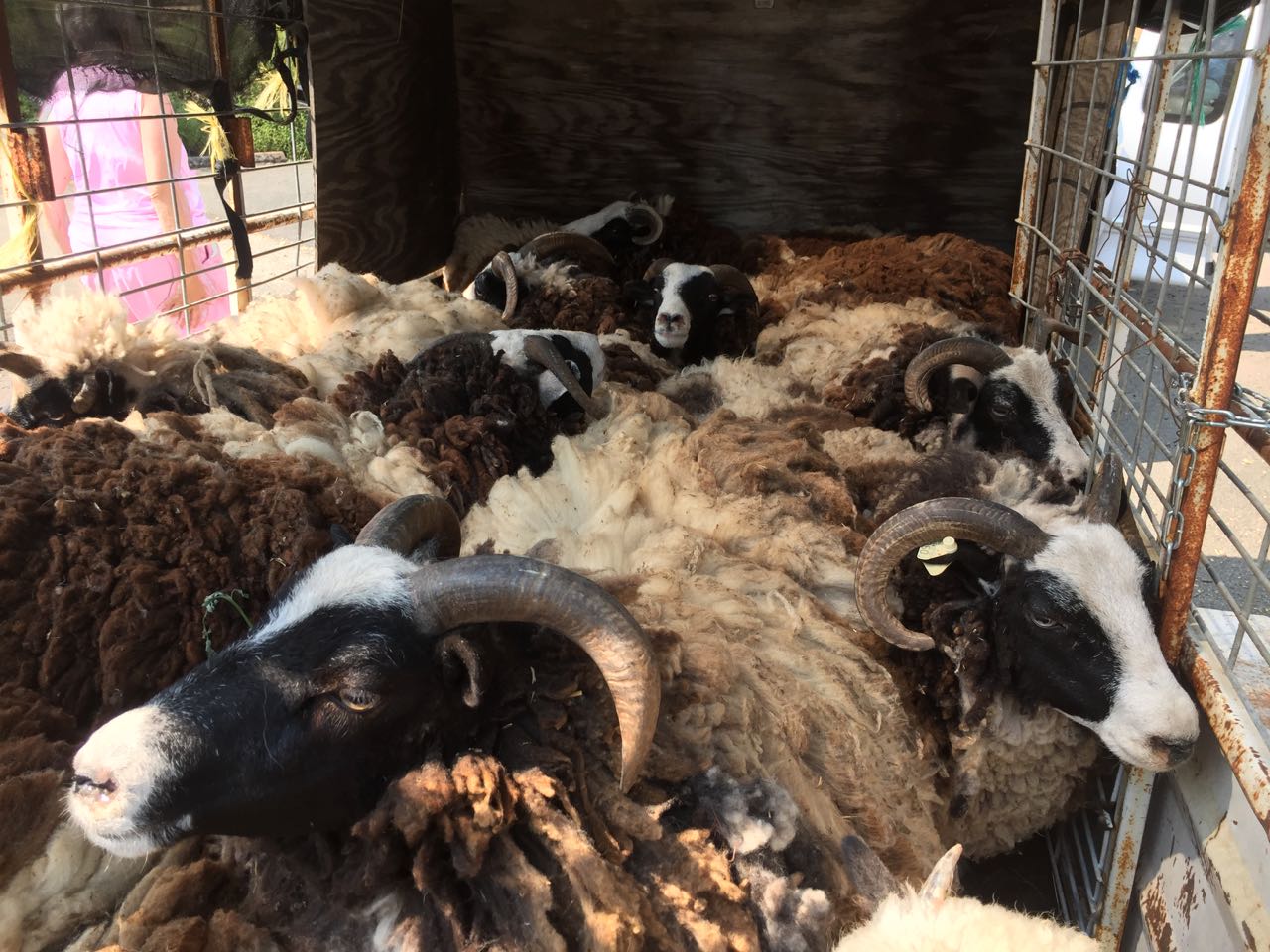 It was a tight fit for those nine adult ewes with as much fleece as probably should have been on 25 sheep.
It was a tight fit for those nine adult ewes with as much fleece as probably should have been on 25 sheep.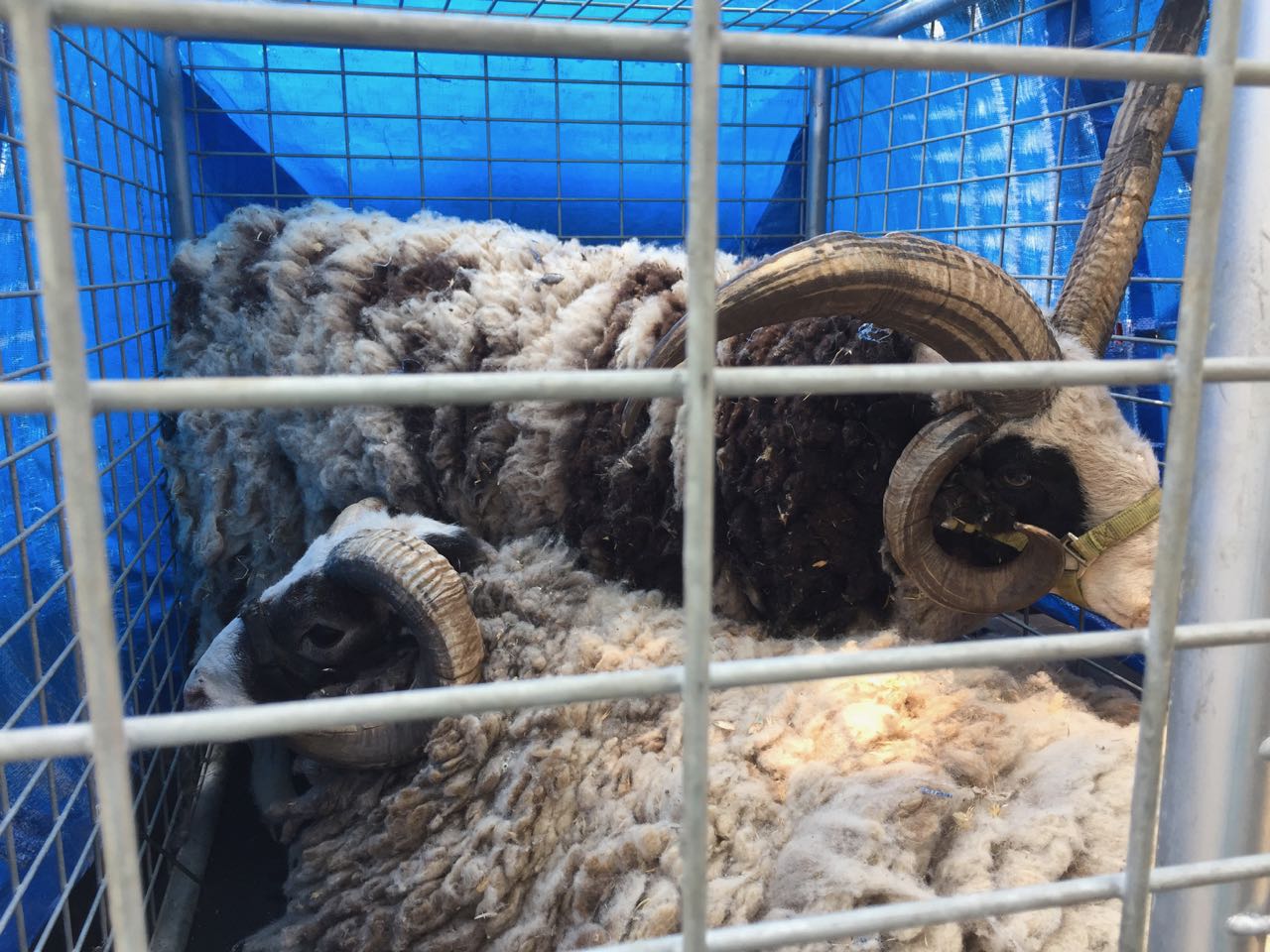 The rams weren't much better.
The rams weren't much better.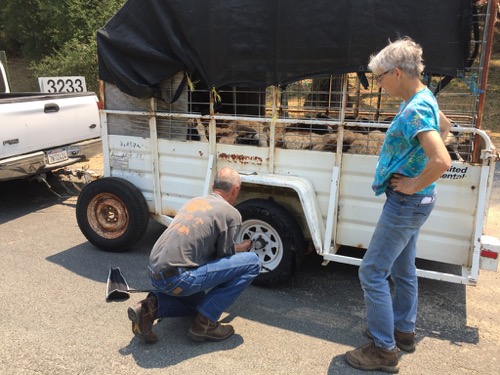 However we did have another mishap.
However we did have another mishap.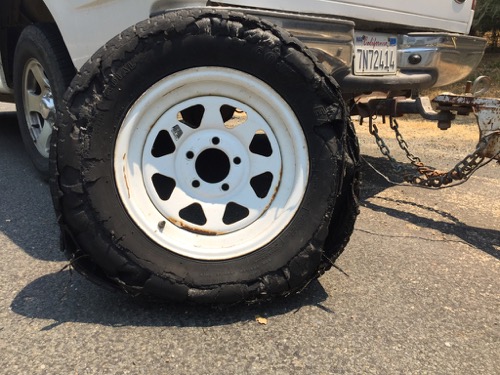 The first clue I had was the thump/thwack that I heard. Fortunately I was able to pull over in a wide driveway on this windy road (Hwy. 121) and the weather was relatively mild with a breeze because those sheep were really packed in. Fortunately Rick was there because he had the right tools in his truck -- I never did find the lug wrench in mine (although now that I think about it, maybe it was under the hood). Fortunately Rick was there to get the lug nuts off because with as much trouble as he had with the last one I'm pretty sure I wouldn't have been able to do it. I had made sure before we left that yes, I had paid the AAA membership that was due...but there was no cell service here. Rick replaced the tire with the spare and we lowered the jack. That tire was too low to drive on so Rick jacked up the trailer again, took the tire off, and left in his truck to find somewhere to fill it up. I think he was gone almost an hour before he came back with a fully inflated tire--he had found a group of fire trucks and been able to get the tire filled by the crew.
The first clue I had was the thump/thwack that I heard. Fortunately I was able to pull over in a wide driveway on this windy road (Hwy. 121) and the weather was relatively mild with a breeze because those sheep were really packed in. Fortunately Rick was there because he had the right tools in his truck -- I never did find the lug wrench in mine (although now that I think about it, maybe it was under the hood). Fortunately Rick was there to get the lug nuts off because with as much trouble as he had with the last one I'm pretty sure I wouldn't have been able to do it. I had made sure before we left that yes, I had paid the AAA membership that was due...but there was no cell service here. Rick replaced the tire with the spare and we lowered the jack. That tire was too low to drive on so Rick jacked up the trailer again, took the tire off, and left in his truck to find somewhere to fill it up. I think he was gone almost an hour before he came back with a fully inflated tire--he had found a group of fire trucks and been able to get the tire filled by the crew.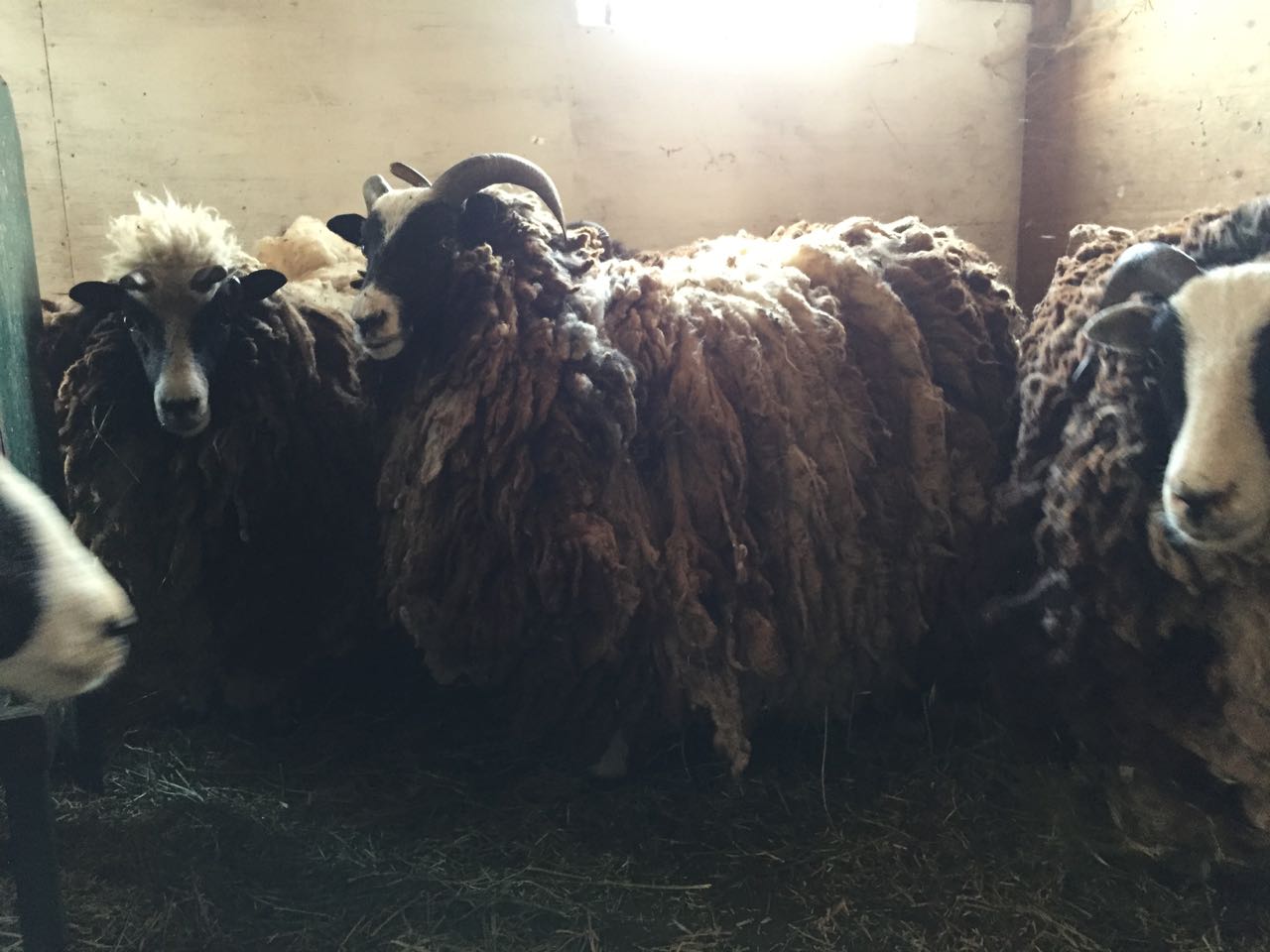 After getting our hands on these sheep I think that they are in surprisingly good health. They seem to be in decent condition under all that wool and from their teeth I think that they are all four years or under.
After getting our hands on these sheep I think that they are in surprisingly good health. They seem to be in decent condition under all that wool and from their teeth I think that they are all four years or under.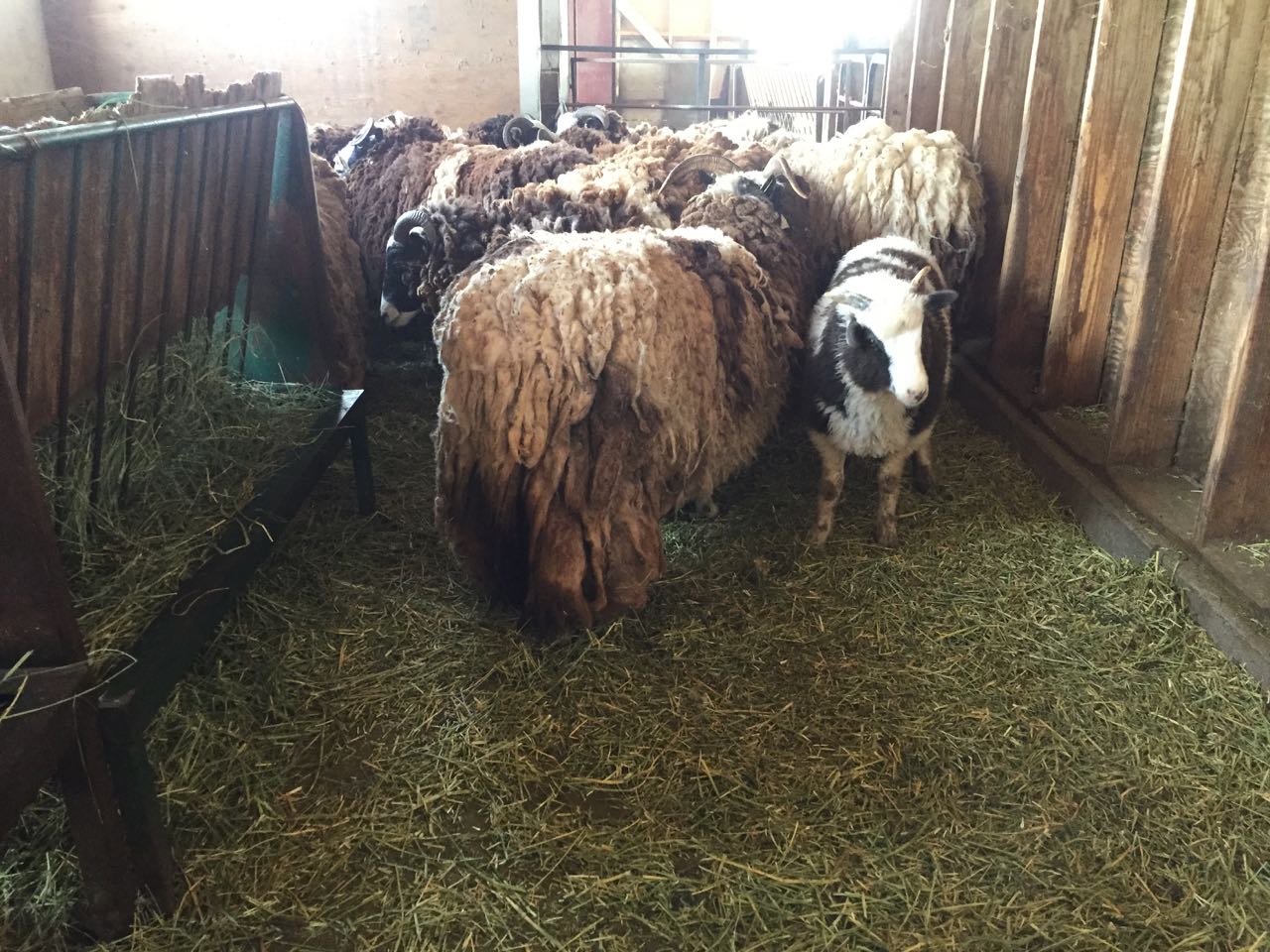 There are two with ear tags that indicate a friend's flock. Those two are docked. None of the others are docked and I think that all of those descended from those two and maybe another that I was told had died. I don't think that any of those born at this place have ever been shorn. So that's our first order of business--to find a shearer. Then Dona and I will figure out the next steps.
There are two with ear tags that indicate a friend's flock. Those two are docked. None of the others are docked and I think that all of those descended from those two and maybe another that I was told had died. I don't think that any of those born at this place have ever been shorn. So that's our first order of business--to find a shearer. Then Dona and I will figure out the next steps.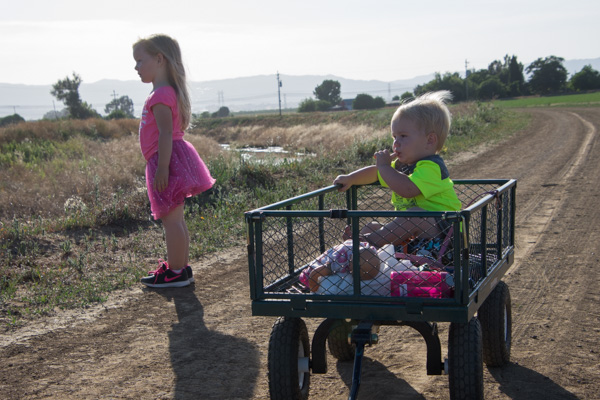 The wagon worked well for Kasen and had the added benefit of taking all the necessary things like water bottles and the doll.
The wagon worked well for Kasen and had the added benefit of taking all the necessary things like water bottles and the doll.
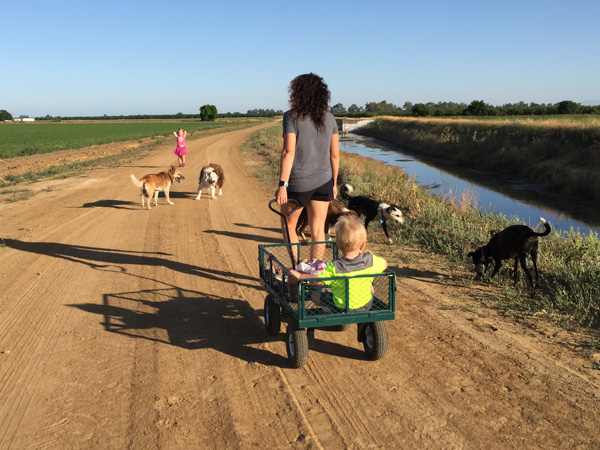 Meryl and I traded off with the wagon, but part of the point of this walk was for Kirby, wearing her black and pink Nikes, to run with Aunt Meryl.
Meryl and I traded off with the wagon, but part of the point of this walk was for Kirby, wearing her black and pink Nikes, to run with Aunt Meryl.




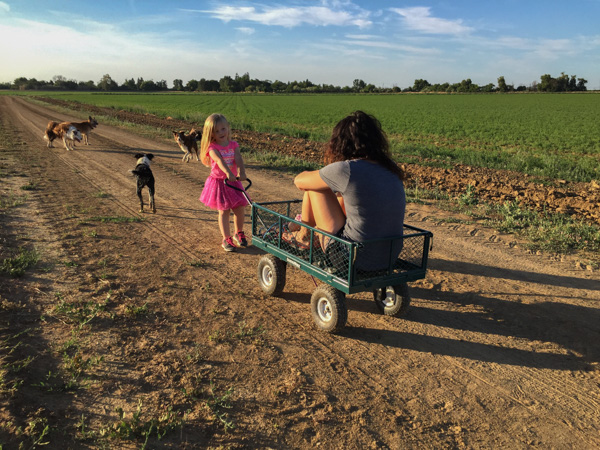 Eventually Aunt Meryl tired and needed a ride.
Eventually Aunt Meryl tired and needed a ride.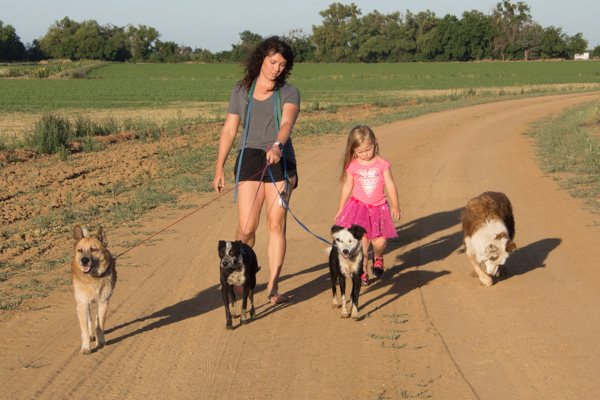 Time to go home. Kirby started to pout because she wanted Sawyer's leash.
Time to go home. Kirby started to pout because she wanted Sawyer's leash.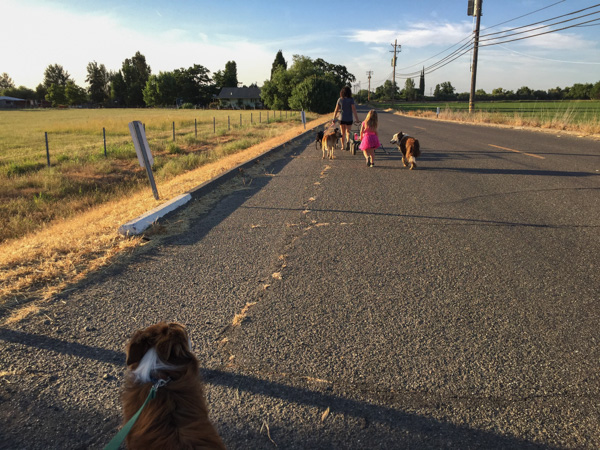 I let her take Rusty and all was OK.
I let her take Rusty and all was OK.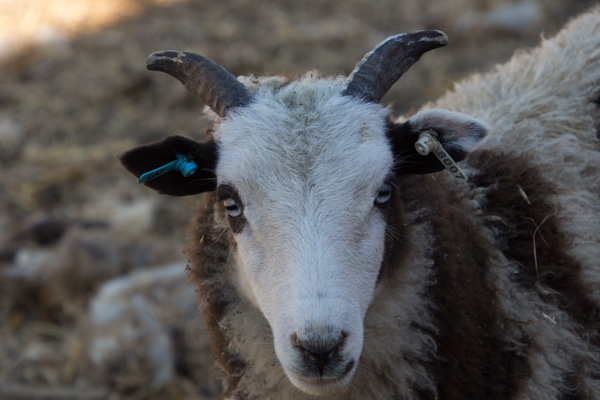 Meridian Sharon (Meridian Catalyst x Shadow Mountain Shelby).
Meridian Sharon (Meridian Catalyst x Shadow Mountain Shelby).
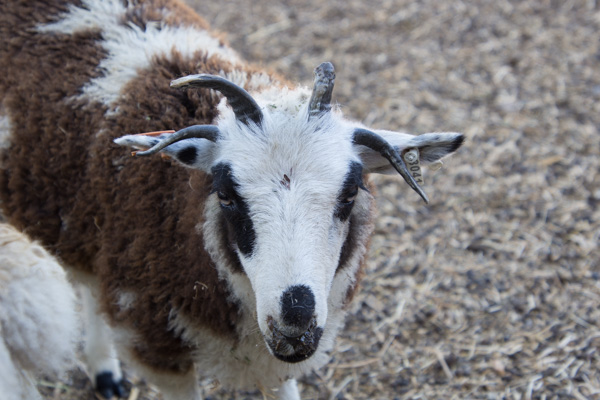 Meridian Ruthie (Meridian Cayenne x Meridian Ruth
Meridian Ruthie (Meridian Cayenne x Meridian Ruth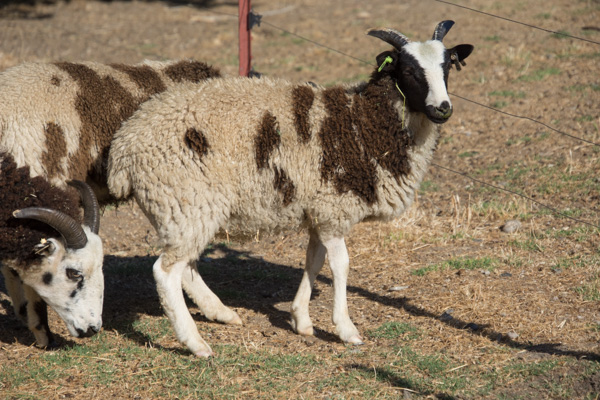 Meridian Soprano (bide a wee Buster x Meridian Sonata).
Meridian Soprano (bide a wee Buster x Meridian Sonata). 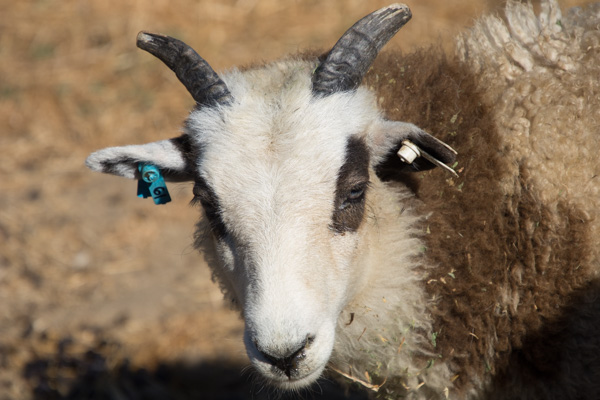 Meridian Fauna (Meridian Catalyst x Mud Ranch's Foxglove)
Meridian Fauna (Meridian Catalyst x Mud Ranch's Foxglove)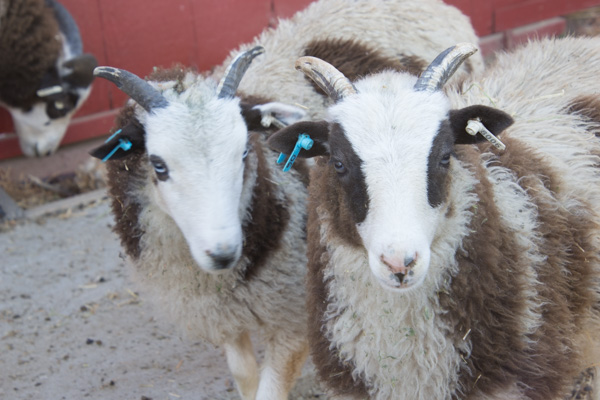 Here is Meridian Sharon on the left and Meridian Shirley on the right. (Meridian Catalyst x Shadow Mountain Shelby)
Here is Meridian Sharon on the left and Meridian Shirley on the right. (Meridian Catalyst x Shadow Mountain Shelby)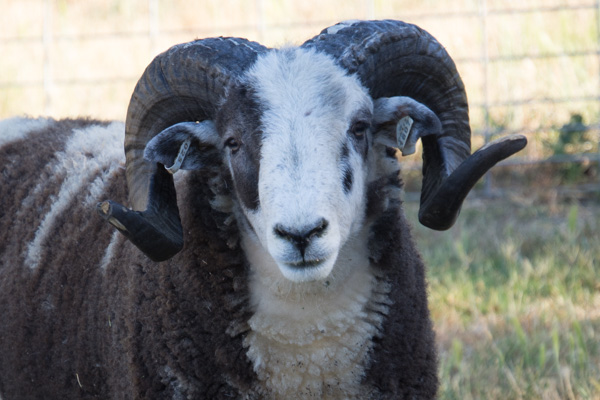 This is the yearling ram, Cayenne. He is not for sale.
This is the yearling ram, Cayenne. He is not for sale.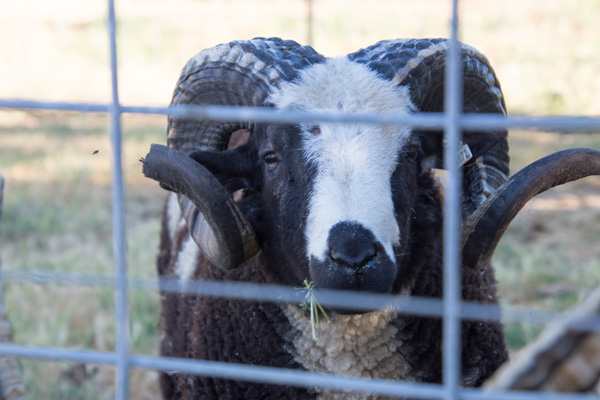 Yearling ram, Gotham, is for sale.
Yearling ram, Gotham, is for sale.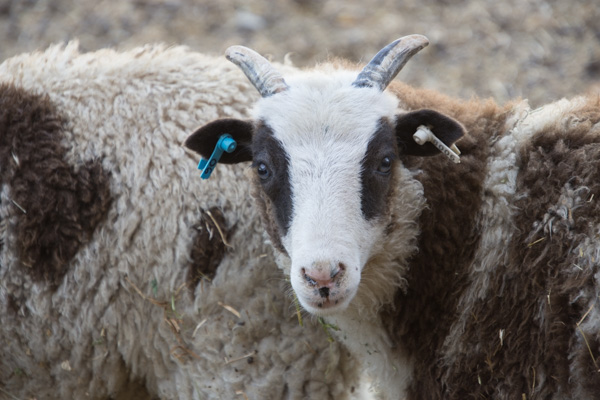 Ewe lamb (Meridian Catalyst x Shadow Mountain Shelby).
Ewe lamb (Meridian Catalyst x Shadow Mountain Shelby).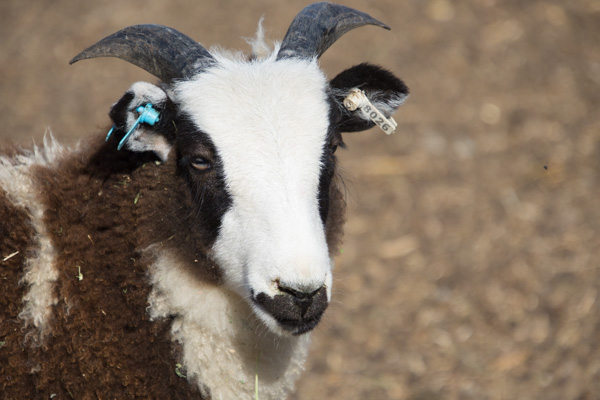 Ewe lamb (Meridian Catalyst x Meridian Delight).
Ewe lamb (Meridian Catalyst x Meridian Delight).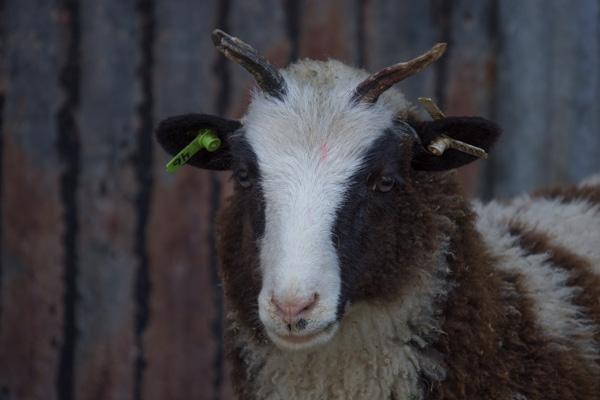 Ewe lamb (bide a wee Buster x bide a wee Hallie).
Ewe lamb (bide a wee Buster x bide a wee Hallie).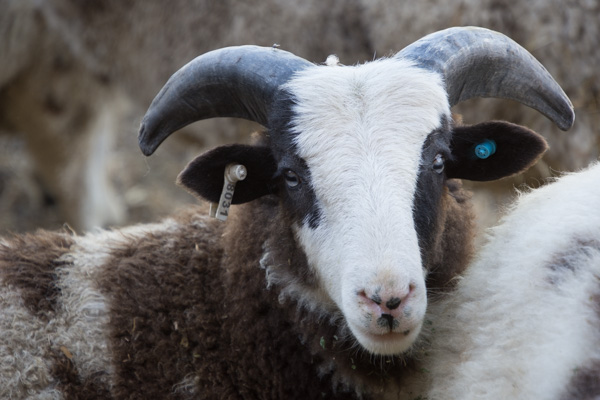 Ram lamb (Meridian Catalyst x Meridian Ava).
Ram lamb (Meridian Catalyst x Meridian Ava).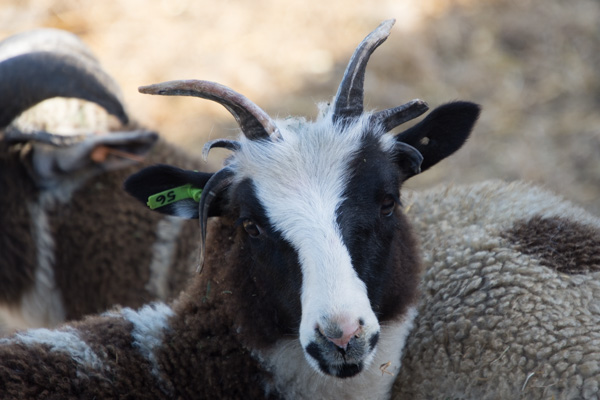 Six-horn ewe lamb not for sale (bide a wee Buster x Meridian Jade).
Six-horn ewe lamb not for sale (bide a wee Buster x Meridian Jade). 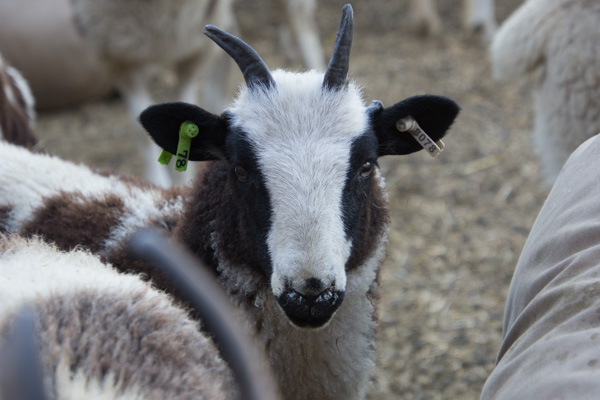 Four-horn ewe lamb, Janna, not for sale (bide a wee Buster x Meridian Janis)
Four-horn ewe lamb, Janna, not for sale (bide a wee Buster x Meridian Janis)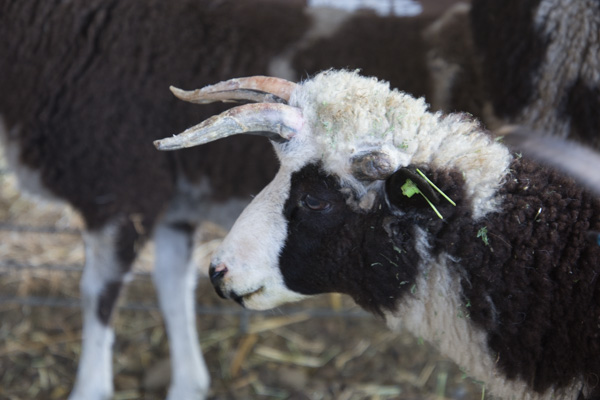 Oops! For sale, but not for breeding. Ugly-horned ram lamb. If you're interested in lambs for meat see
Oops! For sale, but not for breeding. Ugly-horned ram lamb. If you're interested in lambs for meat see 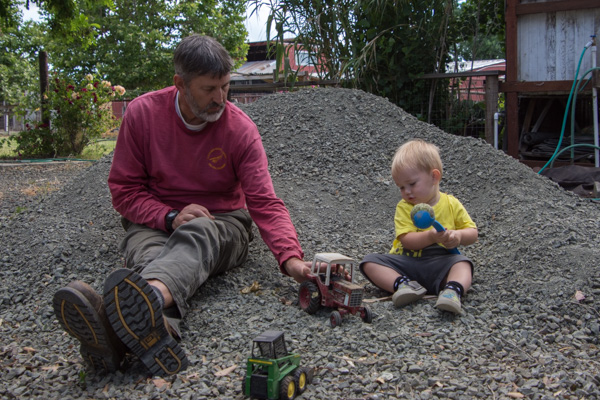 What better place to entertain an 18-month old than a gravel pile with tractors?
What better place to entertain an 18-month old than a gravel pile with tractors? 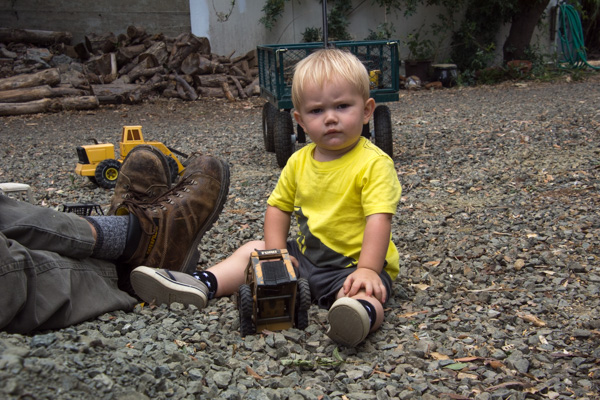 These trucks and tractors have been in the garage for 25+ years
These trucks and tractors have been in the garage for 25+ years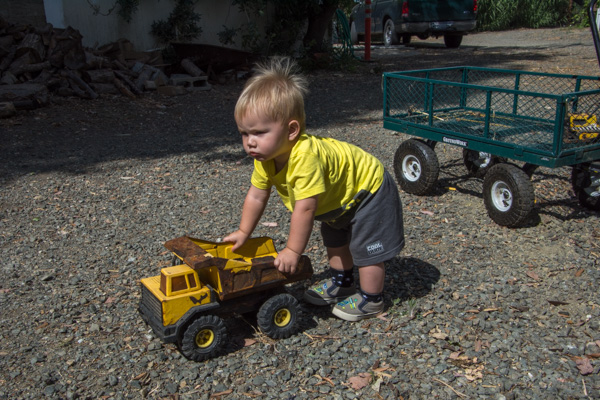 Hose off the spiders and they're as good as new.
Hose off the spiders and they're as good as new.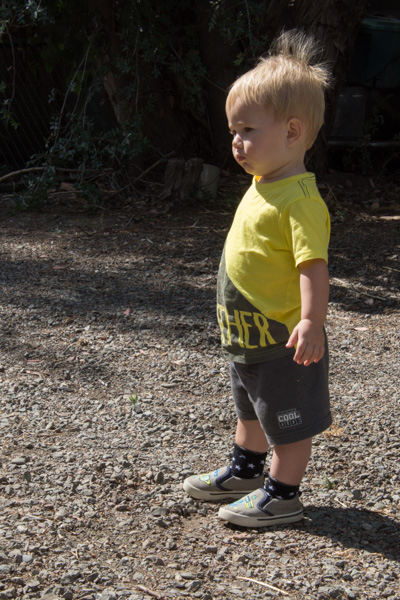
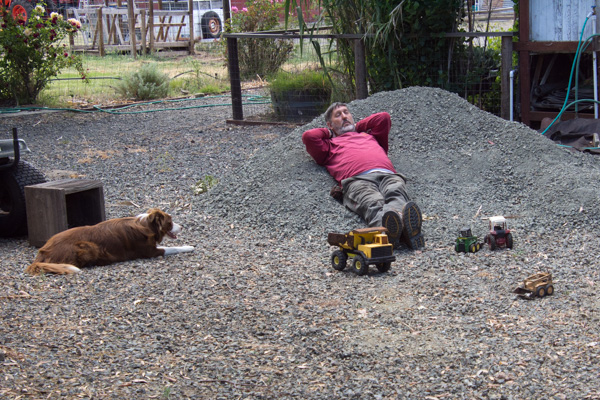 Watching kids can be exhausting. Notice what Ginny is looking at--that's her ball right next to Dan.
Watching kids can be exhausting. Notice what Ginny is looking at--that's her ball right next to Dan.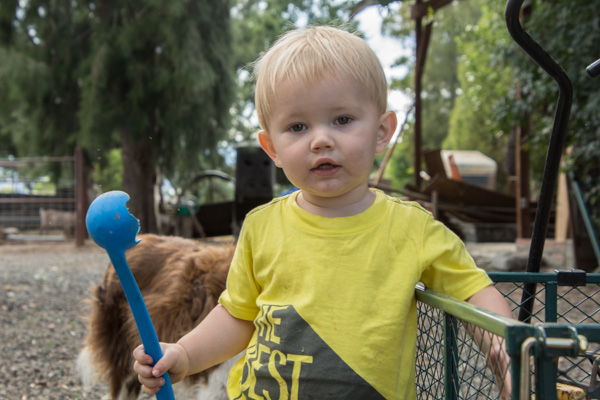 Kasen found the ball-thrower.
Kasen found the ball-thrower.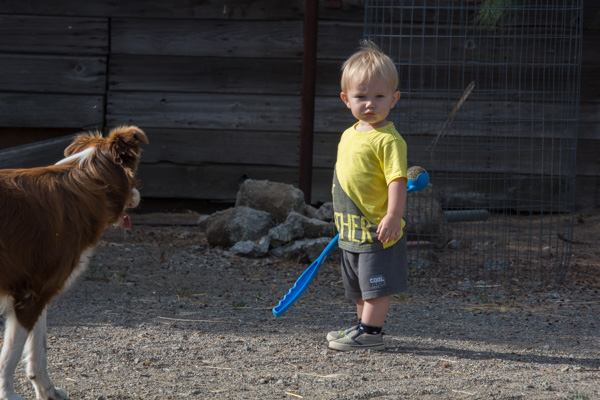 That kept Ginny entertained even though Kasen wasn't able to throw the ball very well.
That kept Ginny entertained even though Kasen wasn't able to throw the ball very well. 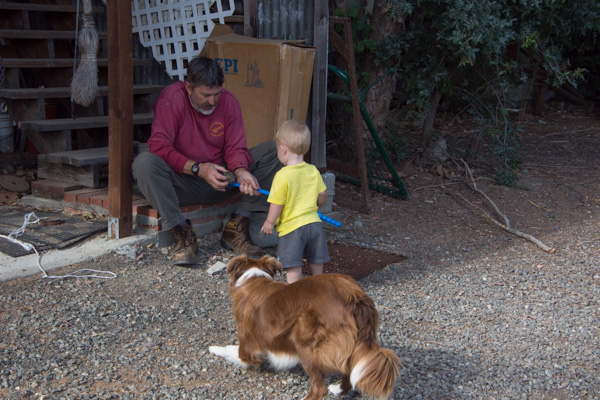 See
See 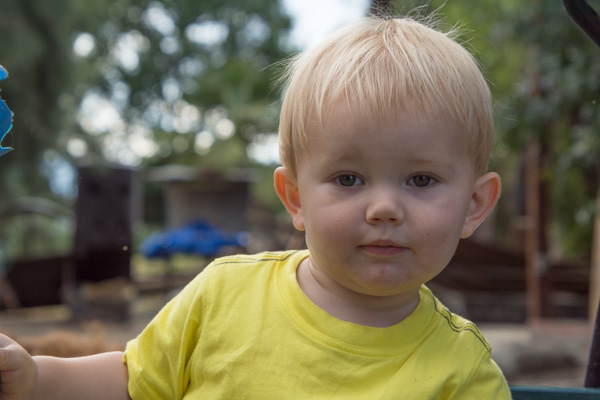
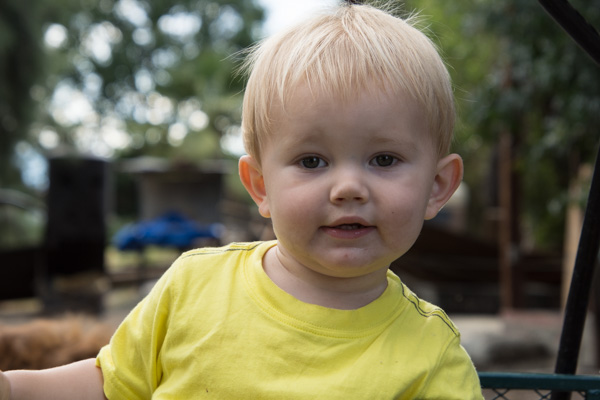
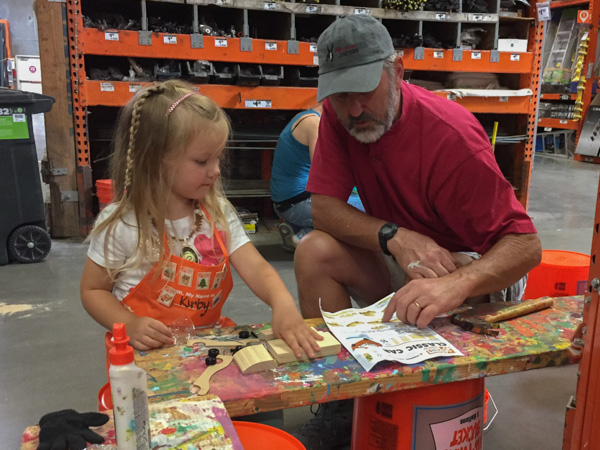 The kids have aprons and they get badges for all the projects they complete.
The kids have aprons and they get badges for all the projects they complete.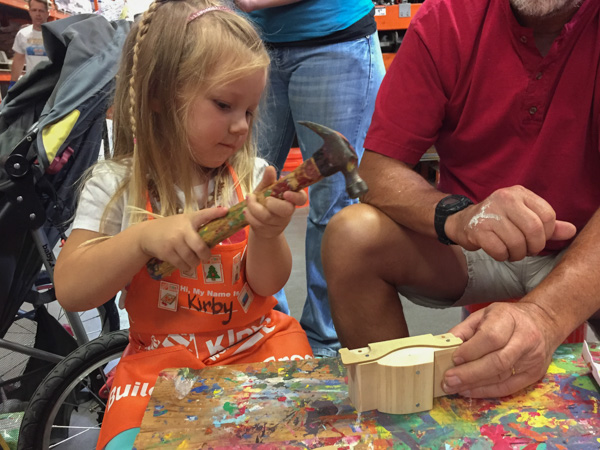 This month's project was a wooden car. Dan started the nails for Kirby and she finished the pounding.
This month's project was a wooden car. Dan started the nails for Kirby and she finished the pounding.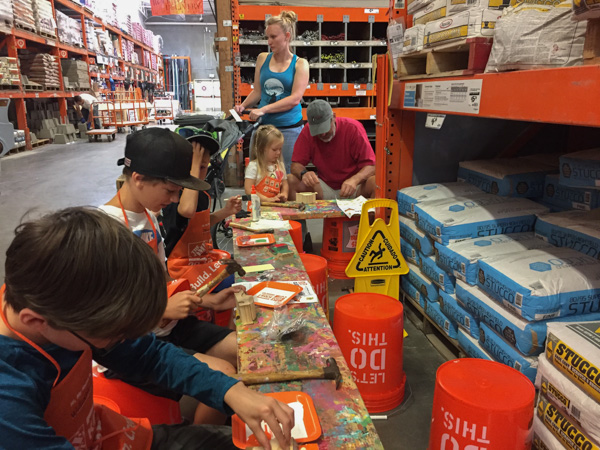 There are kids lined up all along the "tables" made of boards and buckets.
There are kids lined up all along the "tables" made of boards and buckets.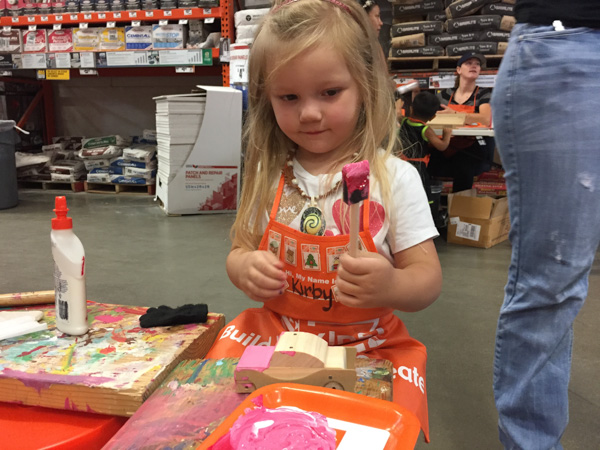 Katie said that Kirby often likes the painting part more than the building part.
Katie said that Kirby often likes the painting part more than the building part. 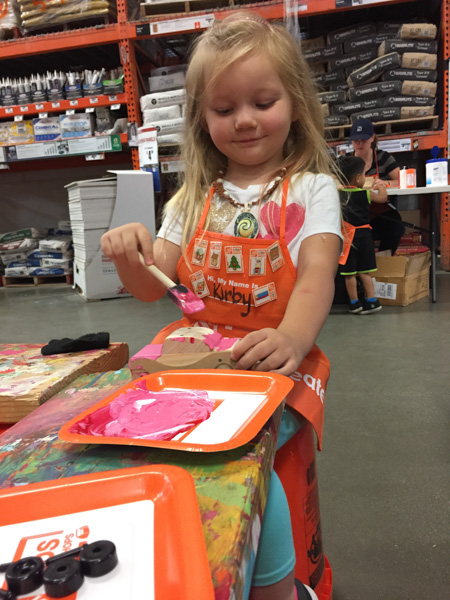 Pink was not one of the colors that was offered but we all know what you get when you mix red and white.
Pink was not one of the colors that was offered but we all know what you get when you mix red and white.
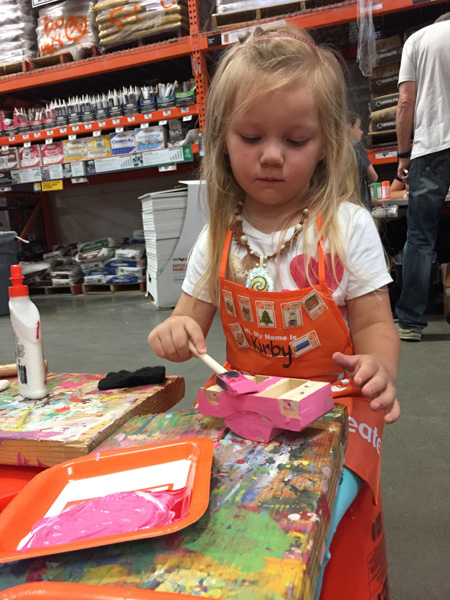 Kirby was through enough to want to paint the bottom of the car too.
Kirby was through enough to want to paint the bottom of the car too.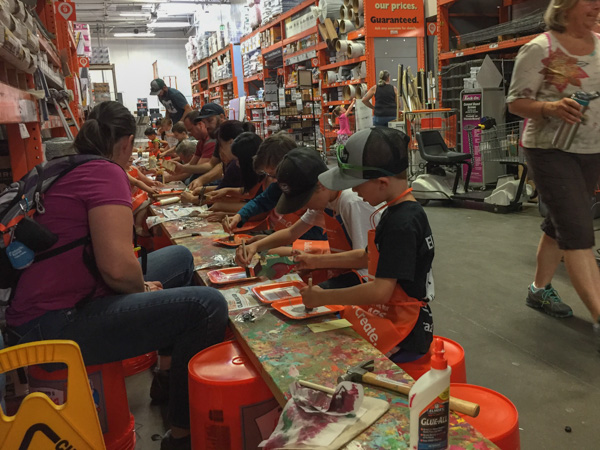 This activity goes on all morning. While we waited for the paint on Kirby's car to dry we walked around the garden part of the store and looked at flowers.
This activity goes on all morning. While we waited for the paint on Kirby's car to dry we walked around the garden part of the store and looked at flowers.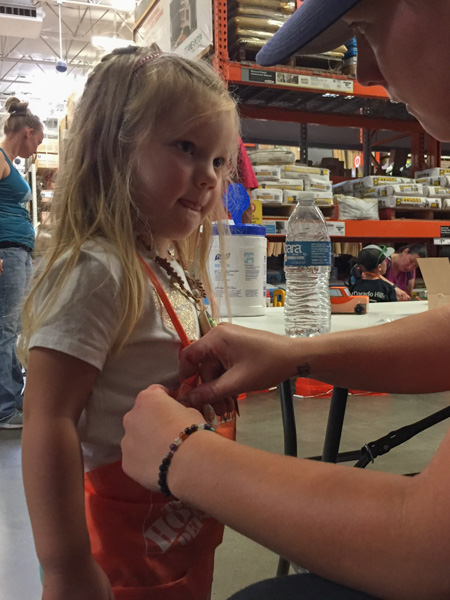 Kirby came back for her badge.
Kirby came back for her badge.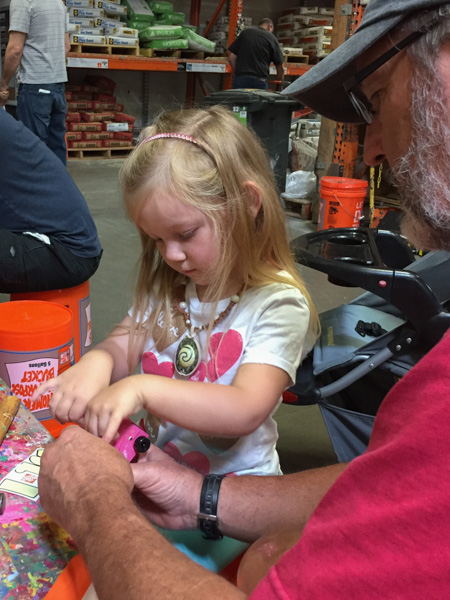 Then it was time to put the wheels and the stickers on the car.
Then it was time to put the wheels and the stickers on the car.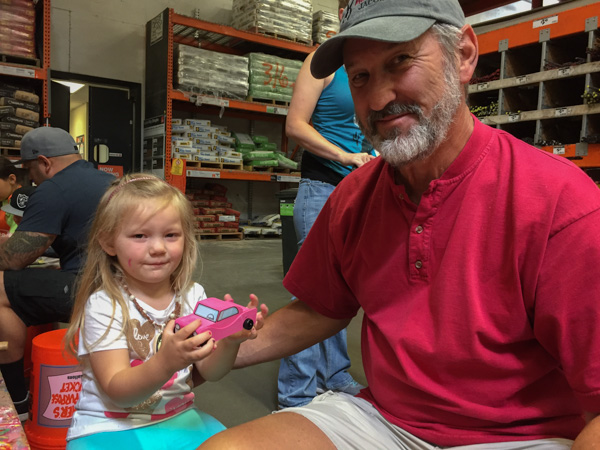 Project finished!
Project finished!